
Charity and Funder
Relationships: Unlocking the
Potential
By
Thomas W Keenan
(Master of Business Administration)
Thesis
Submitted to Flinders University
for the degree of
Doctor of Philosophy
College of Education, Psychology & Social Work
19
th
November 2021
i
Abstract
The Australian charity sector is extensive and operates across most aspects of our society. It
provides a diverse and frequently complex range of services and delivers essential support for
individuals, families and communities. The size, reach and scope of the sector means that any
improvements to the effectiveness or efficiency of charities would likely lead to wide-ranging and
far-reaching benefits to the whole of Australian society and beyond. Consequently, this research
investigates, interrogates and reports on the impact the current model of charity funding has on their
effectiveness and efficiency. This research also investigates the nature of the relationship between
charities and funders. A mixed method approach was used in this research.
The theoretical framework for this research is a blend of Phenomenology and Resource
Dependency Theory (RDT). The former was adopted as a means of exploring ontological
understandings and taken for granted meanings of the charity and funder relationship in rich and
nuanced ways. RDT with its considerations of dependency and relational power was used to
undertake a detailed exploration into how the organisational effectiveness and efficiency of
Australian charities are being impacted by the current model of funding and how this model is
influenced by the power dynamics within the charity/funder relationship.
This research has found that the organisational effectiveness and efficiency of charities is being
significantly compromised by how they are funded. This is primarily due to the fractured
charity/funder relationship, which is skewed, very much, in favour of funders. Funders hold all the
power in this relationship; they know it and they exploit it. This power imbalance presents, most
frequently, in how charity funding is sourced, awarded and then controlled. The mechanisms for
securing funding are inconsistent, subjective and consume a significant amount of charity resources,
all of which dilutes, not inconsiderably, the value of the funds awarded and therefore the impact that
charities can have. e initial award of funding to the dictating of
where and when funds should be used and the refusing of funding requests for capacity building
type funding that would afford charities the opportunity to become more organisationally effective
and efficient. As a result, organisational competence is further compromised. The charity/funder
relationship matters less to funders than it does to charities, as does the impact of the funds
provided, which is of little importance to funders.
ii
Another important finding of this research is that of the reality of being a charity employee. Funders
hold charities and the employees within in low regard. They demonstrate little concern for the well-
being of charity employees or their working conditions. Charity employees are compromised
regarding income, working conditions and job security. The reality is that being a charity employee
is not an attractive proposition.
iii
Contents
Abstract
i
Contents
iii
List of Tables
vii
List of Charts
viii
Acknowledgements
ix
Declaration
x
Chapter 1 - Introduction
Page
1.1
Preamble
1
1.2
Introduction
3
1.3
Framing and scope of the research
7
1.4
Research questions
9
1.5
Definitions
10
1.5.1
Charities
10
1.5.2
Funders and motivation
10
1.5.3
The charity/funder relationship
11
1.5.4
Funding models
11
1.5.5
Organisational effectiveness and efficiency
11
1.6
Background
13
1.7
Reporting and performance
16
1.7.1
Charities
16
1.7.2
Funders
20
1.7.3
Conclusions
26
1.8
Limitations and delimitations
27
1.9
The significance of the study
28
1.10
Structure
29
1.11
Summary
30
Chapter 2 Literature Review
Page
2.1
Introduction
31
2.2
Relationships within and between organisations
32
2.3
The history of charities and charitable giving
33
2.4
The history of charity legislation
37
2.5
The rise of the welfare state
45

iv
2.6
The Beveridge Report
51
2.6.1
54
2.7
Charity funding
61
2.8
Organisational effectiveness and efficiency of charities
77
2.9
The motivations of funders
80
2.9.1
Government funding and the motivations behind it
82
2.10
The charity/funder relationship
86
2.11
What is the gap/opportunity that this research seeks to fulfill?
91
Chapter 3 Methodology
Page
3.1
Introduction
92
3.2
Theoretical Framework
93
3.3
Research approach
100
3.4
Research parameters - What is in scope and what is not?
104
3.5
Data gathering techniques
105
3.5.1
Tranche 1 - Quantitative data gathering & analysis
106
3.5.2
Tranches 2 & 3 - Qualitative data gathering &
analysis
113
3.6
Limitations of the study
117
3.7
Ethical considerations
118
Chapter 4 Findings from the financial survey
4.1
Introduction
119
4.2
Financial survey questions
120
4.3
Outputs and interpretations
121
4.4
Conclusions
131
Chapter 5 Findings from the interviews with charity leaders
Page
5.1
Introduction
132
5.2
Discovering emergent themes
138
5.2.1
The complexities of securing a grant
138
5.2.2
The diminished ability to establish and follow any form
of strategic path
143
v
5.2.3
The inability to invest in programmes or projects that
145
5.2.4
The disproportionate amount of organisational resource
deployed to secure and maintain future funding streams
148
5.2.5
The realities of being a charity employee
150
5.2.6
The partisan nature of government contracts
153
5.2.7
The unwillingness or inability of charities to articulate to
funders the deficiencies of the current funding models
156
5.2.8
158
5.3
Conclusion
161
Chapter 6 - Findings from the Interviews with Funders
Page
6.1
Introduction
163
6.2
Discovering the emergent themes
168
6.2.1
The Australian charity sector
168
6.2.2
Charity performance
171
6.2.3
The charity/funder relationship
174
6.2.4
Funders practices and performance
178
6.2.5
Government
184
6.3
Conclusion
188
Chapter 7 Discussion
7.1
Introduction
191
7.2
Comparing the emergent themes
192
7.2.1
The environment in which funding is awarded
195
7.2.2
Control over the resources awarded
202
7.2.3
Treatment of charity employees
207
7.3
Addressing the research questions
210
7.3.1
Sub-question 1 - How does the funding of charities
currently occur?
210
7.3.2
Sub-question 2 - What is the nature of the
relationship between charities and their funders?
212
7.3.3
Sub-question 3 - What are the motivations of
funders?
214
vi
7.3.4
Main research question - Is the organisational
effectiveness and efficiency of charities impacted
by how they are funded?
216
7.4
Closing commentary
219
Chapter 8 - Conclusion
Page
8.1
Purpose of this research
221
8.2
Summary of the findings
222
8.3
Contribution to knowledge
224
8.4
Further research
226
8.5
Implications for practise
227
8.6
Concluding comments
229
Appendices
Appendix 1
Data Analysis Formulas used and outputs achieved.
Appendix 2
Quotations taken from Interviews with Charity Leaders listed under
Domain Summaries.
Appendix 3
Quotations taken from Interviews with Funders listed under Domain
Summaries.
Appendix 4
Calculations - Charity resource requirements Section 7.2.1.
References
vii
List of Tables
Page
Table 4.1
Annual income & distribution of donations and grants for all charities
surveyed
121
Table 4.2
Income Sources & Contribution to Income of all charities surveyed
122
Table 4.3
Size of Grants/Donations Received & Contribution to Income of all
charities surveyed
125
Table 4.4
Term of Grants/Donations Received & Contribution to Income of all
charities surveyed
129
Table 5.1
Profile of charity leaders interviewed
133
Table 5.2
Domain Summaries and Themes Charity Leaders
135
Table 6.1
Profile of funders interviewed
164
Table 6.2
Domain Summaries and Themes - Funders
165
viii
List of Charts
Page
Chart 1.1
Scope of the Research
7
Chart 1.2
Purpose of Australian charities
15
Chart 1.3
Most common beneficiaries of Australian charities
15
Chart 4.1
Income sources & contribution to income of all charities surveyed: All Incomes
vs. Income < $500k vs. Income > $10m
124
Chart 4.2
Size of grants/donations received & contribution to income of charities
surveyed: All Incomes vs. Income < $500k vs. Income > $10m
127
Chart 4.3
Term of grants/donations received & contribution to income of all charities
surveyed: All Incomes vs. Income < $500k vs. Income > $10m
130
Chart 5.1
Domain Summaries and Themes Charity Leaders
136
Chart 6.1
Domain Summaries and Themes Funders
167
Chart 7.1
The Funding Iceberg
211
Chart 7.2
Interrelation Influences
212
ix
Acknowledgements
I am grateful for the support of the following:
The participants in the research who volunteered their time and shared their knowledge and
experience of the Australian charity sector and its funders.
My supervisors, Professor Nigel Garrow, Professor David Giles, Professor John Halsey and
Associate Professor Janet Mack who supported, encouraged and provided able counsel throughout
the past several years.
The financial support provided by the Australian Government Research Training Program
Scholarship.
Leaders, faculty and staff of the College of Education, Psychology & Social Work at Flinders
University; Peggy Brooksby, Education Liaison Librarian and Dr Pawel Skuza, Statistical
Consultant, both at Flinders University.
Judith Lydeamore, who provided proof-reading and editing, in accordance with the guidelines laid
out in the university-. All errors contained
in this document remain with the author.
My employers through the duration of this study: Origin Energy, Audi Australia, Panthera Finance
and Big Picture Education.
My family, for their counsel, kindness and patience.

x
Declaration
I certify that this thesis:
1. does not incorporate without acknowledgment any material previously submitted for a
degree or diploma in any university; and
2. to the best of my knowledge and belief, does not contain any material previously published
or written by another person except where due reference is made in the text.
Signed
Thomas W Keenan
Date 19
th
November 2021

1
Chapter 1 - Introduction
1.1 Preamble
My history
I began my direct involvement with charities in 2002 when I commenced employment with
Origin Energy. Prior to that, my knowledge of individual charities and the wider charity
sector was limited. In my role with Origin, I was tasked to develop a hardship program that
would help those energy customers who were experiencing difficulties in paying their energy
bills. It was through this work that I first started my direct interactions with charities,
although the charities I interacted with were limited to those providing financial counselling
support to those in the community who were suffering from financial hardship. These
dealings continued through to 2010 when I moved to the Origin Foundation and adopted the
role of a funder. This change allowed me to build connections across the wider charity sector
and progress my understanding of the sector in the process. Subsequent roles with the Audi
Foundation and the Panthera Foundation have allowed these interactions to expand and
further advance my knowledge of the charity sector.
My standpoint
In summary, I believe the Australian charity sector:
• plays a critical role in supporting the vulnerable and disadvantaged in our societies.
• is less impactful than it might otherwise be due to the work practices forced upon the
organisations within.
• is often treated with indifference by the majority of funders including government.
• consists of passionate, driven, but poorly remunerated employees committed to
individual, family and community progress.
My motivation
Australian charities have been established for the purpose of serving the needs of others.
Many support the at-risk and disadvantaged members of our society in times of need. Others
provide opportunities and encouragement to improve self-worth. Most charities look to
improve our communities by enhancing personal contribution and, as such, charities play a
crucial role in supporting those who are vulnerable and in need (Australian Charities and Not-

3
1.2 Introduction
This section of the chapter introduces the aims of this research and its significance. It
provides a brief overview of the not-for-profit sector and the charities within, identifies the
underlying problem and presents the research questions. In addition, this chapter recognises
the research limitations and describes my personal motivation for undertaking this endeavour.
Finally, this chapter outlines the structure of the thesis and closes with a brief summary.
The research undertaken for this thesis emerged after extensively reflecting on my
experiences as a funder of charities over several years. In particular, my discussions with
charities would frequently turn to focus on what they perceived to be the inefficiencies,
limitations, and damaging impact of the current model of funding employed by most funders.
The concerns and claims made by charity personnel included:
• The vast majority of funders provide small, short-term donations or grants and
securing small, short-term funding from a multitude of funders, rather than just a few,
is a less than effective use of available resource.
• Funders show few similarities in their processes, protocols, and objectives, which
adds further complexities to fund seeking and drives higher administration costs.
• Funders demonstrate a disdain or disregard for supporting capacity or capability
building initiatives, such as employee training and development or upgrading
information technology systems. Subsequently, charities do not include the capacity
and capability building components in their grant applications, which in turn,
exacerbates the lack of targeted funding that would improve the impact these
organisations have on the individuals, families and communities they serve.
• Funders can have other intentions which can be contradictory to their formal
published objectives, as in, funders are likely to want more from their funds than just
community benefit, things such as ongoing recognition and regular employee
engagement, all of which take considerable time and effort and have the effect of
diluting the value of the initial donation or grant.
• Funders do not consider the impact their practices have on charities.
With regards to the abovementioned claim that funders provide mostly small, short-term
funding, this claim cannot be substantiated through existing reporting structures (Australian
Charities and Not-for-Profit Commission, 2020e; Australian Federal Government, 2020c;

4
SmartyGrants, 2020), which are not specific enough to allow a detailed analysis of the size
and term of the donations or grants on offer. Nor can existing reporting confirm that this
model of f. There is also a dearth of
information available that allows evaluation of funders and their impact. As such, claims of a
disdain or disregard for supporting capacity building initiatives, contradictory objectives, and
a lack of consideration of impact cannot readily be substantiated.
However, a recent funding initiative by the Macquarie Group Foundation did afford a source
of support and some insights about the concerns and claims of charities. Put another way, it is
an informing albeit minor case study that provides important contextual elements for this
research.
The Macquarie Group Foundation is the philanthropic arm of Macquarie Group. It provides
support to several hundred charities annually both financially and through volunteering
(Macquarie Group Foundation, 2020a). As part of the Macquari
th
anniversary
celebrations, the Macquarie Group Foundation announced it would be launching its 50
th
Anniversary Awards and distributing $50 million to just five charities over a five-year period
(Macquarie Group Foundation, 2020c). The objectives of the awards were as follows:
• To build on an eligible organisation’s ability to address an area of social need.
• To encourage eligible organisations to be bold in their thinking about how to address social
needs to support excellence in the implementation of these bold ideas.
• To publicly promote the selected organisations’ work and inspire continuing best practice
within the social sector. (Macquarie Group
Foundation, 2020c, p. 1)
The project offered the successful charities $2 million a year for five years to support
innovative ways of improving their ability to deliver services. However, while the Macquarie
initiative provided the chance for a substantial payoff for the successful applicants, a $10
million grant application is not something that is written in a few hours, especially in a
competitive environment. Applicants would have needed to invest significant resources in
putting such an application together. While it is not possible to know exactly what resources
charities devoted to their initial applications, it is not unreasonable to assume that an initial
meeting would occur to decide if an application should be submitted. If the decision were
made to progress, further meetings would then be scheduled to decide what the pitch would

5
be and then how the application should be constructed. Several re-writes would occur, all of
which would have to be reviewed and approved, and then there would be a final sign-off.
Based on my knowledge of the work required to develop a competitive bid for such a large
amount of funding, a conservative estimate of at least four weeks of organisational resources
that included a diverse range of personnel would be required.
The Macquarie Group Foundation received almost 1000 applications (Macquarie Group
Foundation, 2020c). Using my above
competitive bid, the 1000 applications multiplied by four weeks per application would equal
4000 weeks or around 80 working years of resource, and that amount is just for the charities
that fell at the first hurdle of considerations. It is important to also recognise that the figures
and the overall resource use estimates do not include the resource used by those charities
which considered submitting a grant application but did not.
While I acknowledge that the figures I have used in the foregoing analysis are based on my
employment experiences plus some documented investigations into charity funding practices
(Herbert, Barnett, Clarke, & Graves, 2013; von Hippel & von Hippel, 2015), they signal a
ve
original entrants. For the 60 charities who made it through to the semi-finals, a
comprehensive due diligence process was undertaken by external consultants, and further
regional based judging was undertaken across the Americas, Asia, Australia, Europe, the
Middle East and Africa (Macquarie Group Foundation, 2020c). The twelve finalists chosen
then had to undergo site visits by the Macquarie Group Foundation prior to the selection of
the five winners. Whilst this four-stage selection process may demonstrate how meticulous
the Macquarie Group Foundation was in their approach to allocating $50 million worth of
funding, arguably it would have had quite a resource and emotional impact on the charities
involved, especially those who made it through to the final and then failed. Beyond the
aforementioned estimated cost of 80 years-worth of charity resource, as absorbed by the
majority of unsuccessful applicants, the cost to the Macquarie Group Foundation of
employing external consultants and undertaking site visits across six continents would have
also been significant.
It is also very relevant to the contextual framing for my research to foreground Macquarie
Group Foundation methods of funding because they are revealing in terms of the relational

6
complexities existing between funders and charities, namely:
• Matching staff donations and fundraising
• Providing grants to a community organisation with a Macquarie staff member on its board.
• Donating to a staff-nominated organisation for 10-year and 25-year employee anniversaries.
• Providing financial awards to community organisations recognising outstanding Macquarie
staff contributions.
• Making grants to organisations which meet our grants criteria (a small number of grants
outside of these criteria may also be made at the Foundation’s discretion).
(Macquarie Group Foundation, 2020a, p. 1)
It would appear that if a charity was looking to secure funding from the Macquarie Group
Foundation then it must be willing to comply with the aforementioned conditions regarding
employee participation. These conditions suggest that the Macquarie Group Foundation
would appear to preference charities which could provide appropriate employee participation
activities above charities which may be having greater societal impact but were not able or
willing to provide such activities. They also suggest that the Macquarie Group Foundation
approach to funding may, in practice, compromise the stability of existing charity structures
in order successfully achieve its own objectives. In turn, both seem to contradict one of the
stated funding principles, “…we want to achieve the most significant social impact possible…”
(Macquarie Group Foundation, 2020b, p. 1).
As stated at the commencement of this chapter, in my experience, charities often claim that
funders can have objectives which contradict the ones they formally publish. In this instance
the were all published. However, they were
internally contradictory which in turn gave rise to an ambiguity of interpretation and, as a
consequence, opens a range of problematics including the influence and power dynamics in
funding relationships.
From verifying the current models of funding, to assessing the impact these models may be
having on the performance of charities, to exploring the behaviours and motivations of
funders, all these issues were ripe and ready for the in-depth investigation that was
undertaken.

7
1.3 Framing and scope of the research
My relational experiences with charities drove my examination of the existing literature
regarding the models of charity funding that were being employed and their effects. My
experiences also highlighted there was a significant gap in the literature linking how funders
fund and how these practices affect the organisational effectiveness and efficiency of
charities. There is also a literature gap regarding the nature of the relationship between
funders and charities about the impact this relationship has on the effectiveness and
efficiency of charities and the effect on employees within the charity sector. This research
investigates whether charities could improve the impact they have across the communities,
families and the individuals they serve, if funders were to adopt a more nuanced and
relational model of funding, and one which better aligned the objectives of charities with the
funders who support them.
The scope of this research is illustrated in Chart 1.1, which shows four primary components
and the inter-relationships existing between these components. The overlapping rings in this
chart help visualise the importance of collaboration for organisational effectiveness and
efficiency.
Chart 1.1 Scope of the research
8
This research was located primarily in Australia although some exploration and investigation
was undertaken in the U.K. and the U.S.A due to their similarities in the history and practices
of charities and funders.
9
1.4 Research questions
The following questions guided this research:
Main question:
• Is the organisational effectiveness and efficiency of Australian charities impacted by
how they are funded?
Sub questions:
• How does the funding of charities currently occur?
• What is the nature of the relationship between charities and their funders?
• What are the motivations of funders?

10
1.5 Definitions
The primary components of this research were charities, funders, the charity/funder
relationship, funding models and the organisational effectiveness and efficiency of charities.
Definitions of each were used as follows:
1.5.1 Charities
As defined by the Charity Act 2013 (Australian Federal Government, 2013), a charity is:
• a not-for-profit entity.
• having only charitable purposes that are for the public benefit.
• not having a disqualifying purpose.
• not being an individual, a political party or a government entity.
An organisation that is endorsed as a charity by the Australian Charities and Not-for-Profit
Commission under the Charity Act can attract certain monetary benefits, such as income tax
exemptions, General Services Tax (GST) concessions and the ability to receive tax deductible
donations or grants (Australian Tax Office, 2020e). However, and due to the caveat of
having only charitable purposes that are for the public benefitcharity funders such as
private and public ancillary funds or philanthropic organisations (Australian Charities and
Not-for-Profit Commission, 2020f) can also be endorsed as charities. For the purposes of this
research, charities were defined as organisations who are endorsed as charities and who
undertake the actual delivery of charitable and social services, such as advancing education,
relieving poverty or providing health support.
1.5.2 Funders and motivation
A funder is defined as a person or an organisation that provides money for a particular
purpose (Cambridge Dictionary, 2021b; Oxford Dictionary, 2021b). For the purposes of this
research funders were defined as those individuals or organisations that provided funds
(donations or grants) to charities. Funding is defined as the act of providing money for a
particular purpose. Funders practices and behaviour will are influenced by their motivations,
which can in turn be defined as the reason why something is done or why someone behaves
in a particular manner (Cambridge Dictionary, 2021d; Oxford Dictionary, 2021a). For the
purposes of this research, motivation was defined as the impetus

11
1.5.3 The charity/funder relationship
A relationship is defined as the manner in which groups or people regard and behave towards
one another (Cambridge Dictionary, 2021e; Oxford Dictionary, 2021d). For the purposes of
this research, the relationship between charities and funders was explored and considered,
taking into account such aspects as equity, impact, motivations and outcomes.
1.5.4 Funding models
A model is defined as a particular design of a system or a procedure (Cambridge Dictionary,
2021c; Oxford Dictionary, 2021c). For the purposes of this research a funding model was
viewed as the system or procedure employed by funders to allocate their funding.
1.5.5 Organisational effectiveness and efficiency
Organisational effectiveness can be defined as how well an organisation performs activities
similar to a comparable or rival organisation (Michael E. Porter, 1996). It is concerned with
improving performance (Hill, 2012) and, as such, unproductive processes need to be
identified and addressed (Russell & Taylor, 2005). In the commercial world, this could be the
ability to produce products, similar in quality to those of a competitor, but in a faster way.
Effectiveness concerns the performance of all aspects of an organisation and includes such
items as employee reward and recognition, the quality and quantity of products produced,
automation of tasks and the exploitation of information technology (Adan, Bekkers, Dellaert,
Jeunet, & Vissers, 2009; Gomes, Yasin, & Yasin, 2010). Organisational effectiveness
represents the internal drivers for organisations (Gantz, 2013) and it is believed that by
improving organisational effectiveness an organisation will perform better (Michael E Porter,
1996; Santa, Hyland, & Ferrer, 2014). Organisational efficiency differs from organisational
effectiveness in that it is concerned with how cost-effective an organisation is at delivering its
products or services (Ostroff & Schmitt, 1993). An organisation is successful when the use of
resources is both effective and efficient (Osbert-Pociecha, Dudycz, & Brycz, 2016).
A real-world example of how organisational effectiveness and organisational efficiency vary
can be provided by comparing healthcare performance across differing countries. According
to data available from the World Bank (World Bank, 2020), in 2017 the United States of
America had a per capita health expenditure of US$10,246, with an average life expectancy
of 78.5 years. Switzerland had the next largest expenditure at US$8,217 and a life expectancy
of 83.6 years. Norway was third in expenditure at US$6,518 and a life expectancy of 82.6

12
years. This would indicate that healthcare in both Switzerland and Norway is more efficient
(less per capita cost) and more effective (higher life expectancy) than in the United States of
America; it would also suggest that whilst healthcare in Switzerland is more effective than in
Norway, it is less efficient (lo Storto & Goncharuk, 2017).

13
1.6 Background
The Australian charity and not-for-profit sectors
To undertake this research in a rigorous manner and better understand its possible impact, it
was important to have a clear dimensional sense of the not-for-profit sector and the charities
within that sector. This section provides an overview of both the Australian not-for-profit
sector and the charities within it.
In 2014 there were around 600,000 not-for-profit organisations in Australia, most of which
were small and relied on contributions of members and other supporters to survive
(McGregor-Lowndes, 2014). The not-for-profit-sector accounted for around 4% of
c Product (GDP) for 201213, with a value of $57.7 billion, up
from $34.6 billion for 200607 (Australian Bureau of Statistics, 2015). From 2000 through to
2013, the GDP contribution of the sector had an annual growth rate of over 8%, well above
that of other Australian industry sectors (Australian Bureau of Statistics, 2015). There are
many categories under which an Australian organisation can register itself as a not-for-profit,
which can include:
• churches
• cultural societies
• neighbourhood associations
• public museums and libraries
• sports clubs
• schools and universities
According to the Australian Bureau of Statistics, the not-for-profit sector employed over one
million people through 20122013. Organisations providing social services accounted for
24.9% of these employees, followed by organisations providing education and research
services at 24.5%. 41.4% of employees were classified as permanent full-time, whilst 34.3%
were classified as permanent part-time. 24.3% were classified as being casual employees.
40% of the employing not-for-profit organisations provided sport and physical recreation
services. (Australian Bureau of Statistics, 2015). Beyond direct employment, the not-for-
profit sector is also active in recruiting and mobilising volunteers across Australia.
“…the role of volunteers in not-for-profit organisations is essential…through 2012–

14
2013, 3 million volunteers provided over $17 billion worth of unpaid labour...these
volunteers were most likely to be contributing their time to sport, welfare or
community organisations and religion institutions...” (Australian Charities and Not-
for-Profit Commission, 2015, p. 46).
The direct value that not-for-profit organisations add to the economy is measured as Gross
Value Added
1
(GVA). According to the Australian Bureau of Statistics, through 20122013,
the not-for-profit sector accounted
which was an increase on the 20062007 contribution of 3.2%. With regard to Gross
Domestic Product, the sector contributed $57.7 billion through 20122013, up from $34.6
billion in 200607 (Australian Bureau of Statistics, 2015).
As stated earlier in this chapter, this research is concerned with the Australian organisations
within the wider not-for-profit sector that undertake the actual delivery of charitable and
social services. Examples of such organisations include:
• Camp Quality a charity that helps children deal with their own cancer diagnosis.
• Guide Dogs Australia a charity that delivers essential services to those who are
blind or vision impaired.
• Oxfam a charity that works to relieve and eliminate poverty.
• RUOK? a self-harm prevention charity.
• The Smith Family a charity that helps children get the most benefit from their
education.
Concerning Australian charities within the wider not-for-profit sector, for the 2017/2018
financial year (FY), the Australian Charities and Not-for-profit Commission (ACNC)
provided the following summary of their contribution (Australian Charities and Not-for-Profit
Commission, 2020e):
• $155.4 billion in total revenue
• Over 57,000 registered charities
• $68 billion received in federal, state and local government funding
• $10.5 billion received in donations and bequests
1
economy (Australian Tax Office).
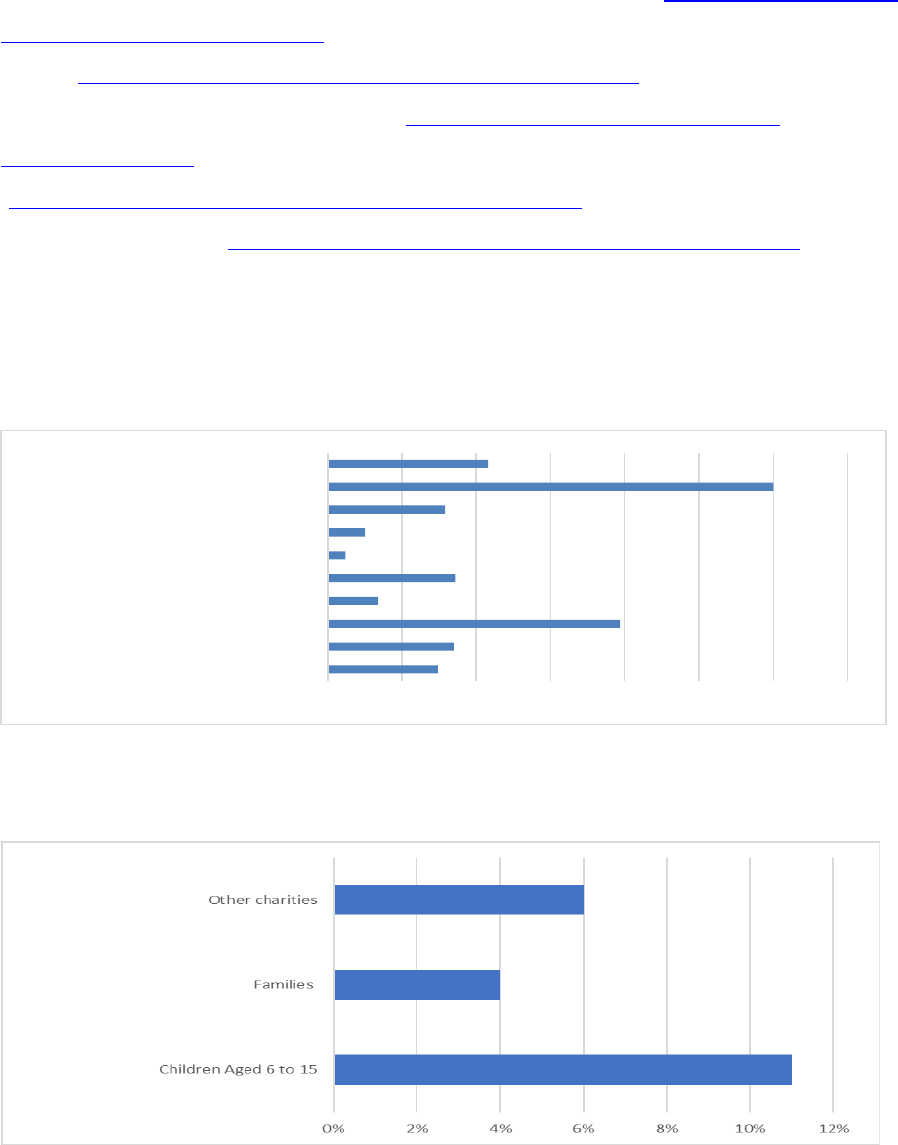
15
• $148.5 billion in total expenses
• Over 1.3 million employees
• 3.7 million volunteers
With regard to total charity revenue, this has been increasing throughout the past several
years Through FY 2012/2013 total charity income was $100 billion (Australian Charities and
Not-for-Profit Commission, 2014). By FY 2014/015 this income had increased to $134.5
billion (Australian Charities and Not-for-Profit Commission, 2015) with the aforementioned
$155.4 billion reached by FY 2017/2018 (Australian Charities and Not-for-Profit
Commission, 2020e). The ACNC also defined the main purpose of Australian charities
(Australian Charities and Not-for-Profit Commission, 2020e) (see Figure 1.2) and the most
common beneficiaries (Australian Charities and Not-for-Profit Commission, 2020e) (see
Figure 1.3). Each of these data sources contributed to an understanding of the impact,
diversity and reach of the sector.
Chart 1.2 Purpose of Australian charities
Chart 1.3 Most common beneficiaries of Australian charities
0% 5% 10% 15% 20% 25% 30% 35%
Culture and Recreation
Development and Housing
Education and Research
Environment
Health
International
Law and Advocacy
Philanthropy and Voluntarism Promotion
Religion
Social Services

16
1.7 Reporting and performance
In order to ascertain what impact current models of funding are having on the organisational
effectiveness and efficiency of charities, a review of existing charity and funding legislation
was undertaken. Reporting obligations for both charities and funders were also explored. An
examination of both legislation and reporting was relevant to establishing the background to
this research, as these create the framework under which both charities and funders currently
operate.
1.7.1 Charities
Throughout the past several decades, there have been various attempts to gain a better
understanding of the impact of the not-for-profit sector and the charities within it. Originating
post-war in the late 1940s, the current System of National Accounts (SNA) is a standard
system of national accounting. Internationally agreed, the SNA looks to provide an
amalgamated, comprehensive system of accounts that allows a transnational comparison of
all significant fiscal activities (United Nations, 2020). The first SNA was published in 1953
-(United
Nations, 1953).
Satellite accounts, provide a method by which certain fields or aspects of economic and
social life can be focused on and by which the SNA can be tailored to meet the contrasting
circumstances and requirements of differing countries. They are intended for precise use,
such as in assessing education progression, tourism activity or monitoring the not-for-profit
sector (Eurostat, 2020).
Published in 2003, the United Nations Non-Profit Institutions Handbook encouraged
countries to produce regular satellite accounts for not-for-profit organisations, including
measurements of the value of volunteer work (United Nations, 2003). The aim was to help
with the task of comparing not-for-profit sector performance across differing countries and
economies. The Handbook offered a standard set of guidelines for identifying charities and
not-for-profits hidden in other economic sectors. Countries were encouraged to separate such
organisations from the sectors to which they had been previously located and combine them

17
into a composite not-for-profit satellite account that included the value of volunteer work
these organisations contributed:
“…the fundamental aim of the present Handbook is to respond to the growing
interest that statisticians, policy makers and social scientists have in organizations
that are neither market firms nor state agencies nor part of the household
sector…such social institutions are variously referred to as “non-profit”,
“voluntary”, “civil society” or “non-governmental” organizations and collectively
as the “third”, “voluntary”, “non-profit” or “independent” sector..” (United
Nations, 2003, p. 3).
While there was a substantial amount of information on Non-Profit Institutions
Satellite Account including funding trends, GDP contribution and volunteer hours in 2015
(Australian Bureau of Statistics, 2015), very little could be deduced from this information
about the performance or impact of the not-for-profit sector or the charities within it. The
issue was meant to be addressed when, in 2009, to fulfil an election promise, the Australian
Federal Government instructed the Productivity Commission to investigate options for
maximising the not-for-profit
economic growth. The Commission was specifically asked to consider how the not-for-profit
sector's contribution to Australian society was measured at that time and whether those
measures could be improved. It was also asked to identify ways to improve the efficiency and
effectiveness of not-for-profit organisations, and to consider options for advancing the
delivery of government-funded services by those not-for-profit organisations (Gillard,
Stephens, & Bowen, 2009).
Within the press release, Senator the Hon Ursula Stephens, Parliamentary Secretary for
Social Inclusion and the Voluntary Sector stated:
“…the study will help improve the way in which the not‑for‑profit sector operates
and make it easier for organisations working in the sector to be effective..” (Gillard
et al., 2009, p. 1)
That quotation was important to this research as it indicated an assumption by the Federal
Government that the not-for-profit sector was not currently performing at optimum levels; an
assumption that was confirmed in the subsequent Productivity Commission Report
Contribution of the Not-for-Profit Sector’, which stated:

18
“…not-for-profits are constrained in improving productivity…areas of most concern
are inadequate governance skills, low uptake of information technology and lack of
capacity in evaluation…” (Productivity Commission, 2010, p. LVIII)
This report included a wide range of observations and findings. It also made a number of
recommendations including:
“…the Australian Government should provide funding for the establishment of a
Centre for Community Service Effectiveness to promote ‘best practice’ approaches
to evaluation…among its roles, the Centre should provide:
a publicly available portal for lodging and accessing evaluations and related
information provided by not-for-profit organisations and government agencies,
guidance for undertaking impact evaluation,
support for ‘meta’ analyses of evaluation results to be undertaken and made publicly
available…” (Productivity Commission, 2010,
p. XLII)
This quote is significant in that it acknowledged a lack of ability to easily evaluate the
performance of the not-for-profit sector and the charities within it. This thesis contributes to
solving this problem by evaluating the impact that the charity/funder relationship and models
of funding have on the organisational effectiveness and efficiency of charities.
Annual Information Statements
The Australian Charities and Not-for-profit Commission (ACNC) was established in 2012
(Australian Charities and Not-for-Profit Commission, 2020a) following recommendations
from various inquiries, reports and reviews including the 2008 Senate Economics Committee
Inquiry into Disclosure Regimes for Charities and Not-for-profits, the 2010 Review into
abovementioned Productivity Commission Report
(Turnour, 2014). In line with Senator Stephens comments, it provided an excellent
opportunity to gain a more rounded understanding of the performance of charities and,
quickly enough, the ACNC proceeded to introduce a number of so-called enhancements and
improvements with regard to charity and not-for-profit reporting obligations or, more
specifically, the requirement to submit an Annual Information Statement (AIS) to the ACNC
(Australian Charities and Not-for-Profit Commission, 2019a). Beyond the AIS, Australian
charities still have few reporting obligations other than basic income versus expenditure

19
statements. There are also some state-based reporting requirements regarding fundraising in
several states including New South Wales (Fair Trading New South Wales, 2020), Victoria
(Consumer Affairs Victoria, 2020) and Western Australia (Department of Mines Industry
Regulation and Safety, 2020), which follow similar formats to those of the AIS. While the
introduction of the ACNC helped lessen the previous state-based reporting burdens and
reduced some of the more onerous regulatory obligations, an opportunity may have been lost
with regard to providing some useful information concerning the performance and impact of
charities. The AIS includes questions about activities, some rudimentary financial
information and other questions in an attempt to better understand the charity sector
(Australian Charities and Not-for-Profit Commission, 2020c). Interestingly, some charities,
such as basic religious charities and non-government schools, have licence to partially
complete the AIS. Charities regulated by the Office of the Registrar of Indigenous
Corporations have no requirement to submit an AIS (Australian Charities and Not-for-Profit
Commission, 2021b). According to the ACNC, there were 57,000 registered charities in 2018
(Australian Charities and Not-for-Profit Commission, 2020b) but only 48,000 of AIS were
analysed for the 2018 Charities Report (Australian Charities and Not-for-Profit Commission,
2020e). A completed AIS does provide a basic overview of each charity, such as annual
income, areas of focus and number of employees. Combined, the AIS data provide a limited
view of the charity sector due to the partial completion rates or non-participation of certain
charities and offer little in regard to charity performance or impact. Additionally, some of the
information derived from the AIS and published by the ACNC (Australian Charities and Not-
for-Profit Commission, 2020d) may be misleading, as a proportion of the total revenue of
charities is in effect being double counted. As stated earlier, funders can also be endorsed as
charities, and as such, funders income will be counted in year when it is received by funders
and counted again as income by the charities who receive it in the form of a grant or
donation.
Other reporting requirements
Beyond the AIS, many charities, who are also registered as businesses, will have the
requirement to submit an end-of-year financial report to the Australian Tax Office, which
may include such items as wages, salaries and other work-related payments (Australian Tax
Office, 2020b). But much like the AIS, this submission provides little information on
performance or impact. A number of charities also produce an annual report. These reports
tend to paint a positive picture of the activities undertaken and results delivered by each

20
charity. They often provide many individual examples of success and recognition is also
given to their funders and supporters (Benevolent Society, 2019; Salvation Army, 2019; The
Smith Family, 2019a). It can be a challenge to find any negative commentary regarding
performance or impact in these reports.
The diversity challenge
Charities are diverse. They operate across most aspects of our communities, providing
services and support that are complicated and distinct. This diversity can further complicate
reporting within the sector. The seemingly simple act of categorising a charity can prove a
challenge:
“…would the Salvation Army be a religious or social services organisation and the Red
Cross an emergency or International Aid organisation…” (McLeod, 2016, p. 6)
This diversity, married to the lack of any practical independent information regarding the
performance or impact of charities, makes it difficult to compare charities:
•
$25AUD (Fred Hollows Foundation, 2019) impactful? And is it more or less
organisationally effective than the Australian Indigenous Mentoring Experience,
which closes the indigenous education gap and generates $9 worth of societal benefits
for each $1 invested in the program? (Australian Indigenous Mentoring Experience,
2019)
• Does the $30,000 cost of training a guide dog to allow a blind or low vision person
the freedom and independence to travel about their community at minimal risk (Guide
Dogs Australia, 2019) contribute more to societal progression than the $52 per month
it costs to provide a vulnerable and disadvantaged child comprehensive educational
support as long as they are at school or Life
program? (The Smith Family, 2019b)
Using reports that are currently available, whether they
end-of-year financial submissions or own annual reports, it is not possible to
determine if a charity is performing well, having an appropriate level of impact or is
organisationally effective or efficient.

21
1.7.2 Funders
Much like available charity reporting, current reporting on funding and funders is limited.
Individual funders have no obligation to disclose any donations or grants made except
through an end-of-financial year taxation return in order to secure a tax deduction. Reporting
from larger and more organised funders generally happens annually and the range of formats
is incredibly diverse, with many differing types of presentation methods used. Only a small
number of funders provide full disclosure of donations and grants made including the
recipient and size (Myer Foundation, 2019; Vincent Fairfax Family Foundation, 2018). Some
funders provide listings of recipients but omit any useful financial information regarding the
grants or donations provided (English Family Foundation, 2020; Gandel Philanthropy, 2020).
Others provide a summary of funding distributed through the reporting period including the
total amount distributed and the total number of recipients; commentaries regarding certain
recipients may be included (Ian Potter Foundation, 2019; Minderoo Foundation, 2019). Some
large funders do not publish their own information, instead it is made public through the
parent companact or sustainability report (Telstra, 2020; Westpac, 2019).
Funders who are registered as businesses have the requirement to submit an end-of-year
financial report to the Australian Tax Office which incorporates an income and expenditure
statement (Australian Tax Office, 2020b). This reporting gives visibility to how much a
funder has distributed and to whom, but only on an individual basis. There is no
straightforward method of aggregating this reporting other than examining each individual
report and combining the distributions. Funders, endorsed as charities, have to complete an
Annual Information Statement (AIS) and submit it to the Australian Charities and Not-for-
profit Commission (ACNC). Analysis of the AIS data could provide a method of
demonstrating the size of donations or grants as distributed to charities, as in who gave what
and to whom, but the AIS dataset, in its current form, provides only a summary of a funders
distributions and is presented as follows:
• grants and donations made for use in Australia
• grants and donations made for use outside Australia
(Australian Charities and Not-for-Profit Commission, 2020c, p. 1)
Information from charities regarding the receiving of donations and grants is equally limited
and presented as follows:
• revenue from government

22
• donations and bequests
• revenue from goods and services
• revenue from investments
• all other revenue
(Australian Charities and Not-for-Profit Commission, 2020d, p. 1)
This information exists only for the cohort of funders who are endorsed as charities. Funders
who are not endorsed as charities do not submit an AIS, although the charities who receive
donations or grants from this cohort report this as income through their own AIS.
Funding mechanisms
Some funders establish ancillary funds through which they then provide their funding. An
ancillary fund is a mechanism which links funders to the charitable organisations that can
receive tax deductible donations as deductible gift recipients (DGR) (Australian Charities and
Not-for-Profit Commission, 2020h). Ancillary funds can also be endorsed as charities and
secure DGR status
2
, which allows donations into these funds to be tax deductible. Ancillary
funds can take many forms, such as a collection of properties, a share portfolio or a pool of
money (Australian Tax Office, 2020d). There are no rules regarding how ancillary funds,
private or public
3
, distribute their funds other than how much of the fund must be distributed
annually. A private ancillary fund must distribute at least 5% or at
least $11,000 during the financial year, whichever amount is greater (Seselja, 2019). Public
ancillary funds have similar requirements and must distribute at least 4% of the
assets or at least $8,800 during the financial year, whichever amount is greater (Australian
Federal Government, 2011).
In summary, ancillary funds provide a tax efficient vehicle for funders regarding their giving.
Once established, donations into an ancillary fund are tax deductible and donations can take
the form of money shares or property (Australian Tax Office, 2020a). Assets within the
ancillary fund are tax exempt and franking credits from shares are refunded. An inheritance
or the sale of a business can often be the motivator for establishing an ancillary fund as it can
2
DGR status Item 1 refers to organisations such as charities, schools and hospitals, which are organisations that
provide charitable services. DGR Status Item 2 refers to ancillary funds, which are set up solely to provide
money or other benefits to DGR Status Item 1 organisations. (Source:
https://abr.business.gov.au/Help/DGR#itaa)
3
Private ancillary funds can not solicit donations from the general public; public ancillary funds can. (Source:
https://www.ato.gov.au/Non-profit/Getting-started/In-detail/Types-of-DGRs/DGR-table/?page=13)

23
aid in the offsetting of a capital gain (Ruffell, 2014). Funders who use ancillary funds are
obligated to report annually. Those who are endorsed as charities with the Australian
Charities and Not-for-Profit Commission submit the aforementioned Annual Information
Statement. Others submit an Ancillary Fund Return to the Australian Tax Office. This return
requires similar information to that of the Annual Information Statement, particularly income,
expenses and expenditure. It therefore mirrors the previously referenced reports and provides
little information on either performance or impact.
Other funders of charities are federal, state and local governments. Through FY 2017/18,
47% of all charity income came from government (Australian Charities and Not-for-Profit
Commission, 2020e).
Federal government funding
Funds distributed by the Australian Federal Government are administered by the Department
of Social Services through the Community Grants Hub (CGH), which facilitates the
application processes and awarding of grants for several federal government departments
including the Department of Education, the Department of Health and the Department of the
Prime Minister and Cabinet (Australian Federal Government, 2020a). Grants distributed
through the CGH are governed by the Commonwealth Grants Rules and Guidelines 2017
(CGRG). A grant under these guidelines is defined as:
“…an arrangement for the provision of financial assistance by the Commonwealth or
on behalf of the Commonwealth:
a. under which relevant money or other Consolidated Revenue Fund money is to be
paid to a grantee other than the Commonwealth; and
b. which is intended to help address one or more of the Australian Government’s
policy outcomes while assisting the grantee achieve its objectives...”
(Australian Federal Government, 2017, p. 6)
Under the CGRG, grants are provided for many differing activities including capacity
building, infrastructure and research but are not used for the procurement of services:
“…for the purposes of the CGRG, the following financial arrangements are taken not
to be grants:
a. the acquisition of goods and services by a relevant entity, for its own use, including the
acquisition of goods and services on behalf of another relevant entity or a third party.
These arrangements are covered by the Commonwealth Procurement Rules…”
(Australian Federal Government, 2017, p. 7)

24
The previous two quotations are important to this research as they define what is and is not a
grant. This research is concerned with grants and donations; it is not concerned with the
procurement of services.
Procurement of services occurs when an organisation acquires services to meet a need of that
organisation (Cordell & Thompson, 2019; Mangla & Luthra, 2019). A health care provider
purchasing physiotherapy services or a supermarket chain purchasing transport and logistical
services are examples. Procurement of services agreements are usually commercial
arrangements. Over the past few decades, many neo-liberal governments have sought to
extract themselves from the responsibilities for providing social services, instead
relinquishing those responsibilities to charities (Spies-Butcher, 2014; Stewart, 2019; Watts,
2016). As a result, many charities now have procurement of service relationships with
government. A deeper exploration of these relationships is undertaken in Section 2.10.
A grant is an arrangement when an organisation, typically a funder, provides financial
assistance to a charity, which is intended to help address an outcome favourable to the charity
and the funder (Heyman, 2016; Pettey, 2008). Examples include an educational focused
funder supporting a reading programme or environmentally focussed funder
supporting . Reporting on the grants distributed by the
Australian Federal Government is provided through the Grant Connect website. For the FY
2018/19 30, 820 grants were awarded with a combined value of over $18.6 billion.
(Australian Federal Government, 2020c).
State government funding
Individual states also distribute grants to charities and tend to follow similar models of
application, award and distribution. The procedures involved in securing a grant and
subsequent reporting of the monies distributed and outcomes achieved in the five of
most populous states is described below.
New South Wales
The Government of New South Wales uses various interfaces to facilitate grant applications
and awards including Service NSW, the My Community Project and Local Community
Services Association (NSW Parliamentary Research Service, 2019). Local governments

25
within New South Wales collaborate with both federal and state to provide grant
opportunities to targeted communities (Local Government NSW, 2020).
Queensland
In Queensland, grant applications and awards are administered through the Queensland
Government Grant Finder Website (Queensland Government, 2020b) with links to local
government grants also provided.
South Australia
The Government of South Australia Government facilitates its grants through its
GRANTassist and GrantsSA websites (Government of South Australia, 2020b), despite both
websites seemingly being focussed on achieving the same outcomes, including community
participation and wellbeing (Department of Human Services, 2020; Government of South
Australia, 2020a).
Victoria
The Victorian Government follows similar legislation to that the Australian Federal
Government in that it clearly defines the definition of a grant through the Victoria Common
Funding Agreement. A grant is defined as a sum of money given to an organisation for a
certain purpose in order to achieve objectives that are consistent with government policy. A
grant is not a donation or a sponsorship agreement nor is it for the procurement of services
(Victoria State Government, 2020c). also facilitated in a similar manner,
being offered through either the main Victorian Government website or that of Business
Victoria (Business Victoria, 2020; Victorian Government, 2020).
Western Australia
Much like other states, the Government of Western Australia uses a web portal to help
potential grantees to locate an appropriate grant (Government of Western Australia, 2020c),
primarily administered by the Department of Communities (Government of Western
Australia, 2020b) and the Department Local Government, Sport and Cultural Industries
(Government of Western Australia, 2020a). With regards to the funding of grants, the use of
Lotterywest statutory body signals a significant difference between
Western Australia and the other states. Lotterywest sells a number of differing types of
lottery tickets through an approved network of newsagents and online applications
(Lotterywest, 2020). Through FY 2018/19, Lotterywest distributed grants to the value of over

26
$281 million to 613 different not-for-profit organisations and local government authorities
(Lotterywest, 2019). Lotterywest reports annually on how much and to whom it distributed
its grants.
Overall, reporting on government distributed grants is complicated, disconnected and sparse.
Due to this lack of available data, a direct comparison cannot be made between
stated amount of $68 billion of government funds distributed through FY 2016/17 and that of
federal, state and territory government reported distributions. A deeper exploration of
funding offered and awarded to charities by federal, state and territory governments is
undertaken in Chapter 2.
1.7.3 Conclusions
Whilst both Australian Federal and the Victorian State Governments define what is and what
is not a grant, some other states do not afford such rigour to their protocols. For a charity
working nationally, it may be that the differences between a grant and the procurement of
services could easily become blurred.
Much like charities, there is little available reporting on funders and their impact. Where
reporting does exist, a picture of who gave what to whom can be painted. However existing
reporting does little to illuminate or demonstrate the efficacy of funders. There is no easily
accessible method of assessing whether funders are having a positive or a negative impact on
the organisational effectiveness or efficiency of the charities they support.
27
1.8 Limitations and delimitations
At the commencement of this research, it was deemed prudent to give consideration to factors
and influences that may have a bearing on its progress (the limitations), over which I might
have had little control. It was also prudent to set boundaries around the research (the
delimitations), stating what it would not do.
Limitations
The limitations for this research may have included:
• The health of myself, my family and other participants
• The willingness of both charities and funders to participate in this research
• Access to participants, which may be affected geography, weather or a lack of
technology
• The reluctance of participants to openly share their experiences.
Delimitations
This research would not:
• Duplicate current research into charities, funders and funding
• Assess the organisational effectiveness or efficiency of charities.

28
1.9 The significance of the study
The central tenet of this thesis is that relationship dynamics within and between different
organisations, in this case charities and funders, are considerable in influencing and indeed
determining the social impact of their joint endeavours. This thesis explores power imbalance
(Essabbar, Zrikem, & Zolghadri, 2016; Hendrickson, 2003) and relationships (AbouAssi &
Bies, 2018; Giles, 2008) as the central theoretical components underpinning the research,
with accompanying
of the relationship between the two parties, and what action may be required to address
matters arising.
The work being undertaken by the charity sector and its funders is of vital importance to the
Australian people. This thesis advances knowledge regarding the working of the charity
sector, its funders and the challenges faced, in order to enhance their valuable contribution to
society.
This study is significant in that any improvements to efficiency, effectiveness or funding of
charities are likely to have extensive and comprehensive benefits for the whole of the
Australian community. It will also have relevance across a number of other sectors including
government, philanthropy and other major funders. Due to the similarities with charity
sectors in other countries, this study also has the potential to have a positive international
impact.
29
1.10 Structure
The thesis comprises eight chapters. A description of each chapter follows:
Chapter 1 provides an introduction to the research.
Chapter 2 reviews Australian and international literature to inform this research
within the wider body of knowledge and information regarding the effectiveness and
efficiency charities, how charities are currently funded, the nature of the
charity/funder relationship and the motivations of funders.
Chapter 3 describes how the research question was investigated and what activities
were undertaken in pursuit of this goal, including the methodology and the theoretical
framework used.
Chapter 4 presents and discusses the results of the financial survey undertaken.
Chapter 5 presents and discusses the results from the interviews with charity leaders.
Chapter 6 presents and discusses the results from the interviews with funders.
Chapter 7 compares and discusses the results presented in Chapters 4, 5 and 6.
Chapter 8 presents the conclusions from this study, provides possible solutions to and
recommendations about the issues at hand, and identifies further areas of research.
30
1.11 Summary
This chapter has presented the scope of this research and its rationale. The research questions
articulate the need that exists to better understand how charities are currently funded, what
are the effects of this model of funding and is there an opportunity for improvement. The
significance of this research is that it has the potential to benefit much of Australia
and beyond. It will also provide a voice for the charity sector, a sector that has historically
been reluctant to be either critical or heard.
31
Chapter 2 Literature Review
2.1 Introduction
The aim of this thesis was to explore whether the model used to fund charities has any
potential to also improve the organisational effectiveness and efficiency of charities. This
chapter reviews Australian and international literature in the following four fields:
• Current models of charity funding.
• Organisational effectiveness and efficiency of charities.
• Motivations of funders.
• The charity/funder relationship.
The Literature Review sets the scene for the thesis by presenting some of the available
knowledge which is relevant for this study and in particular for answering the research
questions, explaining the problem that this research is addressing, and identifying the gap in
existing knowledge and practice. This chapter also considers
how this role emerged through a review of literature on charity history, charity legislation and
the welfare state.

32
2.2 Relationships within and between organisations
In the private sector, a lack of alignment of the goals of an organisation and its managers can
be a critical relationship issue; Agency Theory (M. C. Jensen & Meckling, 1976) is
concerned with this phenomenon. In the charity sector, the key relationship issue is between
two different types of organisations, namely the charities and the funders, and can be a
function of a potential power imbalance (Essabbar et al., 2016) between the two
organisations. The relationship between charities and
, according to Social Exchange Theory, is the basis of almost all relationships
(Homans, 1958).
Coule (2015) explored the relationship between governance and accountability (Coule, 2015),
commenting on governance theories such as Agency Theory (M. C. Jensen & Meckling,
1976) and Stewardship Theory (Donaldson & Davis, 1991). Other theories which have
relevance to this thesis include Managerial Enrichment Theory (Shleifer & Vishny, 1989), the
premise of which is that managers have an incentive to increase their value to a shareholder
even if it is at the expense of accruing value to shareholders as a whole; and Upper Echelon
Theory (Hambrick & Mason, 1984) in which the proposition “…is that organisational outcomes
– both strategies and effectiveness – are viewed as reflections of the values and cognitive bases of
powerful actors in the organisation…” (Hambrick & Mason, 1984, p. 193) . These theories help
demonstrate the behavioural complexities within organisations as well as between
organisations.

33
2.3 The history of charities and charitable giving
affection or esteem (Lichtenberg, 2009). The Cambridge Dictionary defines charity as: a
system of giving money, food, or help free to those who are in need because they are ill, poor,
or have no home, or any organization that has the purpose of providing money or helping in
(Cambridge Dictionary, 2021a). The Oxford Dictionary provides several wider
or money given to thos
(Oxford University, 2021). Other synonyms can
include aid, altruism, benevolence, giving, humanitarianism, and philanthropy.
Beyond the challenges of securing an understandable and widely accepted definition, there is
much evidence that the broad concept of charity, charitable giving and philanthropy has been
in existence for many, many centuries.
-1200 BC), Manusmriti (c.
1250-1000 BC) and Chandogya Upanishad (c. 800-600 BC) texts (Hinduwebsite, 2020; Islam
& Hinduism, 2020; Sanskiriti, 2014; Sugirtharajah, 2001). The ancient Greeks made claim to
introducing the term p
is believed the term was coined 2500 years ago with its use in the myth Prometheus Bound
(Bond, 2011). Prometheus, who was punished by Zeus for stealing fire from the Gods, argued
(Philanthrocapitalism, 2020). In
ancient Egypt, the Book of the Dead stated that passage to the afterlife was dependent on a
lifetime of benevolence toward the suffering (Science Encyclopedia, 2020). Chinese culture
has a long-established focus on compassion toward others. In ancient China, many proverbs
exist, such as:
(Zhen,
2012). A 2,000 year old proverb
(Chan, 2015). Many Chinese historical
figures hold a special place in history due to their charitable deeds, such as Tao Yuanming of
the Jin Dynasty (365 427), Zi Rudao of the Yuan Dynasty (12791368) and Yang Zhu of
the Ming Dynasty (1368-1644) (Zhizhen, 2010).

34
Moving forward in time, London
monk Rahere and has provided free health care to the poor ever since (Barts Heritage, 2020)
and Bethlem Royal Hospital was established in 1247 to provide shelter and care for the
homeless (Science Museum, 2020). Also in London, St Thomas' Hospital was founded in the
early 12th century (British History Online, 2020). In more modern times, as the Ottoman
Empire expanded the Islamic practice of waqf endowment of property for religious or
charitable purposes gained favour. Roxelana, the wife of Sultan Suleiman the Magnificent
(1494-1566), used waqf to establish the Haseki Sultan Imaret charitable complex in
Jerusalem, supporting the vulnerable and disadvantaged. By the 18
th
century corruption was
widespread and the complex was no longer financially viable (Boncuk, 2004; Celik, 2015).
In the mid-17
th
century in America, two significantly important acts of educational
philanthropy occurred. In 1638, John Harvard, an English minister, bequeathed his library of
400 books and half of his estate to the local college, later to be called Harvard. He was the
(Harvard University, 2020). A few years later in 1643, the very first
fundraising event in America was organised by Harvard University to complement a £100
scholarship endowment provided by Lady Anne Radcliffe Mowlson, an English
businesswoman. This philanthropic concept quickly spread to other educational institutions
including Yale and Princeton (Fuller, 2014).
Founded in Portugal in the late 15
th
century, the Irmandade da Misericordia (Brotherhood of
Mercy) expanded its footprint into South America and in 1739 used philanthropy to establish
one of the first examples of a women and children institution in Brazil. Shelter and
educational opportunities were provided, which set a new standard for charity work (K. D.
McCarthy, 2001; Schwatrz, 2010).
During the 19th Century in England, a number of charitable organisations were established
with a view to addressing the appalling living conditions found in the city slums. These
initiatives were known as Model Dwelling Companies and were privately owned entities such
as: the Metropolitan Association for Improving Dwellings of the Industrious Classes, the
Peabody Trust and the Artisans, Labourers and General Dwellings Company (Dennis, 1989).
These organisations attempted to improve the housing conditions of the working classes and
also earn a competitive rate of return on any investment. This act of philanthropy, married to
the intention to gain a return on capital invested, (Tarn,

35
1974). Also in England and through the mid to late nineteenth century, Octavia Hill, a social
reformer, and John Ruskin, an art critic, social thinker and philanthropist, further developed
unskilled labourers
(Walker, 2006). Hill also had a belief that her tenants would benefit from having easy access
to the country and other open spaces, and she founded The National Trust (Boyd, 1982;
Craik, 2011). In his book, Unto This Last and Other Essays on Political Economy, Ruskin
advocated that the state should guarantee the standards of social service, and encouraged such
initiatives as youth-training schemes leading to employment, and pensions for the elderly and
vulnerable (Ruskin, 1862). Many of his concepts would be later incorporated into what we
now know as the welfare state.
At the same time in the United States of America, Andrew Carnegie was proposing a new
method of dealing with wealth inequality beyond the traditional practices of patrimony
(handing wealth down to heirs) and bequests to the state for public benefit. He contended that
surplus wealth was put to best use when prudently managed by those who had accumulated
the wealth (Carnegie, 1901). By the time of his death in 1919, Carnegie had donated
US$350,000,000, establishing such institutions as: Carnegie Mellon University, the Carnegie
Institute of Science, and the Carnegie Foundation for the Advancement of Teaching. He also
established over 2,500 libraries worldwide (Carnegie Corporation of New York, 2020).
Turning to Australia, the New South Wales Society for Promoting Christian Knowledge and
Benevolence was founded in 1813 by Edward Smith Hall. Hall migrated from England in
1811 and proved to be an influential figure in the colony. He was a banker, newspaper editor
and grazier (Pike, 1966)
Benevolent Society of NSW, becoming non-religious (Benevolent Society, 2020). The
establishment in Australia of many other charities followed, including The Saint Vincent de
Paul Society in 1854, Mission Australia in 1859 and The Salvation Army in 1880.
Tthe past, where benevolent practices were intertwined
into both community and belief structures. Driven by individuals, these benevolent practices
or patterns of giving were in response to the obvious needs of a progressive society, whether
that be education, health or employment. Governments, evidenced by their lack of action,
were ignorant of these needs and these societal safety nets were initially funded by private
sources rather than from government coffers (Boyd, 1982; Craik, 2011; Walker, 2006).
36
However, despite apparently being ignorant, deliberately or otherwise, to the needs of
as evidenced by the various forms of legislation introduced. This legislation is explored in the
next section of this thesis.

37
2.4 The history of charity legislation
Charity practices and procedures that developed over centuries in the United Kingdom, and
were bestowed on its colonies, remain essential to charity law today:
“…no meaningful analysis of charity law can be attempted…without first grasping
how it has developed and now operates in the originating jurisdiction…”
(-Lowndes, & Simon, 2008, p. 1).
In Australia, the definition of charity and charitable is stated in the Charities Act 2013. Prior
to this legislation being introduced,
“…the meaning of charity in Commonwealth law has largely been that of the
common law, based on the preamble to the Statute of Charitable Uses 1601…”
(Australian Federal Government, 2013, p. 1).
The list of activities and purposes in the preamble to this four-hundred year-old legislation,
also known as the Statute of Elizabeth 1, has provided the basis of definition of
charitable purpose (House of Commons, 2020).
Prior to the introduction of the Statute of Charitable Uses 1601, charitable mechanisms, such
as the giving of land or providing food to the poor, fell under the jurisdiction of local
magistrate courts and ultimately the K (Vines, 2013). However, the Catholic
in such areas as marriage, legitimacy of
children, wills and the passing of personal property. Article 27 of the Magna Carta of 1215
over such items of those who died intestate
(Helmholz, 2016). It also confirmed that religious institutions should not be given land and
then be allowed to release it back to the donor and be given rent from it (Oosterhoff, 1977).
This attempt by the government of the day to block obvious tax evasion through legislation
failed, as by the early 16
th
century many churches, convents and monasteries had become
exceptionally wealthy due to the aforementioned Article 27 and the commercial opportunities
afforded by their location close to many of the main trade routes (Smoluk, 2012).
By the time of the Reformation in the 16
th
century, it is estimated that religious institutions
held one quarter of all cultivated land in England (Johnson, 2020). This wealth brought about
a change in behaviour from churches and monasteries, moving their attention away from

38
spiritual enlightenment to a focus on accumulating more wealth and living a life of grandeur,
corruption and immorality (Smoluk, 2012). In his disagreement with the Pope Clement VII
over his divorce to Catherine of Aragon and his impending bankruptcy, Henry VIII saw
power of the Catholic Church and elicit some of its wealth. The introduction of the Act of
Supremacy in 1534 confirmed the split from the Catholic Church and saw Henry declared the
Supreme Head of the newly formed Church of England (Johnson, 2020). The Suppression of
Religious Houses Act of 1535 saw all assets seized from all religious institutions that had an
annual income of less than £200 pounds annually and declared to be roperty of the state
(Bernard, 2011), and when this law did not deliver the anticipated income into the Church of
Suppression of Religious Houses Act 1539 was introduced which was
then concerned with institutions whose annual income exceeded £200 (Woodward, 1993).
These acts combined were more commonly known Dissolution of the Monasteries’.
The Act of Supremacy of 1534 and the subsequent Suppression of Religious Houses Act of
1535 and 1539 are relevant to this research because of their impact on society and on charity
legislation. As there were limited educational opportunities for the poor, monastic schools
had been key in the education of young men, with convents serving the same role for young
women (Duffy, 2005). Monasteries and convents also provided medical support, with monks
and nuns often being experienced healers and a number of the larger institutions having
hospitals, which were often the only medical help available to the local communities
(Hodgett, 1971). Monasteries, churches and convents were well known and acknowledged for
their charity, regularly providing food and shelter in times of need (Pound, 1971). As such,
the large network of religious institutions provided a comprehensive system of support for the
populations of England, Ireland and Wales. When these institutions were dissolved, the
associated support systems simply disappeared (Gasquet, 1911). As a result, there were fewer
schools and hospitals and less relief was provided to the poor, despite promises made by
Henry VIII that the wealth of the institutions would be used to help the poor (Pound, 1971).
The Dissolution of the Monasteries caused significant social problems, with the vulnerable
and disadvantaged being most impacted (Duffy, 2005). Criminal activity increased, vagrants
became more noticeable and an army of ‘sturdy beggars’, as they were described in the
Statute of Charitable Uses 1601 (see below), materialised. These issues, married to an
economic depression, high unemployment and a nation-wide famine, all contributed to the
social instability that led to the introduction of the Elizabethan Poor Laws (Dean, 2002;

39
Pound, 1971). The Dissolution of the Monasteries had a notable impact on charitable giving.
Since the wealthy could no longer could contribute to religious institutions, they instead
contributed to allowances for teachers and supported both schools and universities, which
basically reshaped education across the country (Duffy, 2005).
The Elizabethan Poor Laws provided the body of law which governed the relief of poverty
for almost 350 years, commencing with the Poor Relief Acts of 1601 and 1662
(Charlesworth, 1999), the Poor Law Amendment Act 1834 (Blaug, 2011) and culminating
with the National Assistance Act 1948 (Byrne & Padfield, 1983). It was the first step,
anywhere in the world, in establishing a more organised system of social services and support
(Hansan, 2017). It should be noted that the Poor Law Amendment Act 1834 was generated as
a result of the Poor Law Report 1834, which concluded that the existing Poor Laws were the
primary cause of poverty (Evans, 2019). The National Assistance Act of 1948 was repealed
by the Care Act of 2014 (Government of the United Kingdom, 2014)
The Poor Law legislation consisted of six statutes, of which the aforementioned Statute of
Charitable Uses 1601 was one, the other statutes were:
• The maintenance of tillage (improving the cultivation of land for agricultural
purposes).
• The means of obviating the decay of townships.
• The punishment of ‘rogues, vagabonds and sturdy beggars’.
• The erection of hospitals, or those ‘abiding and working houses’ for the poor.
• A comprehensive measure for relief of the indigent. (Fishman, 2008, p. 26)
The Statute of Charitable Uses 1601, entitled ‘An Acte to redresse the Misemployment of
Landes, Goodes and Stockes of Money heretofore given to Charitable Uses’, had several
objectives. Due to the aforementioned corrupt and immoral behaviours that blighted religious
institutions and the charities within, the statute had to provide a platform on which to rebuild
trust in charitable giving. Indeed, the preamble to this statute stated:
“...charitable funds have been and are still likely to be most unlawfully and
uncharitably converted to the lucre and gain of some few greedy and covetous
persons, contrary to the true intent and meaning of the givers and disposers
thereof…” (Fishman, 2008, p. 32).

40
As such, the statute had to include provisions that could detect breaches. The statute also had
to encourage philanthropy. It was believed that this more effective over sight would promote
more charitable giving, because encouraging philanthropy was a less painful approach than
introducing additional levies or taxes to aid the poor (G. Jones, 1969). Despite the detail
afforded to the other statutes within the Poor Law Legislation, the Statute of Charitable Uses
1601 did not actually define what work a charity may undertake. Instead, these following
definitions were included in the aforementioned preamble to the statute:
• Relief of the aged, impotent, and poor people
• Maintenance of sick and maimed soldiers and mariners
• Schools of learning, free schools, and scholars in universities
• Repair of bridges, ports, havens, causeways, churches, seabanks and highways
• Education and preferment of orphans
• For or towards relief of stock, or maintenance for houses of correction
• Marriages of poor maids
• Supportation, aid, and help of young tradesmen, handicraftsmen, and persons decayed
• Relief or redemption of a prisoner or captive’s aide or ease of any poor inhabitants
concerning payments of fifteens, setting out soldiers of soldiers and other taxes.
(F. Martin, 2007, p. 1)
Although more than four centuries have passed since this statute was legislated, the
definitions within have played an important role in what now is defined as a charitable
purpose. The Statute of Charitable Uses 1601 remained law until 1736 when it was repealed
by the Act to Restrain the Disposition of Lands, also known as the Mortmain and Charitable
Uses Act (Oosterhoff, 1977). Following a similar strategy to that of the Magna Carta, this act
placed specific restrictions on charities from acquiring and holding land and restrictions on
donors in donating it. Any land given to charities must have been donated at least 12 months
(Dunn, 2000). The Mortmain and Charitable Uses Act underwent
several amendments throughout its life and remained law until finally being repealed by the
Charities Act in 1960 (Government of the United Kingdom, 1960; O. R. Marshall, 1961).
Several further versions of the Charities Act were introduced in 1993, enacted in 1993
(Government of the United Kingdom, 1993), 1995 (Government of the United Kingdom,
1995) and 2006 (Government of the United Kingdom, 2006).

41
The most recently enacted Charities Act of 2011 provides the meaning of charity to be “…an
institution which is established for charitable purposes only and…falls to be subject to the control of
the High Court in the exercise of its jurisdiction with respect to charities…” (Government of the
United Kingdom, 2011, p. 2). This legislation also provides meanings for charitable purpose
including:
• The purpose of preventing or relieving poverty.
• The purpose of advancing education.
• The purpose of advancing health or the saving of lives.
• The purpose of advancing the arts, culture, heritage or science.
• The purpose of advancing environmental protection or improvement.
(Government of the United Kingdom,
2011)
Indeed, any organisation that can demonstrate a “…public benefit requirement...” (Government
of the United Kingdom, 2011, p. 3) can be deemed to have a charitable purpose.
The Charities Act 2011 is administered by the Charity Commission for England and Wales
whose primary objectives are:
• Holding charities to account
• Dealing with wrongdoing and harm
• Helping to informing public choice
• Providing charities with the knowledge and means they need to succeed
• Helping to keep charity relevant in .
(Charity Commission for England and Wales, 2020a)
In 2016, an amendment to the Charities Act 2011 gave the Charity Commission for England
and Wales increased powers to investigate, disqualify and remove trustees of charities
(Government of the United Kingdom, 2016). In the other parts of the United Kingdom,
Northern Ireland and Scotland, similar legislation and regulatory bodies exist. Charities in
Northern Ireland are governed by the Charities Act (Northern Ireland) 2013 (Northern Ireland
Assembly, 2013) and regulated by The Charity Commission for Northern Ireland (Charity
Commission for Nothern Ireland, 2020a).

42
Charities in Scotland are governed by the Charities and Trustee Investment (Scotland) Act
2005 (Government of Scotland, 2005) and regulated by The Office of the Scottish Charity
Regulator (Office of the Scottish Charity Regulator, 2020a)
In Australia, the introduction of the Charity Act 2013 sought to provide “…modern,
comprehensive, statutory definitions of charity and charitable purpose, applying for the purposes of
all Commonwealth law…” (Australian Federal Government, 2013, p. 2). Within this legislation,
a charity is defined as an entity that is not-for-profit and that has a charitable purpose or
purposes (Australian Federal Government, 2013). The definition of a charitable purpose is
broad and includes:
• The purpose of advancing education
• The purpose of advancing health
• The purpose of advancing social and public welfare
• The purpose of advancing and protecting human rights
• The purpose of preventing or relieving the suffering of animals.
(Australian Federal Government,
2013)
Indeed, any “…purpose beneficial to the general public…” (Australian Federal Government,
2013, p. 10) can be defined as charitable. As such, charities have been given licence to
support all aspects of Australian society.
The Charities Act 2013 introduced a statutory definition of a charity and a legal framework
for the function of charity law in Australia (Australian Federal Government, 2013). Further
reform across the charity sector has been achieved through the establishment of the
Australian Charities and Not-for-profits Commission (ACNC). Established by the Australian
Charities and Not-for-profits Commission Act 2012, the ACNC is the primary regulator of
charities across the country (Australian Federal Government, 2012). The ACNC is
responsible for a number of activities including:
• Registering organisations as charities
• Assisting charities in understanding and meeting their obligations
• Maintaining a free and searchable charity register.
(Australian Charities and Not-for-Profit Commission, 2020a)

43
The introduction of the ACNC signalled a movement in Australian charity law towards a
more concentrated system of control and regulation (Visevic & Oakley, 2020), evidenced by
an initiative to reduce regulatory reporting burdens on charities, where the ACNC has
assumed some of the annual financial reporting obligations of charities across the differing
states and territories, including the Australian Capital Territory, South Australia and
Tasmania (Australian Charities and Not-for-Profit Commission, 2020g). The Australian Tax
Office also plays a role in regulating charities as it ultimately endorses charities for tax
exemptions, albeit in conjunction with the ACNC (Australian Tax Office, 2020c).
Charity legislation in Australia is similar to that of the United Kingdom, in that it is a
charitable resources objective’ which is defined as an objective “…to promote the effective use
of charitable resources…” (Government of the United Kingdom, 2011, p. 7). This quotation is
importance to this research as it signals that the Government of the United Kingdom saw
value in progressing the effectiveness of charities. Unfortunately, there is no further reference
to this objective within the legislation and no information from the regulator as to how this
objective would be achieved.
With regards to the Australian legislation, there is no reference regarding the effectives of
charities within the Charities Act 2013, however, there is reference to effectiveness within the
Australian Charities and Not-for-profits Commission Act 2012. In performing their duties,
the Australian Charities and Not-for-profits Commissioner must have regard to “…the
maintenance and promotion of the effectiveness and sustainability of the not-for-profit sector…”
(Australian Federal Government, 2012, p. 6). Another objective with the legislation is that
registered entities will “…use their resources (including contributions and donations) effectively
and efficiently…” (Australian Federal Government, 2012, p. 25). Unfortunately, and mirroring
the omissions in of what is meant by
the term effectiveness or how one would gauge that a charity is using its resources effectively.
In summary, a survey of the literature showed charity legislation has changed little over the
past several centuries. The definition of a charitable purpose has remained remarkably similar
despite the passing of four centuries. Some purposes including the maintenance of highways,
bridges and ports have now fallen under the responsibility of government and private
enterprise, but the promotion of education, improving healt

44
disadvantaged and vulnerable have remained at the forefront, which suggests that addressing
these issues has been and continues to be a challenge despite the passing of significant time.
Some new purposes have appeared over recent times, such as the promoting of equality and
protecting the environment (Australian Federal Government, 2013), however, as evidenced
by the content, both past and current legislation has been and still is very much concentrated
around the appropriate distribution of funds. To ensure that any one party does not benefit
excessively from either making or receiving charitable donations, “...the law[s] relating to
charities have always been mainly focused on the use of regulatory powers to stop the misuse of
funds…” (). Although this aspect is an exceptionally important
aspect of charity legislation, there seems to be little concern to what happens to these
donations once they reach the intended destination because, whilst there is reference in
current legislation to using of charity resources, including donations, effectively, no
mechanism is provided through which this could be assessed.

45
2.5 The rise of the welfare state
Chancellor of the German Empire, Otto von Bismarck, is often credited with establishing the
first welfare state in modern society, primarily on the basis of the social legislation he
initiated in the late nineteenth century (Rose, 1985)motivations may
not have been solely about improving the welfare of the German population. He recognised
that the rapid expansion of industry, driven by the First Industrial Revolution (Köllmann,
1969; Reuleke, 1977) across Germany, had created a large class of workers who were
impoverished and lacked the very basics of social services, and that these workers were now
aligning themselves with socialist political parties in ever-increasing numbers (Khoudour-
CastÉRas, 2008). Initially, and in order to maintain his political power, Bismarck tried to
suppress the socialists but failed as the party continued to grow in strength, so he changed
tack instead of battling with them, he would beat them at their own game by establishing
his own social welfare system (Meerhaeghe, 2006)approach to countering
socialism was built on the following legislation: the Health Insurance of Workers Law of
1883, the Accident Insurance Law of 1884 and the Old Age and Invalidity Insurance Law of
1889 (Manley, 2015). Bismarck was not the first politician to identify social reform as a tool
for subduing the working classes (Rose, 1985). Beginning in the early 19
th
century, the
Government of the United Kingdom, responding to rising class conflicts, enacted a series of
labour and poor laws including:
• The Factory Bill of 1833 which stated that no child under the age of 9 was to work
in factories and introduced a maximum 48 hour working week for those aged from
9 to 13. The Bill also made provision for two hours of schooling to be provided to
children under 13 each day (Government of the United Kingdom, 2020a).
• The Poor Law Amendment Act of 1834 was innovative in that it introduced a
central role for government in the care of the poor. However, it failed in being
able to provide support to individuals and families in genuine financial hardship
caused by circumstances beyond their control (Government of the United
Kingdom, 2020c).
• The Mines and Collieries Bill of 1842 banned all forms of underground work for
girls and women, and for boys under the age of 10. Later amendments addressed
the frequency of accidents by introducing inspectors under the supervision of the
Home Office (Government of the United Kingdom, 2020b).

46
Other European countries were following similar paths. The Swiss Factory Act of 1877 set a
daily limit of working hours at eleven hours per day and banned night and Sunday work, also
banning the employment of children of less than 14 years of age and committing factory
owners to providing protection for workers and making them liable in the event of accidents
(Siegenthaler, 2014). In France, the Child Labour Law of 1941 was introduced to protect
children from being made to work from too early an age and for too long; it also made
provisions for children to be schooled in literacy prior to commencing their working life
(Dunham, 1943). The length of the working day in factories was limited to 12 hours in 1848
and in 1851 the ceiling of 12 hours was reduced with regards to women and younger workers
(Bourdieu & Reynaud, 2005). Child Labour Laws were introduced by Samuel Van Houten in
the Netherlands in 1874, forbidding children under 12 years of age from working in factories,
although some exceptions existed including in agriculture and fishing (Schuyt, 1997). In
1889, the employment of children under 12 years of age was banned and hours of work were
restricted for people under 16 years of age and for women of any age (Jacobs, 2020).
The first and second Industrial Revolutions drove significant population growth and
urbanisation across the United Kingdom and beyond (Flinn, 1970; Jefferies, 2005). A major
change in work practices through this period was the move from work being done at home in
cottage industries to work now being done in factories where economies of scale could be
made and production rates increased (Wilkinson, 2021). Within the United Kingdom, the
working conditions in these early factories were extremely hazardous and workers, fearful of
losing their jobs, would not complain about either the conditions and or the low rates of pay
(Feinstein, 2009). Factory owners quickly realised that they could pay some workers less than
others; consequently, child and female labour increased, production costs remained low and
profits improved (Humphries, 2013). As a result, the working class continued to live in
poverty whilst the middle-class factory owners grew ever increasingly wealthy. However, a
more bargaining power but the Combination Acts of 1799 and 1800 made these
(Orth, 1987). Further amendments to the
1800 Act restricted the right of workers to strike but it was repealed in 1825 (Government of
the United Kingdom, 1825). The legitimacy of trade unions was established by the Royal
Commission on Trade Unions in 1867, which found that these organisations were to the
advantage of both employers and employees (McCready, 1955). Trade unions were legalised

47
with the introduction of the Trade Union Act of 1871 (Government of the United Kingdom,
1871).
Following a similar timeline to the establishment and legitimising of the trade union
liamentary system. Primarily due
to the small number of representatives that could be elected, the system was easily corruptible
(Porritt, 1906). There were also the issues
wider selection of the population and the unequal distribution of seats which did not reflect
where the centres of population and wealth were now located (Dower, Finkel, Gehlbach, &
Nafziger, 2020). The Reform Acts of 1832, 1867 and 1884 afforded a much more democratic
representation by extending voting rights beyond the wealthy property holders to the less-
wealthy sections of the population (Chadwick, 1976; M. Roberts, 2011). The enactment of
the Corrupt Practices Act of 1883 made voting less corrupt by seeking to eradicate
intimidation and bribery (Rix, 2008). The voice of the people was becoming louder. In the
early years of the 20
th
century, reforms were being implemented in the United Kingdom that
would have an impact on both charities and charitable giving. The Liberal Welfare Reforms,
introduced from 1906 to 1914, were a series of socially focused legislative acts and
represented the emergence of the modern welfare state in the United Kingdom and beyond
(Fraser, 2017). The reforms included:
• The Education (School Meals) Act 1906 gave local councils the authority to provided
free school meals to the poorest children. (Government of the United Kingdom, 1906)
• The Childrens Act 1908 made children protected persons. Parents who abused their
children could now be prosecuted. The Act banned children from working in
dangerous trades and children who committed crimes were now managed through
specialist juvenile courts and prisons. (Government of the United Kingdom, 1908a)
• The Old Age Pension Act 1908 provided a pension for people over the age of seventy.
The cost of providing this pension was borne by taxpayers and the monetary benefit
was set deliberately low in order to encourage workers to continue working to some
degree. (Government of the United Kingdom, 1908b)
• The National Insurance Act 1911 introduced the concept of gaining benefit based on
contributions paid by the employed and their employer. Benefits included payments
(Government of the United Kingdom, 1911)

48
From an Australian perspective, social progression was also happening but at a slower pace.
The Commonwealth of Australia was formed on the 1
st
of January 1901 and in among many
items in the Constitution that had been created, the new parliament was authorised to legislate
with regards to invalid and old-age pensions, which it duly did in 1908 (Government of
Australia, 1908). The new invalidity pension commenced operation in July 1909 and the old-
age pension commenced in December 1910, superseding the state-based versions, where they
existed (Kewley, 1965). In 1912, the new parliament introduced a maternity allowance,
which was provided a lump sum of £5 payable to the mother on the birth of a child
(Government of Australia, 1912). The Commonwealth of Australia did not introduce any
further social support payments until 1941 (Australian Bureau of Statistics, 2020) with the
introduction of the Child Endowment Act. This Act endorsed that 5 shillings per week would
be paid directly to the mother of each child under the age of 16 years (Federal Government of
Australia, 1941).
first compulsory social lawCompensation Act, was introduced and
passed in Ontario in 1914 (T. Jennissen, 1981). During the same period, two critical factors
accelerated the development of the Canadian welfare state: the demand to support injured
soldiers returning from World War 1 and the demand to support families left behind by
soldiers who had died during that campaign (T. E. Jennissen, 1991). Despite the introduction
of disability and survivor pensions, there was also a growing need for a national old-age
pension scheme, which was introduced in 1927 through the Old Age Pensions Act (J. S.
Morgan, 1952). Much like the United States, Canada was severely impacted by the Great
Depression and, through this period, support was provided by local governments and charities
in the form of tokens for groceries, fuel and clothing (Amaral & Macgee, 2002). In June
1935, and motivated by an unemployment rate of around 30% (L. A. Campbell, 2002) the
Canadian government enacted the Employment and Social Insurance Act, based on the
British model. The Act provided flat-rate payments for the unemployed founded on the
contributions of worker, employer and state contributions (Government of Canada, 1935).
This Act survived for only a few months before it was discontinued by the incoming new
government who deemed it to be unconstitutional, a position supported by the Supreme Court
of Canada which struck down the legislation for that same reason (Government of Canada,
2020). Further societal progress was made by the introduction of a pension for the blind in
1938 (Turner, 1938).

49
In 1898, the New
Zealand government introduced a small means-tested pension for those aged 65 years and
older (Government of New Zealand, 1898). Although Germany had introduced a contributory
state pension for those aged 70 years and older in 1889 and reduced the eligible age to 65
years and older in 1916 (von Herbay, 2013), New Zealand's old-age pension was the first in
the world that was funded from general taxation (New Zealand History, 2020a). Widows
were provided for under the Widows Pension Act of 1911 (Government of New Zealand,
1911); miners suffering from respiratory disease were supported through the Miner's Phthisis
Act of 1915 (Government of New Zealand, 1915); and in 1924 pensions for the blind were
introduced (Government of New Zealand, 1924).
The Social Security Bill of 1938 introduced the concept that every citizen had a right to a
reasonable standard of living and that the state should safeguard them from economic
misfortune in circumstances where they could not protect themselves (Government of New
Zealand, 1938). It had three primary objects:
• To replace the existing non-contributory pension system with that of a contributory
system where citizens would participate at a level according to their financial means
and from which they could draw according to need
• To provide a universal superannuation scheme
• To introduce a universal system of medical care and benefits. (New Zealand History,
2020b)
Prior to the Great Depression, social support programs across the United States of America
were mainly focussed around church charities, compensation for workers, individual and
family efforts, life insurance and sick leave payment programs (Axinn & Levin, 1975).
However, the level of hardship created through the Great Depression compelled the Federal
Government to intervene because no support service provider, including the states, local
communities and privately funded charities, had the financial resources required to manage
the increase in need (Hansan, 2017). Commencing in 1932, the Federal Government initially
provided loans to the states to pay for direct relief; they then implemented national programs
of employment support, such as the Civilian Conservation Corps, the Civilian Works
administration and the Public Works Administration, commonly known as President
(Fishback, 2020). The impact of the Great Depression was

50
widespread across society and not something that could be resolved in the short-term; other
ongoing support mechanisms would be needed (Fishback, Haines, & Kantor, 2007).
Consequently, in 1935, the Federal Government introduced the Social Security Act which
would allow the states to make adequate provision for, amongst others, the aged, the blind,
dependent and disabled children, and the unemployed (USA, 1935).
Around the same time that the Child Endowment Act was being introduced, a report was
being prepared in the United Kingdom that would have a significant impact on social
security, social services and social progression. This report is explored in the next section.

51
2.6 The Beveridge Report
In the United Kingdom prior to World War II, there was no welfare state as it is known today.
Instead, there was an inconsistent raft of services for the vulnerable and disadvantaged
provided by a variety of different organisations including charities and commercial insurance
companies (Abel-Smith, 1992). A national health service did not exist and only limited
support was afforded to the aged, sick and the unemployed (Whiteside, 2014).
On 10 June 1941 in the United Kingdom, Arthur Greenwood, MP announced to parliament,
“…I have arranged with all the departments concerned for a comprehensive survey of existing
schemes of social insurance and allied services…” (Greenwood, 1941, p. 1). Sir William
Beveridge, a social economist and lawyer, was appointed to survey the existing schemes of
social insurance and associated services (J. Harris, 1998). His
Services, better known as the Beveridge Report, was published in November 1942
(Beveridge, 1942).
Many in the government of the day felt the task assigned to Beveridge was essentially an
administrative exercise that would rationalise existing support schemes and services,
Beveridge had other ambitions for the task and felt it should lead to fundamental change in
policy (Fraser, 2017; Whiteside, 2014). Indeed, the formulation of the Welfare State can be
attributed to the Beveridge Report (Cooper, 1997) which was underpinned by the following
three guiding principles:
1. Proposals for the future should not be influenced or limited by sectional interests.
2. Social insurance should be seen as only one part of a comprehensive policy of social
progress.
3. Policies of social security can only be achieved by co-operation between the
individual and the State. (Beveridge, 1942)
The report also identified the five barriers on the road to post-war reconstruction:
1. Want (adequate income for all)
2. Disease (access to health care)
3. Ignorance (access to education)
4. Squalor (access to adequate housing)
5. Idleness (the need for gainful employment) (Beveridge, 1942)

52
In order to overcome the aforementioned five giantswere more
commonly known, the Beveridge Report sought to provide a thorough system of social
insurance 'from cradle to grave' (Thornton, 2006).
that all employed people should make a weekly contribution payment to the state; as
reimbursement, benefits would then be paid to the aged, the sick and those who were
widowed, in order to ensure that no person fell below an acceptable minimum standard of
living (Beveridge, 1942). Among other recommendations was the establishment of a national
health service and an allowance for children to be paid directly to the mother (Beveridge,
1942). As a result of recommendations within the Beveridge report, the following policies
were enacted in the United Kingdom:
• Education Act of 1944 (Suzanne Hall, 2012)
• Family Allowances Act of 1945 (Land, 1985)
• National Insurance Act of 1946 (Sloman, 2016)
• The National Health Services Act of 1946 (Musgrove, 2000)
The National Health Service (NHS) was established on the 5
th
of July 1948 (Greengross,
Grant, & Collini, 1999). The establishment of the NHS signalled the launch of the Welfare
State in the United Kingdom. A welfare state is founded on the principles of equal
opportunities for all, equitable distribution of wealth and a public responsibility for those who
are disadvantaged or vulnerable (T. H. Marshall, 1950). It is a type of government that
provides protection for its citizens, promoting their economic and social well-being. By
advocating a more ambitious agenda for social security and support than had previously been
accepted, the Beveridge Report also had influence on other countries with regard to their
approach to social reform (Abel-Smith, 1992).
In the United States of America, and going beyond the support programs specifically
established to combat the societal effects of the Great Depression, the National Resources
Development Report of 1943 published recommendations that aligned with the Beveridge
Report and included: the maintenance of employment; the expansion of social insurance; the
provision of a supplementary scheme of public assistance; and the assurance of health and
educational services that would better anything that went before (National Resources
Planning Board, 1943). However, the report did not include a financial plan that would aid
the implementation of any of these recommendations (White, 1943).

53
Authored by Leonard Marsh, a social scientist and professor, the 1943 Report on Social
Security for Canada is often cited as one of the most clearly articulated assertions of the
purpose and scope of the Canadian welfare state (Kitchen, 1986). Deliberately not dissimilar
to the Beveridge Report, which had already been presented to and its principles accepted by
the Canadian Parliament, (Jaffary, 1943), the Marsh report was based upon its own three
underlying principles:
• Full employment is complementary to a sustainable social security system
• A basic minimum income must be provided
• The recognition that the needs of children are separate from those of their
parents and should be met through the payment of family allowances. (L.
Marsh, 1943)
Marsh proposed a country-wide social security system that would be free of legal
disagreement, administratively efficient and one that could provide a basic standard of living
to all, the central theme being that, at some point, everyone will face certain challenging
circumstances where regular income will not be sufficient to meet living expenses (Luxton,
2018). While it is difficult to connect subsequent developments in Canadian social policy
major components of his proposed
program had been legislated by 1966 (Bryden, 1976; L. C. Marsh, 2020).
In Australia, a Commonwealth Parliamentary Joint Committee was formed in 1941 to review
social security provisions (Herscovitch & Stanton, 2008). The committee made a number of
recommendations through to 1946 which resulted in the following policies being enacted
(Bancroft, Newton, Pamela, & Herscovitch, 2006):
• Child Endowment Act of 1942
•
• The Social Services Consolidation Act of 1947 (incorporating the
Unemployment and Sickness Benefits Act)
As one academic stated, “…Australia entered World War II with only a fragmentary welfare
provision…by the end of the war it had constructed a ‘welfare state’…” (Shaver, 1987, p. 411).
This quotation helps demonstrate the progress that was made by Australia through this
period.

54
2.61
With regard to existing charities, Beveridge argued that the government should actively
encourage their continued involvement in the provision of social services and that the
government should fill the support gaps left by charities, rather than the other way around
(Beveridge, 1942; ). However, whilst that argument may have been
accepted initially, it has been eroded over time through the rise of neoliberalism (Spies-
Butcher, 2014; Stewart, 2019; Watts, 2016).
Neoliberalism can be defined as:
“…a theory of political economic practices that proposes that human well‐being can
best be advanced by liberating individual entrepreneurial freedoms and skills within
an institutional framework characterized by strong private property rights, free
markets and free trade…” (Harvey, 2005, p. 2)
Some researchers have viewed neoliberalism as being based on the concepts of an unbound,
voracious and possessive individual, with government intervention regarded as authoritarian
and oppressive (Stuart Hall, 2011; Wilson, 2018). While the assumption that free markets can
regulate themselves and that governments, seen as generally captive to special interests,
should move aside and allow this to happen unhindered may appeal to some, it has proved to
be less than successful in recent times. One of the primary causes of the Global Financial
Crisis of 2008 was lax regulation (Reserve Bank of Australia, 2020), and the threat of global
climate change has highlighted the inability of markets to accurately put a price on carbon
and other forms of pollution (Andrew, 2008). Indeed, the British economist Nicholas Stern
stated that climate change is the greatest example of market failure (Stern, 2006). Other
detractors claim that neoliberalism is unsympathetic to the welfare state due to it being an
ideological conviction founded around elitism (Eskelinen, 2015; Tapper, 2019). Others have
stronger convictions, maintaining that it that advocates for cruel to be kind welfare cuts,
poverty level wages, deregulation and privatisation in a direct attempt to dismantle the
welfare state (Harvey, 2005; Lafer, 2017; MacLean, 2017).
Whatever opinions exist, neoliberalism seems to have provided the platform for governments
to reduce social expenditure, citing the need to achieve an economic surplus. But unlike
commercial entities who strive for profit in order reward investors, governments generate
financial resources to fund activities that are better executed by government, such as

55
education, health and defence. The proposition that because profit is positive in the
surplus must also be positive, is not entirely
-on-year from 16.7% in 2009
to 45.1% in 2019 (International Monetary Fund, 2019), which confirms that a surplus had not
been achieved throughout that period or, if it was, it was not used to pay down debt.
However, share market
4
growth increased from 3,111 to 7,227 over the same period (ASX,
2020), more than doubling the economic value of the organisations within. The United
Kingdom saw its national debt to GDP ratio rise from 16.6% in 2009 to 41.8% in 2019, with
the share market
5
almost doubling over the same period from 3,802 in February 2009 to
7,524 by December 2019 (London Stock Exchange, 2020). These trends were mirrored by
those in the United States of America, albeit with significantly higher levels of national debt
to GDP ratio starting at 82.3% in 2009 and rising to 106.9% by 2019 (International Monetary
Fund, 2019). The share market
6
almost quadrupled over the same period growing from 7,278
in March 2009 to 28,455 December 2019 (NYSE, 2020). Such trends challenge the
proposition that a government surplus is positive, indeed they indicate the opposite, yet
governments are still striving to deliver a surplus and use it as evidence of robust economic
management (Frydenberg, 2019; Hammond, 2019).
The slow march away from state provision of social services in the United Kingdom was
seeded by the election win of Margaret Thatcher in the late 1970s. Her view was that the post
war commitment to the Welfare State had led to ever increasing public spending which was
not economically sustainable (Espiet-Kilty, 2016). Her solution was to focus on the
establishment of a more rational taxation and benefits system which would provide both a
safety-net for the needy and encourage community endeavour and frugality (Sutcliffe-
Braithwaite, 2012).
“…a living tapestry of men and
women…the beauty of that tapestry and the quality of our lives will depend upon how much each of us
is prepared to take responsibility for ourselves…” (Keay, 1987, p. 1).
In 1970s Australia, an opposite movement was occurring. Gough Whitlam was elected Prime
4
Australian Stock Exchange All Ordinaries Index.
5
Financial Times Stock Exchange 100 Index.
6
New York Stock Exchange Dow Jones Index.

56
Minister on a platform of reform, with a range of commitments including universal health
care, improved interstate transport and the abolition of higher education fees (Sullivan, 1997).
Most of these reforms proved expensive, as illustrated by the increase in school expenditure
from $99 million in 1972 to $700 million in 1979 (Bambach, 1979). Economic growth
stagnated through the late 1970s and early 1980s until the introduction significant economic
reforms by the HawkeKeating government in an attempt to better integrate Australia into the
global economy, including the floating of the Australian dollar (Stevens, 2013) and the Prices
and Income Accord (C. F. Wright, 2014), both of which occurred in 1983. Financial
deregulation and a relaxation of foreign investment rules followed in 1985 (S. Martin, 1999).
Despite being a Labor government, the reforms introduced by Hawke and Keating have often
been described as neoliberal (Collins & Cottle, 2010; Emerson, 2018; Humphrys, 2019;
Parker, 2012).
In the United States of America, President Reagan came to power in 1981 promising a
movement towards more conservative economic policies, which included a reduction in
government activity, reduced taxes and less economic interference (Mishel, 2015). It was
expected that the tax reductions would fund themselves, the economy would grow, and
(Blanchard, Branson, &
Currie, 1987). In the short-term, the economy grew and unemployment reduced, however, the
(Blanchard et
al., 1987; Komlos, 2019). Since the late 1970s, the wages of the bottom 70% of workers have
remained stagnant, falling between 2009 and 2013for 90% of workers. To some,
policies seem to have transformed America
(Hartmann, 2014).
The adoption of neoliberal policies and the slow march away from the provision of social
services has left governments with a conundrum. If the state does not meet the needs of the
disadvantaged and vulnerable, who will? Everybody else would seem to be the most
obvious answer. In 2010, David Cameron, then the British Prime Minster, introduced his
concept of the (Cameron, 2010) which is based on encouraging greater social
responsibility from the general public married to increased community activism (Blond,
2010; Mills & Waite, 2018):
“…where people, in their everyday lives, in their homes, in their neighbourhoods, in
their workplace…don’t always turn to officials, local authorities or central

57
government for answers to the problems they face…but instead feel both free and
powerful enough to help themselves and their own communities…” (Cameron, 2010,
p. 1).
This quotation is apt in the context of this research as it strongly implies Prime Minster
Stronger Communitie(Manwaring, 2017)
and hinting that he would follow a similar strategy to that of Prime Minister Cameron by
stating: “…the risk when governments tackle problems that are best addressed in the community is
that people are denied that chance to achieve something for themselves…” (Abbott, 2012, p. 3).
Prime Minster Cameron and his Big Society are no longer with us, having been succeeded by
, which was not dissimilar to its
predecessor (Espiet-Kilty, 2018; Harrison, 2012) and has also been succeeded. Tony Abbott
is also gone, having secured the Australian Prime Ministership in 2013 then being ousted in
2015 (Encyclopedia Britannica, 2018). However, the neoliberal legacy remains.
Whatever the buzz words used, including active citizenship, increased community
participation and social responsibility, the shift of responsibility for social service delivery
from governments to the wider society (Brandsen, Trommel, & Verschuere, 2017) has not
only resulted in a dilution of state provision in health, education and care but also across
many other sectors once considered as public services (Lobao, Gray, Cox, & Kitson, 2018).
Throughout the last few decades in Australia, the responsibility for services such as transport
and utilities has been discarded by some state governments with the assets being auctioned
off to the highest private sector bidder (Redden, 2019), as has been the responsibility for the
care of the more senior members of society, which now primarily sits within the domain of
private enterprise albeit with a Federal Government subsidy (Australian Federal Government,
2020b). As evidenced by the Royal Commission into Aged Care, Quality and Safety
(Australian Federal Government, 2020d), this shifting of responsibility has not been without
issue and, in some cases, has led to greater levels of inequality across certain geographic
areas and socio-demographic groups (Abramovitz, 2014). This shift in responsibility can be
further demonstrated by the increase in the number of charities and the number of charities
per head of population over the past several decades with “…either measure…doubling every 20
years that stretches back at least 60 years…” (McLeod, 2016, p. 11). Income for the upper
echelons of the charity sector has also increased significantly, with the top twenty charities

58
claiming a combined income of $1.06 billion in 1994 compared to $6.71 billion in 2014
(McLeod, 2016). In England and Wales, the number of charities has increased from around
160,515 in 2009 to 168,195 in 2020 (Charity Commission for England and Wales, 2020a),
with the demand for certain charitable support services such as food banks increasing
exponentially (Loopstra, Lambie-Mumford, & Fledderjohann, 2019). These increases have
d earlier
in this section.
perhaps be described as being the
custodian of social support and service markets with the purpose of achieving better social
outcomes. However, this would imply the need to secure improvements to procurement and
commissioning processes to focus more on outcomes, which in turn could only be supported
(E. Bennett et al., 2019). Some charities may see the
opportunity to secure government funding as a solution to financial uncertainty (Ketola,
2017) but, beyond the delivery of social services, charities can play an important role in
democracy by representing their community interests. When a charity becomes ever more
dependent on government for funding, there is a possibility that it could become less vocal in
its advocacy role (Whelan, 2012)
government funding is that of scale. The lowest cost of services is likely to win the day and
larger charities, advantaged by their economies of scale, can offer lower costs (Balazard,
Fisher, & Scott, 2017), nudging smaller charities out of the running. Charities which provide
services that are complex are also likely to be more expensive to operate, as are charities
which intractable ayment by results
model is not feasible as a consequence(Aiken & Harris, 2017). All such charities may be, at
best, compromised by any worst, excluded
completely from government funding.
Beyond competing with one another, charities also now need to consider competing with
commercial organisations, some of which may have differing motivations. An example
was a
welfare to work initiative delivered by commercial, public and charity sector organisations
(Department for Work & Pensions, 2012). A 2015 review into the programme stated that
some providers were: “…focusing on easier-to-help individuals and parking harder-to-help
claimants, often those with a range of disabilities including mental health challenges..." (Centre for

59
Public Impact, 2016, p. 1). Commercial organisations might well say that if their purpose is
to increase shareholder value, then they are likely to follow the road of least resistance to that
goal. Charities which are financially vulnerable may also be tempted to seek the easiest route
in order to achieve the results that would secure a payment reward. Commercial organisations
because
charities, unlike commercial organisations whose primary purpose is to increase shareholder
value, do not seek to increase their financial worth and consequently they do not have the
same level of access to traditional capital markets as their commercial counterparts. As a
result, they cannot generate the same reserves of capital, as evidenced by the failure of Red
Kite Learning (Mason, 2012) and Eco-Actif Services (Clinks, 2013), both in 2012.
gaps left by governments. The retreat by governments away from the provision of social
support and services has instead placed charities front and centre in the battle against
disadvantage and vulnerability (Coule & Bennett, 2016; Gibson, 2015)
no longer just meeting the needs of the individuals, families and communities they support,
they are now a key cog in the functioning of the social support system itself (Cabedo,
).
government funding for social support services, whether that is sold as the need to achieve a
budget surplus, as an austerity drive or just as fiscal constraint, is and will be confronting for
many charities. On the flip side, over reliance on government funding, especially in a
complex environment of power and political relations (Coule & Bennett, 2016), presents
ironment.
When the economy is challenged, unemployment generally increases, tax revenue decreases
and cuts to public spending result. So when least equipped to provide an enhanced level of
support, charities are asked to deliver more (Macmillan, 2020). This scenario tells its own
story of how governments view the charity sector. Moving forward, and in order to survive
e-invent
themselves in some manner (Lyons, 2007). Securing appropriate funding and improving
organisational effectiveness and efficiency will be key to their survival. However, the recent
Delivering Community Services in Partnership Policy

60
Government of Western Australia does provide a framework for a more equitable
charity/government relationship (Government of Western Australia, 2019).
Competition is central to quasi-markets (Lewis, 2017), and charities who are service
providers may have to compete with each other in order to remain in these markets, which
may have the effect of undermining collaboration, innovation and trust (Bredgaard & Larsen,
2008; Shutes & Taylor, 2014). However, such competitive environments can often stifle
opportunities to address entrenched disadvantage and promote risk-averse organisational
behaviours (Egdell & Dutton, 2017; Milbourne & Cushman, 2013).
While the private sector performance model drives for-profit organisations to make a profit in
competitive markets, the performance model applied to the public sector is primarily based
on effectiveness. Public sector organisations are generally monopolies. For example, the
Department of Defence has sole responsibility for defending the country. There is no
alternative organisation that can solely perform that function. An attempt at cutting costs
during a war would be futile if the outcome was defeat. Yet government agencies insist on
cost cutting as the basis of the management of public funds (Colvard, 2001).

61
2.7 Charity funding
As stated in Chapter 1, charities claim that the majority of funders provide small, short-term
donations or grants. This section reviews the available literature on charity funding in order
to confirm or deny this claim.
Whilst there is limited available literature regarding the size and shape of funding provided to
charities, there is an abundance of literature that suggests that most charities are financially
vulnerable (Frumkin & Kim, 2001; Lyons, 2001; Mohan, Yoon, Kendall, & Brookes, 2018;
Saxon, 2017; Unwin, 2004). This has been especially true through the last several years as a
result of the Global Financial Crisis of 2008 and the resulting austerity measures introduced
(Mohan et al., 2018). The economic impact of the COVID-19 pandemic on charity finances
has yet to be assessed.
Tuckman & Chang (1991) first introduced the concept of financial vulnerability in this
context and used four criteria to assess whether a charity had enough financial flexibility to
absorb any fiscal shocks (Tuckman & Chang, 1991). The criteria used were net assets,
revenue sources, administrative costs and operating margins. Ratios between each were
developed and if two or more ratios declined, a charity was then deemed to be financially
vulnerable despite no investigation into why any ratio had declined. Greenlee & Trussel
(2000) then developed a more predictive model based on the work of Tuckman and Chang,
assessing the financial performance of charities over a longer period of time (Greenlee &
Trussel, 2000). Thomas and Trafford (2013) developed a Financial Exposure Index (Thomas
& Trafford, 2013), which was basically the mean value of the Tuckman and Chang criteria
().
Efforts to reduce financial vulnerability have been focused on improving the financial
stability of charities through either revenue concentration or diversification. Some scholars
are advocates for revenue concentration, citing savings in transaction and administrative costs
(Brooks, 2000a; Frumkin & Keating, 2011; K. Grønbjerg, 1993). Others are supporters of
revenue diversification and suggest it can reduce dependence on any single funder (Froelich,
1999; Hodge & Piccolo, 2005), bolster financial stability (Grasse, Whaley, & Ihrke, 2015;
Lam & McDougle, 2015) and subsequently reduce financial vulnerability (Greenlee &

62
Trussel, 2000; Lin & Wang, 2016). Throughout the past several decades, scholars have
provided evidence to support both arguments (Lu, Lin, & Wang, 2019), and there is no
consensus. There is also no consensus as to how the concentrated or diversified funding
should be specifically sought, for example, what percentage of income should be secured
from which source of funding.
Several researchers have support the view that in order for a charity to achieve organisational
sustainability, establishing and maintaining long-term funding is essential (Frumkin &
Keating, 2011; P. Kim, Perreault, & Foster, 2011; Pallotta, 2008). Unfortunately, securing
long-term funding is not that easily achievable. The Australia’s Grant-making Charities 2016
report stated that, of the $4 billion in donations and grants provided, only 20.9% were
distributed through multi-year agreements (Cortis, Powell, Ramia, & Marjolin, 2018).
The dearth of current literature regarding the models of charity funding that are employed,
along with the lack of reporting obligations of funders as stated previously in Chapter 1,
meant there were only a few sources that signalled the size and shape of available funding in
Australia. In 2013, The Centre fo
, which had sampled the $207 million given by 12 large Australian philanthropic
organisations over a three year period (Anderson, 2013). Key observations were:
• The bulk of grants awarded were small and disjointed, with the majority (80%)
being for less than $50,000.
• 33% of grants were for $10,000 or less.
• Many organisations sought support by applying for multiple grants from differing
sources, however, there was little evidence of collaboration from funders
Noting that the sample was small, due to few philanthropic organisations providing funding
details publicly, the aforementioned report suggested to at least one researcher that Australian
philanthropy was taking a more tactical rather than strategic position regarding investment in
social improvement (Anderson, 2013). Another recent report that consolidated this view was
the Snapshot of Sub-Funds in Australia, published by the Centre for Social Impact and
Swinburne University, which stated that, for the $57 million issued in grants via Australian
sub-funds through financial year 2017/2018, the average value of grant was $9,045 (Seibert,
2019), which implies there were approximately 6,300 grants given out.

63
Continuing to focus on Australian philanthropy, an article about the top ten contributors
through the financial year 2018/2019 published in The Financial Review (Coates, 2020)
provided some information about the size and shape of funding that had been distributed and
enabled the researcher to in greater detail at information provided by the named
organisations:
• The Paul Ramsay Foundation donated $153 million. This foundation does not
publish an annual report nor does it provide any great detail regarding who has
received what and over how long (Paul Ramsay Foundation, 2020).
• The Minderoo Foundation donated $75.4 million and does publish an annual
eight areas of focus, including Flourishing Oceans, Thrive by Five and Walk
Free. Unfortunately, each of these focus areas is underpinned by many
differing organisations and programs, none of which are reported on
individually (Minderoo Foundation, 2019).
• The Judith Neilson Foundation donated $48.9 million but other than news
regarding the establishment of the Judith Neilson Institute for Journalism and
Ideas with an endowment of $100 million in 2019 (Murray, 2019), there is no
further information about this foundation or its activities.
• The Estates of James and Diana Ramsay donated $38 million to the Art
Gallery of South Australia, a one-off donation driven by a bequest on the
death of Diana Ramsay (de Lorme, 2019). This foundation does publish an
annual review but it contains no financial information (De Lorme & Ross,
2019).
• The Ian Potter Foundation donated $28.4 million and does publish an annual
report but the detail provided is limited. It stated that 133 grants to a value of
$25 million had been awarded, equating to an average grant size of $221,000.
The gap between the $28.4 million donated and $25 million awarded
suggested that a small number of multi-year grants were in play (Connelly &
Goode, 2019).
• The Estates of Bruce and Jenny Prior donated $22 million, $10 million of
which was gifted to the Australian National University for medical research
(Australian National University, 2019). As for the remaining $12 million, no
other records of this donated amount were publicly available.

64
• The Lowy Family donated $21.2 million but, other than some basic
commentary regarding gifts to the Lowy Medical Research Institute and the
Lowy Institute for International Policy (Coates, 2020), no other records were
publicly available.
• Pratt Philanthropies (PP) donated $20.1 million through several philanthropic
vehicles including the Pratt Foundation, the Pratt Family Foundation and Visy
Cares, in support of several causes including food security, mental health, arts
and education. None of the PP vehicles publishes an annual report or provides
any details regarding the size or term of donations. On its website, Pratt
Philanthropies has listed over 100 projects has supported in Australia, with
only a few of these projects providing any detail (Pratt Philanthropies, 2020).
The last announcement of funding, issued in 2010, was that of a $1 million
donation over five years to establish the Australian Cancer Survivorship
Centre(Pratt Philanthropies, 2010).
• The Graham and Louise Tuckwell Foundation donated $20 million towards
the construction of two halls of residence at the Australian National University
(ANU) and in support of the Tuckwell scholarship Programme, also at the
ANU (Tuckwell Foundation, 2016). This donation was part of a larger $100
million commitment to the ANU, first announced in 2016 (Australian National
University, 2016). This Foundation does not publish an annual report.
• The Kinghorn Foundation donated $19.6 million. This Foundation supports
several causes including medical research and poverty. It has no on-line
presence and therefore little information about its funding activities is
available.
Combined, these philanthropics donated almost $450 million through the financial year
2018/2019, which is a notable sum and should be applauded. But as evidenced by their
reporting protocols, none of these funders was open to more detailed scrutiny. They all
followed similar reporting models that were scant in detail regarding recipients, the shape of
funding provided or its impact. This may be because onors do not face a rigorous market
(Frumkin,
2006, p. 66).

65
Currently, funders do not have to comply with more rigorous and transparent reporting
protocols and therefore what they do provide is of low practical value to others seeking best
practice, and in turn was of little use in informing this research.
Moving from a focus on philanthropy to a focus on the grant-making activities of some of
cial organisations provided the following
data for FY 2019/2020:
• The ANZ bank had three differing types of grants that could be applied for:
o The ANZ Community Foundation provided small grants of up to $30,000 to
charities around Australia to fund projects that assisted local communities. It
did not report the volume or value of grants provided through this program.
o The Seeds of Renewal program provided awards of up to $15,000 for
education and employment focussed projects in rural and regional Australia.
$250,000 was distributed across 23 projects.
o The ANZ Tennis Hot Shots program provided grants of $10,000 to 20 tennis
clubs across Australia annually (ANZ, 2020).
• BHP contributed US$55.7 million towards community projects and donations,
including a donation of US$16.57 million to the BHP Foundation and US$4 million
y grants programs (BHP, 2020a). BHP
did not provide any detailed information as to how its own funds or those of its
Foundation were
had several areas of focus including environment, education
and health. It provided grants of up to $10,000 for community initiatives in selected
geographic areas in NSW and Queensland (BHP, 2020b).
• CSL made US$38.7 million in community contributions globally through the
financial year 2019/2020, with information regarding the distribution of these funds
being limited (CSL, 2020a). From an Australian perspective, $500,000 was donated
towards bushfire recovery in early 2020 (CSL, 2020b) and one $25,000 grant was
available annually through the CSL Behring Broadmeadows Community Grant
program (CSL Behring Broadmeadows, 2020).
• Through 2020, the CommBank Staff Foundation awarded 205 charitable
organisations $10,000 each through its Community Grant program (CommBank,
2020).

66
• The Westpac Foundation awarded 100 grants of $10,000 in 2020 through its
Community Grant program (Westpac, 2020a).
From this overview, it appeared
multitude of charities, which was mirrored by certain activities of the other abovementioned
commercial entities. However, in terms of research data for this thesis, it remained a
significant challenge about how to obtain an accurate picture of how charities are funded by
means of reviewing funders own public reporting. Another option taken was to explore
charity revenue, which it was hoped might provide a more reliable set of data.
As referenced previously in Chapter 1, the Australian charity sector had revenue of $155.4
billion through the financial year 2017/2018. One might assume that with such a sizeable sum
of money involved, the ability to track where it originated; where, when and how it was
spent; and the impact it achieved, would firmly be in place. However, this was not the case.
The primary source of financial reporting from charities is the Australian Charities and Not-
for-profit Commission, which collects only rudimentary financial information from charities
via an Annual Information Statement (AIS), collates this information and publishes a
incomplete overview of the charity sector due to approximately 16% of Australian charities
being excused from participating, and some inconsistencies with reporting protocols
including double counting. With regards to revenue, the AIS requires that charities group
their revenue into the following categories:
• revenue from government
• donations and bequests
• revenue from goods and services
• revenue from investments
• all other revenue
• all other income.
in the 2017/2018 reporting period
charities generated 47% or around $73 billion of their revenue from government (Australian
Charities and Not-for-Profit Commission, 2020e). However, no information was provided
about whether this revenue was sourced from federal, state or local governments. Further

67
complications arose was examined. It was stated
that 34% or $53 billion of charity revenue was generated from this source (Australian
Charities and Not-for-Profit Commission, 2020e). There was a caveat however, in that some
of this revenue “...may be subsidised by government funding…” (Australian Charities and Not-
for-Profit Commission, 2020e, p. 2), so it was challenging to ascertain exactly how much
charity revenue was generated from government. No reference to the term of the funding
provided to charities was
With regard to the provision of funding, the Australian Federal Government provides more
(Australian Federal Government,
2020c). Through the same 2017/2018 reporting period as examined previously with the
Australian Charities and Not-for-profits Commission, the Australian Federal Government
distributed over $18 billion worth of grants to 15,842 organisations
7
. The government
departments that contributed most to this distribution were:
• Department of Health - $11.96b
• Department of the Prime Minister and Cabinet - $1.68b
• National Disability Insurance Agency $1.01b.
The largest single grant was for $487,633,300, provided by the Department of Agriculture,
Water and the Environment to the great Barrier Reef Foundation in order to deliver
“…activities which are consistent with the purposes of the Reef Trust Special Account Determination
to achieve the Reef Trust Objectives and assist to protect the Great Barrier Reef World Heritage
Area…” (Department of Agriculture Water and the Environment, 2020, p. 1). The second
largest grant was for $310,833,703 to the Australian Unity Home Care Services, made
by the
Department of Health, who also provided the third largest grant of $284,916,478 to Transport
for NSW. The purpose of both of these grants was to “…support eligible older people to live as
independently as possible…in their own home and community…through the provision of timely, entry-
level home support services…” (Department of Health, 2020, p. 1). Note again that, as
previously referenced in Chapter 1, the Australian Federal Government states funding
provided for the purchasing or procurement of services is not defined as a grant (Australian
Federal Government, 2017). The inclusion of the aforementioned second and third largest
7
Source: https://www.grants.gov.au/?event=public.reports.GA.published.form.

68
grants issued led the researcher to question whether some form of reporting cross
contaminations was occurring between sources of charity revenue with grants for many
differing types of expenditure, including education, infrastructure, and other government
priorities being classified under the one banner, making determining government expenditure
on charities problematic. A deeper exploration of the report, sourced from the Grant Connect
website (Australian Federal Government, 2020c), confirmed this view as evidenced by the
following examples:
• Department stated
operation and maintenance of the Commonwealth Sentencing Database during
the 2018-
• A grant issued by the Australian Federal Police stated its purpose was to
• A grant issued by the Department of Defence stated providing
free evidence-based, age-appropriate prevention and early intervention mental
health services
Lack of access to Australian Federal Government grants is another barrier for charities,
because on-
access to these grants was by invitation only, with a further 10% as
where a few service providers in a particular market were invited to compete for the available
funds. Only 23% of the available grants were open to all applicants. One area where the
Grant Connect reports were of value to this research was with regard to the term of each grant
provided. Of the 15,842 grants provided, the longest term was for 11 years to Optus, Telstra
and Vodafone from the Department of Infrastructure, Transport, Regional Development and
Communications in order to improve the coverage of telecommunications systems. With
regard to the remaining grants, the terms were distributed as follows:
• 27% were for a term of 1 year
• 17% were for a term of 2 years
• 19% were for a term of 3 years
• 33% were for a term of 4 years
• 2% were for a term of 5 years
• 1% were for a term of over 5 years

69
The average term of grants distributed was 2.4 years with the average amount granted being
$1.15m, neither of which figures aligns with the claims of charities that most funding
provided is small and short-term. However, as evidenced previously, grants provided through
this process are not just for charitable purposes. Additionally, the $18 billion in distributions,
as stated by the Australian Federal Government, not all of which had been directed to
charitable purposes, is a distance from the $73 billion in revenue from government as
reported by the Australian Charities and Not-for-profit Commission, suggesting that the $55
billion gap was being filled by state and territory governments.
State and territory government grant schemes
As stated previously in Chapter 1, individual states and territories distribute grants to charities
and tend to follow similar models of application, award and distribution. This section
explores the size and shape of funding on offer across the various states and territories.
The Government of New South Wales offers grants through several schemes, some of which
are described in more detail here:
• Create NSW Arts, Screen and Culture (Create NSW, 2020b) distributed over $56
million in 456 grants through the financial year 2018/19 and offered a range of grants
for charities and community organisations involved in artistic activities through the
following schemes:
o A maximum of $140,000 in organisational funding provided annually in
support of organisations in delivering multiple arts and cultural activities
to diverse audiences (Create NSW, 2020c).
o Project funding of up to $60,000 provided in support of a wide range of
arts and cultural activity (Create NSW, 2020c).
o Small Project Grants of up to $5,000 provided to support the development
and presentation of new work by NSW-based professional artists and arts
and cultural workers (Create NSW, 2020e).
o Country Arts Support Program grants of either $3,000 or $5,000 in support
of art and cultural development in regional NSW (Create NSW, 2020a).
• The ClubGRANTS scheme, funded by gaming machine revenue from NSW, was
reported to have distributed over $100 million annually; areas of focus were
community welfare and social services, community development and community

70
health services or employment support activities (Clubs NSW, 2020). Most grants
allocated were for less than $10,000 with a more formal arrangement entered into for
grants above this amount (Liquor & Gaming NSW, 2020).
• The NSW Community Building Partnership program awarded grants for community
infrastructure projects that delivered positive environmental, recreational or social
outcomes (Government of New South Wales, 2020c). A maximum of $300,000 was
available in each of the 93 NSW electorates and eligible not-for-profit or community
organisations could apply for grants of between $2500 and $300,000 with the average
award being around $20,000 (Government of New South Wales, 2020b).
• The NSW Environmental Trust offered grants for projects that rehabilitated or
regenerated the environment (NSW Environmental Trust, 2020a). The promotion of
environmental education and sustainability was also a focus with the Trust
distributing $77 million worth of grants through the financial year 2018/2019 (NSW
Environmental Trust, 2020b).
There were numerous other sources of available government funding in New South Wales,
including the $4.5 million available in small grants through the Local Sport Grant Program
(Office of Sport, 2020a), the $800,000 available via grants of $10,000 or less through the
Multicultural NSW Grants Program (Multicultural NSW, 2020) and the $1.2 million
available through the Mental Health Sports Fund (Office of Sport, 2020b).
The Government of New South Wales budget papers stated an expenditure of $11.3 billion
on through the financial year 2018/2019 (Government
of New South Wales, 2020a). However, due to the lack of detail within these budget papers
and the lack of available reporting on the abovementioned grant schemes, it was difficult to
determine exactly how much funding was provided to charities within New South Wales.
In Queensland, during the same financial year, there were several schemes through which
grants can be secured including:
• The Gambling Community Benefit Fund was the largest community grants program
in Queensland and distributed over $57 million annually. Charities operating in
Queensland could apply for grants from $500 through to $35,000 (Department of
Justice and Attorney-General, 2020).

71
• Established under the trusteeship of the Public Trustee in 1997, the Queensland
Community Foundation offered community grants through its general and regional
grant-making funds, as well as though the Gulf Area Social Development Trust.
Distribution through the financial year 2018/2019 was $2.9 million, with the largest
grants being for the sum of $30,000 (Queensland Community Foundation, 2020).
• The Thriving Queensland Communities Grants Program offered grants of between
$2,000 and $20,000 to help local communities develop and thrive. 72 grants were
awarded in 2019 totalling $800,000, an average of grant award of $11,111 (Seniors,
2020).
• The Brisbane City Council's Lord Mayor's Community Fund provided community
grants of up to $10,000 in support of charities or community projects that
strengthened communities across Brisbane (Brisbane City Council, 2020).
Much like New South Wales, it is a challenge to reconcile what funding is being offered by
the Queensland Government to charities against what is claimed to have been spent. Through
the financial year 2018/2019, the Queensland Government distributed over $2.4 billion worth
of grants including:
• A grant of $214 million to support service providers in the contestable
vocational education and training market.
• A grant of $109 million to the Department of Transport and Main Roads for
contract expenditure that relates to public utility infrastructure.
• $80 million worth of grants for employers who employed eligible unemployed
jobseekers.
• $50 million worth of grants to fund paid work placements.
(Queensland Government, 2020a)
As pointed out earlier, the fact that grants for many differing types of expenditure, including
education and infrastructure, are being classified under the one banner makes determining
government expenditure on charities problematic.
Victoria provided grants through some of the following schemes:
•
supporting a wide variety of community projects (Victoria State Government, 2020a)

72
Revenue is derived from a tax on gaming and through FY 2017/18 $130 million worth
of grants was distributed from a revenue of $146.2 million. Grants provided through
this scheme were significant, for example, a grant of $38.4 million was awarded to
Victorian Responsible Gambling Foundation which was to be further distributed
(Victoria State Government, 2020b).
• Creative Victoria provided grants in supports of the state's creative industries
including arts, culture and screen. Grants were awarded through some of the
following programs:
o Vic Arts Grants supported art practitioners or organisations with grants of up
to $60,000 available.
o The Creative Activation Fund supported the development and delivery of
programs that could increase community participation. Grants from $40,000
through to $300,000 were available.
o Unlocking Capacity offered a multi-year grant of up to $35,000 per annum
over three years to support targeted skills development activities.
• Victorian Landcare Grants were awarded in support organisations that undertook
projects which enhanced and protected the land. Grants of up to $20,000 were
available.
The Victorian Governmentbudget papers stated an expenditure of $2.6 billion
on grants ctor and not-for-(Treasury and Finance, 2020) but,
mirroring what was found with New South Wales and Queensland, any accurate
determination of what funds were provided to charities could not and cannot be undertaken
without the requisite information being provided.
An examination of the grant schemes across the less populous states and territories provided
the following:
• The Government of South Australia Government reported in 2020 that it facilitated its
grants through its GRANTassist (Government of South Australia, 2020a) and
GrantsSA (Department of Human Services, 2020) websites. For financial year
2020/2021 there were about $15m worth of grants available via GRANTassist across
a wide spectrum of activities including education, sport and community development,
noting that of the 43 grants available (Government of South Australia, 2020a).

73
However, 21 of these grants expired in 2014, which signals a lack of care in the
administering of this grant making process. GrantsSA distribute $3 million worth of
individual grants up to the value of $10,000 (Department of Human Services, 2020).
• Established in 1999, the Tasmanian Community Fund reported it had distributed $106
million across 3,000 projects and programs since inception, with $7.59 million
awarded to 143 projects through financial year 2018/2019 (Tasmanian Community
Fund, 2020).
• In Western Australia, the Department of Local Government and Communities
provided $5.8 million in grant funding in 2017-18 to 335 organisations (Department
of Local Government and Communities, 2019, p. 1), an average grant of $17,313 per
organisation.
• In the Northern Territory, grants were being offered through the Community Benefit
Fund with
applications for (Northern Territory Government, 2020, p. 1).
International Perspectives
Within the United Kingdom, analysis showed that charities follow similar reporting protocols
to their Australian counterparts. For charities in England and Wales, financial information is
provided annually to the Charity Commission for England and Wales (Charity Commission
for England and Wales, 2020b). The size or term of individual donations or grants is not
required to be submitted. The subsequent Charity Commission Annual Report mirrors the
Australian Charities and Not-for-
overview of the charity sector including income, expenditure and the number of employees
(Charity Commission for England and Wales, 2019). Charities within Northern Ireland and
Scotland following similar reporting requirements (Charity Commission for Nothern Ireland,
2020b; Office of the Scottish Charity Regulator, 2020b) and, again, are not required to report
on the size or term of individual donations or grants.
An analysis s largest funders provided the following
information regarding their grant-making activities:
• Wellcome Trust, awarded £1.13 billion in
grants through 2019 in support of science, innovation, culture and society (Wellcome

74
Trust, 2019). No further information was provided by Wellcome with regard to the
size and term of the grants it had awarded.
• The Garfield Weston Foundation was established in 1958 and focuses its efforts on
several areas including arts, education and health. Through 2019 it awarded over £79
million worth of grants to 2100 recipients, an average award amount of £37,600
(Garfield Weston Foundation, 2019).
• The BBC Children in Need Charity provides grants for projects which focus on
vulnerable and disadvantaged children. Through 2019 it awarded 1,700 grants with a
combined value of £64.2 million, an average grant award of £35,700 (Children in
Need, 2019).
•
philanthropic that specifically focuses on improving the lives of children. Through
2019 CIFF awarded grants worth US$269 but provided no detail as to how these
grants were distributed (CIFF, 2020).
• The Church Commissioners for England awarded £118 million in grants to the
Church of England through 2019 but provided little detail as to how these funds were
distributed (Church Commissioners for England, 2019).
• The National Lottery Community Fund, formerly known as the Big Lottery Fund,
distributed £511 million worth of grants through the financial year 2018/2019 with
86% of grants being for £10,000 or less (National Lottery Community Fund, 2019). A
similar pattern had been followed in the previous two years with 90% of the £508
million worth of grants distributed through 2017/2018 (Big Lottery Fund, 2018) and
89% of the £712 million worth of grants distributed through 2016/2017 (Big Lottery
Fund, 2017), all being for less than £10,000.
• Through 2019, Comic Relief awarded 316 grants amounting to £75.4 million, an
average award of £238,600 (Comic Relief, 2019).
In 2015, it was estimated that there were about 8,000 grant-makers in the United Kingdom
who awarded almost £3 billion worth of grants, with individual grant averaging around the
£10,000 mark (Traynor & Walker, 2015).
In the United States of America, the Internal Revenue Service (IRS) plays a role similar to
that of the Charity Commission of England and Wales in that charities are required to submit

75
annually a summary of their finances (Internal Revenue Service, 2020a). Much like their
counterparts in Australi
on the length of term of individual grants or donations. It should also be noted that the
reporting protocols followed by charities in the USA
organisations, which can include churches and religious organisations, private foundations
and political parties (Internal Revenue Service, 2020b). Because of these factors, it was a
challenge to extract and analyse IRS data that related only to charities.
An investigation produced the following
information regarding their grant-making activities:
• In 2020, financier Warren Buffett donated US$2.9 billion to several charities
including the Bill and Melinda Gates Foundation (de la Merced, 2020). No further
information was available regarding how much each charity received.
• In 2019, the Bill and Melinda Gates Foundation donated US$5.1 billion in support of
several causes including health, international development and education (Suzman,
2019). The annual report associated with this expenditure provided only a high-level
breakdown of grant-making activities.
• Former Mayor of New York City, Michael Bloomberg, donated US$767 million
through 2018 in support of the arts, education, the environment, innovation and health
(Bloomberg Philanthropies, 2019). No information was available with regard to how
this donation was distributed.
• The Walton Family Foundation donated US$526 million through 2019 via 1283
grants, which varied in size from US$1,000 to US$6.9 million (Walton Family
Foundation, 2020). Information regarding every grant distributed since the
• Through 2019, the Open Society Foundations, founded by financier George Soros in
1979, donated $1.1 billion to several causes including early childhood education,
economic equity, justice and journalism (Open Society Foundations, 2019). The
Foundations only provided a high-level summary of their grant-making activities.
• Since its establishment in 2015, the Chan Zuckerberg Initiative had awarded over
US$2 billion in grants, ranging in size from US$2,400 to US$60 million. The size and
term of each grant distributed was provided, with the longest term being 5 years
(Chan Zuckerberg Initiative, 2020).

76
• In March 2020, Facebook founder Mark Zuckerberg pledged US$100 million in
support of 30,000 small businesses impacted by Coronavirus, with a US$3,333 grant
available to each (Tracy, 2020). It is yet to be seen whether any detailed reporting will
be provided.
• Through 2019, the Simons Foundation donated US$60 million in support of research
in mathematics and science (Simons Foundation, 2019). This foundation provided
little information about the distribution of its grants.
Sub-section Summary
The purpose of this section of the Literature Review was to demonstrate or disprove the claim
that most funders provide small, short-term donations or grants. Current reporting obligations
for charities both in Australia and overseas provided little information for that task. The
imprecise nature of the financial information sourced by regulators could not be used in any
meaningful way to paint a picture of the differing models of funding. Despite formal
apparent inability or perhaps unwillingness to separate out
grants to charities from grants for the purchase or procurement of services created a further
data-collecting challenge for this study, as did the fact that funders other than government
have no obligation to provide comprehensive reporting on their distributions, and many do
not.
The prevalence of available small grant schemes as revealed by the data does suggest that the
small and short-term model of funding could be the model that is most dominant across
Current available literature hints at this view but it does not
empirically prove it is valid. Hence the need for this study, which required further data
gathering.

77
2.8 Organisational effectiveness and efficiency of charities
This section reviews literature on organisational effectiveness and efficiency of charities in
order to establish whether there is a link between these two components and the models of
funding used.
As stated in Chapter 1, organisational effectiveness can be defined as how well an
organisation performs similar activities to those of a comparable or rival organisation and
how, by improving organisational effectiveness, an organisation can perform better. Also as
stated in Chapter 1, organisational efficiency can be defined as how cost-effective an
organisation is at delivering its products or services. The opposite is also true, in that if
organisational effectiveness or efficiency is compromised, performance will decline.
The literature on the organisational effectiveness and efficiency of charities is well
established (Gent, Crescenzi, Menninga, & Reid, 2015; Mitchell, 2015) but fragmented due
to the many differing sector designations for charities including not-for-profit, non-
government, voluntary and civil society organisations (Schatteman & Waymire, 2017a;
). The majority of this scholarship examines the
challenges of defining and then measuring organisational effectiveness and efficiency (R.
Herman & Heimovics, 1994; Sawhill & Williamson, 2001; Sowa, Selden, & Sandfort, 2004)
and observes that the terms organisational effectiveness and efficiency have many definitions
and dimensions depending on the subjective perspectives of many stakeholders (Balser &
McClusky, 2005; R. D. Herman & Renz, 1997; Shilbury & Moore, 2006; Willems, Boenigk,
& Jegers, 2014).
A consensus emerging from this literature characterises organisational effectiveness and
efficiency more as a social construct that is subjective in nature rather than an objective set of
measurements (R. D. Herman & Renz, 1998; Mitchell, 2015). Despite this consensus, there
have been many attempts at developing an effectiveness or efficiency measurement
framework. Some scholars utilise available organisational information such as mission
statements, a commitment to customer service or independent financial audits in order to
gauge performance (F. Reid, Brown, McNerney, & J. Perri, 2014; R. D. Herman & Renz,
1998). A more objective approach would be to measure an increase in revenue or an ease of

78
giving (Kaplan, 2001). However, and specifically in regard to this research, none of these
measures indicates how effectively or efficiently a charity is performing (Pallotta, 2008).
Literature peppered with advice regarding improving the effectiveness or efficiency of a
charity is also plentiful (Drucker, 2012; Sand, 2005; Wolf, 2012) but is generally based on
personal experience rather that empirical evidence. Indeed, empirical studies regarding the
effectiveness or efficiency of charities are rare (J. Lecy, Schmitz, & Swedlund, 2012; Peng,
Kim, & Deat, 2019). For these reasons, it is difficult to gauge and compare the effectiveness
or efficiency of charities (M. Kim, 2017) despite the fact that funders generally expect
charities to perform both effectively and efficiently (Handy et al., 2010; Tinkelman &
Donabedian, 2007). In a 2001 study, Frumkin & Kim concluded that organisational
efficiency, whether high or low,
(Frumkin & Kim, 2001, p. 271). That conclusion was important to this research as it
suggested that efficiently operated charities were not rewarded by funders for that
organisational condition. It also suggested that funders were indifferent to how well a charity
was operating when distributing their funds. Frumkin (2006) argued that questions about
charity effectiveness and efficiency were skewed too much towards charity performance
rather than being focused on how well funders were achieving their mission and objectives
(Frumkin, 2006).
A number of objective measures of effectiveness or efficiency do exist, according to the
literature, although there is no agreement as to their value. One example is that of overhead
ratio or program ratio, which is a comparison of administration,
including fund-raising, with that of its program expenditure (Garven, Hofmann, & McSwain,
2016; Khumawala, Parsons, & Gordon, 2005; Peng et al., 2019). This measure uses similar
protocols to those of the Financial Exposure Index, as referenced in the previous section, and
uses primarily financial information to assess charity performance. A low overhead or
program ratio can then be used to reassure funders that their donations are being directed to
where funders presume they can have most impact, rather than towards payroll,
accommodation, or other less sexy organisational costs (Faulk & Stewart, 2017; Mitchell &
Calabrese, 2019). Literature regarding overhead or program cost does suggest that higher
overall revenue equates to lower overhead costs (Ecer, Magro, & Sarpça, 2017) but that there
is no golden number for the overhead or program ratio (M. Kim, 2017). Indeed, some
scholars have argued that a low overhead ratio has the effect of placing a charity in a position

79
of compromise, as there are fewer options available to cuts cost before eating into program
budgets (Greenlee & Trussel, 2000; Trussel, 2002) or that that programs could be negatively
impacted by a dilution of the administrative support that is critical to their operation (M. Kim,
2017). Charity watchdogs, such as Charity Clarity (Charity Clarity, 2020), Charity
Navigator (Charity Navigator, 2020) and the BBB Wise Giving Alliance (Alliance, 2020) all
use such rudimentary financial information to rate the performance of charities. Evidence
exists that these ratings do have a positive or negative impact on donations and grants
(Charles, Sloan, & Schubert, 2020; Gordon, Knock, & Neely, 2009; E. E. Harris & Neely,
2016). Unfortunately, the ratings tell little about the actual effectiveness of efficiency of
individual charities (Chapman & Robinson, 2013; Coupet & Berrett, 2019).
Evidence from the literature of attempts to bridge the gap between financial reporting and
assessing actual effectiveness and efficiency is sparse. One example is the Social Return on
Investment (SROI) framework, described as being a mechanism for measuring values that are
not reflected in traditional financial reporting, such as social, economic, and environmental
impacts (Folger, 2019). Analyses of the use of the SROI framework have concluded that it
does better inform funders when comparing funding propositions and does assist charity
leaders to assess performance (Lingane & Olsen, 2009; Maier, Schober, Simsa, & Millner,
2015). However, the SROI framework is not without its limitations: evaluation of social
impacts can be a highly subjective process, as can the monetising of social phenomena
(Clifford, List, & Theobald, 2010; Zappala & Lyons, 2009).
Summary
Literature Review was to review the available
literature on the organisational effectiveness and efficiency of charities as background to
determine any link between these two components and the models of funding used. Few
empirical studies regarding the effectiveness and/or efficiency of charities were located.
Where studies did exist, the focus was on defining effectiveness or efficiency rather than on
objectively measuring each. There is a dearth of literature that has investigated the
effectiveness and/or efficiency of a charity and linked those factors to the model under which
it is funded. Where such literature does exist about aspects such as revenue concentration
versus revenue diversification or overhead ratio, no consensus has been attained. Hence the
significance of this study which could not be undertaken without further data gathering.

80
2.9 The motivations of funders
This section reviews the available literature on the motivations of funders and seeks to
establish whether or not it contained a link to the effectiveness and efficiency of charities.
The academic literature available on charitable giving is significant. Searching Google
Scholar using the charitable giving’ can return over 160,0000 results, with the
literature scattered over differing disciplines, including economics, psychology and sociology
(Bekkers & Wiepking, 2011b). Consequently, it is a challenge to gain a comprehensive
overview of charitable giving and the motivations that drive it.
One view in the literature is that there are only two conflicting motivations, one being
altruism and the other self-interest (Hart & Robson, 2019; Herzog & Price, 2016). Altruism
can be described as giving that is driven by a selfless concern for others (Bekkers &
Wiepking, 2011b; Buraschi & Cornelli, 2014). Funders whose giving is driven by self-
interest or impure altruism (Andreoni, 1990) might expect something tangible in return,
such as a tax benefit or recognition (Bekkers & Wiepking, 2011b; Harbaugh, 1998). Some
researchers have argued that self-less altruism cannot exist as one would need free will to
be able to act without influence from external pressures or prior experiences, which is
unlikely (Abounader, 2018; Fehr & Fischbacher, 2003); or that self-less altruism must be
powered, in part, by empathy, in which altruism provides a counteracting response when one
is on a pathway leading to negative emotions, such as melancholy or remorse sees (Sargeant
& Shang, 2010; K. Wright, 2001). Others have concluded that
f depending on context (Kelly, 1998; Mordaunt & Paton,
2007). Another often cited motivation is that of reciprocity, where a donor may donate to a
particular cause because that charity has provided some benefit to the donor previously
(Dawson, 1988; Jung, Phillips, & Harrow, 2016; Kocielnik et al., 2018)
Beyond altruism, self-interest and reciprocity, some researchers have sought to go deeper to
understand the reasons why people and organisations donate to charity (Casale & Baumann,
2015; D. Grace & Griffin, 2009; Michel & Rieunier, 2012; Verhaert & Van den Poel, 2011).
Motivations cited are wide-ranging, including:
• Connection, concern and capacity (K. S. Grace, 2006)

81
• Altruism, tax benefits and egoism (Konrath & Handy, 2018)
• Sense of morality, religious beliefs and personal experiences (Charities
Aid Foundation, 2013)
• Reciprocity, advance a political agenda and perpetuate donor's name
(Worth, Pandey, Pandey, & Qadummi, 2020)
• Trusting the charities donated to (Charities Aid Foundation, 2019).
Bekkers & Wiepking (2011) attempted to reconcile the many motivations discovered
(Bekkers & Wiepking, 2011a) and provided the following determinants of charitable giving:
• Awareness of Need: Individuals groups and organisations must be (or
become) aware of a need.
• Solicitation: The act of being solicited to donate.
• Costs and Benefits: The tangible objects of giving.
• Altruism: Caring about the consequences of giving.
• Reputation: A social consequences of giving.
• Psychological Benefits: One of the intangible benefits of giving.
• Values: De
• Efficacy: The perception that giving makes a difference.
Bekkers & Wiepking (2011) also claimed that the abovementioned motivations are likely to
work in conjunction with each other and may influence each other (Bekkers & Wiepking,
2011a). In another more recent study, Degasperi & Mainardes (2017) sought to identify
external motivations for giving (Degasperi & Mainardes, 2017) and provided the
following:
• Trust: Generated by the level of credibility of a charity including its leadership.
• Reward: Can be tangible, as in the form of a gift for having donated, or
intangible, such as recognition for being a donor.
• Leadership influences: The desire to replicate an act of some special person,
such as, a celebrity, a sports person, or a commendable leader.
• Characteristics of the organisation: The importance attributed to a charity.
• Environmental influences: The ability of individual or organisation to influence
giving.
• Personal Benefit: Giving with the realisation that the giver will be rewarded in
some fashion, such as a tax or spiritual benefit.

82
• Characteristics of beneficiaries: Contrary to what one may think, a beneficiary
with a positive image is considered more deserving, as well as those viewed as
vulnerable including the elderly, infirm and children.
• Future: Reflecting a funder’s interest in giving as they are involved or associated
with specific organisations and wish to remain so. (Degasperi & Mainardes,
2017, p. 369)
There are many motivations cited within existing literature, and many of them are intangible,
including spiritual or psychological benefits. Scholars claim that differing motivations
interact with one another and can also be prejudiced by external influences, such as economic
(Bekkers & Wiepking, 2011a; Degasperi & Mainardes, 2017). As
such, it is difficult to define exactly what motivates funders as there are so many differing
inputs and scenarios that can influence the decision-making process.
2.9.1 Government funding and the motivations behind it
As stated previously in this chapter, the Australian Federal and State Government provided
approximately $73 billion to charities through the financial year 2017/2018. This section
explores how some of that funding is distributed and the motivations that drive those
distributions.
As stated earlier in Chapter 1, a significant proportion of annual charity revenue is sourced
from federal, state and local government ($68 billion out of $115.4 billion) (Australian
Charities and Not-for-Profit Commission, 2020e).
rely on government funding to some extent. The ongoing challenge for charities is how to
continue to secure government funding. Despite the literature on this subject progressing
considerably in recent times (Garrow, 2010; Stone, Hager, & Griffin, 2001; Suárez, 2011), it
is still not comprehensive enough to provide a systematic understanding of the various factors
at play (Nikolova, 2015). As a result, this study used the two following examples of
government funding programs that clearly demonstrate the motivations behind the funding
decisions made.
Community Sport Infrastructure Grants
Established in 2018, the goal of the Community Sport Infrastructure Grant (CSIG) program is
to provide Australians with better access to quality sporting facilities. This, in turn, will

83
encourage participation in various sports, improve inclusion and increase physical activity
across communities (Australian Sports Commission, 2018a). The grants are administered by
the Australian Sports Commission (Sport Australia), which published guidelines stating how
each application would be assessed. Applications opened on the 2
nd
of August 2018 and
closed on the 14
th
of September 2018. 2,056 applications were received, collectively seeking
almost $400 million in grants. Of the 2,056 applications, 684 proved successful, securing
grants worth just over $100 million. These grants were awarded between December 2018 and
April 2019 (Australian Sports Commission, 2019). Following a request from the Shadow
Attorney-General, the Hon. Mark Dreyfus QC MP, for an investigation into the awarding of a
cheque of $127,373 to the Yankalilla Bowling Club in South Australia by Georgina Downer,
the Liberal candidate for Mayo, the Auditor-General, Grant Hehir, decided to audit the CSIG
program (Hehir, 2020). The primary objective of the audit was to “…assess whether the award
of funding under the CSIG program was informed by an appropriate assessment process and sound
advice…” (Hehir, 2020, p. 7). The conclusion of the audit was that “…the award of grant
funding was not informed by an appropriate assessment process and sound advice…” (Hehir, 2020,
p. 8).
More specifically, grant applications were assessed by Sport Australia against the published
criteria and 426 applications were recommended for funding (Hehir, 2020). These
recommendations were endorsed by the Sport Australia Board of Directors and sent to the
then Minister for Sport, Senator the Hon. Bridget McKenzie, for approval (Australian Sports
Commission, 2019)
published, then informed Sport Australia about which applications would be approved
(Hehir, 2020). There was also evidence of bias in the awarding of grants, which focused on
, and those electorates held by
other political parties which were intended to be targeted at the 2019 Australian General
Election (Hehir, 2020). Grant applications from those electorates were more fruitful in
securing funding than they would have been if the applications had been assessed and
awarded in line with the published program guidelines (Hehir, 2020).
In the CSIG 2018 Guidelines document (Australian Sports Commission, 2018b), the then
Minister for Sport, Senator the Hon. Bridget McKenzie, stated:
“…local sport infrastructure plays a critical role in keeping communities healthy,
active and connected… it has the capacity to provide benefits beyond sport, as a

84
place for communities to gather, create connections and develop networks…the
Australian Government is committed to ensuring that more Australians have access
to quality sport infrastructure, encouraging greater community participation in sport
and physical activity..” (Australian Sports Commission, 2018b, p. ii)
acknowledged the many benefits that long-term
and significant investment can bring and demonstrated that the Australian Federal
Government is willing to provide a component of that investment through one of its many
grant programs.
What Senator McKenzie did not make clear was that the Australian Government was more
committed to getting itself re-elected than it was in achieving the abovementioned goals. In
this instance, it was clear Australian Federal Government, acting as a funder, was motivated
more by self-interest than by the stated purpose of serving the community. It prioritised its
goal of getting re-elected above that of the needs of the community. But what is of greatest
concern is that the Federal Government was willing to manipulate over $100 million worth of
tax-payer funds to the detriment of those using their own published guidelines who most
deserved it. It appears that little thought would have been given to the impact of the
,056 applicants who invested in
the application process. Had the Federal Government published its intentions, a lot of time
and effort could have been saved by those who could least afford it. One would have thought
that being the Minister responsible for this funding debacle would have resigned from cabinet
and party leadership, but that did not occur, with Senator McKenzie claiming, like many of
her colleagues, that no rules had been broken (Morrison, 2020) and that she was exercising
Ministerial discretion (Worthington, 2020). After much posturing from the Australian Federal
Government, Senator McKenzie eventually resigned her position due to a report undertaken
by the Secretary of Prime Minister and Cabinet, which found she had breached the
Ministerial Code of Conduct by awarding a grant of $36,000 to a Wangaratta gun club of
which she was a member (Coorey, 2020). It is difficult to comprehend why the Australian
Federal Government would be of the opinion that awarding a $36,000 grant to a club of
which you are a member was a breach of the Ministerial Code but that misappropriating over
$100 million worth of grants for political benefit was not.

85
Regional Cultural Fund
Established by the New South Wales Government in early 2018, the stated aim of the
Regional Cultural Fund was to support the development of cultural infrastructure across
regional New South Wales and to look to bolster artistic activities, culture and heritage
through an investment of $100 million (Create NSW, 2020d). Of the 150 grant applications,
116 proved successful and were ranked in order of merit by a six-person panel that included
four independent assessors, as well as one representative from the State Government agency
Create NSW and another from the Department of Premier and Cabinet (Create NSW, 2020d).
The advice provided by the six-person panel was largely ignored by the then Deputy Premier
of New South Wales, John Barilaro and the then Minster for Arts, Don Harwin, allocated
grants to organisations situated in parliamentary seats held by their own government (Boland
& Miskelly, 2020b). They also allocated grants to eight art-based projects that had not been
recommended for funding (Boland & Miskelly, 2020b). Director of Fling Physical Theatre,
Rob Mr McCredie, who failed to secure funding stated: "...ministers can legally give funding to
whoever they see fit but the purpose of independent assessors is to ensure equity and probity it's an
enormous waste of time for organisations that cannot afford any waste…" (Boland & Miskelly,
2020a, p. 1).
These examples of governments as funders are important to this research as they demonstrate
the motivations behind the allocation of those grants. Both the Australian Federal and New
South Wales governments had the same motivation to get re-elected. Little thought was
given to the impact of their actions. The misappropriation of public funds may have rewarded
organisations that were both ineffective and inefficient, allowing them to carry on regardless
of their performance. Charities which are effective and efficient may have been penalised. If
both governments had been up-front regarding the process and protocols of awarding and
allocating grants, a lot of time, effort and expense could have been saved.
Summary
There is much literature regarding the motivations of funders, with many differing
motivations cited within the literature. Many of these motivations are intangible or subjective
and cannot be used to construct an objective summary. There are signals that governments
are driven, in part, by self-interest but further empirical evidence of this is required.
Importantly, no literature was found that linked the organisational effectiveness and
efficiency of charities

86
2.10 The charity/funder relationship
This section reviews the available literature on the charity/funder relationship and seeks to
establish the impact this relationship can have on the effectiveness and efficiency of charities.
government included, has the capability or capacity to resolve these problems alone (Ferraro,
Etzion, & Gehman, 2015; Head & Alford, 2015; Yaziji & Doh, 2009). As a result, inter-
organisational relationships are established between charities and funders (D. A. Campbell,
Lambright, & Bronstein, 2012; Norris-Tirrell, 2014). Funders establish relationships with
charities, as charities have the knowledge and ability to address the aforementioned societal
problems; charities are welcoming of these relationships as funders can provide the funding
charities require to tackle these problems (C. J. Choi, Cheng, Kim, & Tarek Ibrahim, 2005;
Mayhew, 2008; Selsky & Parker, 2005). Literature on inter-organisational relationships tends
to be skewed towards the benefits for charities and funders and underplay the issues that may
present (Gazley, 2008; Gazley & Brudney, 2007; Kumar, Kant, & Amburgey, 2007)
including the “…additional and often burdensome administration demands…” (Norris-Tirrell,
2014, p. 309) and does not lend itself to being used to evaluate the impact of the relationships
between fundees and funders. With regards to charities having impact, “…the single largest
determinant of…success is financial sustainability…” (Schatteman & Waymire, 2017a, p. 125);
consequently, charities can chase funders in pursuit of that determinant (Fischer, Wilsker, &
Young, 2011; Weerawardena, McDonald, & Mort, 2010). But, as stated previously in this
chapter, funders take many forms, and each has its own set of demands and motivations.
Charities and businesses
Some scholarship has attempted to explore the implications of charities collaborating with
businesses, with early studies emphasising the potential to efficiently address the
aforementioned societal problems by pooling resources (B. Gray, 1989; Waddock, 1989).
However, more recent scholarship has noted that a power imbalance in this type of
collaboration can lead to undesired outcomes (Al-Tabbaa, Leach, & March, 2014; van Tulder
& Keen, 2018), “…competencies, identity, or culture [being] threatened by a
more powerful partner…” (Selsky & Parker, 2010, p. 33). Businesses can seek to establish a
relationship with a charity for a multitude of reasons including the bolstering of their brand,

87
improving legitimacy or enhancing their reputation (Basil, Runte, Easwaramoorthy, & Barr,
2009; Falck & Heblich, 2007). They may exploit this relationship as a response to political or
social demands in a competitive environment or to thwart negative stakeholder actions (den
Hond, de Bakker, & Doh, 2015). These motivations are important as they demonstrate the
manner in which businesses can seek to manage a complex and interconnected set of societal
expectations, shareholder pressure and government regulation that may affect both
profitability and performance (Burchell & Cook, 2006; Turcotte & Pasquero, 2001).
Conversely, charities will seek this type of collaboration primarily for financial reasons (Al-
Tabbaa et al., 2014). Therefore, charities should approach these opportunities with caution as
they may not be able to meet the demands placed upon them, such as the provision of
employee volunteering opportunities or participation in marketing related activities, and a
failure to meet these demands may result in a withdrawal of critical funding (Bouchard &
Raufflet, 2019).
Charities and philanthropy
Scholarship on the impact of charity/philanthropic funder relationship is also fragmented and
sparse. Available philanthropic literature generally focuses on the role of philanthropy, with
some scholars believing that philanthropy has the ability and capacity to innovate and
influence well beyond their wealth (Dowie, 2002; Stanfield, 2007). Some scholarship posits
that philanthropy can champion essential societal change, such as lessening poverty or
reducing inequality (Herro & Obeng-Odoom, 2019; C. Jensen, 2013), because philanthropic
organisations are free from competition and accountability (D. McCarthy & Faber, 2005). On
the other side of the coin, philanthropy is criticised for seeking to maintain the current social
order and being cautious and passive (Arnove, 1982; Dowie, 2002); and for protecting the
exclusive privilege of the wealthy (Stanfield, 2007); and even for ownership of key elements
of American society. Other criticisms of philanthropy are that it has lost its enthusiasm for
experimentation and risk (Kasper & Marcoux, 2014; Knott & McCarthy, 2007; Minkoff &
Agnone, 2010); and its grant-making strategies for pressing
problems are inadequate (Jaskyte, Amato, & Sperber, 2018). Tuan (2004) described the
courting activity that a charity must undertake in order to secure a relationship with a
philanthropic funder as being a Dance of Deceit, in that there is an elaborate performance
hot
topicdenly mutate into experts on that hot topicto capture funding for
their financially vulnerable organisations (Tuan, 2004b). Also, too many philanthropic grant

88
managers “…confuse proximity to money with having money themselves…the power and ego issues
that accompany that confusion delude the gatekeepers into thinking that they are the kingmakers…”
(Tuan, 2004a, p. 1). Raymond (2016) supported this distortion in power: “…for me, those with
the real “power”…are the grantees and partners who do the work…yet those same organizations
…must come to us to obtain resources…therein lies the distortion…” (Raymond, 2016, p. 1). Both
these quotations are important to this research as they acknowledge a power imbalance in the
fundee/philanthropic relationship. Another area where relationship issues within
philanthropic partnerships can arise is with regard to the perceived value of a philanthropic
gift, in that the funder may have a differing opinion to that of the fundee as to what impact a
gift of funds can have (Witkowski, 2021). A gift of $1m may seem a sizeable sum but if it is
being distributed over a 5-year period towards supporting a school of 1,000 pupils, it equates
to only $200 per student annually.
Charities and government
Scholarship on the fundee/government relationship is well established (Alcock, 2016; Levitt,
2012; Salamon, 1995; S. R. Smith & Lipsky, 1995), however, there are varied and
contradicting views. Government Failure Theory assumes that the relationship between
government and charities is competitive in that both deliver social services, with charities
fulfilling the more diversified and localised societal needs that the government fails to meet
(Grand, 1991; Paarlberg & Zuhlke, 2019; Salamon, 1987; Weisbrod, 1986). Interdependence
Theory challenges this assumption, arguing that government and charity can establish
productive relationships and, at times dependant, partnerships in addressing
problems (Bae & Sohn, 2018; Cheng, 2018; K. A. Grønbjerg & Paarlberg, 2001; J. D. Lecy
& Van Slyke, 2012). Empirical evidence in the extant literature supports both Government
Failure Theory (Ben-Ner & Van Hoomissen, 1992; Marchesini da Costa, 2016; Matsunaga &
Yamauchi, 2004) and Interdependence Theory (Joassart-Marcelli & Wolch, 2003; Marcuello,
1998; Saxton & Benson, 2005).
Over the past several decades, the charity sector has been seen as an increasingly attractive
proposition for governments looking for ways in which to reduce the financial burden of the
welfare state (Amin, 2009; Austin, Stevenson, & WeiSkillern, 2006). As a result, there has
been a considerable increase in charity/government collaboration (Gazley & Brudney, 2007;
Pestoff & Brandsen, 2009; Salamon, 1995). This increase has been as a result of governments
ceding responsibility for the delivery of social services (Huxham & Vangen, 1996;

89
Thompson & Williams, 2014) with charities and other not-for-profits filling the gap left by
government, albeit with mostly government funding, and, consequently, the
charity/government funder relationship becoming more mutually dependent (Cho &
Gillespie, 2006; Gazley & Brudney, 2007). As governments increasingly withdraw from the
provision of social services, it is reasonable to assume that Interdependence Theory will
overpower that of Government Failure Theory and become the predominant theory in the
charity/government relationship sphere (J. D. Lecy & Van Slyke, 2012) Other contrasting
views are those of Young (2000) who argued that charity/government collaborations are
complementary (Young, 2000), whilst Boettke and Prychitko (2004) queried whether these
collaborations are a positive development, arguing that charities can cease to function
properly, given coercive powers (Boettke & Prychitko, 2004).
Scholarship regarding government crowding out and government crowding in also provides
differing and opposing views. Government crowding out theory posits that the provision of
government funds to a charity, reduces or crowds out funds from other sources with
government crowding in theory positing that the provision of government funds increases
funds from other sources (Andreoni & Payne, 2003; Heutel, 2014). Reece (1979) found no
evidence of government crowding out, whilst Abrams & Schwartz (1978) found partial
government crowding out (Abrams & Schitz, 1978). Roberts (1984) provided evidence of
government crowding out on a dollar-for-dollar basis (R. D. Roberts, 1984) and Kingma
(1989) states that “... a change in aggregate funds to a given non-profit organisation can crowd out
private charitable contributions…” (Kingma, 1989, p. 1205). More recently, Heutel (2014)
found that private donations or grants crowd out government funding (Heutel, 2014) with
Ferreira Neto (2018) finding “…a positive correlation between donation and government spending
in every level…”, indicating a crowding in effect (Ferreira Neto, 2018). Andreoni & Payne
(2003) state that government funding can crowd out itself due to charities reducing their
fundraising efforts after receiving a government funds . Brooks (2000) posits that government
crowding out and government crowding in is not inconsistent with one another as crowding
in can occur when government funding is low compared to crowding out occurring when
government funding is high (Brooks, 2000b).
As stated earlier in this chapter, the availability of government funding may seem like an
attractive proposition for some charities, but for those who choose to establish a relationship
with government through the acceptance of funding, compliance with criteria promulgated

90
through legislation and regulation may be burdensome, costly and a strain on the relationship
(McBrearty, 2007; Thompson & Williams, 2014). Another challenge emerging from the
charity/government relationship includes that of compromised funder relations, where
funders realise that their gifts could be being used to subsidise government contracts and may
then be circumspect about future contributions (M. Jones, 2007; Ramrakya, 2002; Weisbrod,
2004). Other scholars argue that this crowding out effect occurs only partially (Payne, 2009)
or not at all (de Wit & Bekkers, 2016).
Some scholarship signals increased financial vulnerability as a concern, with government
often being reluctant to meet the full cost of a necessary service, resulting in charities having
to reallocate financial and other resources in order to deliver that service (Seddon, 2007; S. R.
Smith & Michael, 1995; Weisbrod, 2004). Another effect of this type of coercive behaviour
by government is that of mission creep. Typically, the impetus behind mission creep is a
desire for a charity to alter the scope of the services it provides to better align with
that of tents (Doherty, Haugh, & Lyon, 2014; Ebrahim, Battilana, &
Mair, 2014; M. Jones, 2007). Due to the significance and extent of the funding provided,
concerns regarding mission creep are inexorably linked to government funding of the charity
sector (R. Bennett & Savani, 2011).
Summary
Current literature regarding the charity/funder relationship helps reveal the many differing
types of relationships and influences that exist between charities and funders. The literature
illuminates the obvious need that charities and funders have for each other. It also signals that
funders generally want more from the relationship than just a straightforward exchange of
resources. Whilst the literature points us towards the sources of some challenges emerging
from this relationship, such as government withdrawal from service provision, funding risks
and mission drift, it provides little information about the actual effect of these challenges. A
power imbalance between charities and funders is often signalled but not fully developed:
why do funders hold all the power in this relationship as, without charities, they would be
inert? Further, who has awarded funders this level of command? Another gap in the literature
is that of the lived experience within the charity/funder relationship: what are the effects on
charity employees when a funder exerts their power and what impact does this have on the
effectiveness and efficiency of that charity?
91
2.11 What is the gap/opportunity that this research seeks to fill?
The purpose of this chapter is to review the available literature regarding the models of
charity funding, the organisational effectiveness and efficiency of charities, the motivations
of funders and the charity/funder relationship. This chapter has also sought to establish a link
between the organisational effectiveness and efficiency of charities and charity funding.
There is little available literature regarding how charities are actually funded, as in the size
and term of the funding awarded. There is also a dearth of literature on how funders fund, in
relation to how much funders give to individual charities and for what period does this
funding last. Reporting obligations for charities both in Australia and overseas provide little
assistance in relation to this study as they cannot be investigated in any practical fashion to
demonstrate what models of funding exist. A similar pattern follows for funders who have
few obligations regarding reporting on their funding allocations. Governments, who are
significant funders of the charity sector, demonstrate an inability to separate grant allocations
from those given for the procuring of services. This study has sought to fill the gap in the
literature regarding how charities are funded.
There are few empirical studies regarding the effectiveness and/or efficiency of charities.
Where this literature does exist, such as revenue concentration versus revenue diversification
or overhead ratio, no consensus is attained. There is no available literature linking the
effectiveness and/or efficiency of a charity to the model under which it is funded

92
Chapter 3 Methodology
3.1 Introduction
A mixed method research approach was applied in this research. It was adopted to provide
broader and deepening understandings of the presence, role and influence of Resource
Dependency Theory and Phenomenology. Engagement with these frameworks involved the
collation of quantitative data and experiential stories. The research methodology presented in
this chapter was constructed to answer the research question is the organisational
effectiveness and efficiency of charities impacted by how they are funded?
Chapter 1 of this thesis introduced this research, presenting the field of investigation and the
motivations behind undertaking this study. It also specified the research questions to be
examined. Chapter 2 explored and considered the current literature in relation to the field of
investigation and the research questions. The purpose of this chapter is to
research questions were investigated.

93
3.2 Theoretical Framework
The theoretical framework chosen for this study was a blend of Resource Dependency
Theory and Phenomenology. What follows is an overview of each of the framework in order
to foreground the understandings and construction of the mixed method research approach
that was employed. In addition, descriptions are provided about the context of charities in
relation to these major concepts.
Resource Dependency Theory
Organisations of all kinds depend on resources for their operations and existence. At a
localised community level, these resources may be comprised almost entirely of the time and
expertise of volunteers plus some very modest facilities. They may also include a small
income stream from member fees and some small donations or grants. In the Australian
context, Landcare Australia is a good example of this type of organisation. With over 6,000
local Landcare groups nation-wide, work is primarily undertaken by over 100,000 volunteers
in partnerships with sustainability-focused farmers, small business owners, traditional land
managers and many other types of local organisations (Landcare Australia, 2020). Within
rural and regional Australia, the Country Education Foundation of Australia is another
example of this type of organisation. Consisting primarily of volunteers, over 40 local
education foundations raise funds and provide scholarships in order to progress the
educational and career-based aspirations of rural and regional based youth (Country
Education Foundation of Australia, 2020) .
In the for-profit sector, and for all types of enterprises, ensuring an adequate supply of
financial and human resources is essential. Similarly, there needs to be adequate
accommodation, information technology systems and organisational networks, all of which
are crucial to maintaining viability, indeed solvency. Critical to maintaining viability is
access to resources that will aid in the developing, servicing and expanding of markets that
can, in turn, purchase the goods and services on offer.
In contrast to the for-profit sector, the not-for-profit sector and specifically charities as the
focus of this thesis, securing resources can be particularly problematic because, typically,
those for whom the goods and services are intended are not in a position to pay for them or at

94
least pay for a substantial part of their costs. Establishing, then maintaining and subsequently
improving the output of charities foregrounds the seminal and complex character of the
relationships between charities and their funders.
Focussing on charities as a specific type of organisation, securing resources is a challenging
process because typically the demands often exceed the means of satisfying them. And, given
that many charities are engaged in providing goods and services to people whose
circumstances often place them at the margins of a society, there is the added burden of
ng resources. Put another way,
integral to the raison of being a charity is contestation for finite resources to meet
virtually infinite demands, and in many instances having to make this argument for causes
which might be judged not to be economically viable or of sufficient intrinsic value.
With the constant pressure on charities generated by the need to secure resources so they can
continue operating, questions arise as to the potential to ameliorate the relationship dynamics
between them and their sources of resourcing, herein referred to as funders, to create
improvements in their organisational effectiveness and efficiency. Resource Dependency
Theory (RDT), which first came to prominence through the publication of The External
Control of Organizations: A Resource Dependence Perspective by Pfeffer and Salancik in
1978, is especially germane to investigating the potential for any improvements that can be
achieved. In a thirty-year review of the theory of RDT, its impact and contributions (Hillman,
Withers, & Collins, 2009), the authors argued that, despite the effect of external influencers
“…managers can act to reduce environmental interdependence and uncertainty…” (Hillman et al.,
2009, p. 1404). Further, the authors commenced their review with a seminal quotation from
the original Pfeffer and Salancik article, namely, “…to understand the behavior of an
organization you must understand the context of that behavior—that is, the ecology of the
organization…” (Hillman et al., 2009, p. 1404) This very fertile, very generative, insight was
especially pertinent to the main focus of this research because it opened spaces and
possibilities which might have been constructed while also being organic and therefore
mutable and malleable as well as unpredictable and uncertain, that is, processual as well as
structural and reciprocal of behaviour and context.
The basis of RDT is that organisations will transact with other organisations or entities in
order to acquire the critical resources needed to continue operating. The theory is important

95
secure and exploit resources better than their competitors
can be fundamental to success (Pfeffer & Salancik, 2003). RDT examines the relationship
between organisations and the resources they need to operate, which can take many forms,
including raw materials, employees and finance. Acquiring the appropriate resources, at the
right time, is vital to the effective operation of any organisation. The required resources
maybe in short supply, not always easily obtainable or under the control of unhelpful others.
When one organisation holds all stock of a particular resource, other organisations dependent
on this resource will become reliant on this one organisation in order to be able to continue
operating. These lop-sided interactions can generate imbalances in authority, such as who
dictates what to whom. As a result, the influence of dependent organisations can be reduced
and possibly the ability to access future or additional resources.
In order to avoid this resource dependency, there are generally two differing adaptive
responses that dependent organisations can adopt (Pfeffer & Salancik, 2003). The first
adaptive response being the dependent organisation adapting to the environment in which it
now operates. This concept response has the dependent organisation assessing
the needs of the marketplace and then adapting its processes and products to meet those needs
(Kotler, 2015). A recent example of this type of adaptation is that of fast-food retailers and
restaurants providing home delivery services when a sit-in dining options have been
withdrawn due to COVID-19 restrictions. The second adaptive response being the dependent
organisation can try to adapt the environment in which it now operates to better align its own
capabilities. requires significant effort in generating
awareness and engagement from prospective clients/customers or clients (Galbraith, 2014).
The relatively recent are produced with little or no
carbon footprint are an example of a
With regards to this study, funders, and only funders, hold the financial resources on which
charities are dependent. Charities attempting to adopt either of the aforementioned adaptive
responses would fail. n environmental
focussed charity cannot simply adapt its processes, practices and people to shift focus to
education where greater funding opportunities may be available. Beyond the operational
challenges, there may also be constitutional barriers to such a change. And who would then
look after the environment?

96
With regards to ne could argue that the introduction of the
National Disability Insurance Scheme (NDIS) is an example of demand creation
health-focussed charities have seen an upturn in demand for their services. However, the
demand for additional NDIS type services has always existed. The NDIS funding provided by
federal government is a response to that demand not the other way around. The primary
adaptation that charities can adopt is that of adapting to the requirements of their funders.
Without funders charities will not survive.
However this form of adaptation creates further dependence and too much dependence can
create uncertainty and, more importantly, vulnerability (Pfeffer & Salancik, 2003).
As noted in Chapter 1, charities claim that their relationships with funders are irregular and
that funders employ unhelpful practices. Charities also claim that the funding model as
employed by most funders creates financial vulnerability. As such, RDT would allow an in-
depth exploration of these claims. RDT can also be used to explain the behaviour of
organisations (Nienhuser, 2008b). Decisions made, actions taken and decisions not made are
seemingly employ a less than effective model of funding and why charities, despite their
criticisms, continue to conform to it.
Criticisms of RDT include the inability to fully test a theory as complex as RDT due to the
many hypotheses contained within as the empirical results will relate to one single hypothesis
(Nienhuser, 2008a) and that RDT provides little indication as to what organisations will
ultimately lead their sectors (Malatesta & Smith, 2014). Another criticism are regarding RDT
is its ability to adapt to new organisational environments, such as, the ubiquity of information
technologies and globalisation of trade (Davis & Cobb, 2010). Both of which can lower
dependence among purchasers and suppliers as purchasers are able to develop alternative
supplies more easily.
ability to secure critical resources is no longer as important as RDT has implied. Instead, as
Facebook and Google confirm, an olies within its market
capitalisation rather than volume of sales or the efficiencies within the supply chain
management (Drees & Heugens, 2013).

97
Alternative theoretical frameworks
Institutional Isomorphism (II), another theoretical framework, was considered as an
alternative to using RDT in this study. II was first introduced in the publication
Institutionalized Organizations: Formal Structure as Myth and Ceremony by Meyer and
Rowan in 1977. The authors sought to establish the notion of II as a means through which
organisations could attain legitimacy, as in, adhering to legitimate practices and standards
(Meyer & Rowan, 1977). In that context, II can present itself through the adoption of such
organisational elements as structures, practices, procedures and values. The Meyer and
Rowan publication was followed in 1983 by The Iron Cage Revisited: Isomorphism in
Organizational Fields by DiMaggio and Powell. These authors claim that II is a constricting
system that compels organisations to embrace similar practices whether they add value or not
and that there are three primary aspects of II: normative, coercive and mimetic (DiMaggio &
Powell, 1983). These other isomorphism theories were considered as alternatives to RDT.
Normative Isomorphism
Normative Isomorphism (NI) is generally associated with professions and professional
standards as in, behavioural traits developed and adopted during ones education are carried
forward into employment (DiMaggio & Powell, 1983). As an example, executives who have
had a similar educational journey and comparable career paths are likely to act similarly to
one another and this leads to a convergence and uniformity of behaviours and practices across
a particular sector (Teodoro, 2014). As such, restricting recruitment to those who have
experience of a particular sector will encourage NI. Australian banks are an example of
organisations shaped by NI. They adhere to the same regulations, have similar reporting
obligations (Australian Prudential Regulation Authority, 2020) and are all members of the
same external dispute resolution scheme (Australian Financial Complaints Authority, 2020).
Therefore, their practices and procedures in these arenas will not be dissimilar. A scan of the
Executive Officers are all university educated and have at least 20
the banking sector (Australia and New Zealand Banking Group, 2020; Commonwealth Bank,
2020; National Australia Bank, 2020; Westpac, 2020b).
Coercive Isomorphism
Coercive Isomorphism (CI) is generally driven by external pressures, which can be derived
from many sources including customers, legislation changes or societal expectations (Jaja,

98
Gabriel, & Wobodo, 2019). An example of CI would be the pressure to reduce the
. This pressure to improve is
being applied to organisations from across a wide spectrum of influences. Governments,
world-wide, have introduced legislation aligned with various environmental damage
reduction strategies as
organisations will be
legitimacy. The automotive industry is one of the most likely to be disrupted by these
external pressures and therefore shaped by CI and not due only to the emissions their
products prod
the production line, such as metal, plastics and glass. They also consume huge amounts of
energy due to the size and scale of their various operations. There is cost of disposing of the
products in an environmentally sensitive fashion. However, many organisations within the
sector already have plans in place to become carbon neutralas in, the environmental cost of
manufacturing and then recycling products is offset against environmentally positive
activities including tree planting or capturing carbon dioxide emissions (AUDI, 2020; BMW,
2020; Ford Motor Company, 2020).
Mimetic Isomorphism
Mimetic Isomorphism (MI), generally originates where uncertainty or ambiguity exists and
(DiMaggio & Powell, 1983).
An organisation may then react by imitating another organisation's practises because of the
belief that these practices will be beneficial. Additionally, an organisation that mimics
another organisation acknowledged as legitimate is a relatively safe path to follow (Gichuke
& Okello, 2015). An example of MI is that of an underperforming retail chain employing,
with great fanfare, a top-class chief executive officer in order to be perceived as similar or as
legitimate to other successful retail chains. Another example of MI would be that of
organisations who have implemented similar business improvement strategies, such as, Total
Quality Management in the 1980s, ISO 9000 in the 1990s or more recently Six Sigma, in the
belief that organisations certified under a particular standard will gain some form of
legitimacy.
Institutional isomorphism was considered as an alternative theoretical framework to Resource
Dependency Theory (RDT) but rejected as it did not afford the research the same opportunity
to explore the depth of the relationship between charities and their funders. Normative

99
isomorphism was also considered and rejected due to the diversity of charities within
Australia. This diversity includes educational related charities, health related charities, animal
welfare related as well as many, many other charities, all with differing areas of focus. The
researcher believed this diversity would dilute how normative isomorphism would present.
Coercive isomorphism was thoroughly considered as an alternative to RDT. Whilst the
external pressures asserted by funders does impact on the behaviour of charities, the
researcher is of the opinion that the dependency that charities have to secure funding (or
resource) influences their behavior more than the funders themselves. As a result, coercive
isomorphism was also rejected as an alternative to RDT. With regards to mimetic
isomorphism, whilst the researcher believes that many charities muddle through or take an
indirect path towards achieving their mission and objectives, the researcher also believes that
this organisational ambiguity and instability is primarily driven by the of the uncertainty of
funding. As such, this theoretical framework was not chosen as an alternative to RDT. Due to
funders holding the one resource that charities most need, Resource Dependency Theory
provided the best framework that could be used to explore the impact that current funding
models may be having on the organisational effectiveness and efficiency of charities. It could
also provide the framework for exploring the relationship between funders and charities,
including the behaviours and motivations of both parties.
Phenomenology
Phenomenological research techniques endeavour to better understand perceptions,
perspectives and opinions of a particular situation or a particular phenomenon (Adams &
Anders van Manen, 2017; Mayoh & Onwuegbuzie, 2015). In this research, the phenomenon
of interest was the relationships existing between charities and the funders. The
the interactions between charities and the funders, as well as the shared understandings of
relationships that are held but perhaps not articulated (Giles, 2008). It
requires a suspending of assumptions, beliefs and traditional practice as, within the research,
of the phenomenon (J. Smith, Flowers, & Larkin, 2009; van Manen, 2015). In the case of this
research, phenomenology provided the theoretical framework that was pertinent to the task of
investigating relationships, most particularly the relationship dynamics that currently exist
between funders and fundees, and therefore what opportunities might exist to enhance the
relationships between funders and charities.

100
3.3 Research approach
Mixed method approach
This research was both quantitative and qualitative and therefore a mixed-method approach
was adopted. The term mixed-methodrefers to a methodology of collecting,
analysing, integrating and then interpreting quantitative and qualitative data within a single or
a series of studies (Creswell & Cresswell, 2018; Morse & Niehaus, 2018). The basic premise
of a mixed-method approach is that the integration of both quantitative and qualitative data
allows for a deeper exploration and wider understanding of the available data than would be
possible from undertaking separate quantitative and qualitative studies (Leavy, 2017). Such
an approach was used as the basis for learning about, and from, individual perceptions and
responses from both charities and funders.
Quantitative and qualitative data
As stated earlier in Chapter 1, charities claim that most of the funding on offer is both small
and short-term. However, there is a lack of reporting from either funders or regulators that
can assist in substantiating this claim. Only a small number of funders provide full disclosure
of the funding awards, which is not helpful to this study. As stated in Chapter 1 and
demonstrated in Chapter 2, governments as funders do report on grants provided and include
information on both the size and term. However, and despite existing definitions, there is a
lack of separation in the reporting between grants and payment for the procurement of
services.
Statement (AIS), as submitted to the Australian Charity and Not-for-profit Commission
(ACNC). However, in
• Total income derived from donations and bequests.
• Total expenditure of grants and donations made for use in
Australia.
• Total expenditure of grants and donations made for use outside
Australia.
(Australian Charities and Not-for-Profit Commission, 2020d)

101
evenue from government
procurement of services or is a grant is not specified (Australian Charities and Not-for-Profit
Commission, 2020d). The AIS does not seek any information from charities regarding the
term of any donations or grants received (Australian Charities and Not-for-Profit
Commission, 2020d). As such, the AIS data available from the ACNC could not be used to
substantiate the aforementioned claim. As such, a decision was made to undertake a survey to
test the claim, and to seek quantitative data from charities regarding funding sources,
individual funding amounts and individual funding terms.
Quantitative data can be counted and measured on a numeric scale. An example could be the
numbers of students in a particular school on a particular date, or the time it takes for a
certain automobile to accelerate from 0-100kms per hour. This type of data is used when
trying to quantify a problem and is collected via instruments such as a questionnaire that
includes a ratings scale or a stopwatch (Sreejesh & Mohapatra, 2014). The quantitative data
acquired for this research provided results based on numeric data and data analysis included
the use of statistics (Parylo, 2012). A quantitative approach was used to examine and evaluate
the financial aspects of the charity sector, primarily the funding sources, funding amounts and
funding terms provided to charities. This approach was also be used to explore the economic
size of each sampled organisation (Bryman, 2007; Sreejesh & Mohapatra, 2014).
Qualitative data differs from quantitative data in that it is non-numerical and can be collected
through observation, experiential accounts, and narratives which are used to describe
qualities or characteristics within the data (Morse, 2016). Qualitative data is also known as
categorical data, in that data that can be arranged into categories based on the attributes or
properties of an entity or a phenomenon (Leavy, 2017). The collection of this type of data
was relevant to this research as it allowed the collection of information from both charity
leaders and funders that related -
making over time (Given, 2015). These experiences and stories would be analysed for
emergent themes through thematic analysis. Hermeneutic considerations would be given to
seek deeper meanings within the data (Frels & Onwuegbuzie, 2013).
This research was also underpinned by an interpretive research paradigm and is 'interpretive'
in the sense that the researcher was seeking greater knowledge and understandings of the
charity/funder relationship and the impact of this relationship on both parties. It also sought

102
to explore and understand what opportunities for improvements exist. As interpretive
research is “…characterised by a concern for the individual…” (Cohen, Mannion, & Morrison,
2013, p. 21) but can have a “…degree of subjectivity…” (Maroun, 2012, p. 2) it aligned with
the purposes of this study. Interpretive research also looks to understand personal experiences
of a situation or circumstances from (Diaz Andrade,
2009, p. 44) and relies upon the views of participants in the study (Pugh, 2013). This study
was interpretive in that it explored the interactions occurring between funders and the
charities they supported, and the impact of these interactions on the relationship (Hackley,
2020; Schwartz-Shea, 2012).
Thematic analysis
Braun and Clarke (2006) and King (2004) argue that thematic analysis is useful for
examining the viewpoints of differing research participants, allowing for the highlighting of
similarities and the generation of unexpected insights (Braun & Clarke, 2006; King, 2004).
Thematic analysis can also aid the condensing of a large data set into predominant or key
elements (King & Horrocks, 2010).
Braun & Clarke (2006) differentiated between two levels of themes: semantic and latent.
Semantic themes are “…within the explicit or surface meanings of the data and the analyst is not
looking for anything beyond what a participant has said or what has been written…” (Braun &
Clarke, 2006, p. 84). Latent themes: “…identify or examine the underlying ideas, assumptions, and
conceptualisations – and ideologies - that are theorised as shaping or informing the semantic content
of the data…” (Braun & Clarke, 2006, p. 84).
Hermeneutic considerations
To put it simply, hermeneutics is a form of interpretation (Zimmerman, 2007). Hermeneutical
analysis is an exploration of the meanings within the data, rather than a simple coding
analysis associated with the words alone. Hermeneutic analysis is concerned with the
interpretation of issues that can present when significant human interaction occurs and with
the outcomes of those interactions (Malpas, 1992). It enables a researcher to elicit an in-depth
understanding of historically influenced interpretations of language, art and many other
aspects of life (Gadamer, 2013). Hermeneutic analysis is also a legitimate approach to better
understanding the characteristics of professional practice (Paterson & Higgs, 2005) and, as
such, was relevant to this research.
.
103
These differing but complementary research approaches provided the platform for a deep
exploration of the data collected. The mixed method approach allowed for analysis and
understanding of both the qualitative and quantitative data gathered. The phenomenological
techniques assisted in exploring the experiences, opinions and beliefs of those participating in
the research. Hermeneutics aided in explaining why both funders and fundees were behaving
in the relationships and manners they were.

104
3.4 Research parameters - What was in scope and what was
not?
As noted in Chapter 2, there are many categories under which an Australian organisation can
register itself as a charity, including:
• churches
• community childcare centres
• cultural societies
• neighbourhood associations
• public museums and libraries
• sports clubs
• schools and universities.
This research focused solely on charities that provided support services to individuals,
families and the wider communities in which they operated, and who sourced their income
through grants or donations.
105
3.5 Data gathering techniques
was to seek data that was specifically related to the research
question ‘Is the organisational effectiveness and efficiency of charities impacted by how
they are funded?’ and the sub-questions
• How does the funding of charities currently occur?
• What is the nature of the relationship between charities and their funders?
• What are the motivations of funders?
To meet this intent, the data for this research was collected in the following three tranches:
Tranche 1 - A survey of charities regarding the size and term of the donations and grants
received in order to confirm or deny the following claim:
• The vast majority of funders provide small, short-term donations or grants and
securing small, short-term funding from a multitude of funders, rather than just a
few, is a less than effective use of available resource. This tranche was designed
specifically to answer the sub-question how does the funding of charities currently
occur?
Tranches 2 and 3 Interviews with both charity leaders and funders in order to confirm or
deny the following claims that charities make:
• Funders have few similarities in their processes, protocols, and objectives, which adds
further complexities to fund-seeking and drives higher administration costs.
• The small, short-term model of funding has given rise to a competitive fund-seeking
environment. As a result, charities will present funding propositions that are most
likely to attract funders rather than those that provide greatest community benefit.
• Funders demonstrate a disdain for supporting capacity or capability building
initiatives, such as employee training and development or upgrading information
technology systems. Subsequently, charities remove the capacity and capability
building components of grant applications, which in turn exacerbates the lack of
targeted funding that would improve operational effectiveness and efficiency and
therefore impact.

106
• Funders can often have other intentions which can be contradictory to their formal
published objectives, as in funders are always likely to want more from their funds
than just community benefit, things such as ongoing recognition and regular employee
engagement, both of which take time and effort, diluting the value of the initial
donation or grant.
• Funders do not consider the impact their practices have on charities.
Tranche 1 was quantitative in nature and involved the use of an online survey to gain an
insight into the size and term of grants and donations received, as well as the sources of that
income. Tranche 2 was qualitative in nature and used interviews with charity leaders to
discuss the findings from Tranche 1 and explore the impact that this type of funding model
might have been having on operational effectiveness and efficiency. This tranche also sought
to explore the relationship between charities and their funders and the motivations of both.
Tranche 3 was also qualitative in nature and not dissimilar to Tranche 2, in that it used
interviews with funders to discuss the findings of Tranche 1 and again discuss the impact this
type of funding model might have been having on the charities being supported by it. This
tranche explored relationships between both parties and the motivations of both. Each of
these tranches is explained in more detail in the following sections.
3.5.1 Tranche 1 - Quantitative data gathering and analysis
As stated earlier in this chapter, the initial data gathering tranche of this research was
intended to confirm or deny the claim from charities that the vast majority of funding
received is small and short-term in nature which was relevant to this research into the size
and type of funding awarded and its impact on operational effectiveness and efficiency of
charities. This section articulates the processes that were followed and the protocols that were
adhered to in order to undertake this data gathering.
As noted in Chapter 1, the Australian Charities and Not-for-Profit Commission reported in
2020 that there were about 57,000 registered charities in Australia (Australian Charities and
Not-for-Profit Commission, 2020b). That figure was used to determine a legitimate sample
size from the total population considering Confidence Intervals and Confidence Levels:
• is the positive and negative deviation
presented with survey results which demonstrates the deviation between the opinions

107
of survey respondents and the total population. In this instance the Confidence
Interval was set at 5%. (Madachy & Houston, 2017)
• , represents how
often the total population would select a particular answer. A 95% Confidence Level
means that a researcher can be 95% certain that the total population would select any
particular answer. In this instance the Confidence Level was set at 95%. (Madachy &
Houston, 2017)
Several on-line calculators
8
were used to determine a legitimate sample size from the total
population. Using a total population of 57,000 with a Confidence Interval of 95% and a
Margin of Error of 5%, a test using each calculator was undertaken and each provided the
same answer regarding survey participants required, which was 382 respondents.
SurveyMonkey was chosen as the principle on-line calculator due comprehensive information
provided regarding the formulas used in its calculations. The following formula was used by
the SurveyMonkey Sample Size tool (SurveyMonkey, 2021) to determine a legitimate sample
size for this aspect of this study:
(N = population size, e = Margin of error, z = number of standard deviations a given proportion is away from the mean)
With regard to collecting the raw financial data from Australian charities, a number of
options were considered such as telephone surveys, mail-based surveys or face-to face
interviews. However, an online survey tool (OST) seemed to be the best option due to the
number of charities that would be invited to participate. An electronic delivery method of the
invitation to the survey participants would be both a cost effective and time efficient option.
This survey delivery method would also provide anonymity for respondents and allow real
time-access to results including participation rates (Tourangeau, Conrad, & Coupar, 2016).
8
On-line calculators used were:
Survey Monkey - https://www.surveymonkey.com/mp/sample-size-calculator/
Flex MR - https://www.flexmr.net/blog/quantitative-research/2016/2/sample-size-calculator.aspx
Calculator.net - https://www.calculator.net/sample-size-calculator

108
Survey Monkey
9
was chosen as the preferred OST in line with advice from Flinders
University
10
and the economies of being able to access existing user licences.
Further guidance from Flinders University suggested closed-ended questions should be used
in an attempt to deliver more objectivity to the answers and limit input errors: “…closed-ended
questions also help standardize the survey process by presenting systematic cues to respondents…”
(Miller, 2009, p. 1). The closed-ended option also provided a further degree of security
regarding answers to financial aspects of their respective organisations which may be
commercial-in-confidence or might compromise an organisation should those financial
details become public.
The challenge in achieving an appropriate response rate to an on-line survey is that the
availability of the data is determined by both the sample selection mechanism (known) and
the response mechanism (unknown), as a result, response probabilities remain unknown
(Engel, 2014) In order to achieve the aforementioned target of 382 survey respondents, the
researcher targeted a sizable proportion (12,000) of the total available sample of 57,000
charities, who were contacted and invited to participate in this research
11
. This invitation to
participate was distributed by the Australian Scholarships Foundation
12
(ASF) and the
Foundation for Rural and Regional Renewal
13
(FRRR) to their charity networks. Those two
organisations were selected because the researcher had an already working relationship with
both through his previous role as at the Origin Foundation. The Chief Executive Officers at
both organisations, Amy Lyden (ASF) and Alexandra Gartmann (FRRR), were both highly
supportive of the research being undertaken.
ASF offers scholarships to charity employees with the objective of improving how charities
are lead, managed and governed (Australian Scholarships Foundation, 2021). Scholarships
are delivered via partner universities, educational providers and funders. Since inception in
2010, ASF has facilitated over 4,000 scholarships to charity employees (Australian
Scholarships Foundation, 2021). As a result, ASF has a sizeable network of charity
connections and distributed the invitation to participate in this research to approximately
9
See: https://www.surveymonkey.com/
10
See: http://www.flinders.edu.au/library/research/eresearch/statistics-consulting/online-survey-tools.cfm
11
See: Appendix 1
12
See: https://www.scholarships.org.au/
13
See: http://www.frrr.org.au/

109
4,000 charities.
FRRR provides funding at the hyper-local level and uses its networks to align funding with
community-led solutions that help build resilience and the long-term viability of remote,
rural, and regional communities across Australia (Foundation for Rural and Regional
Renewal, 2021). Since inception in 2000, FRRR has facilitated over 11,000 grants
(Foundation for Rural and Regional Renewal, 2021). Much alike, ASF, FRRR has a sizeable
network of charity connections and distributed the invitation to participate in this research to
approximately 8,000 charities.
Of the 12,000 charities invited to participate, 528 usable responses were received. This return
was significantly above the target of 382 responses required to achieve the aforementioned
Confidence Interval of 95% and a Margin of Error of 5%.
The questions were presented to the survey participants using a combination of nominal,
interval and ratio scales that would allow for comparison.
With regard to analysing the raw financial data captured through the on-
Statistical Package for the Social Sciences (SPSS) was the preferred option due to its
advanced capabilities in analysing data, the availability of technical support for this program
from Flinders University, and the ease of access to existing user licences. Additionally, SPSS
is a powerful and user-friendly programme for statistical analysis and manipulation (Field,
2013; C. Gray & Kinnear, 2012; Landua & Everitt, 2004). With regards to the actual
processes that would be followed, the researcher intended to use SPSS software to analyse
the collected data, and to use a Repeated Measure Design because this type of analysis uses
the same subjects with each research question. The raw data collected from the survey would
be extracted from the Survey Monkey system as a Microsoft Excel spreadsheet. Input errors
within the extracted data would be removed before the exporting of the data into SPSS and
before any analysis was undertaken
14
.
With regard to the questions within the survey, a focus group consisting of the following
14
Note: All formula used and outputs received from SPSS can be found at Appendix 2.
110
charities and the researcher was established to help with the formulation and wording of the
survey questions:
• Australian Indigenous Mentoring Experience
• Australian Scholarships Foundation
• Country Education Foundation
• Creative Partnerships Australia
• The Smith Family.
The abovementioned charities were chosen as they had previously indicated an interest in this
study and volunteered their services.
The research was explained to the focus group by the researcher, the focus group then
provided advice as to what kinds of questions should be asked to meet the research aim. Four
questions were agreed upon and the rationale for including each question was as follows:
1. What is your annual income?
This question was deemed important as it would enable a profile of responding charities
to be constructed. It would also enable analysis across the differing sizes of charities. As
an example, does a charity with an income of over $50m have the same income sources
as a charity with an income of less than $500,000? The categories of income as the
answer options were agreed and were to be presented as follows:
▪ $0-$50,000
▪ $50,001 - $100,000
▪ $100,001 - $250,000
▪ $250,001 - $500,000
▪ $500,001 - $1,000,000
▪ $1,000,001 - $2,500,000
▪ $2,500,001 - $5,000,000
▪ $5,000,001 - $10,000,000
▪ $10,000,001 - $25,000,000
▪ $25,000,001 - $50,000,000
▪ Over $50,000,000
111
2. What are
income?
This question was deemed important as it would provide visibility about
income was actually derived. It would also provide visibility about what sources of
funding contributed what to the charity sector. Whilst this research was concerned with
only donations and grants, the focus group felt that if the answer options did not reflect
the actual and most common income sources then the quality and accuracy of answers
could be compromised. As such, the sources of income as the answer options were to be
presented as follows:
▪ Philanthropy
▪ Federal Government
▪ State Government
▪ Local Government
▪ Local Council
▪ Community Organisations
▪ Corporates & Large Businesses
▪ Small & Local Businesses
▪ Universities & Colleges
▪ Families & Individuals
▪ Bequests
▪ Fundraising
▪ Commercial Enterprises
▪ Other
3. me and all the donations/grants
that contribute to that income, what proportion of donations/grants generates what
contribution?
This question was deemed important as it would demonstrate the size of donations
and grants on offer to charities and was entirely relevant to this research. Using
existing experiences regarding the size of donations and grants secured, the focus
group suggested the following answer options, which were then agreed to by the
112
researcher. The answer options for this question were to be presented as follows:
▪ $0-$10,000
▪ $10,001 - $25,000
▪ $25,001 - $50,000
▪ $50,001 - $100,000
▪ $100,001 - $250,000
▪ $250,001 - $500,000
▪ $500,001 - $1,000,000
▪ $1,000,001 - $2,500,000
▪ $2,500,001 - $5,000,000
▪ Over $5,000,000
4. With regards to grant/donations received and the term of each agreement, what term
generates what contribution towards your total annual income?
Much like the rationale behind the previous question, this question was deemed
important as it would demonstrate the term of donations and grants on offer to
charities and again was it entirely relevant to this research. The focus group suggested
the following answer options which were then agreed to by the researcher. The
answer options for this question were to be presented as follows:
▪ One Off
▪ One Year
▪ Two Years
▪ Three Years
▪ Four Years
▪ Five Years
▪ Over Five Years
The answer options for Questions 2, 3 and 4 also contained a percentage component. As an
example, with
asked to state what percentage of annual income came from this source. Percentage answer
options were to be presented as follows:
▪ 0%
▪ 1 - 10%
113
▪ 11 20%
▪ 21 30%
▪ 31 40%
▪ 41 50%
▪ 51 60%
▪ 61 70%
▪ 71 80%
▪ 81 90%
▪ 91- 100%
3.5.2 Tranches 2 and 3 - Qualitative data gathering and analysis
As stated earlier in this chapter, a second tranche of data gathering was designed so it could
be used to inform the data from Tranche 1 and explore the impact that this type of funding
model may be having on operational effectiveness and efficiency. It would also explore the
aforementioned claims as made by charities, including the motivations of funders. This
tranche would explore the relationship
perspective.
Charities were invited to participate in this research by the Origin Foundation, the
philanthropic arm of Origin Energy. The Origin Foundation has developed a sizeable network
of charity partners since its inception in 2010 and agreed to support this study in allowing the
researcher access to this network. Theis researcher acknowledges that the charities who chose
to participate in this study were generally medium to large in size.
Much like the second tranche of data gathering, the third tranche would be used to discuss the
findings from Tranche 1 and explore the impact that this type of funding model may be
would also
explore behaviour and motivation of both charities and funders. This tranche would explore
Funders were invited to participate in this research by Philanthropy Australia, which has a
membership of approximately 700 foundations, trusts, commercial organisations and
individual donors. The researcher acknowledges that the funders who chose to participate in

114
With regards to collecting the required data from both charity leaders and funders, face-to
face interviews would be used. These have long been the preferred method of data collection
in qualitative research (King & Horrocks, 2010). Relatively recent technological advances
such as the mobile telephone and internet now allow many other data collection options to be
considered, such as remote telephone interviews or on-line questionnaires and focus groups
(Opdenakker, 2006). Unlike the aforementioned survey, the interviews would use open-ended
questions. Open-ended questions differ from closed-ended questions in that the respondent is
not provided with answer choices (Ballou, 2008). The interviewer can also build rapport with
the respondent and encourage their participation in the interview (Dillman, 2014). Open-
ended questions are the preferred approach when it is expected that a wide range of answers
will be provided by respondents (Bradburn, 2004).
The researcher constructed the following questions in order to confirm or deny the
aforementioned claims made by charities. No direct reference to any of the claims was made
in these questions and any similarities in language were removed in an attempt to lessen the
chance of answers being manipulated and aligned with the claims (Ballou, 2008). The
questions for charities were as follows:
• What action would your organisation need to take in order to greatly improve its
performance/output?
• What are the barriers to implementing these improvements?
• Are these barriers similar across the whole sector?
• What could be done to remove the barriers?
It was decided that, should the topic of models of funding be introduced by charities during
the interview as being a barrier to improvement, the findings from Tranche 1 of this research
would be provided and discussed.
The questions for funders were as follows:
• What are your funding principles?
• What opportunities exist to greatly improve the performance/output of the charity
sector?
• What are the barriers to implementing these improvements?

115
• What could be done to remove the barriers?
Again, should models of funding be introduced by funders during the interview as a barrier to
improvement, the findings from Tranche 1 of this research would be provided and discussed.
This research sought to gather data from charities and funders relating to each
experiences, observations and decision-making over time. The technique of collecting data
through interviews allows researchers to listen (Alshenqueeti, 2014) and document the
unique perspective and experiences (King & Horrocks, 2010). As stated
previously, questions were open-ended and the discussion would be conversational in nature,
which would allow the respondent to provide a firsthand, first-person account (DePape &
Lindsay, 2016).
With regards to analysing the data captured through both the interviews with charity leaders
and the interviews with funders, Nvivo qualitative data analysis software was the preferred
option due to its capabilities in coding, categorising and presenting qualitative data as themes.
The availability of technical support for Nvivo from Flinders University and the ease of
access to existing user licences were also considerations.
Telephone interviews would be used when a face-to-face meeting could not be arranged
within the necessary timeframes. On-line questionnaires were considered and dismissed for a
number of reasons including: questions being misinterpreted, superficial answers and the
inability or unwillingness of participants to respond within the required data collection period
(Milne, 1999). Face-to-face and on-line focus groups were considered and rejected due the
concern that charity leaders may not be as open about the challenges their respective
organisations were were also present (D. L. Morgan, 1998) or if
the interaction across the group might have ththe output data, such
as more input from an extrovert versus less input from an introvert or dominant voices
overwhelming quieter ones (Smithson, 2000). Ethics approval for this research (6902) was
also granted by the Social and Behavioural Research Ethics Committee of Flinders University
under the condition that no face-to-face or on-line focus groups would be undertaken for the
same reasons as stated above.
With regard to the number of interviews that are required in order to undertake robust

116
qualitative research, there are many differing opinions. Some literature indicates that through
only six interviews 80% of data saturation will occur and the remaining 20% will be found
through a further six interviews (Guest, Bunce, & Johnson, 2006, p. 67). Other literature
states “…that ‘saturation’ was largely achieved after 12 interviews and definitely after 30…”
(Galvin, 2015, p. 9).
that of diminishing return, although this problem does provide an indication that the data
collection process is nearing completion (DiCicco-Bloom & Crabtree, 2006). Another
challenge is achieving a balance between data saturation and overload, that is, collecting
enough raw data to thoroughly analyse but not too much that it becomes burdensome and
difficult to manage (O'Reilly & Parker, 2012). Indeed, one of my supervisors, Professor
number: .
The sample size is an important aspect in any research study, where inferences will be made
about a larger population from a sample. In practice, the sample size used in any study will be
balanced by the cost of gathering data against the requirement for sufficient statistical merit.
Participation
Taking into account the difficulties experienced in sourcing candid and accurate information
from the charity sector and those of determining appropriate sample size (Lantz, 2012) and
confidence levels (Denscombe, 2010), it was the intention of this research to engage with the
following numbers of participants:
• At least 382 charities surveyed (on-line) in order to construct a profile of current
models funding.
• Up to 20 charity leaders individually interviewed.
• Up to 20 funders individually interviewed.

117
3.6 Limitations of the study
There were few legislative or regulatory reporting obligations that could help facilitate the
data collection for this study. Because of this, charities were approached directly for their
input but, due to the size of the sector, it was impracticable and unworkable to source
information from a full and complete representation of a sector which has over 57,000
organisations within it.
It is accepted that charities that are recognised as being less than effective or efficient would
have been unlikely to volunteer to participate in this study. Charities that did not have the
capacity or capability to participate would also not have participated in this study.
Consequently, this study may not be fully representative of the Australian charity sector.
Australian philanthropic organisations because “…few voluntarily provide detailed information
publicly…” (Anderson, 2013, p. 6). This position may be common across funders as many
may feel that exposing certain levels of information may lead to compromise. Additionally,
funders who are of the opinion that they are already proficient in the art of funding, may not
see a need to participate in such research. As a result, this research may be limited to those
funders who are happy share detailed information about their funding publicly and those who
are of the opinion that funding practices can be improved.
118
3.7 Ethical considerations
As noted earlier, the researcher gained ethical approval (6902) from the Social and
Behavioural Research Ethics Committee of Flinders University prior to commencing this
work. As the research was not of a clinical nature and information was not being gathered
from South Australian Health agencies, approval from the Southern Adelaide Clinical Human
Research Ethics Committee was not required.
The collection of data through this research may have raised ethical issues. Some information
may involve people implicitly or explicitly and the researcher therefore ensured all
participants in the research were highly respected and that the research was undertaken in line
Statement on Ethical Conduct in Human
Research.
The privacy of individuals and organisations is considered paramount. Confidentiality and
anonymity were therefore protected in both written and verbal reporting. All data provided
were considered with sensitivity. The researcher sought participants support for the research
through a written invitation supported by a letter of introduction from the primary research
supervisor. Explicit informed consent was sought prior to commencement, with each
participant maintaining the right to withdraw. Interviews with participants were transcribed,
with participants receiving transcripts of interviews for verification prior to use.
119
Chapter 4 Findings from the financial survey
4.1 Introduction
As stated in Chapter 3, this research was conducted in three tranches:
• Tranche 1 - Financial Survey
o This phase of the research was undertaken to discover what funding is
available to charities, in relation to what are the size and term of the grants or
donations on offer and from where do these funds originate.
• Tranche 2 - Interviews with charity leaders
o This phase of the research was undertaken to discover how current funding
models impact on the organisational effectiveness and efficiency of charities.
• Tranche 3 - Interviews with funders
o This phase of the research was undertaken to discover what opinion funders
have on the effectiveness and efficiency of charities, the funding models they
employ and how they view their own performance.
This chapter presents findings from Tranche 1 the Financial Survey, which relates to the
research sub-question how does the funding of charities currently occur?
As stated in Chapter 3, this tranche of the research was quantitative in nature and was
designed to obtain data that could be counted and measured on a numeric scale.
120
4.2 Financial survey questions
For those charities who agreed to participate in the on-line financial survey, the following
four questions were asked:
1. What is the annual income of your organisation?
2.
income?
3. grants/donations
that contribute to that income, what proportion of grant(s) generates what
contribution?
4. With regards to grant/donations received and the term of each agreement, what term
generates what contribution towards your total annual income?
528 charities participated in this survey.

121
4.3 Outputs and interpretations
With regard to Question 1 ‘What is the annual income of your organisation?’ the
information obtained from respondents is displayed in Table 4.1.
The results for this question were calculated using a Repeated Measure – Analysis of
Variance (ANOVA) statistical technique. This technique is commonly used to compare three
or more group means where the participants are the same in each group, which generally
occurs in the following two scenarios:
1. when participants are measured multiple times to see changes from an intervention.
2. when participants measured against more than one situation and the responses are to
be compared.
(Crowder & Hand, 2020; Girden, 1991)
Scenario 2 is appropriate to this question as the annual incomes of survey participants
(charities) are being measured across differing annual income bands (e.g., $50,000 -
$100,000) and then how the contribution each of these annual income bands are distributed
across the charities participating.
Table 4.1
Annual income & distribution of this income across all charities surveyed
Annual Income
Contribution
Std. Error
95% Confidence Interval
Lower
Upper
Less than $50,000
18%
1.6
14.8
21.2
$50,001 - $100,000
6.8%
1.1
4.7
8.9
$100,001 - $250,000
7.2%
1.1
5.1
9.5
$250,001 - $500,000
8.7%
1.2
6.6
11.2
$500,001 - $1,000,000
9.7%
1.3
7.2
12.1
$1,000,001 - $2,500,000
11.9%
1.4
9.1
14.6
$2,500,001 - $5,000,000
9.7%
1.3
7.2
12.3
$5,000,001 - $10,000,000
9.3%
1.3
6.8
11.7
$10,000,001 - $25,000,000
11.6%
1.4
8.9
14.4
$25,000,001 - $50,000,000
4.5%
0.9
2.8
6.4
Over $50,000,000
2.7%
0.7
1.3
4.2

122
Table 4.1 displays the annual income & distribution of this annual income across all charities
surveyed. As examples, 18% of charities participating in this study had an annual income of
less than $50,000, whilst 11.9% of charities participating had an annual income of between
$1,000,001 and $2,500,000. The 528 charities participating had significantly differing income
ranges. A lower number of respondents had an income of over $10m (18.8%), compared to
respondents who had an income less than $1m (50.4%).
With regard to Question 2 ‘What are the sources and contribution of those sources to your
organisations annual income?’ the information obtained is displayed in Table 4.2.
The results for this question were also calculated using a Repeated Measure – Analysis of
Variance (ANOVA) statistical technique. The aforementioned Scenario 2, as used in Question
1, is also appropriate to this question as the income sources of survey participants (charities)
are being measured (e.g., Philanthropy) and then how each of these income sources
total annual income.
Table 4.2
Income sources & contribution to total annual income of all charities surveyed
Income Sources
Contribution
Standard
Error
95% Confidence Interval
Lower
Upper
Philanthropy
11.5%
0.008
10.0
13.0
Federal Government
15.9%
0.012
13.6
18.1
State Government
13.8%
0.012
11.6
16.1
Local Government
2.0%
0.004
1.3
2.7
Local Council
2.4%
0.004
1.7
3.2
Community Organisations
2.6%
0.003
2.0
3.2
Corporates & Large Businesses
9.0%
0.006
7.8
10.2
Small & Local Businesses
2.1%
0.003
1.6
2.7
Universities & Colleges
0.7%
0.001
0.4
0.9
Families & Individuals
9.0%
0.009
7.3
10.7
Bequests
1.6%
0.003
1.0
2.3
Fundraising
22.8%
0.012
20.4
25.3
Commercial Enterprises
6.0%
0.007
4.5
7.4
Table 4.2 displays the various income sources from which charities receive income and the

123
contribution that these income sources made towards their annual income. As examples,
charities participating in this study received 11.5% of their annual income from philanthropy
and 22.8% from fundraising.
As can be seen from Table 4.2, the Australian charity sector derives its income from many
differing sources. This diversity of funding is important to this research as securing income
from such a diverse range of funders is likely to take significant effort and add complexity to
the practice of grant or donation seeking. As stated in Chapter 2, this range of diverse income
streams has been hinted at in (Anderson, 2013) and
Snapshot of Sub-(Seibert, 2019) but to my knowledge there are no
current empirical studies to either substantiate or contradict these findings.
When a comparison is made between charities of differing income sizes, the profile of
income sources did change. Chart 4.1 displays the data previously provided in Table 4.2 in
chart form showing the contribution each income source (philanthropy, fundraising, bequests,
etc.) made towards the annual income of charities. It also provides a further breakdown of the
was taken into account.
In this instance, charities of all incomes have been compared with charities whose income
was less than $500,000 and with those whose income was greater than $10,000,000.
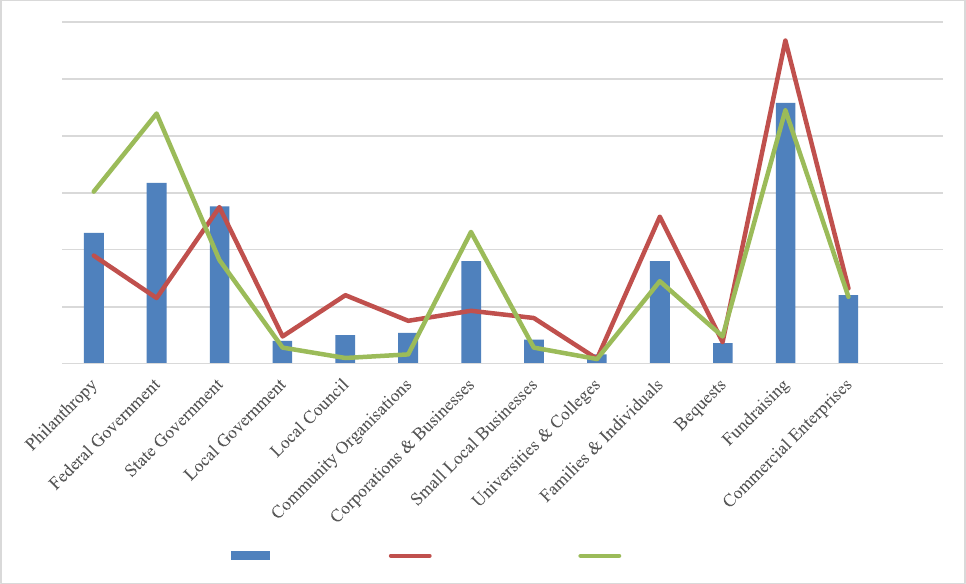
124
Chart 4.1
Income sources & contribution to total annual income of all charities surveyed: All
Incomes vs. Income < $500k vs. Income > $10m
Chart 4.1 displays the data previously provided in Table 4.2 in chart form. It shows the
income various income sources of charitiesPhilanthropy or Bequestsand how
these income sources contribute to the total annual income of charities of all incomes
combined (All Incomes), charities with an annual income of less than $500,000 (Income >
$500k) and charities with an annual income of greater than $10,000,000 (Income > $1m). As
examples, charities with an income greater than $10,000,000 (Income < $10m) received
21.96% of their annual income from Federal Government, charities with an income of less
than $500k (Income > $500k) received 12
whilst all charities of all combined incomes (All Incomes) received 9% of their
total annual income from Corporations & Business. Charities with an income of less than
$500,000 rely less on funding from Philanthropy, Federal Government and Corporations &
Businesses than charities with incomes of greater than $10 million. Indeed, Federal
Government contributes 22% of the annual revenue of large income charities in comparison
to just 5.8% of smaller income charities, or almost four times the amount. Corporations &
Businesses also seem to have a preference in directing funds to larger income charities,
providing 11.6% of annual revenue in comparison to the 4.7% of annual revenue provided to
0%
5%
10%
15%
20%
25%
30%
All Incomes Income < $500k Income > $10m

125
charities with smaller incomes. The gap is similar with philanthropy which contributes 9.5%
of revenue to charities with smaller incomes against 15.1% provided to larger income
charities. Charities with an income of less than $500,000 rely more on localised funding,
specifically Local Government, Local Council, Community Organisations and Families &
Individuals than their larger income counterparts. But as these smaller income charities also
receive fewer funds from Philanthropy, Federal Government and Corporations &
Businesses, this explains why Fundraising contributes more to the revenue of smaller income
charities in comparison to their larger income counterparts.
With regard to Question 3 ‘With regards to your organisation’s total annual income and all
the donations/grants that contribute to that income, what proportion of donations/grants
generates what contribution?’, the information obtained from respondents is displayed in the
following table. The results for this question were also calculated using a Repeated Measure
– Analysis of Variance (ANOVA) statistical technique. The aforementioned Scenario 2, as
used in Question 1, is also appropriate to this question as the size of donations/grants received
by survey participants (charities) are being measured across bands (e.g., $10,000 - $25,000)
and then how each band of donations/grants contributes
Table 4.3
Size of donations/grants received & contribution to annual income of all charities
surveyed
Size of Donations/Grants
Contribution
Standard
Error
95% Confidence Interval
Lower
Upper
Less than $10,000
35.9%
0.018
32.3
39.5
$10,001 - $25,000
14.8%
0.009
13.0
16.6
$25,001 - $50,000
15.4%
0.009
13.6
17.2
$50,001 - $100,000
13%
0.009
11.2
14.9
$100,001 - $250,000
5.6%
0.006
4.4
6.8
$250,001 - $500,000
3.5%
0.006
2.3
4.7
$500,001 - $1,000,000
1.9%
0.005
0.9
2.9
$1,000,001 - $2,500,000
2.8%
0.007
1.4
4.1
$2,500,001 - $5,000,000
1.6%
0.006
0.5
2.8
Over $5,000,000
2.4%
0.007
1.0
3.8

126
Table 4.3 displays the size of donations or grants from which charities receive income and the
contribution that these donations or grants make towards the annual income of charities. As
examples, donations or grants of less than $10,000 contribute up to 35.9% of the annual
income of charities participating in this study, whilst donations or grants of over $5,000,000
contribute just 2.4%. Over a third (35.9%) of donations or grants awarded to Australian
charities are for less than $10,000, and a further 14.8% for less than $25,000.
This information complements the aforementioned
specifically looked at philanthropic funding and stated:
“…the majority of grants are small and fragmented with 80% of grants made being for less
than $50,000…” (Anderson, 2013, p. 4).
“…36.3% of grants were for $10,000 or less…” (Anderson, 2013, p. 17).
“…many organisations are supported by multiple grants from different foundations, though
there is little evidence of co-funding let alone collaboration on projects…” (Anderson,
2013, p. 4).
Less than one fifth of all donations and grants provided to charities were for over $100,000,
which would suggest that charities are already in a position of financial compromise. The fact
that almost 36% of donations or grants is secured from donations or grants of less than
$10,000 signals that the ratio of transactions for each dollar secured will be high. When a
comparison is made between charities of differing income sizes, the situation becomes more
apparent with the profile of the size of donations and grants changing.
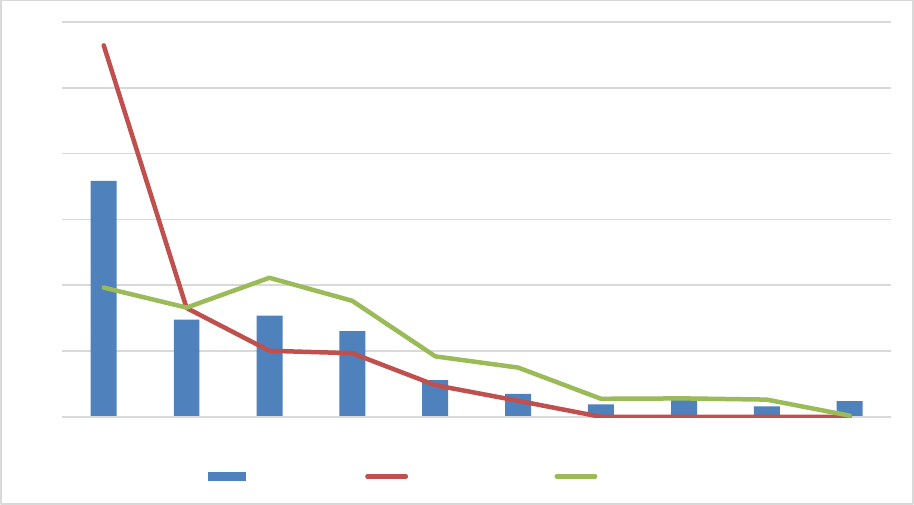
127
Chart 4.2
Size of donations/grants received & contribution to total annual income of all charities
surveyed: All Incomes vs. Income < $500k vs. Income > $10m
Chart 4.2 displays the data previously provided in Table 4.3 in chart form showing the
contribution that donations and grants make towards the annual income of charities. It shows
the size of donations/grants received by charities, such as, those of less than $10,000 (< $10k)
and those of less than $100, 000 (<$100k) and how these donations/grants contribute to the
total annual income of charities of all incomes combined all (All Incomes), charities with an
annual income of less than $500,000 (Income > $500k) and charities with an annual income
of greater than $10,000.000 (Income > $10m). As examples, charities with an income greater
than $10,000,000 (Income < $10m) received 21.1% of their annual income from
donations/grants of less than $50,000 (< $50k), charities with an income of less than $500k
(Income > $500k) received 56.5% their annual income from donations/grants of less than
$10,000 (< $10k) whilst all charities of all combined incomes (All Incomes) received 9.7% of
their total annual income from donations/grants of less than $500,000.
Charities with an income of less than $500,000 are almost three times as likely to be awarded
a donation or grant of less than $10,000 than are charities with an income of over $10m. This
would signal that smaller income charities have significantly higher administration costs than
their larger income counterparts in undertaking what are burdensome grant application
0%
10%
20%
30%
40%
50%
60%
< $10k < $25k < $50k < $100k < $250k < $500k < $1m < $2.5m < $5m > $5m
All Incomes Income < $500k Income > $10m
128
processes and they allocate a far greater ratio of resources towards fundraising activities than
to service delivery. With regard to the contribution to income of donations or grants of less
than $10,000, charities with smaller incomes receive more than half (56.5%) of their annual
revenue from this source. This compares with charities of all incomes and those with an
income > $10m, who receive 35.9% and 19.7% respectively. When donations or grants start
to exceed the $25,000 mark, the larger income charities attract about double the amount than
smaller income organisations. And once beyond the $1m mark, smaller income charities
receive nothing. Larger income charities do seem to be more successful at securing more
significant donations or grants over the $50,000 to $100,000 mark. This could be due to
better attracting of funders who wish to commit more financially than do the smaller income
counterparts. Or could it be that these larger income charities are rejecting the opportunity to
receive less significant donations or grants?
With regard to Question 4 /grants received and the term of each
, the
information obtained from respondents is displayed in Table 4.4.
The results for this question were also calculated using a Repeated Measure – Analysis of
Variance (ANOVA) statistical technique. The aforementioned Scenario 2, as used in Question
1, is also appropriate to this question as the term of donations/grants received by survey
participants (charities) are being measured across bands (e.g., Two Years) and then how each

129
Table 4.4
Term of donations/grants received & contribution to income of all charities surveyed
Term of Donations/Grants
Contribution
Standard
Error
95% Confidence
Lower
Upper
One Off
38.5%
0.016
35.4
41.6
One Year
27.5%
0.013
24.8
30.1
Two Years
12.5%
0.008
10.8
14.1
Three Years
9.5%
0.1
7.6
11.4
Four Years
0.7%
0.02
0.4
1
Five Years
1.7%
0.05
0.8
2.7
Over Five Years
0.7%
0.03
0.2
1.3
Table 4.4 displays the term of donations or grants from which charities receive income and
the contribution that these donations or grants make towards the annual income of charities.
As examples, donations or grants with a term of one year contributed towards 27.5% of the
annual income of charities participating in this study, whilst donations or grants with a term
of 5 years contributed 1.7%. Around two-thirds of all donations and grants provided to
Australian charities are either one off or for a term of one year (38.5% + 27.5% = 66%),
which is a model of funding that compromises those charities which are seeking to address
-rooted issues that need long-term action.
Chart 4.3 displays the data previously provided in Table 4.4 in chart form. It shows the term
size of donations/grants received by charities, such as, those of one year (1 Year) or three
years (3 Year) and how the term of these donations/grants contribute to the total annual
income of charities of all incomes combined all (All Incomes), charities with an annual
income of less than $500,000 (Income > $500k) and charities with an annual income of
greater than $10,000.000 (Income > $10m). As examples, charities with an income greater
than $10,000,000 (Income < $10m) received 21% of their donations/grants with a term of
two years (2 Years), charities with an income of less than $500k (Income > $500k) received
7% their annual income from donations/grants with a term of two years (2 Years), whilst all
charities of all combined incomes (All Incomes) received 28% of their total annual income
from donations/grants with terms of two years (2 Years).
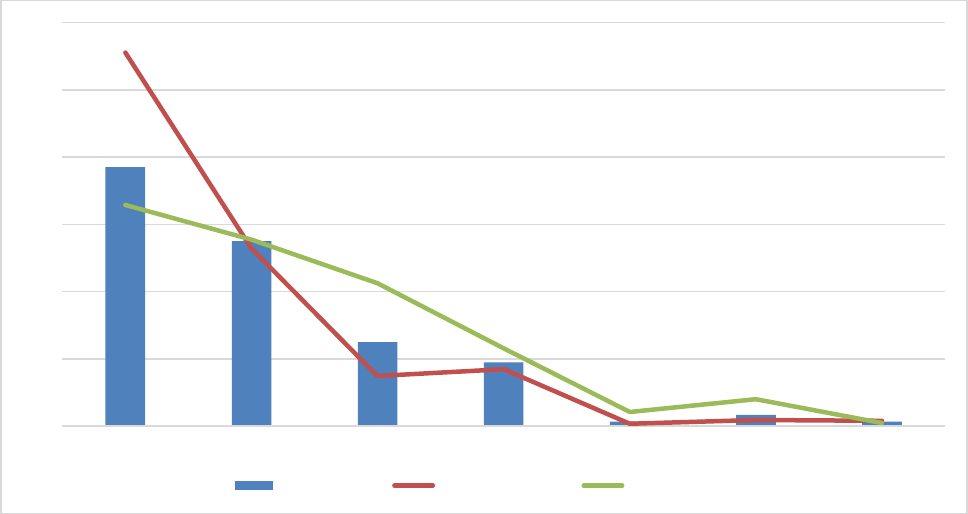
130
Chart 4.3
Term of donations/grants received & contribution to income of all charities surveyed:
All Incomes vs. Income < $500k vs. Income > $10m
Similar to the findings as displayed in Chart 4.2, charities with larger incomes seem to be
better at attracting funds which offer more certainty and stability than are charities with
smaller incomes. However, it should be noted that despite better success in securing longer-
term funding, the grants or donations that charities with larger incomes receive are still very
--off or for one year. Smaller
income organisations are compromised further, with over 80% of grants or donations
received being either a one-off or for a term of one year.
0%
10%
20%
30%
40%
50%
60%
One Off 1 Year 2 Year 3 Year 4 Year 5 Year > 5 Year
All Incomes Income < $500k Income > $10m
131
4.4 Conclusions
The purpose of this chapter was to discover what funding is available to charities in terms of
what are the size and term of the grants or donations on offer and from where do these funds
originate, in order to answer the research sub-question ‘how does the funding of charities
currently occur?’ Funders of all types appear to have a preference for providing small, short-
term funding and, whilst larger income charities tend to attract slightly longer-term and more
financially significant awards, the majority of their funding is still small and short-term. The
challenge for smaller income charities is even greater than that faced by their larger income
counterparts, as a greater proportion of their income is derived from small and short-term
funding, which places an increased administration burden on these smaller income charities.
This chapter fills the gap in existing literature regarding how charities are funded by
empirically proving that charities are primarily funded by small, short-term donations and
grants. As such, it supports the claim made by charities in Chapter 1 regarding the size and
term of donations and grants provided. The impact this model of funding has on the
organisational effectiveness and efficiency of charities is explored in Chapter 7.

132
Chapter 5 - Findings from the interviews with charity
leaders
5.1 Introduction
As stated in earlier chapters, this research was conducted in three tranches of data collection:
• Tranche 1 - Financial Survey
o This phase of the research was undertaken to discover what funding is
available to charities in relation to the size and term of the grants or donations
on offer and from where do these funds originate.
• Tranche 2 - Interviews with charity leaders
o This phase of the research was undertaken to discover how current funding
models impact on the organisational effectiveness and efficiency of charities.
• Tranche 3 - Interviews with funders
o This phase of the research was undertaken to discover what opinion funders
have on the effectiveness and efficiency of charities, the funding models they
employ and how they view their own motivations and performance.
-questions:
• How does the funding of charities currently occur?
• What is the nature of the relationship between charities and their funders?
As stated in Chapter 3, an initial target of 20 interviews with charity leaders was selected for
data collection. However, due to theoretical saturation, data collection was stopped after 12
interviews. Theoretical saturation occurs when the data collected is adequate for the
objectives of the research and no new information is being discovered through subsequent
interviews (Faulkner & Trotter, 2017; Saunders et al., 2018).
A profile of the charity leaders interviewed is presented in Table 5.1.

133
Table 5.1
Profile of charity leaders interviewed
ID
Position
Held
Areas of focus
Income
Income sources
1
CEO
Charity Education
$2m
Grants & donations.
2
CEO
University scholarships
$3m
Grants & donations.
3
CEO
Youth at risk
$10m
Federal Government grants.
4
GM
Vulnerable children
$120m
Grants & donations, corpus,
commercial enterprises.
5
GM
Girls rights and education
$50m
Federal Government grants,
other grants & donations.
6
COO
Early childhood literacy &
numeracy
$7m
Grants & donations, commercial
enterprises.
7
CFO
Early childhood literacy &
numeracy
$13
Grants & donations.
8
GM
Children with cancer
$15m
Grants & donations.
9
CEO
Schools in need
$5m
Donations, commercial
enterprises.
10
CEO
Vulnerable children
$10m
Grants & donations.
11
CEO
Youth at risk
$60m
Grants & donations, commercial
enterprises.
12
GM
Children and youth education
$100m
Grants & donations, commercial
enterprises.
As stated previously in Chapter 3, the charities who participated in this research were invited
to participate the Origin Foundation, the philanthropic arm of Origin Energy, which has
developed a sizeable network of charity partners since its inception in 2010. As defined by
the Australian Charities and Not-for-profit Commission, charities can be classified as:
• Small charities if they have an annual revenue under $250,000.
• Medium charities if they have a revenue of between $250,000 and $1 million.
• Large charities if they have an annual revenue of $1 million or more.
(Australian Charities and Not-for-Profit Commission, 2021a)
As no small or medium sized charities volunteered to participate in this study, the researcher
acknowledges that the charity leaders participating are representing only large charities and

134
The patterns emerging from the interviews with charity leaders were captured by Nvivo and
coded into domain summaries and themes (Braun & Clarke, 2006), which are presented in
Table 5.2.
A domain summary can be described as a summary of an area of the data collected, for
example, as an abridgement of everything research participants have stated relating to a
certain topic or question (Nowell, Norris, White, & Moules, 2017). Braun & Clarke (2017)
described domain summaries as ss associated with
a particular portion of the data is assigned (Braun & Clarke, 2017). Themes, the things that go
into buckets, can be described as patterns within the data collected or a central concept that
unites observations about the data (Braun & Clarke, 2017).
When undertaking data analysis, the researcher becomes the analysis tool and has to make
judgments about allocating data into domain summaries and themes (Starks & Brown
Trinidad, 2007). It is the responsibility of the researcher to ensure integrity and rigour are
maintained throughout the process (Nowell et al., 2017). Domain summaries for this tranche
of this study were established by categorising each relevant quotation from charity leaders
into , a process that was repeated many times until the researcher was confident that
the content in each was appropriate to that . Themes were then introduced
and each relevant quotation from charity leaders were allocated against a theme, a process
that was also repeated many times until the researcher was confident with the allocations.
Titles for both the domain summaries and themes were then established. A full listing of all
quotations taken from Charity Leaders through the interview process and listed under the
relevant Domain Summary can be found at Appendix 2 (
).

135
Table 5.2
Domain Summaries and Themes Charity Leaders
Examples of domain summaries for this tranche of this research are The complexities of
securing a grant’ or ‘The diminished ability to establish and follow any form of strategic
path’ as in Table 5.2.
Examples of themes for this tranche of this research ‘Grant application processes’ or
Domain Summary
Themes
The complexities of securing a grant
(Due to space limitations, this Domain Summary is
abbreviated to Complexities in Chart 5.1)
Grant application processes
Organisational instability
Motivations
Mission Creep
The diminished ability to establish and follow any form
of strategic path
(Abbreviated to Strategy in Chart 5.1)
Tactical versus strategic funding
Size and term of donations or grants
The inability to invest in programmes or projects that
(Abbreviated to Performance in Chart 5.1)
Capacity building
Administration costs
Funding contradictions
The disproportionate amount of organisational resource
deployed to secure and maintain future funding streams
(Abbreviated to Resourcing in Chart 5.1)
Ineffectiveness and inefficiency
Reporting
The realities of being a charity employee
(Abbreviated to Reality in Chart 5.1)
Employment issues
Funders opinion of charities
The well-being of charity employees
The partisan nature of government contracts
(Abbreviated to Government in Chart 5.1)
Government
Power imbalance
The unwillingness or inability of charities to articulate to
funders the deficiencies of the current funding models
(Abbreviated to Articulation in Chart 5.1)
Collaboration
Feedback
Collective voice
(Abbreviated to Awareness in Chart 5.1)
Ignorance of impact
Performance
Community impact
Cost neutrality
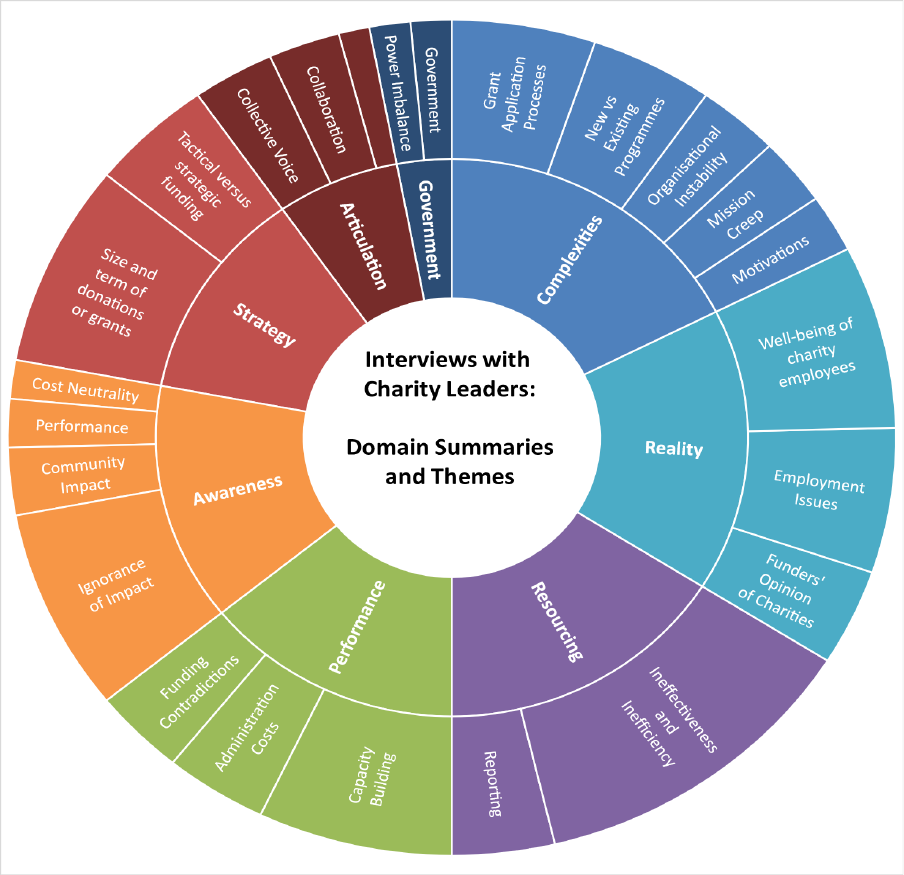
136
Tactical versus strategic funding’, again in Table 5.2. A proportional representation of the
domain summaries and themes, as extracted from Nvivo, can be found in Chart 5.1.
Chart 5.1
Domain Summaries and Themes Charity Leaders
As presented in Chart 5.1, many themes emerged from interviews with charity leaders
regarding the effect and consequences that current funding models have on the organisational
effectiveness and efficiency of charities. These emergent themes do not stand alone, they are
interrelated. As an example, a burdensome grant application process is likely to increase
administration costs, which is an ineffective use of charity resource. To enable a deeper
exploration, these emergent themes are not explored here at a semantic level, instead a latent
138
5.2 Discovering emergent themes
In this section, emergent themes are explored under their respective domain summaries and in
the order presented in Table 5.2.
5.2.1 The complexities of securing a grant
There are many differing funding sources available for charities, such as federal and state
government, corporate or large business and philanthropy. Charities may see the availability
of such a diverse range of funding sources as an advantage, in that the risk of one or more
funding stream being withdrawn is diluted if there are many other funding sources available.
Grant application processes
Charities appear to view the many differing funding sources as a disadvantage due to the
resources required to administer the vast number of funding applications that have to be
submitted in order to just secure sufficient funding to maintain operations. Beyond the
volume of applications submitted in the pursuit of securing donations or grants and the
associated costs, charity leaders are critical of several aspects of the application processes,
which vary significantly from funder to funder.
If an individual, family or organisation chooses to give away a substantial sum of money for
community benefit, it would be unlikely that any of them would want this money to be
squandered. It would therefore be a reasonable assumption that robust processes would be in
place to ensure that this money was not squandered but instead distributed in a manner that
was both effective and impactful. However, this is not generally the case. Indeed, the many
differing funding application processes employed drive significant inefficiencies across the
charity sector, where the highly subjective processes and lack of specific feedback causes
great bewilderment to those employed within. Charity leaders captured this pattern as
follows: ost grant application/selection processes are highly subjective… (Charity
Leader 10). Another added,
“…selection criteria vary month-to-month and year-to-year within the same funding
organisations … you will submit a grant application one year, which will be successful,
submit a very similar application the following year and fail or vice versa…” (Charity
Leader 8).
139
This is indeed a challenging and changeable scenario, fraught with uncertainty. These
subjective criteria are not just limited to changes in application criteria. Some funders
do not seem to take into account the legitimacy of the application at all, as one charity
leader stated: ome funders encourage you to keep applying again and again, suggesting
that the reward is for effort and persistence not the content or validity of your application…”
(Charity Leader 8).
When assessments of well-considered documentation are judged against unspecified and
subjective criteria or a whim, the respect between the fundee and the funder lessens. For
example, adjusting eligibility criteria after finalising the call for applications can be
devastating, with one charity leader stating:
“…we recently submitted a grant application to a funder who had supported us the
year previously… our application was unsuccessful despite having very similar
goals/deliverables to the previous year’s submission … the reason [feedback] given for
our application being unsuccessful was that we had secured a grant the year previous
… this did leave us scratching our head a bit…” (Charity Leader 11).
It is difficult to comprehend that sizeable funds would be distributed in such a subjective
manner. What is even more perplexing is that some funders apparently seem happy to expose
the fact that they go about the business of giving significant sums of money away using such
an approach. Unless the methods of selection used by funders are known by the applicants, a
impact as follows:
“…the lack of process transparency and alignment within the trusts/foundation
environment puts the third sector at an immediate disadvantage in securing funds from
the majority of these organisations as we are often unsure what they are looking for
and what is of optimum importance to them…” (Charity Leader 12).
The subjectivity and inconsistency of the many differing funding application processes is not
the only contributor to the confusion and exasperation of applicants; feedback and/or lack of
feedback also plays a significant part. Several charity leaders noted the absence or lack of
opportunity as influencing their future decision making around grants stating:
“…feedback from … grant applications are more than often not forthcoming … it is
then difficult to know what needs adjusting in order to have success in a future grant
140
application…” (Charity Leader 3).
“...feedback from funders … is pretty much non-existent … consequently, there is no
evidence on which to help improve the quality and success rate of grant
applications…” (Charity Leader 7).
“…due to a dearth of comprehensive feedback; it can be almost impossible to
understand why a grant application was either successful or not…” (Charity Leader
10).
Without appropriate feedback, charities cannot assess the validity of the grant applications
they submit. Beyond the acknowledgement from funders regarding the success of a grant
funding application, the time taken to provide this acknowledgement can also cause
organisational issues.
Organisational instability
Charities need to learn to live in a kind of limbo between the submission of their funding
application and notification of some form of feedback regarding the outcome of the process.
The lack of feedback and responsiveness of funders can hamper everyday decision making
and create a financially unstable operating. This environment: “…reduces the ability of charities
to react quickly to whatever issue is at hand…” (Charity Leader 10). Similarly,
“… the time to receive notification of a grant application outcome, either way, also causes
inefficiencies … the time lag does not afford us stability or allow us to be as quick on our feet
as we would like to be…” (Charity Leader 8).
This lack of understanding by funders about the timeliness of their decisions is a concern:
“…a question must be posed to funders regarding their assessment of the efficiency of their
application/approval processes, which can take up to a year…and with little feedback to the
applicant; what are they doing…” (Charity Leader 5).
Questions need to be asked of funders about why feedback on grant applications is less than
forthcoming and why the applications take so long to be processed and brought to a
conclusion. An opportunity to improve the quality of applications through such a feedback
loop is being overlooked, as is the opportunity to quicken the grant application process.
However, these opportunities for improvement seem unimportant to funders.
141
The unpredictable, inconsistent, and varying funding application processes, along with the
lack of reliable feedback from funders, drives an irritation across the charity sector because
few can draw productive conclusions as to why an application for funding was successful or
not. One charity leader commented on the apparent lack of concern by funders, describing
some of the current application processes as being funders taking a scattergun approach to
their distributions, stating:
“…this funder wishes to use their funds to support many organisations rather than allocate
their funds on the quality of grant applications … allocating funding in this manner doesn’t
make much sense as it is clearly not the most effective use of the allocated funds…” (Charity
Leader 12).
Perhaps this approach might indicate that many funders may actually have a lack of
knowledge around what programmes deliver the best outcomes, as one charity leader
suggested: “…this could indicate an ignorance of what works and works well…” (Charity Leader
8).
This lack of knowledge from funders regarding what programmes deliver the best outcomes
may be a driver in pushing funders towards seeking what they see as newer, more innovative,
and more exciting ideas.
‘New’ versus ‘existing’ programmes
Charity leaders were particularly critical of funders seeking to prioritise investment in new
programmes and the consequences of such decision making, stating:
“…funders do seem to like funding new programmes and fund pilot programmes that have
not been funded previously…” (Charity Leader 7)
“…funders also tend to want to fund new programmes or innovation … have funders
considered that as the sector is bathed in uncertainty…that the inability to plan and operate
long term is causing the sector to regress…” (Charity Leader 8)
“…some funders seem to treat philanthropy as a fashion statement, as in, what are this
season’s new styles … most grant managers will state that their board wants to see something
new…” (Charity Leader 2).

142
“…there also seems to be a current desire from funders to invest in something new, possible
driven by a ‘feel good’ factor that a particular programme/outcome can be attributed back to
the funding organisation…” (Charity Leader 4).
An apparently unspoken preference seems to exist for funding new and shorter-term pilot
programmes. More than just funding new and innovative programmes, it appears that often
funders: “…lose interest in long-term programmes and often ask why the need remains and why the
issue has not been rectified…” (Charity Leader 7).
Motivations
The concern here is the apparent
funding to short-
captured very succinctly in the following reflection:
“…there is little appetite for existing programmes with proven outcomes…which would
seem to indicate that some funders have more interest in achieving a short term ‘we did
that’ rather than helping deliver long term benefits …it is quite concerning to think that
funders … believe that long-term entrenched community issues can be resolved via
short term programmes or one-off funding cycles…” (Charity Leader 3).
Mission creep
Rather than critique these changing priorities, charities find themselves needing to adopt
them if they wish to be successful in securing funding with these un-principled changes in
funders priorities, leading to a deepening pragmatism. These ideological effects are
described as “mission creep” (Charity Leader 4). Originally associated with military and
charity sector is when an organisation strays
from the reason it was initially created. It can compromise an organisation to the extent it can
no longer effectively pursue its objectives (Gonzales, 2012; Jonker & Mehan, 2014; Phills,
2005). a risky proposition for some charities as they may
accept conditions associated with funding that they are unable to competently deliver with
conviction.
Beyond the complexities associated with funding from the non-government sectors, such as
corporates and philanthropics, federal and state governments add additional trials, especially
when a programme has a national footprint and expands across differing government
143
departments. As an example, a charity may be seeking funding to operate a programme that
would assist in better preparing young children for school. From a Federal Government
perspective, there may be funds available from the Department of Education and Training.
Additionally, if the programme has a science component or a focus on a vulnerable or
disadvantaged community then there may be further funds available through the Department
of Industry, Innovation and Science, or the Department of Social Services, respectively. If the
intention is to roll this programme out across all states and territories, then the charity is also
likely to seek funding support through the relevant state and territory equivalents of the
aforementioned federal government departments. This could equate to as many as 30
differing grant applications, all of which are likely to have differing application processes,
selection criteria and timelines. And this is all before consideration is given to other
alternative sources of funding, such as private ancillary funds or individual fundraising.
Reflecting on the feedback from charity leaders regarding the complexities of securing
funding, it would be difficult to envisage many commercial organisations operating in such
an unstable environment with similar administrative burdens. The fickle and subjective nature
of the various grant application processes must be known to funders. After all, they are their
own processes. Allowing such processes to persist signals a disparity within the
funder/fundee relationship ye funds
5.2.2 The diminished ability to establish and follow any form of strategic
path
Tactical versus strategic funding
plan is generally the result of a detailed analysis of how an
organisation needs to develop in order to meet its long-term objectives. This plan would state
what actions are required in order to achieve the desired organisational changes. Actions may
include the development of new products and/or services, recruitment of specific skills,
training and development of existing employees, or investment in organisational
infrastructure such as information technology. Strategic plans are critical for organisations of
all types, yet funders appear to place little value on the need for strategic plans across the
charity sector, as one charity leader stated:
“…current funding available from most funders is tactical, as in, the grants are mostly
144
short-term and small … as a result, it is challenging to have any strategic focus … or
invest in long term plans ... a change in funders’ focus from tactical to strategic would
be of great benefit…” (Charity Leader 3).
The lack of forward planning is a risk for charities because it can include a diminishing
priority for longer-term sustainability, the priority and creep of pragmatic thinking, and the
loss of acknowledgement of the levels of funding needed in order to have a critical impact
over a longer period of time. This compromise was captured by one charity leader:
“…the lack of long-term granting compromises charities, who then find it difficult to
focus on long-term strategy … short-term funding does not lead to achieving critical
impacts, particularly in areas where change happens over 5 to10 year periods rather
than 1-2 years … multi-year funding enables long-term planning around key
interventions…” (Charity Leader 4).
Size and term of donations or grants
The lack of funding needed to advance strategic initiatives undermines the operational
capacities of charities and leads to higher employee turnover in an increasingly unstable
context. More specifically,
“…current funding models are driving inefficiencies in the sector … the inability to
secure substantial long-term financial support results in tactical, unstable
organisations … employee turn-over rate is higher as a result … decision making can
also be compromised, which is unsurprising if you have only three months working
capital and 50 employees…” (Charity Leader 9).
Additionally: “…current funding available from most organisations is very tactical…the grants are
mostly short term and small…” (Charity Leader 3). One charity leader summarised the present
scenario concisely as, “…the need for long term funding is critical to the sector progressing…”
(Charity Leader 4).
The question needs to be asked of funders as to why there is little appetite to help progress
the impact of the charities they fund through the provision of longer-term, more significant
funding. As a result of this lack of appetite, opportunities for charities to construct their own
strategic paths are limited, as it is difficult to secure the more traditional sources of funding
commonly available to commercial organisations. One particular charity leader confirmed
this position, stating:
“…there are a small number of private philanthropists who are willing to fund …
145
development items but the vast majority of funders will not, preferring instead to fund
particular/specific programmes and generally want something new and shiny…most donors
want their funding spent on ‘front line’ activities…” (Charity Leader 1).
However, there are examples of charities taking a more adaptive strategic approach, as
evidenced by one charity leader:
“…we previously followed, what I would describe as being a linear model… we would
plan an event, raise funds through that event and then donate these funds…our model
is now much more project focussed, as in, a particular need will be identified by a
hospital or health fund…we will then target our fundraising activities towards funders
who are more likely to support this particular need and work towards fundraising for a
specific amount that will allow the project to be delivered…” (Charity Leader 11).
Another example of a charity adopting a more adaptive strategy approach in trying to
optimise the impact of funding is as follows:
“…we are a large education focussed charity…we do have a proven talent for
fundraising, as an income well in excess of $50m per annum would substantiate
...however…we were seeing a really worrying trend; a drop in corporate partnership
income…we knew that we had to change tack and this change would have to be
dramatic…we restructured the corporate partnership department…we put an intense
focus on securing long term high value partners…and we introduced a pipeline
management tool introduced to ensure that we are effectively tracking the prospective
income…in the two years since the restructure, we delivered 11.6% growth in 2016 –
our best result since the GFC in 2009…even more pleasing when you consider that
market growth in this segment (corporate partnerships) had declined 11.3% to FY15
(Pareto Benchmarking)…and we are on track to deliver further growth in FY17…”
(Charity Leader 11).
Whilst a small number of charities in the suite of informants for this research were
demonstrating innovation and progression, most were not, due to the lack of appetite in
providing financial support for such organisational development and capacity building
activities.
5.2.3 The inability to invest in programmes or projects that would enhance
effectiveness and efficiency
Capacity building
146
Beyond the lack of desire to help charities construct and follow a strategic plan, funders are
reluctant to provide support for other organisational advancement activities such as training
and development or information technology infrastructure that would help boost
performance. This approach is noticed by charity leaders and its impacts on everyday
activities, but they appear powerless to make a difference. One charity leader lamented this
situation, stating:
“…as a leader in the charity sector you can see – very clearly – the opportunities to
increase efficiencies, effectiveness and outputs … but through a lack of funding you can
rarely exploit them…this can be soul destroying … leading an organisation with only
three months working capital is very, very challenging…” (Charity Leader 1).
This charity leader also stated that the difference between the resourcing of charities and
commercial organisations is explicit:
“…organisational infrastructure, training and development of employees, quality
accommodation, reward/remuneration, are all accepted as necessary and even critical
investments by commercial organisations in order to progress…” (Charity Leader 1).
Administration costs
A number of charity leaders were consistent in their suggestions as to where additional
support might be best utilised. Additional support for IT in particular would reduce
administration costs that would then release additional resources to focus on mission and
improve impact. This difference in perspective between charities and their funders over
organisational development support was described as a disconnect. One charity leader
commented,
“…the ability to continually enhance our systems and processes is limited … as an
organisation with a potential footprint of close to 5000 schools across all states and
territories, IT advancements would do so much to reduce administration costs, which is
what our funders want … unfortunately, the same funders do not want to fund these
administration improvements … this disconnect needs addressing…” (Charity Leader
9).
In the commercial world, investment in the training and development of employees is a
given. This training and development can take many forms, such as being briefed about new
products and services, learning about a new I.T. system, or career progression activities
147
includin
time, space or funding to invest in its employees is having a noticeable impact on
performance. One charity leader provided a very illuminating example of the impact of
limiting investment in training and development:
“…we had a two-year $50,000 per annum funding agreement with a national courier
company that was coming to a conclusion … the responsible fundraising manager
could see a solution to filling this $100,000 gap but rather than state the obvious he
wanted his team to think more laterally and identify the answer themselves … the
manager asked his team to consider all the options…after a few days, the team
presented their strategy which focussed on sourcing funds through grant applications
to the usual suspects…the manager again pressed the team to consider alternative
strategies and they agreed to meet the following week with an updated proposal … the
updated proposal was more of the same, further grant applications but this time to a
different raft of funders …the manager asked his team to try again but the next
proposal wasn’t much different…getting frustrated with the lack of imagination from
his team, the manager took a more explicit tact…he asked his team to review the
annual costs associated with their ‘School Reading Programme’…the team
investigated and provided the following: 40% or around $100,000 went on buying
books, a further 40% went on sourcing and administering the ‘reading’ volunteers
required and the last 20% or around $50,000 was the cost of delivering the books to
the schools…the manager asked the team if they could see an opportunity but despite it
being conspicuous to him, they still couldn’t…he then asked them if they could get the
courier company to deliver the books to the schools for them pro-bono, ‘we don’t
know’, was the reply, ‘well go and ask’…this example is not a reflection on the
capabilities of the employees involved …they are fabulous at what they do – which is
fundraising… the criticism here is of the narrow capability that has been allowed to
develop – which is due to the fact that all this team does is fundraise…our managers
cannot afford the time or expense to develop their people… as such, our effectiveness is
well compromised…” (Charity Leader 12).
Another charity leader put the onus on other charity leaders to provide a differing perspective
on the need for greater investment in organisational development from funders: convince
funders that investment in people and infrastructure is not just OK but a necessity for better
programme outcomes…” (Charity Leader 5).
148
Funding contradictions
It would seem a contradictory position that funders, who look to support community
progression, would have little interest in helping the very organisations they task to
achieve this community progression to get better at what they do. As one charity leader
stated: “…charities, whilst generally established for a community purpose, are still
organisations and need similar investment in order to thrive … this point seems to be lost on
most funders…” (Charity Leader 1).
Funders generally provide funding in support of charities delivering particular
community outcomes, whether they be better health outcomes, improved education
attainment or enhanced employment opportunities. This signals that funders are
interested in helping certain aspects of the community to progress. However, it would
seem funders are saying, I want to provide funds for you to use to support communities
who are experiencing health issues, education disadvantage, unemployment and so
forth but I do not want you doing too well at what you do. A more effective and
efficient charity could deliver more to the community for a lower investment, but this
seems to be lost or is apparently of lower importance to funders than other matters.
To an outside observer, the reluctance to fund capacity building type initiatives makes no
sense, as this tack inhibits performance progression. Much like the approach taken with
regards to their inconsistent and subjective grant application processes, funders are again
imposing their control within the funder/fundee relationship. Follow our rules or seek ye
funds elsewhere. Unfortunately, there are no alternative funding options available to charities.
5.2.4 The disproportionate amount of organisational resource deployed to
secure and maintain future funding streams
Ineffectiveness and inefficiency
As stated in the previous section, the many sources of funding and the vastly differing
application processes create significant challenges for the whole charity sector. One challenge
is that of the resource required to secure and maintain funding streams. In addition to the
resource required for grant applications, there is also a resource requirement for maintaining
successful grant applications, that is, the resource required in providing acquittal reports back
to funders. This can be a significant and sometimes unnecessary amount of organisational
149
effort. This ineffective use of time and effort is a particular challenge with small grants and
donations, with charity leaders stating:
“…small grants/donations are hugely ineffective … the time and effort expended in pursuing
small grants is substantial…” (Charity Leader 7) …the administration required to
pursue, and secure small grants/donations is huge..” (Charity Leader 9).
That grant application processes are often described as onerous is exemplified in the
following:
“…applying for grants takes a lot of time … and you have a low success rate … due to the
current preference from funders to provide small short-term grants, sourcing grants to fund a
programme can take many months and the window of opportunity for the programme can
often close … this is a significant waste of resource…” (Charity Leader 6) and he
process is onerous, and you have a success rate of around 10% ... success is one or
two major wins a year…” (Charity Leader 5).
Charity leaders are critical of this funding model with one suggesting:
“…funders could be more fleet of foot and not entrenched in funding cycle models which are
decades old … raising pooled funding (small grants from a variety of funders) is hard
work…and if total funds for the programme are not raised, you then have to return what was
raised…not a good use of our resources…” (Charity Leader 6).
Reporting
Beyond the arduous grant application processes, the perceived value added through the
acquittal reporting was questioned and heavily criticised by charity leaders:
“…acquittal reporting takes a significant amount of resource for very little return…our
acquittal reports to funders are very rarely challenged or questioned. Why? (Charity
Leader 3) and unders place unreasonable demands for detailed acquittal reporting…yet
from our own experience, very little is ever done with the reports submitted…” (Charity
Leader 8).
A solution would to privilege longer-term grants as a way of offering greater certainty while
also lessening acquittal requirements. As a charity leader stated:
“…larger longer-term grants would provide much greater certainty and allow charities to
focus on core activities…a reduction in some of the more onerous acquittal reporting
requirements from funders – especially for small grants - would also help…” (Charity
Leader 2).
There appears to be little or no appreciation from funders regarding the effort expended by
150
charities participating in such burdensome processes. Funders continue to demand
comprehensive acquittal reports, yet charity leaders claim these reports are rarely used.
Demanding the use of processes that add little value raises a question about the trust that
funders have in charities. Having to demonstrate exactly where every donated dollar went
does not indicate that funders have confidence that charities will always behave in the
appropriate manner. Indeed, these practices suggest that funders have apparently little trust in
the organisations they support.
5.2.5 The realities of being a charity employee
Employment issues
The charity sector often cites poor remuneration as one of the main reasons for its high
employee attrition rate. Feedback from charity leaders interviewed for this research confirms
this belief. However, there are other factors at play including job security:
“…we have limited ability to attract and retain the best quality of staff…short term funding
contributes to this challenge inhibiting our ability to have any form of long-term
plan…employees in many, many industries aspire for employment security…why is this goal
largely unattainable for most in the sector?... support via longer term more substantial
funding would help significantly…” (Charity Leader 8).
Similarly,
“…charities have little ability to invest in attracting and retaining quality staff … improving
recruitment capability would help significantly … whilst the working environment can offer
significant benefits (flexibility, community-minded work, etc), the limitations to offer
competitive salaries is a significant barrier in attracting and retaining excellence…”
(Charity Leader 7).
The differences in certainty of provision, and the comparisons between charity and for-profit
terms and conditions, also have a negative effect:
“…employees within the charity sector … have the same aspirations as many others,
the ability to buy a house and provide a stable safe environment for their families…that
can be difficult when you are on a rolling six-month contract…” (Charity Leader 7).
Further,
“…I find it intriguing as to why there seems to be a general consensus that if you work
in the charitable sector, there is no need to for you to be rewarded financially at an
appropriate / market rate … I’m not sure why this is so but it must be a barrier to

151
attracting and retaining talent…” (Charity Leader 11).
Beyond job security, some charity employees want to have suitable facilities from which to
work, with one stating:
“…facilities could also be improved – buildings and furniture … there seems to be a
growing acceptance that it is quite satisfactory to house charities in the most run-down
buildings available and furnish these buildings with office equipment that is on its way
to the dump … it is not a nice way to be treated…” (Charity Leader 9).
This attitude towards charity employees is perplexing. Why should people who are trying to
address some of the most entrenched issues in our communities not be afforded the same
employment rewards as their for-profit counterparts? Many of the organisations within the
charity sector strive to help lift people out of disadvantage and vulnerability and get them to
the point where they are self-reliant both personally and financially. From an economic
perspective, this equates to someone now contributing to the tax pool rather than being a
burden upon it. Working in the charity sector would seem a more deserving outcome than
working in top-end retail selling expensive bags or designer shoes. However, wider society
may not make these comparisons with such scrutiny.
An alternative proposition for a charity employee would be to seek employment in the for-
profit sector, attracting a significantly higher salary than could be expected in a similar role in
the charity sector then donate a good proportion of their for-profit salary to charity (Pallotta,
2008). Whilst this proposition may make sense financially, it would seem to be an
unnecessarily convoluted scheme in order to pacify those who are likely to be ignorant of the
actual needs of the charity sector. The following account tells of a person feeling the need to
justify their employment agreement:
“…I attended an event where the CEO of a large UK charity was presenting, his
opening gambit was around what he earned and why – as his remuneration package
had previously attracted criticism … he articulated his qualifications, experience and
achievements and stated that if he was undertaking a similar role in the commercial or
business sector he could expect a significantly higher financial reward for his efforts
but has chosen to accept these reduced conditions in order to contribute to the sector /
community … the fact that this CEO felt the need to defend his salary tells its own story
about how the sector is viewed by many…” (Charity Leader 11).
152
Funders’ opinion of charities
A high employee churn rate is a significant cost to any organisation and addressing this issue
would likely contribute to significant cost reductions and subsequent effectiveness efficiency
benefits across the charity sector. Certainly, a deficit stigma being felt by employees of
charities is counter-productive to colleagues sharing in the attainment of organisational
aspirations. Similarly, charity leaders question how employees in the sector are viewed by
others, including funders:
“…there is a general perception that those working in the charity sector are
underqualified and couldn’t cut it in the commercial world… really? … many
employees within the charity arena come from the corporate world, as they want to be
involved in making a difference not just making money … sadly, they eventually return
to their former world as they are exhausted … their human capital has not been
invested in wisely … [however, it is also the case that] many remain in the non-profit
arena as they become so embedded within the cause that adequate pay, training or
development opportunities or even decent accommodation become less of the focus…”
(Charity Leader 3).
In fact:
“…the whole of community attitude towards the charity sector and its employees needs to
change if employees are to remain within the sector long term and to reach the outcomes they
set out to achieve…” (Charity Leader 6).
Wellbeing of charity employees
The self-esteem of charity employees is also impacted by the various funding application
processes, and not in a positive manner as several charity leaders confirmed:
“…applying for grants takes a lot of administration time … you have a low success
rate … due to the current preference from funders to provide small short-term grants,
sourcing grants to fund a programme can take many months and the window of
opportunity for the programme can often close … this is a significant waste of resource
and can be emotionally draining…” (Charity Leader 6).
“…the administration costs required to pursue and secure small grants/donations is
huge … the effort can be exhausting…” (Charity Leader 9).
“…it becomes easier to think you are not good at your job… you can quickly become
emotionally tired of pitching…hope gets diluted…” (Charity Leader 5).

153
“…raising pooled funding (small grants from a variety of funders) is hard
work…emotionally exhausting and if total funds for the programme are not raised,
returning funds is heart wrenching for the staff member and counterproductive with
funders…” (Charity Leader 6).
These powerful statements, married to earlier quotations, clearly articulate the reality of being
a charity employee. Their remuneration is compromised, the regard in which they are held by
their funders is low and their office facilities are sub-standard. Yet they must have the
stamina to maintain their efforts, the emotional resilience to cope with funding failure after
funding failure and the motivation to keep coming back and asking for more.
The high administration costs associated with operating a model of funding that provides
mostly small and short-term grants rather than larger, longer-term grants is relatively obvious,
as is the impact of subjective and inconsistent grant applications processes. A reluctance from
funders to support capacity or capability building also has a fairly clear organisational
impacts. What is less obvious is the personal or lived impact, as in, what is it actually like to
work in such an environment that is peppered with ambiguity, instability and prejudice, all of
which will be explored further in Chapter 7.
5.2.6 The partisan nature of government contracts
Government
As stated in Chapter 1, federal, state, and local governments provide around 47% of the
through Financial Year 2017/18 (Australian Charities and Not-for-Profit Commission,
2020e). Considering the sums involved, having fair and efficient grant application and
acquittal processes administered by those who are knowledgeable and experienced in the
optimising these resources.
As stated previously, the motivations of government as a funder are not always transparent
and some charity leaders support the view of governments prioritising their own objectives
over those of society. One charity leader pointed out deficiencies in governments
understanding of the charity sector and its needs, stating:
“…a number of our funders, including government, did not take kindly to the proposed
changes that we put to them … they had difficulty understanding why we would not
154
want to accept their money – if it was on offer…” (Charity Leader 9).
Charities are becoming critical of the way in which government is now managing grants, with
government increasingly pushing the financial risk component of community programmes
towards the charities funded. This is done by ignoring mid-term contract adjustments or
insisting on payment by results, where payment is made only when the results are achieved,
which dismisses the investment made by each charity, all in a testing economic environment.
One charity leader commented:
“…managing government funding has always been a challenge … the environment that
has developed over the last few years is significantly increasing the financial risk to
charities, which in turn is driving further organisational inefficiencies…” (Charity
Leader 11).
This charity leader was not alone with having these concerns, adding,
“…discussions with other charity CEOs has confirmed that the majority of the sector is
wrestling with the issue of managing the risk now associated with government
grants…” (Charity Leader 11).
Moreover,
“…many government grants have a mid-term adjustment, which takes into account
increases in the cost of delivering any particular programme, such as wages or
inflation… if the government of the day finds itself in a challenging economic position,
the government may renege on the mid-term adjustment … the result being a good
news story for the government but a funding shortfall for the charity tasked with
delivering a particular programme … it is certainly a material variation to the
contract…” (Charity Leader 11).
Considering the magnitude of the funds provided to the charity sector by government, and the
number of organisations that are likely to be reliant on these funds for survival, seeking
alternatives to government funding is unlikely to be a consideration for many. However, for
those organisations that can, it may be an option. One charity leader chose to steer clear of
government contracts altogether:
“…we are a large charity with an annual income of over $50 million yet less than 10%
of our income comes from government (federal or state)…this is deliberate tactic as we
have been burned a few times in the past…we secure a 5-year funding agreement for a
particular programme, recruit the associated resource and initiated the programme
activities, then 18 months later due to a change of minister and focus, the funding gets
pulled…and don’t you dare try to question or challenge the decision or you’ll get

155
blacklisted…so we now try and keep our distance…” (Charity Leader 12).
For charities that have become reliant on government funding, a very real concern regarding
the penalty of non-delivery is illustrated in the following extensive reflection:
harities may find themselves with (government) funds for a programme that they
cannot competently or financially deliver … if this proves to be the case, the charity
then has to pay fines for failing to deliver the heavily varied contract and can be
required to fund the re-tendering process … the financial and reputation risks
associated with the aforementioned scenarios force charities to allocate resources
away from its core purpose into risk mitigation, driving up operational costs
unnecessarily (Charity Leader 11).
Power imbalance
Despite the criticisms of government, the same charity leader provided a possible solution to
the power imbalance between government and the charities they fund:
“…if all charities associated with government contracts were to remove themselves
from future applications, the government may be forced to review its protocols … but
not because of a concern over process inefficiency or contract inequity, a review would
only be forced on government due to public and media pressure … the recent move
towards ‘Payment By Results’ contracts is also causing challenges for the charity
sector … ‘Barriers to Entry’ can be significant and as charities cannot access
traditional capital markets, alternative riskier method of funding, such as asset
dilution, are being explored … social bonds may be a solution but only for funding
programmes that can demonstrate a reasonable return on investment…” (Charity
Leader 11).
A power imbalance occurs when one organisation, group or an individual has greater power
than another (Essabbar et al., 2016; Hendrickson, 2003). It is generally accepted that power
must be similar if a negotiation is to be fair. If one party has more power than the other, an
outcome can be imposed by the stronger party and the weaker party will be forced to accept it
purely because they have no other choice. When a power imbalance is considerable, it can
relationship. With regards to improving the
effectiveness and efficiency of charities, the same charity leader stated asserted:
“…government departments are one of the main barriers to improving efficiency within
the charity sector … the sector is afforded very few rights through the application
156
processes…this says a lot about the opinion government must have of the sector…”
(Charity Leader 11).
The power imbalance in the funder/fundee relationship can make applying for a government
grant a risky proposition for charities. This is because the process appears to be highly
partisan, with all the power firmly on the government side of the relationships. Consequently,
employees within charities reliant on government funding are likely to find securing funding
arduous. Ensuring that general deed variations and mid-term adjustments are administered by
government in a fair and proper manner has been highlighted as a significant challenge by
one charity leader.
Government behaviour may also be driving mission creep, a concept introduced earlier in this
chapter, as charities which are reliant on government funding may do what they can to
appease that source of income, whatever that may involve. One must also consider why
governments think that it is acceptable to act in a fashion which closely borders on being
unlawful, as one charity leader claimed. Governments are more than likely to be aware that
they will receive little push to change their behaviour from the charity sector and so the
behaviour endures. These practices also tell their own story about the motivations of
government and are also an indication of its own low opinion of the charities. It is also
interesting to note that only two of the twelve charity leaders interviewed were openly critical
of government practices and behaviour.
5.2.7 The unwillingness or inability of charities to articulate to funders the
deficiencies of the current funding models
Collaboration
Charities do engage in self-reflection and can be critical of their own behaviour and lack of
courage in conveying a strong message back to funders as shown by:
“…both charity boards and leaders need to be more courageous and make the correct
decisions – decisions that meet purpose not ego … I can understand why funding that
does not quite align with organisational outcome would be gratefully accepted,
especially if that funding secures everyone’s employment for the next 12 months … but
isn’t this just delaying the inevitable…” (Charity Leader 10).
The same charity leader continued,
“…having assessed my own…organisation, I knew that we would be unable to progress
157
under the current operating regime … we could not continue the strategy of doing more
and more with less and less … this is a significantly flawed process and followed by
many in the sector … it forces unnecessary competition, damages trust and dilutes the
opportunities for collaboration…” (Charity Leader 10).
Another charity leader pointed towards collaboration as a solution to these concerns:
“…there is a need for more collaboration between charities and leadership should be
asking do we still need to be here or are others doing what we are doing only better …
unfortunately, this does not happen very often, and leadership biases can get in the
way…” (Charity Leader 4).
In addition, “…there remains a lack of willpower to consolidate charities that are pursuing similar
missions with similar interventions…” (Charity Leader 11).
As stated previously in Chapter 1, the Australian charity sector is significant in size with over
57,500 registered charities receiving a collective annual income of over $155 billion. As
such, it is not unreasonable to assume that duplication occurs across the sector and that the
opportunity for collaboration could often occur. Yet this does not appear to be the case.
Charity leaders are aware of the need to reshape the sector but do not seem to have the
impetus to do so.
Feedback
Another area where charities can improve their performance is in the conversations
they have with their funders, with one charity leader stating,
“…the sector does need to improve its ability in articulating the value and return of
organisational investment to funders … the alternative…to walk away from programme
funds when administration costs must be sourced from elsewhere – however, it can be
almost impossible for a charity to refuse funding when you only have a few months
working capital…” (Charity Leader 6).
Another charity leader suggested that existing conversations between funders and fundees are
not fully transparent and that some charities may be contributing to the issue at hand by
telling funders what they want to hear: “…it is almost impossible to evidence the impact of a small
grant, yet funders seem ignorant to this fact … what are the charities telling funders?... (Charity
Leader 3).
158
One charity leader broadened the conversation with funders by stating:
“…the whole of the charity sector needs review … funders are driving inefficiencies by the
size, term and conditions attached to the majority of grants … the charity sector also needs to
take a good long hard look at itself…” (Charity Leader 10).
The relationship that charities have with their funders is puzzling. On the one hand, charities
appear to be acutely aware of the deficiencies of current funding models yet seem loathe to
communicate these deficiencies to their funders. This could be due to the dependence that
charities have on funders for their existence and they do not wish to be seen as being critical
of the hand that feeds them for fear of the hand being completely withdrawn. However, if this
feedback is never provided, funders may never know a problem exists.
Collective voice
If individual charities are apprehensive about revealing the negative effect their funders are
having on their performance, a combined effort may be a solution, with one charity leader
stating “…a collective voice for the sector may help…” (Charity Leader 1). This view of a
collective voice and its impact was support by another charity leader who stated, “…the sector
needs to get better at articulating the value and return of organisational investment…” (Charity
Leader 5).
5.2.8 Funders awareness of their impact
Ignorance of impact
The major current challenge faced by the charity sector is an increase in demand for
services provided along with a reduction in funding. The sector is being asked to do
more and more with less and less. Charity leaders need to progress the performance of
their respective organisations, but they feel constrained by current funding models. As
one charity leader put it: the need for long term funding is lost on those who can best
provide it…” (Charity Leader 4).
Beyond the awarding of donations or funds, feel-good interactions between funders and
fundees also occur. However, these can take time and effort to arrange sometimes resulting
in moving valuable resources from front line activities. But again, little thought of the impact
seems to be given by funders:
“…funders like to participate in some form of volunteering but there is an expectation
159
that this interaction should be free … as in ‘we (busy, professionals) are giving you
(the poor charity sector) our extremely valuable time’ … whilst volunteering can add
some value to both organisations, it does not have anywhere near the same impact as a
grant and takes a huge amount of time to administer … funders should be more willing
to fund the administration costs associated with volunteering…” (Charity Leader 5).
Another charity leader pointed to an imbalance between funders and fundees, namely:
“,,,I think there is a misalignment between funds available and expectation of how
much time we can spend providing information, organising visits to projects, etc…”
(Charity Leader 9).
Performance
Funders are persistent in seeking opportunities to provide small, short-term financial support
whilst continuing to prosecute the argument for efficient organisations or low administration
costs. Yet these same funders will not provide the support required to achieve such
objectives. As a result, charities are not having the requisite impact on the individuals,
families and communities they serve. If the charities they support are not performing at an
optimal level, due in part to the funding models employed, can funders claim to be
performing well? This question will be explored fully in the next chapter.
Community impact
Beyond the effect the current funding models have on the impact of charities, do funders ever
consider the impact their funding models may be having on the individuals, families and
communities they are trying to support? As one participant expressed it,
“…improved awareness from funders regarding what impact short-term funding cycles
deliver … with specific regards to youth at risk, it takes several years to engage with
youth, fully gain their trust and then help them develop the skills required to grow …
you cannot reasonably expect to undo a life-time of damage with a 12/18-month
intervention package – and expect the kids to thrive when they are cut loose … the fact
that this point is lost on many funders is incredibly concerning…” (Charity Leader 4).
Similarly,
“…many of the people we work with have not had positive relationships in their lives at
all, let alone enduring connections – either as children or adults … short-term projects
usually mean a short-term relationship with a worker … this translates to yet another
face of someone they are going to have to share their personal lives with and who will
160
not stay long enough in their lives to build their hope (they just see a revolving door of
workers/strangers) … in some ways, this reminds them of their personal histories,
including the lack of stable relationships and love that led them to this point in the first
place … they feel like they are failures and not worthy enough to have someone care
about them…” (Charity Leader 3).
The most vulnerable time for people who have experiences of disadvantage or who suffer
from complex vulnerabilities comes post-programme:
“…there is plenty of evidence to show that when these people transition between
programmes or organisations for support, they are more likely to slip through the
cracks and disengage … it takes time to embed new skills and ways of being that help
people from highly disadvantaged backgrounds navigate life’s challenges and achieve
new goals … short-term projects can be detrimental and it is more realistic to provide
longer term funding so lives can change for the long term…” (Charity Leader 3).
Much like previous statements, if charities are unwilling to openly communicate the full
effects of short-term funding due to a fear that this funding may be withdrawn, funders are
unlikely to change tack.
Cost neutrality
An issue that should be of significant interest to both charities and funders is that of cost
neutrality, which occurs when the financial effort to secure funds is equal to the funds
awarded. As such, the waste associated with applying for small grants could be substantial
considering that the ..cost neutrality of grants is around $10,000…” (Charity Leader 9). This
sum was supported by another charity leader who stated that cost neutrality is around the
$10,000 mark…” (Charity Leader 7). Another charity leader used a cost neutrality assessment
before participating in the grant application process: “…an employee could now assess the value
of applying for a grant and not apply if that particular grant did not help us achieve our goals…such
as…being cost neutral…” (Charity Leader 10). Cost neutrality will be explored further in
Chapter 7.
161
5.3 Conclusion
As stated earlier, this chapter sought to explore the direct and indirect effects of the current
models of funding. With regards to claims made by charities in Chapter 1, the findings
presented in this chapter reveal that the current preference by funders for small, short-term
donations and grants is causing three main issues:
• Small, short-term funding is creating and perpetuating ineffectiveness and
inefficiency across the Australian charity sector and is largely ineffective when
looking to address chronic disadvantage.
• A critical impasse exists in the relationship between funders and fundees with regards
to models of funding employed.
• The impact on charity employees of working in such an unstable and unrewarding
environment is significant but given little consideration by funders.
These issues signal a warning both to the impact of charities and to the existence of many
others. Currently the relationship’ between funders and fundees can be described as
subjective, inconsistent, bewildering, exasperating and emotionally exhausting. Such
descriptions do not bode well for a more productive and hopeful future.
It is ironic that a sector as critically important as the Australian charity sector currently
operates in this state of paralysis. Most alarming seems to be the absence of leadership to
restore balance and morality to the funder/fundee relationship. But now is not a time to
wallow in this status quo. Similarly, blaming and other such behaviours are
counterproductive to removing the impasse. Who are and where are the champions who will
lead this charge?
As demonstrated by their participation and financial contribution to individuals, families and
the wider community, it is apparent that funders want better outcomes for society. It is also
the case that certain types of funders, such as large businesses or corporations, would want to
gain some form of material benefit from funds invested, such as a corporation wanting to
have their employees afforded volunteering opportunities or a large business wanting to
communicate to its customers how many school uniforms it has provided to vulnerable and
disadvantaged children in local communities. What is difficult to comprehend is the fact that
162
most funders do not seem to want to employ the most effective funding model to optimise
being able to promote and profile benefits and outcomes such as these. Indeed, if one was
tasked to develop a funding model that would significantly compromise the Australian
charity
better than continue to use the existing model of small, short-term grants as currently
preferred by most funders. As a result, a significant opportunity to help society progress is
being underutilised. Many charity leaders point towards an ignorance of funders to the needs
of the charities they support as the reason for the current funding model, and that charities
should be doing more to educate their respective funders regarding these needs.
But is this opinion accurate and defendable? As stated previously, funders have little apparent
interest in supporting organisational development. Beyond individual donors, it is difficult to
accept that funders such as government, business and philanthropy, do not understand the
critical nature of such an investment. Looking inwardly, charities are acutely aware that a
continual investment is required to ensure the development of their own capabilities. With
this point in mind, it becomes an ever more challenging proposition that funders are
apparently unaware of the negative impact they are having on charities by not supporting this
type of investment.
With regards to small, short-term funding there is a need and place for small grants, whether
that be to buy musical instruments or sporting equipment for a school or help establish a
community garden. This type of grant can bring much value. However, when looking to
address entrenched disadvantage it becomes difficult to accept that most funders believe that
short-term, low-cost intervention can deliver the required outcomes. As such,
ignorance cannot be used as an excuse for employing a model of funding that is not only
ineffective but also drives substantial inefficiencies into the very organisations that funders
are asking to make things better.
Are funders sincere in the pursuit of their objectives? If they are, why do they show such little
regard for the needs of the organisations they choose to support and treat the employees
within in such a condescending fashion. At first glance, the scattergun approach to funding
employed by most funders may seem right, a
charity sector could be
stronger in its communication regarding the impact of employing only such a funding model.

163
Chapter 6 Findings from the Interviews with
Funders
6.1 Introduction
As stated in earlier chapters, this research was separated into the following three tranches of
data collection:
• Tranche 1 - Financial Survey
o This phase of the research was undertaken to discover what funding is
available to charities in relation to the size and term of the grants or donations
on offer and from where do these funds originate.
• Tranche 2 - Interviews with charity leaders
o This phase of the research was undertaken to discover how current funding
models impact on the organisational effectiveness and efficiency of charities.
• Tranche 3 - Interviews with funders
o This phase of the research was undertaken to discover what opinion funders
have on the effectiveness and efficiency of charities, the funding models they
employ and how they view their own performance.
This chapter presents the emergent themes from Tranche 3 of th
research sub-questions:
• What is the nature of the relationship between charities and their funders?
• What are the motivations of funders?
As stated in Chapter 3, an initial target of 20 interviews with funders was selected for data
collection. However, due to theoretical saturation, data collection was stopped after 14
interviews. Theoretical saturation occurs when the data collected is adequate for the
objectives of the research and no new information is being discovered through subsequent
interviews (Faulkner & Trotter, 2017; Saunders et al., 2018). A profile of the funders
interviewed is presented in Table 6.1.

164
Table 6.1
Profile of funders interviewed
ID
Position
held
Structure
Areas of focus
Annual
Distributions
1
CEO
Private Ancillary
Fund
Arts, early childhood development,
environment and medical research
$30m
2
CEO
Private Ancillary
Fund
Health and education
$5m
3
CEO
Private Ancillary
Fund
Children and young Australians
$2m
4
Grants
Manager
Private Ancillary
Fund
Arts, education and health
$3m
5
Head of
Foundation
Public Ancillary
Fund
Education
$5m
6
Program
Manager
Private Ancillary
Fund
Arts, education and environment
$25m
7
CEO
Public Ancillary
Fund
Diversity/inclusion and human rights
$1m
8
CEO
Private Ancillary
Fund
Aboriginal and Torres Strait Islander
children
$2m
9
CEO
Private Ancillary
Fund
Arts, community, education, environment
and health
$5m
10
GM
Private Ancillary
Fund
Education and health
$1m
11
Head of
Philanthropy
Public Ancillary
Fund
Arts, education and environment
$15m
12
Director
Public Ancillary
Fund
Early childhood education
$5m
13
CEO
Private Ancillary
Fund
Eradicating poverty.
$5m
14
CEO
Private Ancillary
Fund
Arts, medical research and youth at risk.
$30m
As stated previously in Chapter 3, the funders who participated in this research were invited
by Philanthropy Australia, which has a membership of approximately 700 foundations, trusts,
commercial organisations and individual donors. Unlike charities, whose size is defined as

165
small, medium or large by the Australian Charities and Not-for-profit Commission
(Australian Charities and Not-for-Profit Commission, 2021a) funders are not categorised in
such a manner. As a result, the researcher acknowledges that the funders participating are
representing only and therefore this
stu
The emerging patterns from the interviews with funders were coded into domain summaries
and themes (Braun & Clarke, 2006) and are presented in Table 6.2.
Table 6.2
Domain Summaries and Themes Funders
Domain Summary
Theme
The Australian charity sector
Too many charities
Collaboration
Mission creep
Charity performance
Administration costs
Capacity building
Measurement
Cost neutrality
The charity/funder relationship
Funders opinion of charities
Power imbalance
Feedback
Submitting to funders
Funders and funding practices
Size and term of grants or donations
Funding directions
Board diversity
Employment issues
Government
Funding
Risks
As stated in Chapter 5, a domain summary
ideas or concept associated with a particular portion of the data is assigned (Braun & Clarke,
2017), such as Charity performance or Government as in Table 6.2. A theme captures

166
something valuable about the data with specific relevance to the research question(s) and
represents a meaning or pattern within the data set (Braun & Clarke, 2006), such as
Administration Costs or Funders’ opinion of charities, again as in Table 5.2. A proportional
representation of the domain summaries and themes, as extracted from Nvivo, can be found
in Chart 6.1.
The process of establishing domain summaries and themes for this tranche of this research
mirrored that described in Chapter 5. A full listing of all quotations taken from Funders
through the interview process and listed under the relevant Domain Summary can be found at
Funders
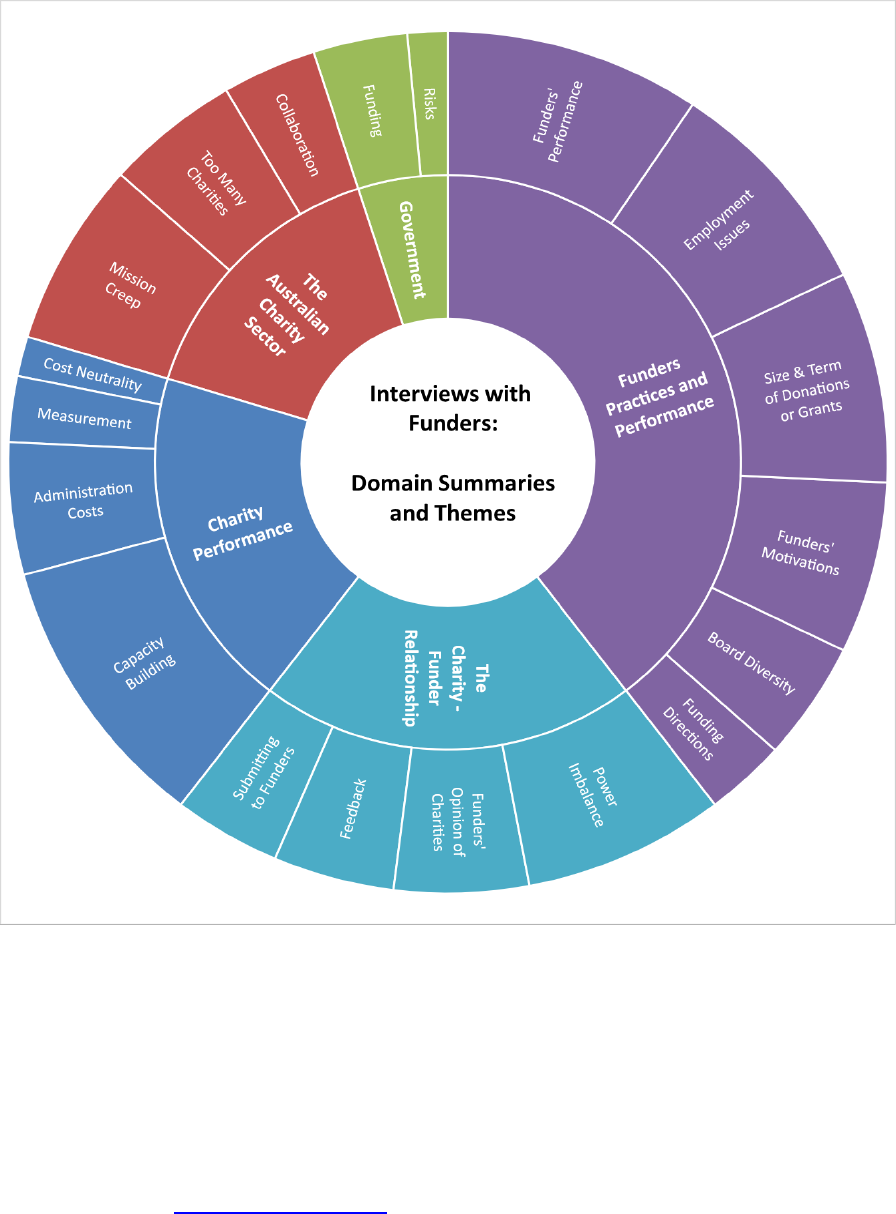
167
Chart 6.1
Domain Summaries and Themes - Funders
As presented in Chart 6.1, many themes emerged from interviews with funders regarding the
effect and consequences current funding models have on the ability of charities to have
impact. A number of themes also emerged regarding how these models can become a vehicle
for improving charity performance. As in Chapter 5, these themes do not stand alone, they are
interrelated. In addition, these emergent themes were explored at a semantic level, instead a
latent exploration was undertaken to aid in identifying underlying assumptions, experiences
and perspectives (Braun & Clarke, 2006).
168
6.2 Discovering the emergent themes
In this section, emergent themes are explored under their respective domain summaries and in
the order presented in Table 6.2.
6.2.1 The Australian charity sector
Too many charities
As stated in previous chapters, the Australian charity sector is significant in size with over
57,000 registered charities. Some funders are of the opinion that there are far too many
charities in Australia with many undertaking similar work: “…commentators raise the issue of
too many charities in Australia and this is a valid point … many are replicating services and adding
unnecessary administration costs…” (Funder 4). Indeed, one funder provided a specific
example, stating “…[Country town] in South Australia has 23 charities in a town of just over 2000
population…” (Funder 6). Additionally, “…there are many, many organisations working in the
charity sector…with an estimated 3,300 in this city alone…” (Funder 13)
This abundance of charities does not just mean the unnecessary replication of services and the
administration costs that support each one, it also drives replication across fundraising
activities with many charities competing for available funds. Several funders commented on
this: “…if you look at the vast number of charities that currently exist, you can quickly see another
problem – too many organisations, many doing similar things, all chasing the same dollar…”
(Funder 3). In addition, “…this is not helped by the volume of charities all jostling for competitive
funds…” (Funder 9). One funder went even further in their critique, observing that, “…there
are far too many charities in Australia…we don’t need 60 breast cancer charities and the costs
associated…” (Funder 11).
Funders posited the view that one contributor to the abundance of charities was their own
behaviour, stating: “…one of the reasons we have too many charities is that people donate to
them…” (Funder 11). Similarly, “…in some ways, funders are contributing to this issue, by
allocating their granting to a large number of organisations…”
granting practices were seen to be contributing to the issue: “…our usual practice is to make
relatively small monetary grants, in a range of $5000 to $30,000, to many different organisations and
programmes rather than to make fewer grants at higher levels of monetary support…” (Funder 2).
169
Collaboration
Funders identified collaboration as a solution to problem of too many charities, stating:
“…there is far too much replication across the charity sector and not enough collaboration…”
(Funder 6). Indeed, “…the sector needs to work smarter to amortise costs and increase efficiencies
through partnership and collaboration…” (Funder 9). More specifically, “…consolidation across
the charity sector is long overdue…” (Funder 2).
One funder suggested the following change:
“…if funders supported only a few charities, consolidation would occur through ‘natural
selection’…those that were most appealing to funders would secure the long-term more
significant funds available, those who didn’t would disappear with their client base then
seeking support elsewhere…” (Funder 3).
Another funder advocated the use of existing research to make more informed funding
decisions, stating,
“…if funders were more disciplined, they would do the research and only back the efficient
users of capital, similar to the for-profit world … the less efficient operators would then
merge or close…” (Funder 11).
However, funders did acknowledge there was a downside with this suggestion, stating,
“…unfortunately, much knowledge and community relevance will be lost in this process,
something that we as funders don’t like to see…” (Funder 2).
Another funder highlighted the obvious stating: “…effective collaboration requires major
investment in infrastructure and resources, and a cultural change…” (Funder 9).
Funders clearly stated their concerns regarding the number of charities across Australia and
suggested that consolidation married to more collaboration could go some way to potentially
rationalising the sector. And this could indeed lead to a fewer number of charities. But this
proposition is only likely to be successful if funders also undertake
exercise and agreed to focus their funds on a small number of charities.
Mission Creep
Funders suggested that mission creep could also be contributing to the issue of too many
charities and were critical of the practice:
“…many charities engage in deliberate ‘mission creep’ and look to design a program
that will appeal to a particular funder rather than focus on their core competences
170
…this paints a picture about both funders, who are attracted to new and shiny, and
charities who will manipulate their practices in order to secure their own future…”
(Funder 2).
There appears to be a type of un-principled game-playing that is integral to securing funding,
where the integrity of the leadership and organisational alignment to the stated mission is
questionable:
“…accepting funding when it is not your core competence is mission creep and this
happens all too often...if you can’t secure funding to pursue your mission, there is
something fundamentally wrong and maybe it is time to move on…the beneficiary of
social funding must be the community, the service provider is simply the conduit for
delivering the benefit…” (Funder 9).
For many charities, surviving into another year is the primary focus:
“…there are many charities whose primary goal is to exist next year … this causes
organisations to stray from their mission...the result being that a lot of charities follow
the money and try to adapt to a ‘sexy’ cause, when they are ill equipped to deliver in
this space … this occurs in many charities who are primarily government funded…”
(Funder 10).
Charities, with few capital reserves, find it difficult to refuse funding. One reason could be
the desire to keep their respective organisations afloat. Another could be a tactic of not
refusing funding for fear of losing out in the future. One funder suggested there were others
driving this behaviour, noting there were: “…some funders, including government, pressing
charities to accept funds and undertake activities that will have little benefit to either their
organisation or client base…” (Funder 2).
With the realities of mission creep, some funders appear to cross over the line, dictating how
a charity must use funds despite being unfamiliar with the realities of a service provider:
“…funders can also be arrogant and impose processes and set unrealistic timelines
and expectations … many insist on exactly what a grantee should be doing with their
funds without having the experience or understanding of the service provider … and
charities desperate for funding will pander to these requests…” (Funder 9).
Although the issue of mission creep was hinted at by other charity leaders, the term was used
by only one charity leader, but several funders also raised the underlying concept as an issue
and, as such, it may be more common within their sector than charity leaders believe.
171
Other funders also seemed to think the solution to the was obvious,
stating, “…I feel that more charities should be less beholden to funders and push back a bit more …”
(Funder 8).
Funders are critical of the volume of charities currently existing but will continue to support
this large number by taking a scattergun approach to funding. This is quite a quandary. So
how does this impasse get resolved?
6.2.2 Charity performance
An obvious answer to resolving the aforementioned quandary is for funders to adjust their
funding practices and seek to provide alternatives to the small, short-term model of funding
employed.
Administration costs
One funder could see the value in providing the basics:
“…funders seem to have this pervasive belief that administration costs are the devil’s
work, and they should be kept to the bare minimum … yet the majority of funders will
baulk at requests for funding back office – the very investments that will reduce
administration costs…” (Funder 7).
“…looking to the future, an ambition would be to provide more core operational and
administration support as most of the support we provide is still program or project
based…” (Funder 6).
And whilst keeping the lights on is a priority for most charities, there any other areas that
funders should consider supporting with one funder stating:
“…not enough funders provide capacity building grants … many charities are doing
great work and, if appropriate funding was available, could scale their activities …
most funders limit their support to ‘effective’ charities but are reluctant to help
charities become more effective … counterintuitive indeed…” (Funder 14).
Capacity building
Capacity building would seem to be a compelling and obvious proposition for funders, as in
building the capacity of the charities they support to have an even greater impact. Many
172
albeit the approaches varied:
“…historically, we have distributed around 50–75% of our funds towards capacity
building … moving forward it will be 100% ... when some funders decline to fund due
to a dearth of skills to deliver a program in a certain community or a lack of available
assets, we tend to see that as the obvious reason to fund…” (Funder 8).
Whilst one funder was moving towards funding nothing but capacity building, this appeared
to be exceptional, as not all funders had the same commitment: “…we also support capacity
building … around 20% of our funds are used in pursuit of this objective … more effective not-for-
profit organisations can deliver more/better outcomes…” (Funder 5). The proportion of funds
given for this purpose differed. One funder said: “…we also look at providing support with
capability and/or capacity building … although there is only about 10-15% of our funds directed
towards this goal…” (Funder 6). Another stated that, “… we will look at grant applications that
support capacity building in organisations – which is currently around 6% of our expenditure…”
(Funder 2). Finally, a third funder expressed their aspirations as follows, “…we recognise the
importance of capacity building and have increased our annual distribution over the past few years:
2015 – 5%, 2016 – 10%, 2017 – 12%...” (Funder 3).
As signalled by their participation in this research, funders contributing to this study appeared
to want societal progression. Yet even these funders did not seem fully committed to funding
reform, with most providing only a small percentage of their available funds towards
improving the capability and capacity of the charities they funded. Beyond the provision of
administration and capacity building funding support, funders claim there is another aspect of
their practice that can be improved.
Measurement
Funders suggest that more could be done to articulate the results being achieved by charities
and that improving the measurement of outcomes could help in preferencing funding to
charities that can best communicate their achievements, stating: “…charities could demonstrate
a stronger commitment to measurement … it does not need to be highly complicated more around,
what can you actually count…” (Funder 5). More explicitly, “…measurement or more specifically
the ability to articulate outcomes could be improved…” (Funder 6). Another funder stated that
measurement was critical to attracting funding: “…why will we continue to fund the organisations
173
that can provide little evidence of impact or progression…” (Funder 2). One funder stated that it
was easier said than done:
“…one challenge is assessment, as in, how do you measure the success of a program ...
can you compare a program that helps at-risk youth into the workforce against that of
a program helping females who are experiencing domestic violence … or is an early
childhood numeracy and literacy education program a more favourable proposition
than helping males with prostate cancer…” (Funder 11).
One funder did provide a rationale as to why some charities may not be that willing to expose
their performance: “…charities are unlikely to provide such feedback for fear of compromising an
income stream…” (Funder 9). Measurement can help in articulating the outcomes achieved by
a particular organisation or program but a comparison measurement across the whole charity
sector is probably out of reach at the moment.
As noted earlier, comparing the performance of charities operating across differing aspects of
society is a challenge and in many cases nonsensical. The outcomes cannot easily be
compared and the cost of attempting to define and align the benefits of such a complicated
equivalence is likely to outweigh the costs of the support in the first place. If funders have, as
one would assume, thoroughly assessed the organisations and programs they support and are
happy with the input versus output, where is the problem? The problem is that funders would
likely have to continue funding what co
adopting a longer-
would be the opportunities to announce the number and types of organisations supported.
Cost neutrality
As stated in Chapter 5, the cost neutrality theme is important to this research as it locates
where the financial effort to secure funds is equal to the fund awarded. Whilst cost neutrality
was only cited by one funder, “…despite the size of grant or donation provided…not-for-profits
will not refuse funding…this can easily lead to a grant or donation being cost neutral or even cost
negative…” (Funder 2), it signals an acknowledgement that this issue exists. Indeed, this
funder has further and introduced cost negativity, which is when the financial effort to secure
funds exceeds that of the fund awarded, a circumstance which would directly impact the
effectiveness and efficiency of the charities involved. The theme of cost neutrality will be
explored further in Chapter 7.
174
6.2.3 The charity/funder relationship
Funders’ opinion of charities
As stated in previous chapters, the Australian charity sector serves the most vulnerable and
disadvantaged in our communities, providing services and support that are complex and
diverse, yet it is held in low regard by those who fund it, with several funders making
statements such as:
“…there is an underlying opinion – which few are likely to admit - that charities and
their employees deserve less … if you work in the sector it is for the love of it, therefore
you should be happy to be paid less, have sub-standard accommodation, poor
equipment and very little organisational support…” (Funder 6).
There is also a general perception “…that sector leaders are a little bit dopey, which is highly ill-
informed but readily accepted by funders…” (Funder 9). This perception of sector leaders needs
to change:
“…the opinion of the sector needs to improve … most funders have little regard for the
capability and competence of sector leaders … this is a difficult position to understand
… it is ill-informed and demonstrates a high level of arrogance and points to a power
imbalance…” (Funder 6).
These opinions of funders are seriously concerning, seemingly having little substance.
Equally disturbing is that these poorly evidenced opinions can have an impact on the
behaviour of funders, with some funders stating: “…funders can feel they are better qualified
than the sector to make the best decisions – ‘here is what you should do’…” (Funder 9). Some
funders viewed the sector as:
“…a breed apart in that, they are doing it for the love of it ... administration can be
seen as an unnecessary overhead especially by funders whose directors have been
focussed on the ‘cost out’ models of organisational efficiencies…” (Funder 5).
Another funder highlighted the risk associated with such ill-informed opinions stating:
“…I doubt government could mobilise volunteers in the manner that the charity sector
can … this is a huge risk for governments, but they seem content in continuing to abuse
the power they hold as major funders of the sector…” (Funder 7).
The description continued,
“…I have often thought about the risk the government runs in treating charities poorly
… changes of government equate to a change in policy and a withdrawal of promised
funds, which impact many, many charities…the same can be said for ministerial
changes ... all of which contribute to the instability of the sector…” (Funder 7).
175
iew is a serious concern, raising the spectre of abusive and damaging
relationships:
“…whilst the sector has much room to improve, the way it is viewed by all types of
funders is a serious concern … Australia’s charity sector has many highly qualified,
intelligent and knowledgeable individuals who are trying to address the most
challenging problems our country faces … yet they don’t have a decent chair or up-to-
date software … why the disparity between the commercial and charity sectors … why
do we think that charities not only need less but deserve less…” (Funder 11).
It would seem that many funders are of the opinion that charities are operated by a raft of
sub-standard employees who do not require to be afforded the same working conditions as
those of their for-profit counterparts. And the fact that these employees are accepting of
lower remuneration and sub-standard facilities is of no concern to anyone as they are doing
Such a perspective could be informed by:
a) The fact that funders have no comparative data from which to assess the performance
of charities or the employees within, an issue which cannot be readily resolved easily
due to the diversity of services provided and outcomes achieved by differing charities.
b) Funders are reticent to provide funding for such luxuries as up-to-date information
technology systems or office accommodation.
c) The diluted ability to reward employees when a charity
of working capital due to the small and short-term nature of the majority of funding
provided.
The apparent low level of opinion is alarming, especially when considered in terms of
searching for ways and means to change the dynamics between funders and fundees to
deliver improvements across the charity sector. Similar to feedback received from charity
leaders, opower ies.
How do funders view th
Power imbalance
As stated in Chapter 5, a power imbalance occurs when one organisation, group or an
individual within a relationship has greater power than another. The reference to a power
imbalance in the previous section of this chapter is of concern. If a power imbalance exists
between funders and the organisations they support and it is abused in some manner, it could
176
have a serious impact on the relationships and the effectiveness and efficiency of charities.
Unfortunately, this may very well be the case, with one funder stating, “…there is a significant
power imbalance … there is no onus on funders to be effective…” (Funder 8). Another funder held
a similar view stating that:
“…there is a huge power imbalance … true altruism is rare … funders will take their cash
elsewhere if they are not appeased – despite the outcomes that a program or organisation is
delivering … I have difficulty in comprehending why this occurs…” (Funder 6).
If funders are exploiting this imbalance, why are charities not fighting back? The answer is
obvious and financially driven, with funders stating that it:
“…is highly unlikely a charity, in need of funds … would choose not to pursue a partnership
with us … or any other funder … therefore, in reality the power in all these relationships sits
firmly with the funders…” (Funder 3).
As well, the charity sector is seen as less strategic and less aggressive:
“…I have found that the sector has differing characteristics … it is far less strategic in its
thinking and much less aggressive in its negotiations ... the lack of aggression may be as a
result of the obvious power imbalance between funders and fundees, as in, charities may be a
bit frightened of biting off the hand that feeds them…” (Funder 7).
Feedback
A lack of authentic feedback from charities regarding the deficiencies of the funding
provided appears to be consolidating this power imbalance: “…without transparent
feedback on the impact of their funding practices, funders are unlikely to change…” (Funder
9). This lack of fundee to funder feedback does have a significant downside, with
funders stating that:
“…the charity sector doesn’t help as it rarely provides any negative feedback about funding –
it is never too small or too short-term … it will always make such a difference, when the
opposite is more often than not true…” (Funder 11).
The communication between funders and fundees could be much better: “…despite the size of
grant or donation provided and the associated costs of reporting on it, charities will not refuse
funding…” (Funder 2). This quote is important to this research as it hints at the shallow depth
of the working capital reserves of charities. It also signals how charities prioritise fundraising
above other objectives, in that securing income today is of paramount importance, and the
cost of securing and reporting on such income is for consideration tomorrow. Unwin (2004)

177
described the fundee/funder relationship as a complex dance in which neither party is able to
be completely frank (Unwin, 2004).
Submitting to funders
Other funders claimed that charities go further than providing agreeable and less than
authentic feedback, stating: “…the majority of not-for-profit organisations tend to appease their
funders… not-for-profits tell the funders what they think they want to hear…” (Funder 10) and “…
‘this $5000 will make such a difference’…when they know it will fill a need but not create the impact,
they [the funders] want…” (Funder 10). As one funder stated “…once you become a
philanthropist, you have told your last bad joke…” (Funder 11). This quote clearly signals the
power imbalance existing within the charity
their deferential role.
As in all affiliations, game playing and second guessing are detrimental to the relationship.
Charities undertaking this subservient behaviour do nothing but reinforce the aforementioned
power imbalance. Rather than focussing all efforts on achieving better outcomes for their
client base, charity resources are diverted into building and presenting agreeable funding
propositions. One funder had coined their own phrase for this behaviour: …the term I use for
this is ‘sophisticated begging’…as it all seems to be focussed on making the funders feel good rather
than pursuing…better community outcomes…” (Funder 2). And the same participant had seen the
results of charities taking such a subservient approach:
“…this has led to some funders…including government…pressing not-for-profit
organisations to accept funds and undertake activities that will have little benefit to either
their organisation or client base…” (Funder 2).
One funder posited that funders are complicit in this power imbalance between charities and
their funders:
“…charities can be apprehensive of honest communication … it should be acceptable
for fundees to say to their funders … this isn’t quite working the way we had hoped …
but it is not … charities are fearful of such honesty will be judged failure, rather than a
mature response … this says as much about funders, and their attitudes, as it does
fundees…” (Funder 5).
It would appear that other funders have come to the same conclusion. One funder provided an
eloquent insight as to how funders could better view their partnerships with charities:
“…this tells a story about our differences in value … we may not put the same value or

178
importance against an activity or asset that our (charity) partners would … we also need to
recognise that something that is important to us may not be to others…” (Funder 5).
This funder also provided a truly disturbing insight:
“…some funders seem to enjoy the power imbalance … it sits comfortably with their
ego centric model of philanthropy … an approach which is a lot more common than
many would want to believe…” (Funder 5)
Some funders low opinion of the charity sector, married to how they exploit the obvious
power imbalance in the relationships with the organisations they support, calls into question
their motivations. If the primary motivation of funders is not societal progression, then what
is it? The motivations of funders are explored in the next section.
6.2.4 Funders practices and performance
Funders’ motivations
Some funders suggested that self-interest was one motivation, stating: “…many are serving to
enhance their CVs or their chance of appearing on the honours list…” (Funder 11) and “…too many
pat themselves on the back for distributing the cash but have little interest in what the funds are
actually achieving…” (Funder 8). Others suggested that some corporate philanthropics
behaved in a less than altruistic manner:
“…philanthropy is all about not expecting a reward or recognition for your contribution…yet
many align their ‘philanthropic’ activities with their customer acquisition and retention
strategies…and spread their funds far too thinly…” (Funder 7).
Governments, as funders, also received some harsh criticism regarding both their motivations
and intransigence: “…government spending is influenced by the need to get re-elected…it is not
always about what will deliver the most benefit to the community…but…what will deliver the most
political benefit… (Funder 12). Additionally, “…it is interesting to note that our education
expenditure has doubled over the last couple of decades…yet our performance has regressed…why
are alarm bells not ringing in the corridors of power…” (Funder 9). Indeed, intransigence was not
limited to government, as one funder stated: “…it would be very difficult to change the
entrenched views of many funders…” (Funder 11).
Funders, many of whom are or have been effective business leaders, are likely to be informed
by their own successes. As such, they may feel they may know better than most. And if it is
179
their own money they are donating, they may feel they have a right to direct where it should
be spent and what it should achieve. Funders seem to be saying, it is my money and I will tell
you what to do with it. And as charities, rightly or wrongly, submit to the will of funders, the
behaviour is reinforced and continues. So, it is possible that funders see charities as both
weak and in need of direction. But do funders ask question about their own qualifications?
Are they equipped with the knowledge of how to best address the issues facing the most
vulnerable and disadvantaged in our societies? The performance of funders is explored in the
next section.
Funders’ performance
t appears there are many
opportunities for funders to raise their game, with several funders stating they would like to
see improved reporting from funders regarding descriptions of impact:
“…directors and trustees also have a duty of care … they are obliged to ensure that money
they distribute is spent wisely and achieves impact, impact that is describable in some way ...
there is too little reporting on effectiveness of funders … no-one challenges how you choose
to do it … it is your money and you can do what you want … funders expect fundees to be
accountable so perhaps funders need to abide by the same rule…” (Funder 5).
Other funders were critical of the less than scientific approach often taken to grant making,
stating:
“…the biggest barrier is how most funders fund … I tend to use the phrase emotional
philanthropy, where someone sees something and reacts to it without a deeper
investigation of the facts … this approach is quite common but ill-informed and
disparate with impact…” (Funder 3).
Critical and robust advice and guidance can be absent from boards of funders:
“…you have these very astute and capable businesspeople sitting as directors who
don’t always bring their business principles to the organisation … they become all
warm and fuzzy and start making emotional decisions rather than ones which are fully
objective…” (Funder 8).
This same funder criticised the time it can take to secure funds, stating: “…a lot boast about
being responsive to the needs of community … yet it can take up to a year to get a grant application
180
over the line and by then the opportunity is lost…” (Funder 8).
The issue of responsiveness was raised in Chapter 5, with several charity leaders stating that
intervention opportunities were often lost due to delays in securing funding. It is interesting
to note that funders identified the same issue. It is also interesting to note that there is no
requirement on funders, legislative or otherwise, to be effective. Funders can fund in any
fashion they wish, supporting any charity they choose. Some were concerned about how the
term of funding could easily present as indifference towards both charities and the
communities they supported:
“…if you take providing a commitment of funds for one year towards a program, it will
take the charity a month or two to recruit the appropriate staff … another couple of
months to get the program up and running … so you may get 3 to 4 months’ worth of
decent output before the aforementioned staff, and understandably so, start seeking
alternative employment opportunities … then the program stops no matter what
outcomes are being achieved…” (Funder 6).
In addition, some funders could walk away the first time a potential issue arose:
“…some well-meaning philanthropists invest in a program that they claim to be the
best thing since sliced bread – a big song and dance is made of the investment...then
things don’t go quite as well as they had hoped and they walk away after a couple of
years...beyond the impact on the organisation involved, think about what this is saying
to the community – I just don’t care about you anymore…” (Funder 8).
Funders also derided the inability and unwillingness of other funders, specifically board
members, to better understand the needs of the charity sector and modify their behaviour to
improve their impact:
“…boards could be educated more with regards to the needs of the charity sector …
our own board gets it at one level when the impact is easily understood but they can
struggle to see the link between the dollars invested and individuals / families /
communities benefitting if the outcomes are not obvious and measurable…” (Funder
5).
As well, board members could be heavily prejudiced through their own experiences:
“…if a board member is not receptive to change, grant making protocols are unlikely to change
– no matter what evidence is tabled…” (Funder 4).
181
Board diversity
Criticism of board members did not stop at entrenchment; several funders also raised the
issue of board diversity, or lack of, with one stating:
“…most funders’ board members are white, Anglo-Saxon males in their sixties or
seventies who don’t have a deep understanding of the challenges facing Australia’s
most deprived … many are serving to enhance their CVs or their chance of appearing
on the honours list…” (Funder 11).
The same funder said,
“…the boards of funders could be more diverse … we are moving towards that goal
with a 60% – 40% split male – female but all are white and well educated … board
members of most funders are male, pale and stale … we need to start targeting the next
generation of funders … we need diversity around the Foundation/Trust Board table …
diversity will bring less entrenched views and more opportunities for change … specific
training is required regarding systems change and tackling entrenched social issues …
why do we pay board members of for-profit boards, and not for not-for-profit boards …
when the role of the latter is more difficult and far more important to the future of our
country…” (Funder 11).
In the best scenario, the board should have rich and rigorous debate for the sake of others
who are more needy: s a family foundation, our board and advisers consist of two very
differing generations which leads to some quite disruptive thinking … but it sparks meaningful and
constructive discussion…” (Funder 8).
Another funder was optimistic that change would occur for the better with time with the
arrival of new funders:
“…I do have a sense this behaviour is generational…where beliefs have been set over
many decades and are difficult to change not matter what new evidence or research is
available…hopefully, as the next generation of philanthropists and funders start to
infiltrate, a more evidence based, less emotional approach will start to be taken…”
(Funder 6).
Funders are singing a similar song to charity leaders in the sense that the way funders choose
to fund is hindering progression. It would seem that there are several options open to funders
for improving their own performance including: improving reporting regarding the
182
effectiveness of funders; making more objective and less emotional funding decisions; and
becoming more fleet of foot.
Employment issues
With regard to improving charity performance, funders raised employment as an issue:
“…most charities [appear to] spend a lot of their time chasing the money and replacing people…”
(Funder 6).
In addition: the high turnover of staff is an issue…we endeavour to build relationships with
organisations but this can prove challenging when staff are being changed out every 12–18
month…CEOs included…” (Funder 3).
Why would the charity sector have such difficulty in attracting and retaining employees? One
funder provided an insight: I feel that the financial constraints the sector works under does not
lend itself to attracting the best qualified and capable employees – especially at leadership level…”
(Funder 7).
Another funder was alert to the impact of a lack of administrative or capacity building
funding, stating: “…[charities] often do not have the capability to treat their people in a rewarding
manner…as in…reasonable accommodation, training and development…this can result in high
attrition rates and less than effective organisational performance…” (Funder 13). Additionally,
people rarely pass on what they do not receive themselves…this becomes evident when staff
themselves feel they are not valued as they should be…” (Funder 13).
Increased remuneration does not necessarily lead to increased organisational performance; if
it did, the best performing organisations would always have the best paid employees.
However, the ability for a charity to offer a salary package that is competitive in relation to
the for-profit sector would be likely to be, at times, beneficial. Drawing parallels with
statements that were made by charity leaders regarding employment conditions, it is
interesting to note that funders were also raising similar issues. Yet few funders seem willing
development, accommodation or reward and recognition.
Size and term of grants or donations
As stated in Chapter 5, charity leaders claim that the majority of funding received is mostly
small and short-term. This is a view that is also shared by some funders:
183
“…our usual practice is to make relatively small monetary grants…in a range of $5000 to
$30,000…to many different organisations and programmes rather than to make fewer grants
at higher levels of monetary support…” (Funder 2) and “…the grants we provide are small
and allocated to many different organisations…” (Funder 4).
With regard to the term of funding provided:
“…we limit our granting to a period of 12 months…recipients will use best endeavours to
complete the programme/project within 12 months from the date of receipt of the grant…”
(Funder 2) and
“…funders are less than knowledgeable about the sector and how to achieve the best
outcomes…hence the short-term funding model employed by many…” (Funder 14).
Not only do funders continue to fund the large number of existing charities, but they are
also prepared to fund new ones despite little evidence of impact. Many funders are
rightly critical of this practice:
“…here is a great idea…let’s invest in another executive team, another administration team,
another operational team, office accommodation and an IT system, which will allow us to do
the exact same as many, many others, but probably not as efficiently or effectively…”
(Funder 11).
Each charity established must have funds to operate and those funds must be sourced from
somewhere. And that somewhere is the same pool of funds that all other charities use.
Funding directions
Beyond persisting with a model of funding that does little to improve the effectiveness and
efficiency of charities, funders appear to feel better qualified than the charities they are
supporting to decide how their funds should be used:
“…unfortunately, it is a common and arrogant practise for funders to dictate what not-for-
profits/charities should do with the funds provided…despite not being best qualified to do
so…” (Funder 14).
“…many insist on exactly what a grantee should be doing with their funds without having the
experience or understanding of the service provider…” (Funder 9).

184
In defence of funders, it is not unreasonable to expect that they would have some say in how
their funding should be used, but to try and dictate to an experienced and reputable charity
what is the best way forward regarding supporting its client base is possibly a step too far.
6.2.5 Government
Funding
was much like the feedback from charity leaders; both were
critical of government funding, with one funder stating:
“…government funding is risky and influenced by political cycles … both state and
federal governments are major funders of the charity sector … but political cycles are
a destructive force across the sector … a change of government normally equates to a
completely different direction and focus … hence many programs are stopped mid-
cycle despite the outcomes they are delivering … the same can be said for a change of
Minister, where the new appointee needs to be seen to be doing something and the
same occurs…” (Funder 6).
An objective of every political party is to get elected or re-elected. Focussing on this
objective too often may lead to a decline in servicing the needs of the community:
“…a single $10m project provides only one media opportunity, compared to ten $1m
projects which provide many more times the coverage…” (Funder 12).
-
elected and the strategy employed is to look for ways to embellish their achievements,
however minor they may be. As funders have previously stated, this is a risky proposition for
charities that could have their funding withdrawn no matter what fabulous outcomes are
being achieved. As noted in Chapter 5, charity leaders were highly critical of the partisan
nature of government contracts and raised the issue of the significant risks associated both
with accepting and rejecting a government contract. One funder supported this proposition
stating:
“…change of governments and / or ministers can cause issues for the charity sector …
the incoming need to be seen to be doing something, and this can include cancelling or
restructuring existing government programs that no longer align with the new strategy
… there is a power imbalance, whereby those impacted by the cuts may not want to be
seen as being critical of the Government for fear of any criticism impacting their future
185
funding…” (Funder 12).
Funders are as equally concerned by the behaviour of government as their charity
counterparts because government seems to be prioritising its own longevity over the needs of
the community despite the information to hand. One funder (quoted here again) provided the
rationale as to why this occurs:
“…governments rely on numbers to tell a positive story … we are investing $xx million
more in health or education … it is interesting to note that our education expenditure
has doubled over the last couple of decades yet our performance has regressed … yet
we keep doing the same over and over again…why are alarm bells not ringing in the
corridors of power…” (Funder 9).
Government funding and the motivations that drive it was explored in Chapter 2. The misuse
of the Community Sport Infrastructure Grants and the Regional Cultural Fund, both
happening in 2018, also provides recent evidence that government is motivated by self-
interest. -serving behaviour
continues and the electorates continue to do nothing about it.
funding motivations on the communities that charities support is not obvious. It would be
difficult for the general public to fully understand the not-for-profit sector and the charities
within. As referenced earlier in this chapter, should financial support be provided to families
of children impacted by cancer or should the focus be on funding more research into finding a
cure for the disease? Or does protecting the environment take precedence over protecting
women from domestic violence?
These are complex questions that require significant investment in time and effort to reach a
conclusion, if indeed any conclusion can be reached. It is therefore an unrealistic expectation
that the general public would have an informed view on the activities and impact of charities.
However, when it comes to funders, specifically government with vast resources at hand, it is
a much more reasonable expectation that they should have the ways and means to help
society progress. Can societal progression be triumphed by populist politics? There must be
some risks associated with how poorly governments treat charities. Several funders agreed,
:
“…you are unlikely to hear the charity sector … being critical of government … and
what would happen if they stood up for themselves and walked away from government

186
contracts … the government would then have to deliver these services themselves…I
doubt government could mobilise volunteers in the manner that charities can … this
is a huge risk for governments but they seem content in continuing to abuse the power
they hold as major funders of the charity sector…” (Funder 7).
Risks
As stated above, the risk to government of a form of rebellion by the charity sector would
leave both federal and state governments in a position of significant compromise due to the
fact that they would have to deliver the services currently undertaken by charities, and which
are, as noted earlier, both significant and complex. But is there a change coming or will
governments continue to act as before? One funder could sense a change, stating: “…there is
evidence that traditional political strategies are wearing thin, hence the rise of One Nation and the
independents in Australia … Donald Trump’s election in the US … and Brexit in the UK…” (Funder
6).
And there does seem to be recent evidence that the charity sector has teeth and is willing to
use them. As noted in Chapter 1, the Australian Charities and Not-for-profit Commission
(ACNC) was established in late 2013 under the Rudd/Gillard governments with the following
objectives:
• Enhance, maintain and protect the public trust and confidence in the not-for-profit
sector through improved accountability and transparency.
• Support and maintain an independent, innovative and robust not-for-profit sector.
• Promote the reduction of superfluous regulatory obligations on the not-for-profit
sector.
Prior to 2013, once a charity was endorsed by the Australian Tax Office, they had no
reporting obligations or requirement to contact any government department again. Along
with the introduction of the Charities Act 2013, which established the first statutory
governance within the sector.
Under the Abbott government, Minister for Social Services Kevin Andrews looked to
unwind the ACNC in 2014 and replace it with the Civil Society National Centre for
Excellence (NCE). However, as was argued successfully by many in the not-for-profit

187
sector, the NCE would not be a replacement for the ACNC as it had no regulatory
functions (Department of Social Services, 2014)
Social Services lasted from 18
th
September 2013 to the 23
rd
December 2014 (Federal
Government, 2018). One must ask as why the Abbott government wanted to wind back the
regulatory and reporting obligations of the charity and not-for-profit sectors? One might
assume it was a ploy to keep the sector opaque, for reasons unknown.
Beyond dark side, one funder provided some light at the end of the charity
tunnel: “…on the flip side, some aspects of government do show promise, an example being the
social enterprise agenda being currently pushed by the Victorian government…” (Funder 6).
Much like the previous feedback from charity leaders, feedback from funders was extremely
educational performance is going backwards despite increasing expenditure (Gurria, 2018),
egard to employment, health and education are
making little progress (Department of the Prime Minister and Cabinet, 2020).
188
6.3 Conclusion
The funders who participated in this research acknowledged the need for change in the
policies and practices of funders. Despite the rhetoric of progression, the findings of this
research show that their behaviours undermine this rhetoric and mirror those of the majority
of their peers, which work to support a continuation of the status quo.
present, not be clouded by power but motivated by service to the community. Power is
obvious and constant in the charity/fundee relationship and sits firmly under the control of the
funder. Funders are under no obligations, regulatory or otherwise, to demonstrate their
effectiveness or impact. Indeed, the vast majority of funders would not want to try to validate
their worth to society because they would be unable to do so. The absence of reporting
obligations gives licence to funders to fund in any manner they deem appropriate, with most
allocating their funds in a purely tactical fashion. There appears to be little appetite from
funders to support more strategic opportunities.
In addition to the description above, the charity sector is also contributing to the
aforementioned status quo, and more particularly to the proliferation of organisations and
mission creep. Funders are critical of the large number of Australian charities. The volume
and the diversity of activities undertaken demonstrate the difficulties funders can experience
in choosing which charity to support, especially when so many have great competency in
providing a compelling proposition, no doubt developed through the ongoing repetitive
practice of submitting grant applications. This could be a contributing factor to the scattergun
approach to funding that many funders take.
Funders also stated their concerns regarding lack of consolidation and
collaboration, some having suggested that this type of activity could go some way to
rationalising the sector. This suggestion could provide one solution to improving the sector
effectiveness and efficiency, but to undertake consolidation and merge organisations does
take investment, as do collaborative activities. As funders have demonstrated, the majority
are not keen on supporting organisational capacity building costs, so it is also unlikely there
would be an appetite for funding this type of activity.
189
s and agree with each other to
collaborate and focus their funds on a smaller number of organisations. But which funders
would actively collaborate, and which charities would be selected? These are not easy
questions to answer as most funders are likely to have differing perspectives and differing
decision-making protocols.
With regard to mission creep, it is understandable that charity leaders undertake this type of
behaviour in order to secure the future of their respective organisations, themselves and the
employees within. Whilst funders were keen and correct to criticise the sectors for this
practice, in their own way they were the catalysts for this type of behaviour. Small, short-
term funding provides little stability for charities and the employees within. In reality, it
creates a high level of instability which can only lead to survivalist-type behaviour and, as a
consequence, mission creep occurs.
It is a complex scenario. Charities work hard to appease their funders and keep them engaged
and, if they continue to do so, there is small likelihood of positive change. However, funders
are not without blame. There is no assessment of the effectiveness of funders and there is
little appetite to have it. Feedback from both funders and charity leaders suggested that if
funders were required to report on the effectiveness of their funding this may improve the
impact of the funds provided, but what would this effectiveness report look like?
Individually, each of us may be able to assess certain grants or motivations of funders and
ascertain success but collectively, across all types of funders and the grants allocated, this is
close to impossible to achieve. As demonstrated by their participation in and financial
contribution to individuals, families and the wider community, it is clearly apparent that
funders must want better outcomes for society. However, and at the same time, it is
concerning to note the low regard in which funders hold the charity sector.
Are we so narrow in our opinions about charity employees? Could it be that, unless you have
managed a multinational or made a fortune on the stock exchange you present with little
value to most funders? This is a concerning finding and one which could block all attempts to
improve the practices of funders to progress the performance of the charity sector. But should
we first try to understand why some funders have this opinion?
190
Funders, many of whom are or have been effective business leaders, are likely to be informed
by their own successes. As such, they may feel they may know better than most. And, if it is
their own money they are donating, they may feel they have a right to direct where it should
be spent and what it should achieve. Funders seem to be saying, it is my money and I will tell
you what to do with it.
And with charities, rightly or wrongly, pandering to the wishes of funders, the behaviour is
reinforced and continues. So, it is possible that funders see charities as both weak and in need
of direction, but do funders ask similar questions about their own qualifications? Are they
equipped with the knowledge of how best to address the issues facing the most vulnerable
and disadvantaged in our societies? The answer to that question has become clearer.
In the many scenarios explored in this chapter, it would seem evident that, due to the
dependence charities have on funders and the dynamics within the charity/fundee
relationship, only funders have the ability to progress the organisational effectiveness and
efficiency of charities.
191
Chapter 7 Discussion
7.1 Introduction
Summary of findings
This research has found that the organisational effectiveness and efficiency of charities is
being significantly and negatively compromised by how they are funded. This is primarily
due to the fractured charity/funder relationship, where a power imbalance is currently in
play, and where funders are the dominant party. This power imbalance presents, most
frequently, in how funding is sourced, awarded, and then controlled. The mechanisms for
securing funding are onerous, contradictory and require a copious amount of charity
resources, which lessens, and not inconsiderably, the value of the funds awarded. Of the
funds awarded, funders look to maintain some form of control over it, often dictating where
and when it should be used and refusing requests for capacity building type funding that
would afford charities the opportunity to become both more effective and efficient.
The current charity/funder relationship is peppered with taken-for-granted assumptions held
by funders, who also demonstrate a serious lack of understanding of the everyday realities of
being a charity or a charity employee. As evidenced from this research, every day, many
thousands of charity employees persist in
disadvantaged whilst having limited, if not archaic, administrative networks, sub-standard
facilities, and the challenge of locating the necessary and substantial resources for the
continuous identification, construction, and submission of new funding applications. This
tragic scenario does not bode well for the well-being and welfare of charity employees who
might also see themselves as facing hopeless and uncertain futures.

192
7.2 Comparing the emergent themes
The purpose of this research was to investigate whether the organisational effectiveness and
efficiency of charities is being impacted by the manner in which they are funded. This chapter
compares the research findings presented in the previous three chapters from two
perspectives. Those perspectives are, first, that of phenomenology, or the phenomenon of
funder relationship; and second, that of Resource Dependency Theory
(RDT) which posits that organisations will transact with each other in order to acquire the
resources critical to a continuing operation (Drees & Heugens, 2013; Pfeffer & Salancik,
2003).
Acquiring the required resources, at the right time, is vital to the effective operation of any
type of organisation. Challenges may present during the acquisition process because the
resources required may be in short supply, not easily secured or be controlled by
uncooperative others (Ebers & Semrau, 2015; Pfeffer & Salancik, 2003). For example,
Organisation A can become reliant on Organisation B if Organisation B holds all reserves of
a critical resource. This can result in the interactions becoming unbalanced or asymmetrical
and can cause an imbalance in authority or power (Chen, 2018; Pfeffer & Salancik, 2003). In
this study, RDT was used to explore the relationship between charities and those
organisations which hold the critical resource they require, the funders.
Many themes emerged from the interviews with charity leaders
15
and the interviews with
funders
16
. This section discusses the emergent themes relating to the research questions. This
discussion of themes will be undertaken at the latent level, which Braun & Clarke (2006)
described as being “…beyond the semantic content of the data, and starts to identify or examine the
underlying ideas, assumptions, and conceptualizations – and ideologies – that are theorized as
shaping or informing the semantic content of the data…” (Braun & Clarke, 2006, p. 84). A deeper
exploration of these themes was undertaken because “…the purpose was to find … [emergent]
themes in a whole sense [across stories] rather than themes relating to each participant…” (Giles,
2008, p. 92). When emergent themes are explored more deeply, enduring and powerful
15
See Chapter 5, Section 5.1, Table 5.1, for a full list of themes emerging from Interviews with Charity Leaders.
16
See Chapter 6, Section 6.1, Table 6.1, for a full list of themes emerging from Interviews with Funders.

193
themes can arise. These enduring or powerful themes can address the question, what is
about the inter-relationships in this research? (Giles, 2008)
The charity sector
Before proceeding with the in-depth discussion of themes, it is important to briefly restate the
size, scope and reach of the sector, a
Worldwide, charities have made an enormous contribution to the well-being and life chances
of millions of people over many centuries. To do their good works, charities have relied on
funding provided by the general public through donations, philanthropists and others,
including government. Closer to home, charities in Australia today touch the lives of many
individuals, families and communities and range from very high-profile charities like The
Smith Family and the Salvation Army to very targeted charities which have started often as a
result of a particularly tragic event or an especially worthy achievement. The Amy Gillet
Foundation, set up to commemorate the life of a champion cyclist tragically cut down in
France in the prime of her life, combines elements of both motivations (Amy Gillet
Foundation, 2021). There are also organisations which perhaps most Australians would not
see as being a charity, such as Surf Life Saving Australia and the Royal Flying Doctors
Service.
To do what they do, charities of all sizes and complexities need resources, principally of the
most fundamental kind which is money. Through the financial year 2017/2018, the total
income of Australian charities was $155.4 billion, which represented about 4% of the
(Australian Charities and Not-for-Profit Commission, 2020e). Whilst this
income was very large and covered over 57,000 charities, much of those funds end up with
the larger, higher profile charities, with the 50 largest charities accounting for over a third of
entire revenue (Australian Charities and Not-for-Profit Commission, 2020e). The
remainder went to many thousands of smaller, lesser-known charities, mostly on the basis of
an annual competitive bidding process. That consumed
and still consumes large amounts of time and energy, with no guarantees whatsoever of being
successful and thereby keeping the doors of each charity open in order to serve the needy.

194
The charity/funder relationship
have revealed understandings that we
typically take for granted (van Manen, 2015). Amongst these understandings is the
centrality, complexity and significance of the s between charities and
funders.
(Giles, 2008). Ihas been considered from
two perspectives:
1. -nd;
2. the theoretical implications of the data considered from an RDT perspective.
Phenomenological inquiry always presents more questions than answers (Neubauer, Witkop,
& Varpio, 2019). In the case of the relationship between charities and funders, the following
questions were especially pertinent to this study as they were of primary importance when
interrogating and path to improvement:
W
W
It has been generally taken for granted that the relationship between charities and their
funders is productive in pursuing a common goal, that of societal progression. This study has
found that the relationship between charities and their funders is fractured, as it produces
significantly less than its potential and compromises the ability of both charities and funders
to pursue their missions. Due to the manner in which the majority of funding is awarded, this
relationship is also transitory. As a result, charities and funders both relinquish the
opportunity to build deeper, more enduring relationships; relationships that could provide
benefits beyond the funding awarded, such as knowledge, differing perspectives and new
ideas.
This fractured and transitory relationship in turn negatively impacts the effectiveness and
efficiency of charities, mostly through the following practices:
• The manner in which funding is awarded
• Control over the funding awarded
• The treatment of charity employees.
These practices are explored later in this chapter in sections 7.2.1, 7.2.2 and 7.2.3.

195
An uncertain relational context of inquiry
In these uncertain times,
within and between the charity/funder , which
Unwin (2004) described as a “…complex dance in which the agenda of those wishing to make
grants is reconciled with the agenda of those applying for them…” (Unwin, 2004, p. 2). This
game-playing between charities and funders commences early in the relationship
and is essentially initiated and perpetuated by the power imbalance that exists between
charities and their funders.
Power imbalance
With few exceptions, charities are very much in a dependency relationship with funders. This
dependency presents as a power imbalance, with funders the dominant partner. In order for
one organisation to have power over another organisation, the exchange relationship must be
asymmetrical (Davis & Cobb, 2010; Pfeffer & Salancik, 2003). In that situation, the
exchange of resources is more important to one of the organisations involved: “…without
asymmetry…neither organisation will possess a particular power advantage…” (Pfeffer &
Salancik, 2003, p. 53). If a funder was eager to partner with a certain charity, that charity
would hold the power and be able to influence what funds should be provided and how these
funds should be used. Unfortunately for charities, this is generally not the case. Funders, due
to the resources they hold, can assert their power over charities (J. Choi, 2017; Pfeffer &
Salancik, 2003). This power imbalance is pervasive throughout the charity/funder
relationship and influences most aspects of funding, many not for the better.
7.2.1 The environment in which funding is awarded
Charities, like most organisations, are dependent on the resources they acquire for survival
(Ebers & Semrau, 2015; Pfeffer & Salancik, 2003). Pfeffer & Salancik (2003) defined
dependency as “…the product of the importance of an input [resource] by a given organisation and
to the extent that is controlled by relatively few organisations…” (Pfeffer & Salancik, 2003, p. 52).
This dependency is grounded in the fact that charities are restricted in where they can source
funding. Access to traditional capital markets is limited for charities as these funding sources
typically require a return for their investors (Gary, 2017; Tarczynski & Nermend, 2019). As
charities, in general, serve those who are not in a position to pay for the goods and services
afforded to them, a return on an initial investment is unlikely. Some charities may have

196
commercial enterprises which generate a revenue, such as the Australian Red Cross
(Australian Red Cross, 2021) or the Salvation Army (The Salvation Army, 2021). Others may
seek donations direct from the general public, which by the nature of collection are likely to
be of a small dollar value, but in general charities rely on funders for the majority of their
income rather than a commercial entity.
Pfeffer and Salancik (2003) also stated that “…the fact that a resource is important to the
organisation’s function, in itself, is not the source of the organisation’s problems…” (Pfeffer &
Salancik, 2003, p. 47); problems arise due to the environment in which these resources are
acquired (Davis & Cobb, 2010; Pfeffer & Salancik, 2003). And herein lies the problem. The
several years from $100 billion through FY 2012/2013 (Australian Charities and Not-for-
Profit Commission, 2014) to $155.4 billion FY 2017/2018 (Australian Charities and Not-for-
Profit Commission, 2020e). Whilst one may argue that charity funding has increased in line
with demand, the funding increase available is not the issue to hand; rather, it is the
environment in which the funding is awarded, in particular the relational dynamics between
charities and funders that are critical to improving the organisational effectiveness and
efficiency of charities.
Size and term of donations and grants
As stated in Chapter 4, Tranche 1 of this research confirmed that the size of donations and
grants on offer to Australian charities is generally small. These findings were supported by
findings from Tranche 2 of this research with charity leaders stating: “…current funding
available from most organisations is very tactical…the grants are mostly small…” (Charity Leader
3) and “…the current focus from funders on providing many small grants to many organisations
causes significant inefficiencies…” (Charity Leader 7). Findings from Tranche 3 of this research
also supported these findings with funders stating: “…the grants we provide are small and
allocated to many different organisations…” (Funder 4) and “…our usual practice is to make
relatively small monetary grants in a range of $5000 to $30,000…” (Funder 2).
With regard to the term of donations and grants on offer to Australian charities, Tranche 1 of
this research found that the majority were short-term. These findings were supported from
Tranche 2 of this research with charity leaders stating: “…current funding available from most
funders is small and short-term…” (Charity Leader 4) and “…the inability to secure substantial
long-term financial support results in tactical, unstable organisations…” (Charity Leader 9).

197
Findings from Tranche 3 of this research also provided support, with funders stating: “…the
short-term approach by most funders is hindering progress” (Funder 8) and “the current short-term
funding available has led to many not-for-profit organisations compromising themselves…” (Funder
5).
Resource requirements
As a result of the current small, short-term model of funding on offer, charities must invest
significantly into identifying opportunities for funding and applying for them. It is a relatively
self-evident proposition that when a charity has to secure funding from many, many differing
sources rather than just a few, additional organisational resources will be required. But what
does additional organisational resources actually mean? This section will quantify this
question and demonstrate how the current model of funding is essentially ravaging charity
resources on an enormous scale.
As displayed previously in Table 4.3
17
, 35.9% of donations and grants awarded to Australian
charities were for $10,000 or less. Through the FY 2017/2018, the Australian Charities and
Not-for-profit Commission (ACNC) reported that the charity sector had an income of $155.4
billion (Australian Charities and Not-for-Profit Commission, 2020e). This equates to charities
receiving approximately $55.8 billion of income in donations or grants of $10,000 or less.
Using a very conservative assumption that all of the monies awarded in this range were for
$10,000, this would equate to 5,578,860 donations and grants being awarded at a rate of
around 107,000 per week. If a charity, in seeking funding, used 4 hours of its time to identify
an opportunity, then submit an application, this would equate to 22,315,440 hours used by all
charities through FY2017/2018 in securing funding through donations or grants of $10,000 or
less. Assuming a 100% application success rate, aligning the aforementioned 22,315,440
hours to a working week equates to 557,886 weeks at 40 hours per week or 12,128 years
using a 46-week
18
working year, which equates to over 12,000 charity employees being
assigned to fundraising activities through FY2017/2018 but that is only for the component of
donations or grants which were for $10,000 or less. Should the assumptions used in the
previous paragraphs become less conservative, in that the award amount was the mid-point of
17
See Chapter 4, page 119 for Table 4.3.
18
Annual leave allowance in Australia is 4 weeks. Plus 2 weeks-worth of public holidays.

198
the $0 - $10,000 range at $5,000, more than 24,000 charity employees would be assigned to
fundraising activities annually, which again would double to 48,000 charity employees if the
success rate of was dropped to 50% rather than 100% previously used. This 48,000-employee
estimate is still on the conservative side, as it assumes that all employees are fully utilized at
all times and does not
or various types of leave.
Again, referring to Table 4.3
19
and using the same calculations as previously stated, for
donations or grants in the $10,001 to $25,000 range, assuming each awarded was for
$25,000, then 919,968 donations or grants were awarded. If the same 4 hours of time was
used to identify an opportunity and then submit an application, this would equate to
3,679,872 hours, 91,998 weeks or 2,000 employees. Moving the award amount to the mid-
point of $17,500 and assuming a success rate of 50%, increases the employee number to
5,714. As the size of the donation or grant increases the employee resource required to secure
these larger amounts is significantly less. Through FY 2017/2018, using similar calculations
and extrapolations as previously, 54,225 (48,512 + 5,714) charity employees were utilised to
secure the abovementioned 50.7% of charity income
20
, whilst just 4,258 charity employees
secured the remainder. If funders halved the contribution of donations and grants awarded
from the $0$10,000 range from 35.9% to 17.95% (or $55.8 billion to $27.9 billion) and
awarded these monies within the higher $10,001 to $25,000 range, a reduction of 16,360
charity employees assigned to fundraising activities would be achieved annually
21
.
Additionally, if the smallest donation or grant award was limited to $10,000, the number of
charity employees assigned to fundraising activities on an annual basis would reduce from
58,484 to 23,832
22
.
From a charity perspective, organisational effectiveness can be defined as how well a
charity achieves its purpose (Pfeffer & Salancik, 2003). Such as, how many
undernourished children have been provided breakfast prior to attending school or how
much ? If a charity has to
allocate employee resources to fundraising activities instead of service delivery, that
19
See Chapter 4, page 119 for Table 4.3.
20
Assuming the Award Amount at the mid-point of each donation/grant range and a 50% success rate.
21
Assuming the Award Amount at the mid-point of each donation/grant range and a 50% success rate.
22
Assuming the Award Amount at the mid-point of each donation/grant range and a 50% success rate.

199
charity becomes less effective, as less children will receive breakfast and less plastic
will be collected. Organisational efficiency can be defined as the ratio of resources used
to the output produced (Pfeffer & Salancik, 2003). When charities have to secure
funding from many differing sources rather than just a few, additional organisational
resources will be required. As a result, charities become less efficient. This efficiency is
challenged further as fundraising continues year in, year out. There is no interruption.
Larger, longer-term funding would improve the effectiveness and efficiency of
charities. Ans
one charity leader stated, “…raising pooled funding [small grants from a variety of funders]
is hard work…emotionally exhausting and if total funds for the program are not raised,
returning funds is heart wrenching for the staff member…” (Charity Leader 6). That is a
strong statement and one that helps demonstrates being
charity/funder relationship. These are not jobs for the faint hearted.
Grant application processes
Beyond the significant organisational resource required in administering the volume of grant
applications submitted, charity leaders are critical of many aspects of the grant application
process itself, which fluctuates considerably from funder to funder. Many processes are
highly subjective and cause great confusion, with one charity leader describing these
processes as follows: “…most grant application/selection processes are highly subjective…”
(Charity Leader 10),
Another leader stated,
“…selection criteria vary month-to-month and year-to-year within the same funding
organisations … you will submit a grant application one year, which will be successful,
submit a very similar application the following year and fail or vice versa…” (Charity
Leader 8).
This subjectivity is not just limited to charities applying for grants, as evidenced by the
following quotation:
“…some funders encourage you to keep applying again and again, suggesting that the
reward is for effort and persistence not the content or validity of your application…”
(Charity Leader 8).
In making such a suggestion, funders appear to be confirming that they themselves are
unaware of the selection criteria are used. It is a challenge to understand why significant

200
funds would be granted in such a fashion. Even more difficult to grasp is why funders appear
to happily reveal the inconsistencies in their approach.
Confusion and frustration driven by the subjective and inconsistent nature of grant
applications processes is further bolstered by a lack of feedback. Charity leaders identify this
absence as influencing their judgment regarding grant applications, stating:
“…feedback from … grant applications are more than often not forthcoming … it is
then difficult to know what needs adjusting in order to have success in a future grant
application…” (Charity Leader 3)
and
“...feedback from funders…is pretty much non-existent… there is no evidence on which
to help improve the quality and success rate of grant applications…” (Charity Leader
7).
Comprehensive and timely feedback from funders about why a grant application has been
successful or not would afford charities the opportunity to inform future grant-seeking
decisions. Without this feedback, the prospect of improving current grant seeking practices
and protocols is denied and uncertainty prevails. Pfeffer and Salancik (2003) defined
uncertainty as “…the degree to which future circumstances cannot be anticipated or accurately
predicted…” (Pfeffer & Salancik, 2003, p. 67) and stated that uncertainty can become
problematic in that it can drive questionable organisation behaviours (Ebers & Semrau, 2015;
Pfeffer & Salancik, 2003). Current grant application processes can be described as both
uncertain and problematic and may be the impetus for charities taking a scattergun approach
to securing funding; they scatter applications for funding across many funders in the hope
that some will be successful. Some charity leaders claim that this uncertainty also contributes
to a high turnover of staff stating: “…current funding models are driving inefficiencies…and
unstable organisations…employee churn rate is high as a result…” (Charity Leader 9) and “…high
employee churn rates are driven by the uncertainty of funding… (Charity Leader 7). Another
Charity Leader painted an even bleaker picture, stating: “…employee turnover is even higher in
fundraising roles...this uncertainty takes its emotional toll…” (Charity Leader 2). A relatively
obvious and significant cost is that of having to regularly replace employees when
recruitment, training and lost productivity are all taken into account.
Unsuccessful grant applications
Another consideration of impact is that of the employee resource associated with

201
unsuccessful grant applications. As one charity leader stated “…applying for grants take a lot of
time…you have a success rate of around 10%...” (Charity Leader 5). If this success rate were
common across the charity sector, the picture painted of unproductive employee resource
earlier in this chapter could be significantly worse. Again, one must give consideration to
charity employees operating in this environment. If funding applications are more often than
not unsuccessful, motivation must be impacted. The impact of this situation was captured in
the following: “…it becomes easier to think you are not good at your job… you can quickly become
emotionally tired of pitching…hope gets diluted…” (Charity Leader 5). That is another strong
statement and one that captures
The silent and the silenced
Much like the awarding of small, short-term donations and grants, funders are allowed to
persist with highly subjective grant application processes due to the power imbalance in the
charity/funder relationship. Through these processes, the relationship between charities and
or
willing to accurately articulate why an application has been successful or not, remain silent.
Charities are silenced by a fear of antagonising funders with criticism of existing processes,
despite the significant impact on charity employees. As such, the status quo remains. Pfeffer
& Salancik (2003) would describe the relationship between charities and finders as being
constrained, stating: “…actions can be said to be constrained whenever a response to a given is
more probable than any other response…” (Pfeffer & Salancik, 2003, p. 14). In this instance,
no response from either party is the more probable response and suggests that charities have
to develop the ability for highly nuanced behaviour within the charity/funder relationship.
Cost neutrality
Silence from both charities and funders is also evident regarding the critical issue of cost
neutrality, which can be defined as when the financial effort expended equals that of the
financial resources secured (T. Martin, 2018; Meizlish & Lovell, 1997). With regard to this
study, cost neutrality occurs when the cost of applying for a grant and reporting on it equals
that of the sum granted. Charity leaders stated that the cost neutrality point of grants awarded
within Australia is is around $10,000… (Charity Leader 9) and is around the $10,000
mark… (Charity Leader 7). It is of significant concern that a grant of $10,000 is deemed to
be cost neutral and therefore inert. As stated earlier in Section 1.7, Australian charities had an
income of $155.4 billion through Financial Year 2017/18 (Australian Charities and Not-for-

202
Profit Commission, 2020e). In addition, as stated earlier in this section, 35.9% of all grants
and donations awarded to Australian Charities are for $10,000 or less. This equates to $55.8
billion worth of funds being cost neutral, which could be seen as a ridiculous amount of
money from which no benefit is derived. The aforementioned quotations from charity leaders
could be viewed as dormant information, in that cost neutrality is acknowledged as an issue
but this information is not acted upon. Instead, it lies dormant and has no impact, much like
the funds associated with cost neutrality. Equally ridiculous is that any funding award
provided for less than $10,000 is actually leaving the charity applicant financially worse off.
7.2.2 Control over the resources awarded
Charities, due to their financial vulnerability, are generally more eager to partner with funders
in order to secure the critical resource of funding. As a result, funders are afforded discretion
over the allocation of the resources they hold by the charities they fund. Pfeffer and Salancik
(2003) stated that a “…determinant of control is the extent of discretion granted regarding
allocation and use of the resource…” (Pfeffer & Salancik, 2003, p. 47). Additionally, some
funders demand more control over the funding provided. This level of control afforded to
funders by charities can vary and is often determined by the scale of the funding provided
(Nienhuser, 2008b; Pfeffer & Salancik, 2003), in that the funds granted contribute
significantly towards total annual income. Funders that provide significant funds
are more likely to be afforded greater control over these funds than funders who provide
lesser amounts.
The criticality of the funding provided is another determinant of control (Pfeffer & Salancik,
2003; Sacristán López de los Mozos, Rodríguez Duarte, & Rodríguez Ruiz, 2016), in that a
ability to function is compromised due to the absence of funding. As a result,
funders who provide significant funding or funding when it is most needed will be afforded a
higher level of control over those funds. Affording funders discretion over how their funds
are allocated is another example of how the power imbalance presents in the charity/funder
relationship. One could expect that when a donation or grant of significant value is awarded
that the funder will have some input as to how it is used. However, the need by funders to
have some form of control over the funds awarded extends well beyond that of large
donations and grants, as funders state:

203
“…unfortunately, it is a common and arrogant practice for funders to dictate what charities
should do with the funds provided…despite not being best qualified to do so…” (Funder 14)
and any insist on exactly what a grantee should be doing with their funds without
having the experience or understanding of the service provider…” (Funder 9).
Controlling the funds awarded is a demonstration of the power funders hold over charities.
Another less obvious demonstration is refusing to fund activities critical to the effective and
efficient operation of charities.
Administration costs
The administration costs of a charity can be defined as all the expenses not related to service
delivery and they therefore do not directly contribute to creating impact (Burkart,
Wakolbinger, & Toyasaki, 2018). They are used by some in an attempt to provide an
harity evaluator, uses
administration costs as one of their performance metrics and states that “…lower is better…”
(Charity Navigator, 2021, p. 1), as does Charity Watch, another charity evaluator, that affords
an efficiency rating of A+ only to charities that have administration costs of 10% or less
(Charity Watch, 2021). Administration costs as a ratio of total expenditure can be used as an
measure of organisational effectiveness and efficiency, as it supposedly affords funders
confidence that their funds are going to service delivery and therefore maximising impact
(Frumkin & Kim, 2001; Gregory & Howard, 2009). In theory, this ratio can be used by
funders to compare administration expenditure across charities, in an attempt to identify those
making the most efficient use of the funds provided. Charity leaders and funders were both
critical of this approach stating that funders are not receptive to grant applications that support
administration costs…” (Charity Leader 5) and funders see: “…administration…as an
unnecessary overhead…” (Funder 5). Further more needs to be done about the educating of
funders regarding administration costs…” (Charity Leader 2). Gregory & Howard (2009) state
that charities can “…feel pressure to conform to funders’ unrealistic expectations…” (Gregory &
Howard, 2009, p. 1) regarding administration costs. Other funders supported the premise that
these costs are not just a necessary expenditure but a crucial one, stating: how can a charity
operate if the lights are off…” (Funder 7) and “…these are real and critical costs…” (Funder 6).
With reference to Resource Dependency Theory (RDT), a parallel can be drawn between
administration costs and efficiency; Pfeffer & Salancik (2003) state that efficiency “…asks
how much is produced for what cost…what is being produced is not considered…” (Pfeffer &

204
Salancik, 2003, p. 35). Efficiency, as a “…socially valued ideal…” (Pfeffer & Salancik, 2003,
p. 35), can be used to promote or restrain endeavours which are better assessed by other
measurement sets (Khieng & Dahles, 2015; Pfeffer & Salancik, 2003). Funders can use low
administration costs, as promoted by charities such as Care Australia (Care Australia, 2021)
or World Vision (World Vision, 2021), as substantiation that their funds are having greatest
impact no matter what is actually being delivered. Funders expectations regarding acceptable
levels of administration costs and the subsequent rewarding of charities that meet these
expectations could be a risk for the charities that market themselves in this manner. If 10%
administration costs were the benchmark this year, will it be 9% next year? At some point,
the further decreasing of these costs will only be achieved by reducing essential
administration activities or by misreporting which, in both cases, will lead to organisational
compromise (J. D. Lecy & Searing, 2015).
Consideration must also be given to those employed within these administration functions,
where funders see them as an “…unnecessary overhead…” (Funder 5), undertaking the
“…devil’s work…” (Funder 7). No matter what contribution the employee is making, it is not
recognised as having value by funders. Charity managers may be doing all they can to
motivate these employees, acknowledging the value of their input, but both mangers and their
subordinates know that the powers that be, the funders, have a differing opinion. As such,
self-worth is compromised, giving another example of the challenges faced when
charity/funder relationship.
Capacity building
As well as convincing funders to support administration costs, charity leaders are eager to
secure the type of funding to help progress the organisational effectiveness and efficiency of
their respective organisations. This capacity building funding would also deliver a reduction
in administration costs an outcome favoured by funders but securing this type of support
from funders has proved a challenge, as several charity leaders lamented: IT advancements
would do so much to reduce administration costs, which is what our funders want…unfortunately, the
same funders do not want to fund these improvements…” (Charity Leader 9) and “…we have little
ability to invest in core organisational needs, such as IT systems, facilities or accommodation
…investment in such items would improve our effectiveness and efficiency…ask any commercial
organisation…” (Charity Leader 8).

205
Updating information technology infrastructure, much like the aforementioned administration
costs, would seem to be a well-recognised expenditure necessary for effective organisations
reluctant to support such initiatives. If a for-
profit or commercial organisation is looking to remain relevant and competitive, investment
in information technology is a must. Technology is pervasive in society. We cannot escape it
and we are becoming more and more reliant on it. No more boarding passes at the airport or
waiting for a movie to become available on DVD. Satellite Navigation in cars, booking
restaurants or ordering take-away online, all are now the norm. Yet do funders really believe
that the payroll for charities should still be manually operated and employees should get a
little brown envelope at the end of the week? Or that the telephone, wired to the desk, should
be the primary means of communication? Pfeffer & Salancik (2003) stated that I.T. systems
can offer “…insight to those seeking to analyse or diagnose organisations…” (Pfeffer & Salancik,
2003, p. 13). Additionally, the collection, selection and processing of information helps an
organisation better understand the environment in which it operates (Drees & Heugens, 2013;
Pfeffer & Salancik, 2003). Capacity building type funding would afford charities the
opportunities to better achieve these goals.
Funders are keen for charities to reduce administration costs but will not provide the financial
muscle required to do so. There were a few funders who did recognise the importance of
investment in capacity or capability building, stating: “…there is massive potential for
philanthropy to invest in infrastructure and capacity building …which will ensure the sector is able to
perform at its most effective and efficient…” (Funder 8) and “…not enough funders provide capacity
building grants…most funders limit their support to ‘effective’ charities but are reluctant to help
charities become more effective…counterintuitive indeed…” (Funder 14).
However, it should also be noted that whilst there were some funders who could see the value
in providing capacity building funding, these funders were still treading very carefully, with
only a small proportion of available funds being used for this purpose:
“…we will look at grant applications that support capacity building in organisations – which
is currently around 6% of our expenditure…” (Funder 2) and “…we also look at providing
support with capability and/or capacity building…although there is only about 10-15% of our
funds directed towards this goal…” (Funder 6). Further “…over the years, a handful of
capacity building grants have supported institutions to fund major building works and / or
investment in state-of-the-art technology…typically, this would be approx. 10–20% of total

206
annual funding allocation…there is currently no intention to increase this percentage…”
(Funder 4).
Charities are organisations
Most large funders, whether government, philanthropy, corporates or substantial family
trusts, are complex organisations in their own right. As such, they will have a sound
comprehension of the needs of an organisation, whatever type of organisation that may be. As
one charity leader stated:
“…organisational infrastructure, training and development of employees, quality
accommodation, reward/remuneration, are all accepted as necessary and even critical
investments by commercial organisations in order to progress…” (Charity Leader 1).
Yet the relatively simple proposition of providing funding that would improve the
organisational effectiveness and efficiency
resonate with funders. Much like the aforementioned administration costs, funders appear to
be indifferent to requests for capacity building funding and the benefits it can bring and
choose to ignore requests for it.
If a charity can progress its organisational effectiveness and efficiency, the impact on its
client base will be greater. After all, charities are still, in their basic form, an organisation and
organisations exist “…because no-one can do everything themselves…” (Greener, 2010, p. 7) and
“…because groups of people working together can achieve more than the sum of the achievements
which the individuals in the organisation could produce when working separately…” (The Open
University, 2021, p. 1.2). If one accepts the two aforementioned propositions, then
organisations, whether commercial or charitable, are established within the same basic
framework and will, as a consequence, have the same or very similar basic requirements,
which would include:
• A productive and motivated workforce.
• An effective operating model
• Financial health and predictability.
Consequently, effective and efficient organisations, whether commercial or charitable, need
similar types of inward investment. Without this type of ongoing investment, organisations
will become ineffective. Indeed, a commercial organisation without inward investment will
be quickly by-passed by their competitors and go out of business. Charities on the other hand
continue to plod on, scrimping and saving where they can, then handing out the begging

207
bowl to funders. A denial of capacity building type funding will directly result in a denial of
support being afforded to those in need, however it was not clear whether funders ever
consider those who will not be afforded support as a result of their funding decisions.
Impact on charity employees
Capacity building type funding can also bring benefits to charity employees. The upgrading
of an I.T. system may result in the automation of some tedious, time-consuming tasks and
allow for a redistribution of employees back to service delivery and the consequential
improved organisational effectiveness. Funders apparent failure to support this type of
funding seems incomprehensible. It also reveals, again, the indifference funders have to the
impact of their practices and the wellbeing of charity employees; and further demonstrates
Power and trust
French and Raven (1959) first categorised power into five types; reward power, coercive
power, legitimate power, referent power, and expert power (French & Raven, 1959). Funders
can exert reward power, which is the ability to reward (Ran & Qi, 2019). In this study the
reward is funding. Funders can also exert coercive power, which is the ability to take
something away or punish someone (Ran & Qi, 2019); in this study the punishment would be
to withhold or withdraw funding. As a result, funders have power over charities seeking
funding despite the absence of a formal relationship and power over the charities they do
fund due to their ability to abandon that relationship. This gives funders licence to behave
how they wish without penalty. Funders can fund whoever or whatever they want and in any
manner they choose. As one funder stated: “some funders seem to enjoy the power imbalance
…it sits comfortably with their ego centric model of philanthropy” (Funder 5). That is a
strong statement and one again that demonstrates being
inp.
7.2.3 Treatment of charity employees
The power imbalance in the charity/funder relationship also presents through how funders
view and treat charity employees. Funders, by their own admission, can have a low opinion
of charity employees stating: the opinion of the sector needs to improve … most funders have
little regard for the capability and competence of sector leaders … this is a difficult position to
understand … it is ill-informed and demonstrates a high level of arrogance and points to a power
208
imbalance…” (Funder 6). Further: “…that sector leaders are a little bit dopey, which is highly ill-
informed but readily accepted by funders…” (Funder 9).
Beyond the low regard in which charity employees are held, funders also seem keen to use
their power to keep employment ambitions such as appropriate remuneration and job security
out of reach. Charity leaders often attribute the high attrition rate of charity employees to
remuneration, stating: whilst the working environment can offer significant benefits (flexibility,
community-minded work, etc)…the limitations to offer competitive salaries is a significant barrier in
attracting and retaining excellence…” (Charity Leader 7), and “…an expectation that people
working in the sector are in it for the cause…as such…appropriate remuneration,
training/development opportunities or even decent accommodation are not required…” (Charity
Leader 5).
Beyond remuneration, there are other factors contributing to an unsatisfactory employment
environment with charity leaders stating employees in many, many industries aspire for
employment security…why is this goal largely unattainable for most in the sector?...” (Charity
Leader 8) and “…employees within the charity sector … have the same aspirations as many others,
the ability to buy a house and provide a stable safe environment for their families…that can be
difficult when you are on a rolling six-month contract…” (Charity Leader 7).
Office facilities and equipment can also be included in the long list of disappointments for
charity employees, with charity leaders stating: “…it is quite satisfactory to house charities in the
most run-down buildings available and furnish these buildings with office equipment that is on its way
to the dump…it is not a nice way to be treated…” (Charity Leader 9) and people working in the
sector are in it for the cause…as such, appropriate remuneration, training/development opportunities
or even decent accommodation are not required…” (Charity Leader 5).
Funders also supported this position, stating: “…if you work in the sector it is for the love of it,
therefore you should be happy to be paid less, have sub-standard accommodation, poor equipment
and very little organisational support…” (Funder 6). The persistence of charity employees is
evident, as is their stamina. However, charity leaders are likely to be aware that this level of
effort cannot be maintained indefinitely and are conscious of the personal and emotional
impact funders practices are having on their employees with several stating: “…the
administration costs required to pursue, and secure small grants/donations is huge … the effort can
209
be exhausting…” (Charity Leader 9) and sourcing grants to fund a program can take many
months and the window of opportunity for the program can often close … this is a significant waste of
resource and can be emotionally draining…” (Charity Leader 6).
One charity leader asked the question: “…have funders thought of the impact such processes may
have on people…” (Charity Leader 8). The answer appears to be, no they have not. As
evidenced by their continuation of practice, funders appear to have little regard for the
charities they support, the employees within or the client base theses charities serve.
The realities of being again comes to the fore. The model
of funding as employed by most funders creates uncertainty and instability across the charity
sector and impacts most heavily on the employees within. But not only do these employees
have to deal with the job insecurity this model of funding causes, they have to accept that
their remuneration will also be compromised. They are then compelled to persist with
contradictory and prejudiced funding practices which cause ongoing exasperation and
aggravation. Yet that is what they do; these employees persist in pursuing their mission
despite the obstacles placed in their path by funders.
This study has established that the funding practices employed by funders are not only
inefficient and ineffective in their own right but that they also reduce the overall
organisational effectiveness and efficiency of the sector they are designed to support. If the
charity
funders. Yet there is still little appetite for change. Funders seem indifferent to the impact
their practices have on the organisations they support or the employees within. It would
appear that funders persist with their practices and behaviours, even at the expense of their
own performance, because they can.
In many instances, this dependency results in charities being prepared to stray from their
founding mission just so they can continue to operate. The big challenge for charities and
their funders is shifting from a dependency dynamic to a partnering dynamic. Doing this
would release and realise the full impact of the resources in this sector of the economy;
financial, human, built infrastructure and the plethora of human services and other supports.

210
7.3 Addressing the research questions
The main research question of this study asked:
Is the organisational effectiveness and efficiency of charities impacted by how they
are funded?
The sub-questions asked:
How does the funding of charities currently occur?
What is the nature of the relationship between charities and their funders?
What are the motivations of funders?
The sub-questions will be answered below before addressing the main research question.
7.3.1 Sub-question 1 - How does the funding of charities currently occur?
Australian charities are primarily funded by small, short-term donations and grants. Over one
third of funds awarded have a value of $10,000 or less (See Table 4.3
23
). Less than 9% of the
funds awarded are for sums in excess of $500,000 (See Table 4.3). The term in which these
funds are provided is short, with two thirds being for a term of one year or less (See Table
4.4
24
). This small, short-term model of funding results in over 5 million individual funding
amounts being applied for and awarded annually, a rate of over 100,000 per week. As stated
earlier in this chapter, the number of charity employees required to administer this model of
funding is conservatively estimated at over 50,000.
This number of employees is one of the many costs associ
funding. Another cost is that of neutrality; charity leaders claim that a funding award of
$10,000 is cost neutral, in that the financial effort expended equals that of the financial
resources secured. This equates to over $55 billion worth of Australian charity funding being
squandered each year. Funders reluctance to provide funding in support of initiatives that
would bring improvements to the effectiveness and efficiency of the charities they support
can also be described as opportunities squandered. These capacity building initiatives,
23
See Chapter 4, page 119 for Table 4.3.
24
See Chapter 4, page 121 for Table 4.4.

211
including investment in I.T. system upgrades or employee training, could progress the
performance of charities but most are denied.
The many costs associated with the current model of charity funding are significant but
hidden and are generally borne by charities. Whenever a funder announces that funding is
available, it is applauded. There is further applause when that funding is awarded. Little
thought is given to the effort expelled by the charity successful in securing such an award or
indeed to the charities who expended effort and received nothing. There is a failure to
consider the cost of maintaining an award of funding. Funders generally want something in
return, which may be recognition of some sort, a photograph with a big cheque, a seat at the
award also has associated costs, as does reporting on the funding award which can be
burdensome. The manner in which Australian charities are funded can be described as a
(Chart 7.1), in that, what appears above the water line is what is left of the
initial funding award. There is much atrophy.
Chart 7.1
Whilst objective estimations can be placed on cost neutrality and the employee resource
needed to administer the vast volumes of small and short-
ding capacity
building investment. Another cost absent from the funding iceberg is the cost associated

212
with charities which were unsuccessful with their funding applications. It is difficult to
quantify how many funding applications are submitted to funders annually in Australia, as
there are no obligations for funders to report on such activities. However, these costs are real
and ones for which there are no mechanism for charities to seek any form of reimbursement.
7.3.2 Sub-question 2 - What is the nature of the relationship between
charities and their funders?
The , to
help visualise the scope of this research and the existing inter-relationships. Chart 7.1 below
has been expanded to provide a visualisation of the inter-relational influences coercion,
indifference and power imbalance now identified as impacting most on the effectiveness
and efficiency of charities, all of which are grounded within the charity/funder relationship.
Chart 7.2 Interrelation Influences
Whether mixed methods research explorations gather stories or numeric data, invariably the
analysis points to the essential nature and reciprocity of relationships between those involved
(Giles, 2008). One of the primary factors that deeply influences the development of
relationships between organisations is a power imbalance. This imbalance is primarily
observed because a stronger organisation, such as a funder, could impose unfavourable
conditions on weaker partners, such as charities (Essabbar et al., 2016).

213
Power Imbalance
In the charity/funder relationship the power imbalance is obvious. It presents as funders
commanding discretion over the allocation of funding provided, and criticism of charity
performance without support for improvement and superiority. It also presents as charities
submitting to the will of funders and pandering to their requests for recognition and reward.
Indifference and coercion
The power imbalance also gives funders licence to persist with a model of funding that
significantly dilutes the value of the monetary award. Funders appear to be indifferent to the
negative impacts of this model, preferring to place more importance on being cosseted and
recognised for their contribution. To an outside observer it may appear that charities are
complying with the conditions attached to the funding provided, however, as charities have
er
models of funding.
Emergent relationship themes
Themes emerging from this study show different characteristics of the relationships
phenomenon, oof a relationship as in, when do relationships matter
and when do they not matter? A second theme focuses on the
relationship that are felt and read by others.
Mattering
One can understand why a charity would submit to the will of a funder when there is a critical
funder was providing funding of scale. What is more difficult to comprehend is why there is a
need for this type of subservient behavior at all? As one charity leader stated: “…charities tend
to appease their funders… this causes a bit of a vicious circle…” (Charity Leader 10).
Elliot et al (2010) defined mattering as: “…the extent to which we make a difference in the world
around us…” (Elliott, Kao, & Grant, 2010, p. 339). The relationship between charities and
their funders matters more to charities because the resource that funders provide allows
charities to pursue their stated, or implied, purposes. Without this relationship, and

214
disadvantaged and vulnerable. This pinpoints the motivations of charities and their employees
and explains, in part, their subservience. For funders, the relationship with charities appears
to matter less. The impact that charities have is less important when assessing how one
nds. The nature of mattering differs according to each participant and
situation but is deeply important to the relational experience (Elliott et al., 2010; Giles, 2008).
‘Ways of being’
being a charity employee is challenging. Not only
do they have to submit to the will of funders with regards to their questionable practices and
protocols, they also have to submit to a funder
vulnerable and disadvantaged should be supported. This is despite their qualifications, in-
depth knowledge of the subject matter and past successes. Additionally, their masters hold
them in low regard, have little concern about their remuneration, the quality of their office
accommodation, or the systems and mechanisms they use in undertaking work. Importantly,
they do not appear care about the personal impact of operating in such an environment.
Furthermore, the relationship the charity employee has with funders matters less to funders
than it does to the employee
their
ent (Ciocan, 2015) could present as an indifference to the
task at hand or a reluctance to engage with funders. No matter the manner in which these
(Gullick & West, 2020) is not being
fully represented. As a result, charity employees and funders may be together in the same
engaged or connected.
7.3.3 Sub-question 3 - What are the motivations of funders?
Funders appear to be primarily motivated by self-interest and self-reward. Why else would
you continue to fund a plethora of ineffective organisations, operated by such an ignorant and
asinine bunch of employees? That might seem a bit harsh but, unlike the charities they
support, funders are not motivated by societal progression. Instead, they are motivated by the
act of giving, but altruism is not enough. Funders want to be recognised for their giving,
indulged by the charities they support and, most importantly, maintain authority over the

215
resources they command.
This authority presents in the funding practices they employ. Charities must jump through
inconsistent and subjective hoops in order to secure funding. Funders are indifferent to the
financial cost of such practices. They are also indifferent to the humanitarian cost, a cost that
extends beyond that of charity employees and into their families. Evading concern regarding
their practices indicates a lack of care. If funders do not care about the charities they fund
then, by default, they cannot care for the client base these charities serve.
Impetus for future funding
The contradictory behaviour of funders is a puzzle. They employ a resource hungry funding
model that does little but negatively impact the organisational effectiveness and efficiency of
charities, yet this model of funding persists. Funders criticise aspects of charity operations
and performance but do little to help charities overcome these organisational inadequacies, as
their appetite for providing capacity building type funding is deficient. They hold the charity
sector and the employees in low regard and use their power or perceived superiority to
command use over the funds they provide. Considering the funding practices employed, their
behaviour towards, and their opinion of the charity sector, there would seem to be little
motivation for funders to continue funding. Indeed, the current charity/funder condition could
be presented as that of an exasperated supplier organisation wishing to extricate itself from a
non-productive commercial agreement with a recipient organisation (Pfeffer & Salancik,
2003).
One can then ponder, in what circumstances would this current charity/funder condition be an
impetus for funders to continue funding? In a conventional relationship, there would be no
impetus to continue, however, the charity/funder relationship is not conventional. In a
conventional supplier/recipient relationship, the supplier organisation is financially rewarded
by the recipient organisation through the provision of a resource; the recipient organisation
can then use that resource to improve its outputs and value (Pfeffer & Salancik, 2003). In the
charity/funder condition, the funders reward is not financial and, as such, other rewards must
be sought. Rather than being able to take solace from the fact their funds are being used for
charitable purposes, funders demand more and these demands can significantly dilute the
value of the funding awarded.

216
7.3.4 Main research question - Is the organisational effectiveness and
efficiency of charities impacted by how they are funded?
Organisational effectiveness
Pfeffer and Salancik (2003) defined organisational effectiveness as the “…external standard of
how well an organisation is meeting the demands of the various groups…concerned with its
activities…” (Pfeffer & Salancik, 2003, p. 11). They claimed it was a socio-political
by economic considerations but are also influenced through an appraisal of the value created
by the resources that have been consumed (Pfeffer & Salancik, 2003). This could present as a
customer choosing to purchase a premium brand motor vehicle over that of a less expensive
option or buying a more expensive bottle of wine than usual due to a special celebration.
Their definition is important to this research as it signals that value differs and is dependent
on the party undertaking the valuation. From a charity perspective, organisational
effectiveness can be defined as how well a charity achieves its stated, or implied, purpose
(Pfeffer & Salancik, 2003), such as, how many children have been helped in improving their
reading age or how many long-term unemployed have been supported in finding work?
As demonstrated in the previous section, a significant amount of charity resource is allocated
to fundraising activities and therefore not to service delivery. Assuming that overall
organisational costs remain constant, if less resource is available to help children improve
their reading age or less long-term unemployed are supported in finding work, a charity will
be less effective, a point which is not lost with both charity leaders and funders stating:
“…providing many small grants to many organisations causes significant inefficiencies…effort
expended… is substantial…” (Charity Leader 7); “…small grants/donations are hugely
ineffective…time…pursuing small grants is substantial…” (Charity Leader 8); and, grant
application processes can be onerous and time consuming which inevitably leads to great
unnecessary costs…” (Funder 2). Charities migrating organisational resource away from
service delivery to fundraising or other activities will become less effective.
Organisational efficiency
Pfeffer and Salancik (2003) defined organisational efficiency as the “…internal standard of
performance…measured by the ratio of resources utilised to output produced…” (Pfeffer &

217
Salancik, 2003, p. 11). That definition is important to this research as it signals a relatively
straight forward method of assessing organisational efficiency. If fewer resources can be used
to provide the same output, an organisation will become more efficient. As stated earlier in
this chapter, it is the case that when charities have to secure funding from many differing
sources rather than just a few, additional organisational resources will be required. Having to
allocate additional employee resources to fundraising activities results in less efficient
charities.
Efficiency is further compromised as fundraising is without respite; it continues year in year
out due to the short-term nature of funding on offer. Beyond the aforementioned resources
required to administer many small, short-term funding awards, funders will not support
requests for capacity building type funding. As a result, the opportunity to do more with less
is lost and charities maintain their inefficiencies.
Whilst the allocation of resource away from service delivery and towards fundraising may be
a necessary undertaking to secure the funds that will ensur, who is
demonstrating a concern for those in the community who can no longer be supported?
Charity management will be aware that they will now be able offer less but they are faced
with a critical conundrum. Do they allow their charity to fail due to a lack of financial
resources? Or do they change tack? Whatever the choice, it is highly likely that less support
will be afforded to those who need it. If the charity is allowed to fail, a cohort of vulnerable
and disadvantaged people will have to find the courage and motivation to seek support
elsewhere. If the charity changes tack, the capacity to serve its client base will be reduced and
a cohort of vulnerable and disadvantaged will have to do the same. Thought must also be
given to charity employees operating in this environment and having to make the decision
regarding who will and will not be supported under the new regime. More specifically, which
clients will be retained and which will be discarded? When a charity employee makes such a
decision, the impact will extend beyond the workplace and .
As for the clients who are discarded, one can only imagine how they must feel.
As stated earlier in Section 7.2.1, the total revenue of Australian charities has been increasing
annually through the past several years, and therefore these poignant and possibly life-
changing decisions that have to be made by charity employees are unlikely to be driven by a

218
lack of sector funding. The cause is more likely that of how funders are choosing to allocate
their funding or the environment (Pfeffer & Salancik, 2003) in which the funding is awarded.
As presented in Chart 7.1 - The Funding Iceberg, there
dilute the value of funding awarded and further compromise the effectiveness and efficiency
of charities. Another cost that may prove to be significant, and which was not presented in
Chart 7.1 is that of the costs associated with charities in submitting unsuccessful funding
applications, which cannot be quantified under current reporting regimes.
Indirect impacts
It is a relatively obvious proposition that awarding charities short-term funding will cause
some form of organisational instability and help maintain the state of financial vulnerability.
What is less obvious is that a charity in a position of financial vulnerability is more likely to
protect its own fiscal position by affording only short-term employment contracts to its
employees. Also less obvious are the effects on morale of being poorly paid or working in a
bleak office space without up-to-date technology. Very little thought is given to the impact on
charity employees of working in such an unstable, coercive environment. This is despite
disadvantaged.
As highlighted earlier, the reality of being charity/funder relationship is that your
remuneration is compromised, the regard in which you are held by your funders is low, and
your office facilities are sub-standard, yet you must have the stamina to maintain your efforts,
the emotional resilience to cope with funding failure after funding failure, and the motivation
to keep coming back and asking for more. Which
such a skillset? Yet funders maintain their opinion that charity employees are less worthy
than their for-profit counterparts and continue to impose their unfavourable funding practices
upon them.
In conclusion, the small, short-term model of funding as employed by most funders impacts
negatively and significantly on the organisational effectiveness and efficiency of charities.
219
7.4 Closing commentary
A key question which this research has addressed is: 'what is the nature of the relationship
between charities and their funders?' This research has shown, very vividly, that there are
serious relationship problems between the charities and the funders. ehaviour is
having a profound impact on the charity sector, its employees and its client base.
Many people have an unconscious bias towards those who give to charity. They believe
funders to be righteous, upstanding, role models with a great concern for the welfare of
others. After all, if they give to charity they must be doing good, right? Many also believe or
t charities and funders are combining their efforts and producing societal
outcomes greater than the sum of their parts. In both these instances the answer is the
contrary of what one may expect.
The current model of charity funding is having a significant and detrimental effect on the
organisational effectiveness and efficiency of charities; as a consequence, the impact that
charities can have on the most vulnerable and disadvantaged in our communities is
substantially compromised. This inadequate model of funding is maintained by the power
imbalance that exists between charities and their funders, with the latter being the dominant
party.
To improve the organisational effectiveness and efficiency of charities, and their impact, a
shift is needed from a model of resource dependency and power to one characterised by
resource security that requires funders and charities to see and treat each other as genuine
partners committed to working relationally in driving societal improvements. As well as a
bipartisan approach to tackling some of the most enduring and entrenched issues would also
liberate both parties to innovate on many fronts of crucial public policy from medicine to
homelessness to endangered species, which governments are reluctant to address for fear of
sectional voter backlash. In summary, charities and funders need to become fully engaged
and connected with each other.
In none of the interviews undertaken in this study was there much evidence of productive
discussions between charities and funders, or collaboration within the charity and funder
sectors, or between the two sectors. A key finding from this research is the strong, consistent
220
evidence of poor relationships, and frustrations, between the two protagonists in an area
which makes a significant contribution to Australian society. Whilst there is little evidence
that funders would be agreeable to such change in the charity/funder condition, the
opportunities for progression within the charity/funder condition are abundant and could be
the trigger for a more vibrant, productive and sustainable charity sector. One outcome of this
research is that, in presenting feedback from charities and funders, in particular the strength
of feelings by both parties toward each other, the groundwork is provided for commencing a
process to improve the relationship between the two parties for the benefit of society as a
whole.
From the ravaging of charity resource through cost neutrality to the treatment of charity
employees, funders motivations and practices are having a colossal and destructive impact
on the charity sector. The scale of the damage is already immense. It would seem that a stand
must be made and be made now.

221
Chapter 8 Conclusion
8.1 Purpose of the research
The purpose of this research was to answer the question, is the organisational effectiveness
and efficiency of charities impacted by how they are funded? As stated in Chapter 2, existing
scholarship regarding the organisational effectiveness and efficiency of charities is available
(Gent et al., 2015; Mitchell, 2015) but disjointed due to the many sector designations,
including not-for-profit, non-government, voluntary and civil service organisations
(Schatteman & Waymire, 2017b; Shumate et al., 2017). Due to the complexities in defining
organisational effectiveness and efficiency across such a wide range of diverse entities, a
consensus emerging from this scholarship has posited that organisational effectiveness and
efficiency is more a subjective social construct than an objective set of measurements (R. D.
Herman & Renz, 1998; Mitchell, 2015).
There is, however, a dearth of scholarship regarding how charities are funded. Additionally,
the vagaries of reporting from both funders and regulators do not lend themselves to any form
of forensic analysis. This research has answered the abovementioned research question and
defined and shown how charities are funded and how this model of funding impacts on their
organisational effectiveness and efficiency and gone some way towards filling the existing
gap in the literature.
222
8.2 Summary of findings
The main finding from this research is that the relationship between charities and funders is
fractured. problems are considerable and numerous; no single organisation,
government included, has the capability or capacity to resolve these problems alone. As a
result, inter-organisational relationships are established. Together, charities and funders
should be well equipped to support the most vulnerable and disadvantaged in our
communities; with charities providing the knowledge and experience and funders providing
the financial resources required. However, the fractured nature of the charity/funder
relationship results in a combined output significantly below its potential. This study has
found that there is a significant power imbalance in the charity/funder relationship, which is
skewed very much in favour of funders. Funders hold all the power in this relationship; they
know it and they exploit it. This exploitation presents, most frequently, in how funding is
located, awarded and then controlled.
This study has found that the processes for securing funding are unreliable, at times irrational,
and require a huge amount of charity resource to administer. With regard to the funding
awarded, this study has found that most is small and short-term, resulting in a fundraising
cycle that is without respite. The processes for securing funding, married to the manner in
which funding is awarded, are costly and these costs are borne by charities. Another finding
of this study is that of cost neutrality, where a funding award of $10,000 has cost that amount
to submit a successful funding application and report on it.
This study has found that funders power extends beyond the award of funding, as they look
to maintain control over these funds by commanding how these funds should be used.
Funders power also extends to the refusal of funding requests for capacity building type of
funding that would allow charities to become more effective and efficient as a result
organisational competence continues to be compromised.
Another finding from this study is the poor regard in which charity employees are held by
funders. As evidenced by their practices, funders demonstrate little concern for the well-being
of charity employees or their working conditions. Charity employees are compromised
223
regarding income, working conditions and job security. The reality is that being a charity
employee is not an attractive proposition.
This study has found that funders are indifferent to the impact of the funding they provide
and how they provide it. This indifference motivations, which are those
of self-interest and self-reward. The impact of the funding provided and the manner in which
it is provided matter little to funders.

224
8.3 Contribution to knowledge
This research contributes to new knowledge in three areas: the fractured nature of the
charity/funder relationship and the
atrophy within; and cost neutrality. Importantly, it has quantified the cost impost that exists
with the current charity funding model and demonstrated how that model of funding is
essentially ravaging charity resources on an enormous scale.
The fractured nature of the charity/funder relationship
The charity/funder relationship is fractured on several levels. A significant power imbalance
exists in the charity/funder relationship, which is skewed, very much, towards funders. This
power imbalance presents through the inconsistent, unreliable and resource hungry model of
funding as employed by most funders.
many deficiencies. The power imbalance also presents through the indifference funders
demonstrate regarding the humanitarian cost of such a model of funding, a cost that impacts,
most heavily, on charity employees and can extend into their families and clients. Being in
the charity/funder relationship as a charity employee is a challenge. Funders, without
substantiation, have a low opinion of charity employees and exhibit little concern for their
well-being or their working conditions. As a result, charity employees are compromised
regarding many aspects of their employment conditions including income, working
conditions and job security. licence to ignore such impacts of
their practices and without penalty. In opposition to the charities they support, funders are not
motivated by societal progression, instead, they are primarily motivated by self-interest and
self-reward. Funders are driven by a need to be recognised for their giving and cosseted by
the charities they support. The charity/funder relationship can be viewed as that of a master
and servant in that it is heavily biased towards the master (funders) and requires obedience
from the servants (charities).
The ‘shape’ of the current model of charity funding and the atrophy within
The current model of charity funding, as employed by most funders, awards mainly small and
short-term grants or donations. As stated in Chapter 4
25
, 35.9% of awards are for sums of
$10,000 or less, with a further 14.8% awarded for a sums between $10,001 and $25,000.
25
See Table 4.3, Section 4.3, page 119.

225
Only 8.7% of the funds awarded were for a sum exceeding $500,000. Also as stated in
Chapter 4
26
, 66% of awards were for the term of one year or a one-off award. Only 2.4% of
the funds awarded were for a term of 5 years or greater. This small, short-term model of
funding drives much atrophy, because a considerable amount of the funds is being lost to the
costs of administering such a model of funding. These administration costs include: the cost
associated with securing many, many small and short-term funding awards; the costs
associated with the maintenance and reporting on the funds awarded; and the costs associated
with cost neutrality.
Cost neutrality
The research has introduced the phenomenon of cost neutrality within charity funding. From
a charity perspective, cost neutrality occurs when the cost of locating, applying for and
securing funds married to the ongoing maintenance and reporting associated with the funding
award equals that of the award itself. In this study charity leaders have quoted a cost
neutrality figure of $10,000 (also see Section 8.5).
26
See Table 4.3, Section 4.3, page 122.
226
8.4 Further research
The findings of this study offer a good platform from which further research can be
undertaken. A broadening of this study, considering the scale, reach and potential impact of
the global charity sector, could explore the existence of the same funding phenomena in other
countries.
The fractured nature of the charity/funder relationship could be further investigated through
designing a study with charities and funders whereby those organisations could explore the
advantages and disadvantages of moving from a resource dependent relationship to one of
resource security and power equality. The phenomenon of cost neutrality in charity funding
could be more deeply explored, as could the common organisational needs of charities that
could be addressed through the provision of capacity building type funding.
Chart 7.1 of this study has presented funding i, displaying the waste associated
with the current model of charity funding. One cost at
of submitting unsuccessful funding applications. That particular cost associated with the
current model of charity funding has gone unnoticed and unremunerated and would provide
another area for future research.
227
8.5 Implications for practice
It is acknowledged that the issues identified by this research may have implications for the
practice of participants across the charity sector. These implications are summarised below:
• Improved awareness and management from both charities and funders regarding the
fractured nature of the current relationship could lead to more considered,
collaborative and impactful funding awards.
• Funders improved awareness regarding the impact of existing funding practices,
including small, short-term awards, cost neutrality and capacity building, could lead
to improved effectiveness and efficiency across the charity sector and therefore to its
impact.
• The awarding of longer-term, more substantial funds would bring benefits to charity
employees by improving job security and working conditions if capacity building type
funding was also provided.
• Due to their motivations, funders could ignore the findings of this research and
continue with existing practice, which in turn would continue to compromise the
performance of the charity sector.
Limitations
This research has identified a number of causes for why the Australian charity sector is
organisationally ineffective and inefficient, including the resource required to administer the
current model of funding, the lack of capacity building funding and cost neutrality. However,
in any research undertaking there will be limitations. This research may have benefitted from
a wider sample of participants, although data saturation was achieved.
Charities that believed they were less than organisationally effective or efficient were
unlikely to have volunteered to participate in this study. Other charities may not have had the
capacity or capability to participate. Consequently, this study may not be fully representative
of the Australian charity sector.
With regards to funders, collecting detailed financial and other information from a wide range
of funders such as corporates, philanthropics and government was a challenge as few were
willing to provide such information. Governments, of all types, showed no interest in
228
participating in this research. As such, this study may not be fully representative of Australian
funders.
229
8.6 Concluding comments
This research explored the impact of current models of funding on charit organisational
effectiveness and efficiency and the nature of the charityfunder relationship.
The findings have filled a gap in the literature by demonstrating that the charity/funder
relationship is fractured and delivers well below its potential. A strong opinion from charity
leaders was that, in order for charities to improve, a change to a more long-term, substantial
funding model, one that supports capacity building, must occur. Many participants pointed to
the negative impact the current model of charity funding has on charity employees and to a
misalignment between the needs of the charity sector and the motivations of the funders who
support it. Suggestions have been made for future research, as this research raises issues
relevant to the global charity sector.
I have endeavoured to express the opinion of the participants on the many issues raised and
then provide my own interpretation of what was discovered. This research has also provided
the opportunity to consider how the future may look for the charity sector and the individuals,
families and communities they support. Without significant change, that future does look
bleak.
230
Appendices
Appendix 1
Data Analysis Formulas used and outputs achieved.
Appendix 2
Quotations taken from Interviews with Charity Leaders listed under
Domain Summaries.
Appendix 3
Quotations taken from Interviews with Funders listed under Domain
Summaries.
Appendix 4
Calculations - Charity resource requirements Section 7.2.1.

1
Appendix 1
Data Analysis Formulas used and outputs achieved
As stated in Chapter 3, Social Sciences (SPSS) was chosen to
analyse the raw data captured through Questions 1, 2, 3, and 4 of the on-line financial survey. This
appendix provides the actual statistical outcomes derived from SPSS and the formulas used to
achieve these outcomes.
Contents
Question 1
What is the annual income of your organisation?
Formula and Output from SPSS Page 2
Question 2
Formula and Output from SPSS Page 5
Question 3
to that income, what proportion of grant(s) generates what contribution?
Formula and Output from SPSS Page 16
Question 4
With regards to grant/donations received and the term of each agreement, what term generates what
contribution towards your total annual income?
Formula and Output from SPSS Page 25

2
Question 1 - Formula and Output from SPSS
Formula
GET DATA /TYPE=XLSX
/FILE='C:\Users\TWKee\Desktop\Survey Data\Q1 SPSS Input.xlsx'
/SHEET=name 'Q1 Final'
/CELLRANGE=full
/READNAMES=on
/ASSUMEDSTRWIDTH=32767.
EXECUTE.
DATASET NAME DataSet1 WINDOW=FRONT.
BOOTSTRAP
/SAMPLING METHOD=SIMPLE
/VARIABLES INPUT=Income
/CRITERIA CILEVEL=95 CITYPE=PERCENTILE NSAMPLES=3000
/MISSING USERMISSING=EXCLUDE.
Output
Bootstrap
Notes
Output Created
11-OCT-2016 14:54:27
Comments
Input
Active Dataset
DataSet1
Filter
<none>
Weight
<none>
Split File
<none>
N of Rows in Working Data
File
528
Syntax
BOOTSTRAP
/SAMPLING METHOD=SIMPLE
/VARIABLES INPUT=Income
/CRITERIA CILEVEL=95
CITYPE=PERCENTILE
NSAMPLES=3000
/MISSING
USERMISSING=EXCLUDE.
Resources
Processor Time
00:00:00.02
Elapsed Time
00:00:00.01

3
Bootstrap Specifications
Sampling Method
Simple
Number of Samples
3000
Confidence Interval Level
95.0%
Confidence Interval Type
Percentile
Frequencies
Notes
Output Created
11-OCT-2016 14:54:27
Comments
Input
Active Dataset
DataSet1
Filter
<none>
Weight
<none>
Split File
<none>
N of Rows in Working Data
File
1003105
Missing Value Handling
Definition of Missing
User-defined missing values are treated
as missing.
Cases Used
Statistics are based on all cases with
valid data.
Syntax
FREQUENCIES
VARIABLES=Income
/ORDER=ANALYSIS.
Resources
Processor Time
00:00:07.59
Elapsed Time
00:00:08.33
Statistics
Income
Statistic
Bootstrap
a
Bias
Std. Error
95% Confidence Interval
Lower
Upper
N
Valid
528
0
0
528
528
Missing
0
0
0
0
0
a. Unless otherwise noted, bootstrap results are based on 3000 bootstrap samples

4
Income
Freq
%
Vali
d
%
Cum.
%
Bootstrap for Percent
a
Bias
Std.
Error
95% Confidence
Interval
Lower
Upper
Valid
25000.0000
95
18.0
18.0
18.0
.0
1.6
14.8
21.2
75000.0000
36
6.8
6.8
24.8
.0
1.1
4.7
8.9
150000.0000
38
7.2
7.2
32.0
.0
1.1
5.1
9.5
375000.0000
46
8.7
8.7
40.7
.1
1.2
6.6
11.2
750000.0000
51
9.7
9.7
50.4
.0
1.3
7.2
12.1
1750000.0000
63
11.9
11.9
62.3
.0
1.4
9.1
14.6
3750000.0000
51
9.7
9.7
72.0
.0
1.3
7.2
12.3
7500000.0000
49
9.3
9.3
81.3
.0
1.3
6.8
11.7
17500000.000
0
61
11.6
11.6
92.8
.0
1.4
8.9
14.4
37500000.000
0
24
4.5
4.5
97.3
.0
.9
2.8
6.4
50000000.000
0
14
2.7
2.7
100.0
.0
.7
1.3
4.2
Total
528
100
100
.0
.0
100.0
100.0
a. Unless otherwise noted, bootstrap results are based on 3000 bootstrap samples

5
Question 2 - Formula and Output from SPSS.
Formula
GET DATA /TYPE=XLSX
/FILE='C:\Users\TWKee\Desktop\Survey Data\Q2 SPSS Input.xlsx'
/SHEET=name 'Q2 Final '
/CELLRANGE=full
/READNAMES=on
/ASSUMEDSTRWIDTH=32767.
EXECUTE.
DATASET NAME DataSet1 WINDOW=FRONT.
GLM Philanthropy Federal State LocalGov LocalCouncil Community Corporation SmallBusiness
UniversitiesandColleges Families Bequests Fundraising Commercial
/WSFACTOR=IncomeSources 13 Repeated
/MEASURE=Contribution
/METHOD=SSTYPE(3)
/SAVE=ZRESID
/PLOT=PROFILE(IncomeSources)
/EMMEANS=TABLES(OVERALL)
/EMMEANS=TABLES(IncomeSources) COMPARE ADJ(BONFERRONI)
/PRINT=ETASQ
/CRITERIA=ALPHA(.05)
/WSDESIGN=IncomeSources.
Output
General Linear Model
Notes
Output Created
11-OCT-2016 15:59:31
Comments
Input
Active Dataset
DataSet1
Filter
<none>
Weight
<none>
Split File
<none>
N of Rows in Working Data
File
435
Missing Value Handling
Definition of Missing
User-defined missing values are treated
as missing.
Cases Used
Statistics are based on all cases with
valid data for all variables in the model.

6
Syntax
GLM Philanthropy Federal State
LocalGov LocalCouncil Community
Corporation SmallBusiness
UniversitiesandColleges Families
Bequests Fundraising Commercial
/WSFACTOR=IncomeSources 13
Repeated
/MEASURE=Contribution
/METHOD=SSTYPE(3)
/SAVE=ZRESID
/PLOT=PROFILE(IncomeSources)
/EMMEANS=TABLES(OVERALL)
/EMMEANS=TABLES(IncomeSources
) COMPARE ADJ(BONFERRONI)
/PRINT=ETASQ
/CRITERIA=ALPHA(.05)
/WSDESIGN=IncomeSources.
Resources
Processor Time
00:00:01.13
Elapsed Time
00:00:00.36
Variables Created or
Modified
ZRE_1
Standardized Residual for Philanthropy
ZRE_2
Standardized Residual for Federal
ZRE_3
Standardized Residual for State
ZRE_4
Standardized Residual for LocalGov
ZRE_5
Standardized Residual for LocalCouncil
ZRE_6
Standardized Residual for Community
ZRE_7
Standardized Residual for Corporation
ZRE_8
Standardized Residual for
SmallBusiness
ZRE_9
Standardized Residual for
UniversitiesandColleges
ZRE_10
Standardized Residual for Families
ZRE_11
Standardized Residual for Bequests
ZRE_12
Standardized Residual for Fundraising
ZRE_13
Standardized Residual for Commercial

7
Within-Subjects Factors
Measure: Contribution
IncomeSources
Dependent
Variable
1
Philanthropy
2
Federal
3
State
4
LocalGov
5
LocalCouncil
6
Community
7
Corporation
8
SmallBusiness
9
Universitiesand
Colleges
10
Families
11
Bequests
12
Fundraising
13
Commercial
Multivariate Tests
a
Effect
Value
F
Hypoth
esis df
Error df
Sig.
Partial Eta
Squared
IncomeSources
Pillai's Trace
.906
338.550
b
12.000
423.00
0
.000
.906
Wilks' Lambda
.094
338.550
b
12.000
423.00
0
.000
.906
Hotelling's Trace
9.604
338.550
b
12.000
423.00
0
.000
.906
Roy's Largest
Root
9.604
338.550
b
12.000
423.00
0
.000
.906
a. Design: Intercept
Within Subjects Design: IncomeSources
b. Exact statistic

8
Mauchly's Test of Sphericity
a
Measure: Contribution
Within Subjects
Effect
Mauchly'
s W
Approx.
Chi-
Square
df
Sig.
Epsilon
b
Greenhous
e-Geisser
Huynh-Feldt
Lower-bound
IncomeSources
.000
3848.885
77
.000
.456
.462
.083
Tests the null hypothesis that the error covariance matrix of the orthonormalized transformed dependent
variables is proportional to an identity matrix.
a. Design: Intercept
Within Subjects Design: IncomeSources
b. May be used to adjust the degrees of freedom for the averaged tests of significance. Corrected tests are
displayed in the Tests of Within-Subjects Effects table.
Tests of Within-Subjects Effects
Measure: Contribution
Source
Type
III Sum
of
Squares
df
Mean
Square
F
Sig.
Partial Eta
Squared
IncomeSources
Sphericity
Assumed
24.268
12
2.022
79.542
.000
.155
Greenhouse-
Geisser
24.268
5.467
4.439
79.542
.000
.155
Huynh-Feldt
24.268
5.545
4.377
79.542
.000
.155
Lower-bound
24.268
1.000
24.268
79.542
.000
.155
Error(IncomeSource
s)
Sphericity
Assumed
132.41
2
5208
.025
Greenhouse-
Geisser
132.41
2
2372.661
.056
Huynh-Feldt
132.41
2
2406.441
.055
Lower-bound
132.41
2
434.000
.305

9
Tests of Within-Subjects Contrasts
Measure: Contribution
Source
IncomeSources
Type III
Sum of
Squares
df
Mean
Square
F
Sig.
Partial Eta
Squared
IncomeSources
Level 1 vs. Level 2
.817
1
.817
8.537
.004
.019
Level 2 vs. Level 3
.176
1
.176
1.405
.237
.003
Level 3 vs. Level 4
6.097
1
6.097
95.709
.000
.181
Level 4 vs. Level 5
.008
1
.008
.688
.407
.002
Level 5 vs. Level 6
.001
1
.001
.091
.763
.000
Level 6 vs. Level 7
1.802
1
1.802
86.262
.000
.166
Level 7 vs. Level 8
2.048
1
2.048
94.731
.000
.179
Level 8 vs. Level 9
.096
1
.096
21.710
.000
.048
Level 9 vs. Level 10
2.988
1
2.988
89.299
.000
.171
Level 10 vs. Level 11
2.339
1
2.339
64.032
.000
.129
Level 11 vs. Level 12
19.585
1
19.585
261.76
8
.000
.376
Level 12 vs. Level 13
12.402
1
12.402
119.94
3
.000
.217
Error(IncomeS
ources)
Level 1 vs. Level 2
41.526
434
.096
Level 2 vs. Level 3
54.386
434
.125
Level 3 vs. Level 4
27.648
434
.064
Level 4 vs. Level 5
5.237
434
.012
Level 5 vs. Level 6
3.954
434
.009
Level 6 vs. Level 7
9.068
434
.021
Level 7 vs. Level 8
9.384
434
.022
Level 8 vs. Level 9
1.912
434
.004
Level 9 vs. Level 10
14.520
434
.033
Level 10 vs. Level 11
15.856
434
.037
Level 11 vs. Level 12
32.470
434
.075
Level 12 vs. Level 13
44.875
434
.103

10
Tests of Between-Subjects Effects
Measure: Contribution
Transformed Variable: Average
Source
Type III Sum of
Squares
df
Mean Square
F
Sig.
Partial Eta
Squared
Intercept
2.544
1
2.544
33970.201
.000
.987
Error
.033
434
7.489E-5
Estimated Marginal Means
1. Grand Mean
Measure: Contribution
Mean
Std. Error
95% Confidence Interval
Lower Bound
Upper Bound
.076
.000
.076
.077
2. Income Sources
Estimates
Measure: Contribution
IncomeSources
Mean
Std. Error
95% Confidence Interval
Lower Bound
Upper Bound
1
.115
.008
.100
.130
2
.159
.012
.136
.181
3
.138
.012
.116
.161
4
.020
.004
.013
.027
5
.024
.004
.017
.032
6
.026
.003
.020
.032
7
.090
.006
.078
.102
8
.021
.003
.016
.027
9
.007
.001
.004
.009
10
.090
.009
.073
.107
11
.016
.003
.010
.023
12
.228
.012
.204
.253
13
.060
.007
.045
.074

11
Pairwise Comparisons
Measure: Contribution
(I) Income
Sources
(J)
Income
Sources
Mean
Differen
ce (I-J)
Std.
Error
Sig.
b
95% Confidence Interval for
Difference
b
Lower Bound
Upper Bound
1
2
-.043
.015
.286
-.094
.008
3
-.023
.015
1.000
-.075
.029
4
.095
*
.009
.000
.065
.125
5
.091
*
.009
.000
.061
.121
6
.089
*
.008
.000
.062
.117
7
.025
.008
.219
-.004
.054
8
.094
*
.008
.000
.065
.122
9
.109
*
.008
.000
.082
.135
10
.026
.012
1.000
-.017
.068
11
.099
*
.008
.000
.070
.128
12
-.113
*
.015
.000
-.164
-.063
13
.056
*
.011
.000
.017
.094
2
1
.043
.015
.286
-.008
.094
3
.020
.017
1.000
-.038
.078
4
.139
*
.012
.000
.097
.180
5
.134
*
.013
.000
.091
.177
6
.133
*
.012
.000
.091
.174
7
.068
*
.014
.000
.022
.115
8
.137
*
.012
.000
.094
.180
9
.152
*
.012
.000
.112
.192
10
.069
*
.016
.001
.015
.123
11
.142
*
.012
.000
.100
.184
12
-.070
*
.020
.034
-.138
-.002
13
.099
*
.014
.000
.049
.149
3
1
.023
.015
1.000
-.029
.075
2
-.020
.017
1.000
-.078
.038
4
.118
*
.012
.000
.077
.160
5
.114
*
.012
.000
.072
.156
6
.113
*
.012
.000
.071
.154
7
.048
.014
.065
-.001
.098
8
.117
*
.012
.000
.075
.159
9
.132
*
.012
.000
.092
.172
10
.049
.016
.137
-.005
.102
11
.122
*
.012
.000
.080
.164
12
-.090
*
.020
.001
-.158
-.022

12
13
.079
*
.014
.000
.030
.127
4
1
-.095
*
.009
.000
-.125
-.065
2
-.139
*
.012
.000
-.180
-.097
3
-.118
*
.012
.000
-.160
-.077
5
-.004
.005
1.000
-.022
.014
6
-.006
.005
1.000
-.022
.011
7
-.070
*
.008
.000
-.096
-.044
8
-.001
.005
1.000
-.018
.015
9
.013
.004
.055
.000
.027
10
-.070
*
.010
.000
-.103
-.037
11
.004
.005
1.000
-.014
.021
12
-.208
*
.014
.000
-.255
-.162
13
-.040
*
.008
.000
-.068
-.011
5
1
-.091
*
.009
.000
-.121
-.061
2
-.134
*
.013
.000
-.177
-.091
3
-.114
*
.012
.000
-.156
-.072
4
.004
.005
1.000
-.014
.022
6
-.001
.005
1.000
-.017
.014
7
-.066
*
.008
.000
-.092
-.040
8
.003
.005
1.000
-.013
.019
9
.018
*
.004
.001
.004
.031
10
-.065
*
.010
.000
-.098
-.032
11
.008
.005
1.000
-.009
.026
12
-.204
*
.013
.000
-.250
-.158
13
-.035
*
.008
.001
-.063
-.007
6
1
-.089
*
.008
.000
-.117
-.062
2
-.133
*
.012
.000
-.174
-.091
3
-.113
*
.012
.000
-.154
-.071
4
.006
.005
1.000
-.011
.022
5
.001
.005
1.000
-.014
.017
7
-.064
*
.007
.000
-.088
-.041
8
.004
.004
1.000
-.010
.018
9
.019
*
.003
.000
.008
.030
10
-.064
*
.009
.000
-.096
-.032
11
.010
.004
1.000
-.006
.025
12
-.203
*
.013
.000
-.248
-.158
13
-.034
*
.008
.003
-.061
-.006
7
1
-.025
.008
.219
-.054
.004
2
-.068
*
.014
.000
-.115
-.022
3
-.048
.014
.065
-.098
.001
4
.070
*
.008
.000
.044
.096

13
5
.066
*
.008
.000
.040
.092
6
.064
*
.007
.000
.041
.088
8
.069
*
.007
.000
.044
.093
9
.083
*
.006
.000
.062
.105
10
.001
.011
1.000
-.038
.039
11
.074
*
.007
.000
.049
.098
12
-.138
*
.014
.000
-.186
-.091
13
.031
.010
.203
-.004
.065
8
1
-.094
*
.008
.000
-.122
-.065
2
-.137
*
.012
.000
-.180
-.094
3
-.117
*
.012
.000
-.159
-.075
4
.001
.005
1.000
-.015
.018
5
-.003
.005
1.000
-.019
.013
6
-.004
.004
1.000
-.018
.010
7
-.069
*
.007
.000
-.093
-.044
9
.015
*
.003
.000
.004
.026
10
-.068
*
.009
.000
-.099
-.037
11
.005
.004
1.000
-.010
.021
12
-.207
*
.013
.000
-.251
-.163
13
-.038
*
.008
.000
-.065
-.011
9
1
-.109
*
.008
.000
-.135
-.082
2
-.152
*
.012
.000
-.192
-.112
3
-.132
*
.012
.000
-.172
-.092
4
-.013
.004
.055
-.027
.000
5
-.018
*
.004
.001
-.031
-.004
6
-.019
*
.003
.000
-.030
-.008
7
-.083
*
.006
.000
-.105
-.062
8
-.015
*
.003
.000
-.026
-.004
10
-.083
*
.009
.000
-.113
-.053
11
-.010
.003
.438
-.021
.002
12
-.222
*
.013
.000
-.265
-.178
13
-.053
*
.007
.000
-.078
-.028
10
1
-.026
.012
1.000
-.068
.017
2
-.069
*
.016
.001
-.123
-.015
3
-.049
.016
.137
-.102
.005
4
.070
*
.010
.000
.037
.103
5
.065
*
.010
.000
.032
.098
6
.064
*
.009
.000
.032
.096
7
-.001
.011
1.000
-.039
.038
8
.068
*
.009
.000
.037
.099
9
.083
*
.009
.000
.053
.113

14
11
.073
*
.009
.000
.042
.105
12
-.139
*
.016
.000
-.195
-.082
13
.030
.011
.705
-.009
.069
11
1
-.099
*
.008
.000
-.128
-.070
2
-.142
*
.012
.000
-.184
-.100
3
-.122
*
.012
.000
-.164
-.080
4
-.004
.005
1.000
-.021
.014
5
-.008
.005
1.000
-.026
.009
6
-.010
.004
1.000
-.025
.006
7
-.074
*
.007
.000
-.098
-.049
8
-.005
.004
1.000
-.021
.010
9
.010
.003
.438
-.002
.021
10
-.073
*
.009
.000
-.105
-.042
12
-.212
*
.013
.000
-.257
-.167
13
-.043
*
.008
.000
-.070
-.016
12
1
.113
*
.015
.000
.063
.164
2
.070
*
.020
.034
.002
.138
3
.090
*
.020
.001
.022
.158
4
.208
*
.014
.000
.162
.255
5
.204
*
.013
.000
.158
.250
6
.203
*
.013
.000
.158
.248
7
.138
*
.014
.000
.091
.186
8
.207
*
.013
.000
.163
.251
9
.222
*
.013
.000
.178
.265
10
.139
*
.016
.000
.082
.195
11
.212
*
.013
.000
.167
.257
13
.169
*
.015
.000
.116
.222
13
1
-.056
*
.011
.000
-.094
-.017
2
-.099
*
.014
.000
-.149
-.049
3
-.079
*
.014
.000
-.127
-.030
4
.040
*
.008
.000
.011
.068
5
.035
*
.008
.001
.007
.063
6
.034
*
.008
.003
.006
.061
7
-.031
.010
.203
-.065
.004
8
.038
*
.008
.000
.011
.065
9
.053
*
.007
.000
.028
.078
10
-.030
.011
.705
-.069
.009
11
.043
*
.008
.000
.016
.070
12
-.169
*
.015
.000
-.222
-.116
Based on estimated marginal means
*. The mean difference is significant at the .05 level.

15
b. Adjustment for multiple comparisons: Bonferroni.
Multivariate Tests
Value
F
Hypothesis df
Error df
Sig.
Partial Eta
Squared
Pillai's trace
.906
338.550
a
12.000
423.000
.000
.906
Wilks' lambda
.094
338.550
a
12.000
423.000
.000
.906
Hotelling's trace
9.604
338.550
a
12.000
423.000
.000
.906
Roy's largest root
9.604
338.550
a
12.000
423.000
.000
.906
Each F tests the multivariate effect of IncomeSources. These tests are based on the linearly independent
pairwise comparisons among the estimated marginal means.
a. Exact statistic
Profile Plots

16
Question 3 - Formula and Output from SPSS.
Formula
GET DATA /TYPE=XLSX
/FILE='C:\Users\TWKee\Desktop\Survey Data\Q3 SPSS Input.xlsx'
/SHEET=name 'Q3 Final'
/CELLRANGE=full
/READNAMES=on
/ASSUMEDSTRWIDTH=32767.
EXECUTE.
DATASET NAME DataSet1 WINDOW=FRONT.
GLM lt$10000 @$10001$25000 @$25001$50000 @$50001$100000 @$100001$250000
@$250001$500000
@$500001$1000000 @$1000001$2500000 @$2500001$5000000 gt$5000000
/WSFACTOR=IncomeSize 10 Repeated
/MEASURE=Contribution
/METHOD=SSTYPE(3)
/SAVE=ZRESID
/PLOT=PROFILE(IncomeSize)
/EMMEANS=TABLES(OVERALL)
/EMMEANS=TABLES(IncomeSize) COMPARE ADJ(BONFERRONI)
/PRINT=ETASQ
/CRITERIA=ALPHA(.05)
/WSDESIGN=IncomeSize.

17
Output
General Linear Model
Notes
Output Created
11-OCT-2016 16:03:26
Comments
Input
Active Dataset
DataSet1
Filter
<none>
Weight
<none>
Split File
<none>
N of Rows in Working Data
File
361
Missing Value Handling
Definition of Missing
User-defined missing values are treated
as missing.
Cases Used
Statistics are based on all cases with
valid data for all variables in the model.
Syntax
GLM lt$10000 @$10001$25000
@$25001$50000 @$50001$100000
@$100001$250000 @$250001$500000
@$500001$1000000
@$1000001$2500000
@$2500001$5000000 gt$5000000
/WSFACTOR=IncomeSize 10
Repeated
/MEASURE=Contribution
/METHOD=SSTYPE(3)
/SAVE=ZRESID
/PLOT=PROFILE(IncomeSize)
/EMMEANS=TABLES(OVERALL)
/EMMEANS=TABLES(IncomeSize)
COMPARE ADJ(BONFERRONI)
/PRINT=ETASQ
/CRITERIA=ALPHA(.05)
/WSDESIGN=IncomeSize.
Resources
Processor Time
00:00:01.20
Elapsed Time
00:00:00.42
Variables Created or
Modified
ZRE_1
Standardized Residual for lt$10000
ZRE_2
Standardized Residual for
@$10001$25000
ZRE_3
Standardized Residual for
@$25001$50000

18
ZRE_4
Standardized Residual for
@$50001$100000
ZRE_5
Standardized Residual for
@$100001$250000
ZRE_6
Standardized Residual for
@$250001$500000
ZRE_7
Standardized Residual for
@$500001$1000000
ZRE_8
Standardized Residual for
@$1000001$2500000
ZRE_9
Standardized Residual for
@$2500001$5000000
ZRE_10
Standardized Residual for gt$5000000
Within-Subjects Factors
Measure: Contribution
IncomeSize
Dependent
Variable
1
lt$10000
2
@$10001$2500
0
3
@$25001$5000
0
4
@$50001$1000
00
5
@$100001$250
000
6
@$250001$500
000
7
@$500001$100
0000
8
@$1000001$25
00000
9
@$2500001$50
00000
10
gt$5000000

19
Multivariate Tests
a
Effect
Value
F
Hypothesis
df
Error df
Sig.
Partial Eta
Squared
Income
Size
Pillai's Trace
.674
80.839
b
9.000
352.00
0
.000
.674
Wilks' Lambda
.326
80.839
b
9.000
352.00
0
.000
.674
Hotelling's Trace
2.067
80.839
b
9.000
352.00
0
.000
.674
Roy's Largest Root
2.067
80.839
b
9.000
352.00
0
.000
.674
a. Design: Intercept
Within Subjects Design: IncomeSize
b. Exact statistic
Mauchly's Test of Sphericity
a
Measure: Contribution
Within Subjects
Effect
Mauchly's
W
Approx.
Chi-Square
df
Sig.
Epsilon
b
Greenhous
e-Geisser
Huynh-
Feldt
Lower-
bound
IncomeSize
.029
1262.962
44
.000
.412
.416
.111
Tests the null hypothesis that the error covariance matrix of the orthonormalized transformed
dependent variables is proportional to an identity matrix.
a. Design: Intercept
Within Subjects Design: IncomeSize
b. May be used to adjust the degrees of freedom for the averaged tests of significance. Corrected
tests are displayed in the Tests of Within-Subjects Effects table.
Tests of Within-Subjects Effects
Measure: Contribution
Source
Type III
Sum of
Squares
df
Mean
Square
F
Sig.
Partial
Eta
Squared
IncomeSize
Sphericity Assumed
37.578
9
4.175
126.675
.000
.260
Greenhouse-Geisser
37.578
3.704
10.145
126.675
.000
.260
Huynh-Feldt
37.578
3.748
10.027
126.675
.000
.260
Lower-bound
37.578
1.000
37.578
126.675
.000
.260
Error
(Income Size)
Sphericity Assumed
106.795
3240
.033
Greenhouse-Geisser
106.795
1333.540
.080
Huynh-Feldt
106.795
1349.126
.079
Lower-bound
106.795
360.000
.297

20
Tests of Within-Subjects Contrasts
Measure: Contribution
Source
IncomeSize
Type III
Sum of
Squares
df
Mean
Square
F
Sig.
Partial Eta
Squared
Income Size
Level 1 vs. Level 2
16.148
1
16.148
86.070
.000
.193
Level 2 vs. Level 3
.013
1
.013
.273
.602
.001
Level 3 vs. Level 4
.198
1
.198
4.026
.046
.011
Level 4 vs. Level 5
1.997
1
1.997
49.837
.000
.122
Level 5 vs. Level 6
.160
1
.160
7.232
.007
.020
Level 6 vs. Level 7
.095
1
.095
4.148
.042
.011
Level 7 vs. Level 8
.027
1
.027
1.045
.307
.003
Level 8 vs. Level 9
.045
1
.045
1.563
.212
.004
Level 9 vs. Level 10
.021
1
.021
.687
.408
.002
Error
(Income
Size)
Level 1 vs. Level 2
67.540
360
.188
Level 2 vs. Level 3
16.890
360
.047
Level 3 vs. Level 4
17.685
360
.049
Level 4 vs. Level 5
14.425
360
.040
Level 5 vs. Level 6
7.965
360
.022
Level 6 vs. Level 7
8.228
360
.023
Level 7 vs. Level 8
9.465
360
.026
Level 8 vs. Level 9
10.462
360
.029
Level 9 vs. Level 10
10.972
360
.030
Tests of Between-Subjects Effects
Measure: Contribution
Transformed Variable: Average
Source
Type III Sum of
Squares
df
Mean Square
F
Sig.
Partial Eta
Squared
Intercept
3.393
1
3.393
32708.582
.000
.989
Error
.037
360
.000
Estimated Marginal Means
1. Grand Mean
Measure: Contribution
Mean
Std. Error
95% Confidence Interval
Lower Bound
Upper Bound
.097
.001
.096
.098

21
2. IncomeSize
Estimates
Measure: Contribution
IncomeSize
Mean
Std. Error
95% Confidence Interval
Lower Bound
Upper Bound
1
.359
.018
.323
.395
2
.148
.009
.130
.166
3
.154
.009
.136
.172
4
.130
.009
.112
.149
5
.056
.006
.044
.068
6
.035
.006
.023
.047
7
.019
.005
.009
.029
8
.028
.007
.014
.041
9
.016
.006
.005
.028
10
.024
.007
.010
.038
Pairwise Comparisons
Measure: Contribution
(I)
Income
Size
(J)
Income
Size
Mean
Difference (I-J)
Std.
Error
Sig.
b
95% Confidence Interval for
Difference
b
Lower Bound
Upper Bound
1
2
.211
*
.023
.000
.137
.286
3
.206
*
.024
.000
.127
.284
4
.229
*
.024
.000
.150
.308
5
.303
*
.021
.000
.234
.373
6
.324
*
.021
.000
.257
.392
7
.341
*
.020
.000
.275
.406
8
.332
*
.021
.000
.264
.400
9
.343
*
.020
.000
.277
.409
10
.335
*
.021
.000
.267
.404
2
1
-.211
*
.023
.000
-.286
-.137
3
-.006
.011
1.000
-.043
.032
4
.017
.013
1.000
-.024
.059
5
.092
*
.011
.000
.054
.129
6
.113
*
.011
.000
.075
.151
7
.129
*
.011
.000
.094
.165
8
.120
*
.012
.000
.080
.160
9
.132
*
.011
.000
.095
.168
10
.124
*
.012
.000
.084
.164
3
1
-.206
*
.024
.000
-.284
-.127

22
2
.006
.011
1.000
-.032
.043
4
.023
.012
1.000
-.015
.062
5
.098
*
.011
.000
.062
.134
6
.119
*
.011
.000
.081
.156
7
.135
*
.011
.000
.099
.171
8
.126
*
.012
.000
.086
.166
9
.138
*
.011
.000
.100
.175
10
.130
*
.012
.000
.089
.171
4
1
-.229
*
.024
.000
-.308
-.150
2
-.017
.013
1.000
-.059
.024
3
-.023
.012
1.000
-.062
.015
5
.074
*
.011
.000
.040
.109
6
.095
*
.011
.000
.059
.132
7
.112
*
.011
.000
.075
.148
8
.103
*
.012
.000
.062
.144
9
.114
*
.011
.000
.076
.152
10
.107
*
.012
.000
.066
.147
5
1
-.303
*
.021
.000
-.373
-.234
2
-.092
*
.011
.000
-.129
-.054
3
-.098
*
.011
.000
-.134
-.062
4
-.074
*
.011
.000
-.109
-.040
6
.021
.008
.337
-.005
.047
7
.037
*
.008
.000
.011
.064
8
.029
.009
.113
-.002
.059
9
.040
*
.009
.000
.011
.068
10
.032
.010
.056
.000
.065
6
1
-.324
*
.021
.000
-.392
-.257
2
-.113
*
.011
.000
-.151
-.075
3
-.119
*
.011
.000
-.156
-.081
4
-.095
*
.011
.000
-.132
-.059
5
-.021
.008
.337
-.047
.005
7
.016
.008
1.000
-.010
.042
8
.007
.009
1.000
-.024
.039
9
.019
.009
1.000
-.010
.047
10
.011
.010
1.000
-.021
.043
7
1
-.341
*
.020
.000
-.406
-.275
2
-.129
*
.011
.000
-.165
-.094
3
-.135
*
.011
.000
-.171
-.099
4
-.112
*
.011
.000
-.148
-.075
5
-.037
*
.008
.000
-.064
-.011
6
-.016
.008
1.000
-.042
.010

23
8
-.009
.009
1.000
-.037
.019
9
.002
.008
1.000
-.022
.027
10
-.005
.009
1.000
-.035
.024
8
1
-.332
*
.021
.000
-.400
-.264
2
-.120
*
.012
.000
-.160
-.080
3
-.126
*
.012
.000
-.166
-.086
4
-.103
*
.012
.000
-.144
-.062
5
-.029
.009
.113
-.059
.002
6
-.007
.009
1.000
-.039
.024
7
.009
.009
1.000
-.019
.037
9
.011
.009
1.000
-.018
.041
10
.004
.010
1.000
-.030
.037
9
1
-.343
*
.020
.000
-.409
-.277
2
-.132
*
.011
.000
-.168
-.095
3
-.138
*
.011
.000
-.175
-.100
4
-.114
*
.011
.000
-.152
-.076
5
-.040
*
.009
.000
-.068
-.011
6
-.019
.009
1.000
-.047
.010
7
-.002
.008
1.000
-.027
.022
8
-.011
.009
1.000
-.041
.018
10
-.008
.009
1.000
-.038
.023
10
1
-.335
*
.021
.000
-.404
-.267
2
-.124
*
.012
.000
-.164
-.084
3
-.130
*
.012
.000
-.171
-.089
4
-.107
*
.012
.000
-.147
-.066
5
-.032
.010
.056
-.065
.000
6
-.011
.010
1.000
-.043
.021
7
.005
.009
1.000
-.024
.035
8
-.004
.010
1.000
-.037
.030
9
.008
.009
1.000
-.023
.038
Based on estimated marginal means
*. The mean difference is significant at the .05 level.
b. Adjustment for multiple comparisons: Bonferroni.
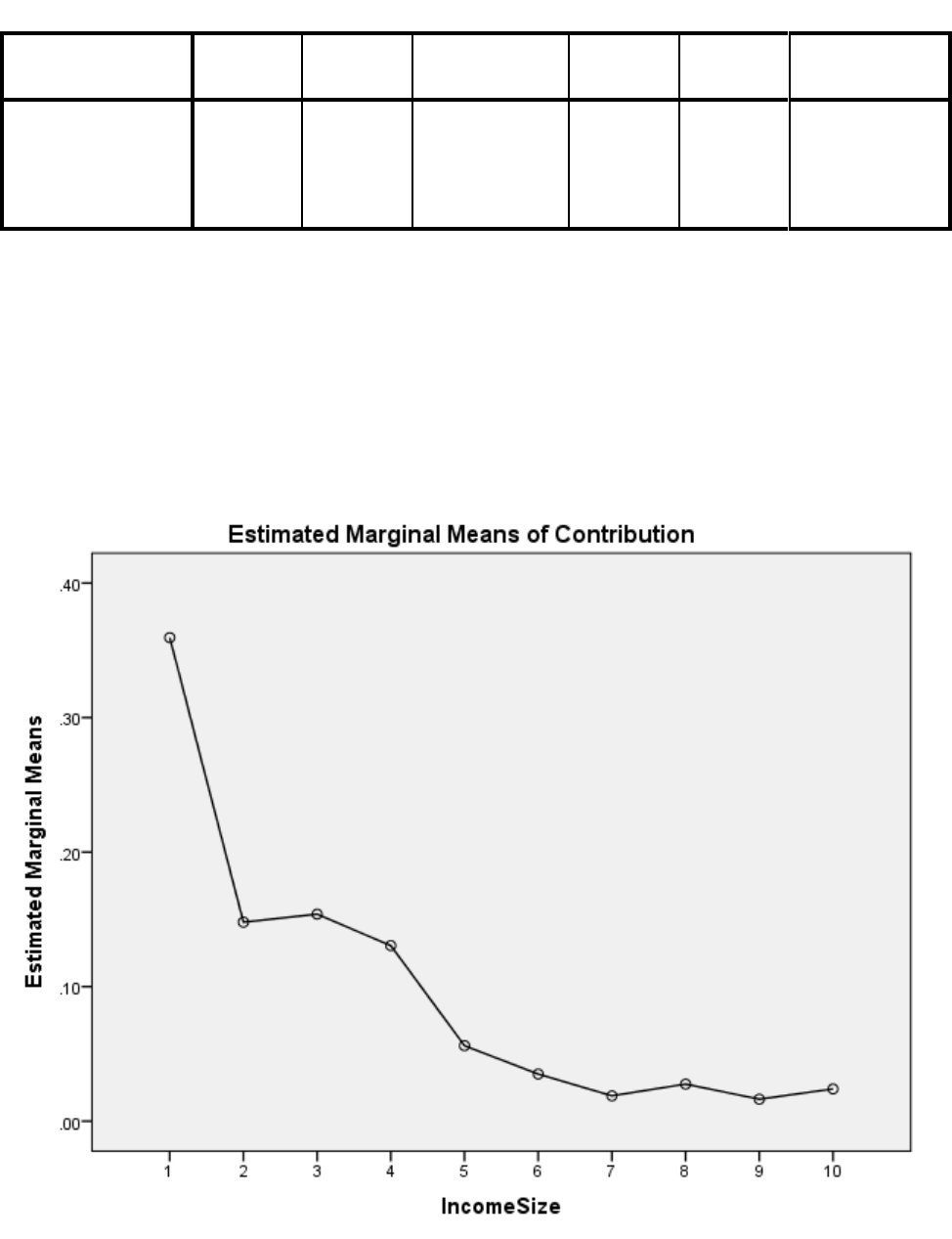
24
Multivariate Tests
Value
F
Hypothesis df
Error df
Sig.
Partial Eta
Squared
Pillai's trace
.674
80.839
a
9.000
352.000
.000
.674
Wilks' lambda
.326
80.839
a
9.000
352.000
.000
.674
Hotelling's trace
2.067
80.839
a
9.000
352.000
.000
.674
Roy's largest root
2.067
80.839
a
9.000
352.000
.000
.674
Each F tests the multivariate effect of IncomeSize. These tests are based on the linearly independent
pairwise comparisons among the estimated marginal means.
a. Exact statistic
Profile Plots

25
Question 4 - Formula and Output from SPSS
Formula
GET DATA /TYPE=XLSX
/FILE='C:\Users\TWKee\Desktop\Survey Data\Q4 SPSS Input.xlsx'
/SHEET=name 'Q4 Final'
/CELLRANGE=full
/READNAMES=on
/ASSUMEDSTRWIDTH=32767.
EXECUTE.
DATASET NAME DataSet1 WINDOW=FRONT.
GLM Oneoff @1year @2years @3years @4years @5years gt5years
/WSFACTOR=GrantTerm 7 Repeated
/MEASURE=Contribution
/METHOD=SSTYPE(3)
/SAVE=ZRESID
/PLOT=PROFILE(GrantTerm)
/EMMEANS=TABLES(OVERALL)
/EMMEANS=TABLES(GrantTerm) COMPARE ADJ(BONFERRONI)
/CRITERIA=ALPHA(.05)
/WSDESIGN=GrantTerm.

26
Output
General Linear Model
Notes
Output Created
11-OCT-2016 16:13:33
Comments
Input
Active Dataset
DataSet1
Filter
<none>
Weight
<none>
Split File
<none>
N of Rows in Working Data
File
436
Missing Value Handling
Definition of Missing
User-defined missing values are treated
as missing.
Cases Used
Statistics are based on all cases with
valid data for all variables in the model.
Syntax
GLM Oneoff @1year @2years
@3years @4years @5years gt5years
/WSFACTOR=GrantTerm 7 Repeated
/MEASURE=Contribution
/METHOD=SSTYPE(3)
/SAVE=ZRESID
/PLOT=PROFILE(GrantTerm)
/EMMEANS=TABLES(OVERALL)
/EMMEANS=TABLES(GrantTerm)
COMPARE ADJ(BONFERRONI)
/CRITERIA=ALPHA(.05)
/WSDESIGN=GrantTerm.
Resources
Processor Time
00:00:01.14
Elapsed Time
00:00:00.40
Variables Created or
Modified
ZRE_1
Standardized Residual for Oneoff
ZRE_2
Standardized Residual for @1year
ZRE_3
Standardized Residual for @2years
ZRE_4
Standardized Residual for @3years
ZRE_5
Standardized Residual for @4years
ZRE_6
Standardized Residual for @5years
ZRE_7
Standardized Residual for gt5years
[DataSet1]
Within-Subjects Factors
Measure: Contribution

27
GrantTerm
Dependent
Variable
1
Oneoff
2
@1year
3
@2years
4
@3years
5
@4years
6
@5years
7
gt5years
Multivariate Tests
a
Effect
Value
F
Hypothesis df
Error df
Sig.
GrantTerm
Pillai's Trace
.916
785.356
b
6.000
430.000
.000
Wilks' Lambda
.084
785.356
b
6.000
430.000
.000
Hotelling's Trace
10.958
785.356
b
6.000
430.000
.000
Roy's Largest Root
10.958
785.356
b
6.000
430.000
.000
a. Design: Intercept
Within Subjects Design: GrantTerm
b. Exact statistic
Mauchly's Test of Sphericity
a
Measure: Contribution
Within Subjects
Effect
Mauchly'
s W
Approx.
Chi-Square
df
Sig.
Epsilon
b
Greenhous
e-Geisser
Huynh-
Feldt
Lower-bound
GrantTerm
.005
2297.404
20
.000
.441
.444
.167
Tests the null hypothesis that the error covariance matrix of the orthonormalized transformed
dependent variables is proportional to an identity matrix.
a. Design: Intercept
Within Subjects Design: GrantTerm
b. May be used to adjust the degrees of freedom for the averaged tests of significance. Corrected
tests are displayed in the Tests of Within-Subjects Effects table.

28
Tests of Within-Subjects Effects
Measure: Contribution
Source
Type III
Sum of
Squares
df
Mean
Square
F
Sig.
Grant
Term
Sphericity Assumed
56.664
6
9.444
208.392
.000
Greenhouse-Geisser
56.664
2.647
21.410
208.392
.000
Huynh-Feldt
56.664
2.664
21.268
208.392
.000
Lower-bound
56.664
1.000
56.664
208.392
.000
Error
(Grant
Term)
Sphericity Assumed
118.282
2610
.045
Greenhouse-Geisser
118.282
1151.261
.103
Huynh-Feldt
118.282
1158.959
.102
Lower-bound
118.282
435.000
.272
Tests of Within-Subjects Contrasts
Measure: Contribution
Source
GrantTerm
Type III
Sum of
Squares
df
Mean
Square
F
Sig.
Grant
Term
Level 1 vs. Level 2
5.273
1
5.273
18.356
.000
Level 2 vs. Level 3
9.825
1
9.825
82.328
.000
Level 3 vs. Level 4
.379
1
.379
4.777
.029
Level 4 vs. Level 5
3.373
1
3.373
80.871
.000
Level 5 vs. Level 6
.042
1
.042
3.786
.052
Level 6 vs. Level 7
.041
1
.041
2.930
.088
Error
(Grant
Term)
Level 1 vs. Level 2
124.969
435
.287
Level 2 vs. Level 3
51.912
435
.119
Level 3 vs. Level 4
34.484
435
.079
Level 4 vs. Level 5
18.144
435
.042
Level 5 vs. Level 6
4.873
435
.011
Level 6 vs. Level 7
6.151
435
.014

29
Tests of Between-Subjects Effects
Measure: Contribution
Transformed Variable: Average
Source
Type III Sum of
Squares
df
Mean Square
F
Sig.
Intercept
7.385
1
7.385
15944.439
.000
Error
.201
435
.000
Estimated Marginal Means
1. Grand Mean
Measure: Contribution
Mean
Std. Error
95% Confidence Interval
Lower Bound
Upper Bound
.130
.001
.128
.132
2. GrantTerm
Estimates
Measure: Contribution
GrantTerm
Mean
Std. Error
95% Confidence Interval
Lower Bound
Upper Bound
1
.385
.016
.354
.416
2
.275
.013
.248
.301
3
.125
.008
.108
.141
4
.095
.010
.076
.114
5
.007
.002
.004
.010
6
.017
.005
.008
.027
7
.007
.003
.002
.013
Pairwise Comparisons
Measure: Contribution
(I)
GrantTerm
(J) GrantTerm
Mean
Difference
(I-J)
Std.
Error
Sig.
b
95% Confidence Interval for
Difference
b
Lower Bound
Upper Bound
1
2
.110
*
.026
.000
.032
.188
3
.260
*
.020
.000
.198
.322
4
.290
*
.021
.000
.225
.354
5
.378
*
.016
.000
.328
.427
6
.368
*
.017
.000
.315
.421
7
.377
*
.016
.000
.327
.428

30
2
1
-.110
*
.026
.000
-.188
-.032
3
.150
*
.017
.000
.100
.201
4
.180
*
.018
.000
.124
.235
5
.268
*
.014
.000
.226
.309
6
.258
*
.015
.000
.212
.303
7
.267
*
.014
.000
.225
.310
3
1
-.260
*
.020
.000
-.322
-.198
2
-.150
*
.017
.000
-.201
-.100
4
.029
.013
.617
-.012
.071
5
.117
*
.009
.000
.091
.144
6
.108
*
.010
.000
.078
.138
7
.117
*
.009
.000
.090
.145
4
1
-.290
*
.021
.000
-.354
-.225
2
-.180
*
.018
.000
-.235
-.124
3
-.029
.013
.617
-.071
.012
5
.088
*
.010
.000
.058
.118
6
.078
*
.011
.000
.045
.111
7
.088
*
.010
.000
.057
.119
5
1
-.378
*
.016
.000
-.427
-.328
2
-.268
*
.014
.000
-.309
-.226
3
-.117
*
.009
.000
-.144
-.091
4
-.088
*
.010
.000
-.118
-.058
6
-.010
.005
1.000
-.025
.006
7
.000
.003
1.000
-.010
.010
6
1
-.368
*
.017
.000
-.421
-.315
2
-.258
*
.015
.000
-.303
-.212
3
-.108
*
.010
.000
-.138
-.078
4
-.078
*
.011
.000
-.111
-.045
5
.010
.005
1.000
-.006
.025
7
.010
.006
1.000
-.008
.027
7
1
-.377
*
.016
.000
-.428
-.327
2
-.267
*
.014
.000
-.310
-.225
3
-.117
*
.009
.000
-.145
-.090
4
-.088
*
.010
.000
-.119
-.057
5
.000
.003
1.000
-.010
.010
6
-.010
.006
1.000
-.027
.008
Based on estimated marginal means
*. The mean difference is significant at the .05 level.
b. Adjustment for multiple comparisons: Bonferroni.
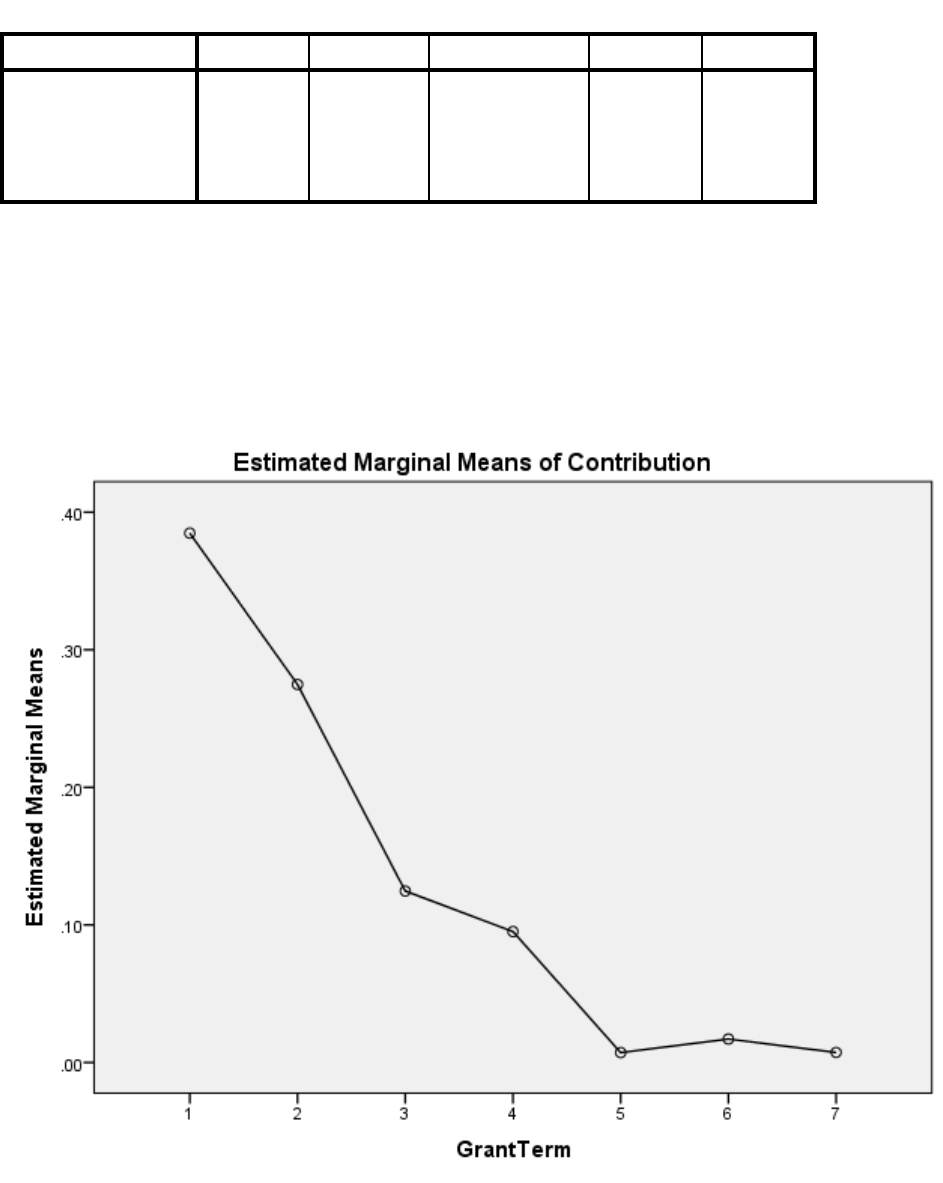
31
Multivariate Tests
Value
F
Hypothesis df
Error df
Sig.
Pillai's trace
.916
785.356
a
6.000
430.000
.000
Wilks' lambda
.084
785.356
a
6.000
430.000
.000
Hotelling's trace
10.958
785.356
a
6.000
430.000
.000
Roy's largest root
10.958
785.356
a
6.000
430.000
.000
Each F tests the multivariate effect of GrantTerm. These tests are based on the linearly
independent pairwise comparisons among the estimated marginal means.
a. Exact statistic
Profile Plots
1
Appendix 2
Domain Summary - The complexities of securing a grant
“…most grant application/selection processes are highly subjective…” (Charity Leader 10)
“…selection criteria vary month-to-month and year-to-year within the same funding organisations … you
will submit a grant application one year, which will be successful, submit a very similar application the
following year and fail or vice versa…” (Charity Leader 8)
“… some funders encourage you to keep applying again and again, suggesting that the reward is for effort
and persistence not the content or validity of your application…” (Charity Leader 8)
“…we recently submitted a grant application to a funder who had supported us the year previously… our
application was unsuccessful despite having very similar goals/deliverables to the previous year’s
submission … the reason [feedback] given for our application being unsuccessful was that we had secured a
grant the year previous … this did leave us scratching our head a bit …” (Charity Leader 11)
“…the lack of process transparency and alignment within the trusts/foundation environment puts the third
sector at an immediate disadvantage in securing funds from the majority of these organisations as we are
often unsure what they are looking for and what is of optimum importance to them…” (Charity Leader 12)
“…feedback from … grant applications are more than often not forthcoming … it is then difficult to know
what needs adjusting in order to have success in a future grant application …” (Charity Leader 3).
“… feedback from grant applications...both successful/unsuccessful, is vague at best …” (Charity Leader 5)
“… feedback from funders … is pretty much non-existent … consequently, there is no evidence on which to
help improve the quality and success rate of grant applications …” (Charity Leader 7).
“… due to a dearth of comprehensive feedback; it can be almost impossible to understand why a grant
application was either successful or not …” (Charity Leader 10)
2
“… reduces the ability of charities to react quickly to whatever issue is at hand” (Charity Leader 10)
“… the time to receive notification of a grant application outcome, either way, also causes inefficiencies …
the time lag does not afford us stability or allow us to be as quick on our feet as we would like to be...”
(Charity Leader 8)
“…a question must be posed to funders regarding their assessment of the efficiency of their
application/approval processes, which can take up to a year…and with little feedback to the applicant; what
are they doing...” (Charity Leader 5)
“… this funder wishes to use their funds to support many organisations rather than allocate their funds on
the quality of grant applications … allocating funding in this manner doesn’t make much sense as it is
clearly not the most effective use of the allocated funds …” (Charity Leader 12)
“…this could indicate an ignorance of what works and works well…” (Charity Leader 8)
“… funders do seem to like funding new programs and fund pilot programs that have not been funded
previously…” (Charity Leader 7)
“…funders also tend to want to fund new programs or innovation … have funders considered that as the
sector is bathed in uncertainty…that the inability to plan and operate long term is causing the sector to
regress…” (Charity Leader 8)
“... some funders seem to treat philanthropy as a fashion statement, as in, what are this season’s new styles
… most grant managers will state that their board wants to see something new …” (Charity Leader 2).
“... there also seems to be a current desire from funders to invest in something new, possible driven by a
‘feel good’ factor that a particular program/outcome can be attributed back to the funding organisation … “
(Charity Leader 4)
“… lose interest in long-term programs and often ask why the need remains and why the issue has not been
rectified …” (Charity Leader 7)
“… there is little appetite for existing programs with proven outcomes…which would seem to indicate that
some funders have more interest in achieving a short term ‘we did that’ rather than helping deliver long
term benefits …it is quite concerning to think that funders … believe that long-term entrenched community
issues can be resolved via short term programs or one-off funding cycles …” (Charity Leader 3)
3
Domain Summary - The diminished ability to establish and follow any form of
strategic path
“… current funding available from most funders is tactical, as in, the grants are mostly short-term and small
… as a result, it is challenging to have any strategic focus … or invest in long term plans ... a change in
funders’ focus from tactical to strategic would be of great benefit …” (Charity Leader 3)
“…the lack of long-term granting compromises charities, who then find it difficult to focus on long-term
strategy … short-term funding does not lead to achieving critical impacts, particularly in areas where
change happens over 5 to10 year periods rather than 1-2 years … multi-year funding enables long-term
planning around key interventions …” (Charity Leader 4)
“… current funding models are driving inefficiencies in the sector … the inability to secure substantial long-
term financial support results in tactical, unstable organisations … employee turn-over rate is higher as a
result … decision making can also be compromised, which is unsurprising if you have only three months
working capital and 50 employees ...” (Charity Leader 9)
“...current funding available from most organisations is very tactical…the grants are mostly short term and
small…” (Charity Leader 3)
“… the need for long term funding is critical to the sector progressing …” (Charity Leader 4)
“…there are a small number of private philanthropists who are willing to fund…development items but the
vast majority of funders will not, preferring instead to fund particular/specific programs and generally want
something new and shiny…most want their funding spent on ‘front line’ activities…” (Charity Leader 1)
“… we previously followed, what I would describe as being a linear model… we would plan an event, raise
funds through that event and then donate these funds…our model is now much more project focussed, as in,
a particular need will be identified by a hospital or health fund…we will then target our fundraising
activities towards funders who are more likely to support this particular need and work towards fundraising
for a specific amount that will allow the project to be delivered…” (Charity Leader 11)
“… we are a large education focussed charity…we do have a proven talent for fundraising, as an income
well in excess of $50m per annum would substantiate ...however…we were seeing a really worrying trend; a
drop in corporate partnership income…we knew that we had to change tack and this change would have to
be dramatic…we restructured the corporate partnership department…we put an intense focus on securing
long term high value partners…and we introduced a pipeline management tool introduced to ensure that we
4
are effectively tracking the prospective income…in the two years since the restructure, we delivered 11.6%
growth in 2016 – our best result since the GFC in 2009…even more pleasing when you consider that market
growth in this segment (corporate partnerships) had declined 11.3% to FY15 (Pareto Benchmarking)…and
we are on track to deliver further growth in FY17…” (Charity Leader 11).
Domain Summary - The inability to invest in programs or projects that would
effectiveness and efficiency
“… as a leader in the charity sector you can see – very clearly – the opportunities to increase efficiencies,
effectiveness and outputs … but through a lack of funding you can rarely exploit them…this can be soul
destroying … leading an organisation with only three months working capital is very, very challenging …”
(Charity Leader 1)
“… organisational infrastructure, training and development of employees, quality accommodation,
reward/remuneration, are all accepted as necessary and even critical investments by commercial
organisations in order to progress…” (Charity Leader 1)
“… the ability to continually enhance our systems and processes is limited … as an organisation with a
potential footprint of close to 5000 schools across all states and territories, IT advancements would do so
much to reduce administration costs, which is what our funders want … unfortunately, the same funders do
not want to fund these administration improvements … this disconnect needs addressing…” (Charity Leader
9)
“… we had a two-year $50,000 per annum funding agreement with a national courier company that was
coming to a conclusion … the responsible fundraising manager could see a solution to filling this $100,000
gap but rather than state the obvious he wanted his team to think more laterally and identify the answer
themselves … the manager asked his team to consider all the options…after a few days, the team presented
their strategy which focussed on sourcing funds through grant applications to the usual suspects…the
manager again pressed the team to consider alternative strategies and they agreed to meet the following
week with an updated proposal … the updated proposal was more of the same, further grant applications but
this time to a different raft of funders …the manager asked his team to try again but the next proposal wasn’t
much different…getting frustrated with the lack of imagination from his team, the manager took a more
explicit tact…he asked his team to review the annual costs associated with their ‘School Reading
Program’…the team investigated and provided the following: 40% or around $100,000 went on buying
books, a further 40% went on sourcing and administering the ‘reading’ volunteers required and the last 20%
or around $50,000 was the cost of delivering the books to the schools…the manager asked the team if they
5
could see an opportunity but despite it being conspicuous to him, they still couldn’t…he then asked them if
they could get the courier company to deliver the books to the schools for them pro-bono, ‘we don’t know’,
was the reply, ‘well go and ask’…this example is not a reflection on the capabilities of the employees
involved …they are fabulous at what they do – which is fundraising… the criticism here is of the narrow
capability that has been allowed to develop – which is due to the fact that all this team does is
fundraise…our managers cannot afford the time or expense to develop their people… as such, our
effectiveness is well compromised…” (Charity Leader 12)
“…convince funders that investment in people and infrastructure is not just OK but a necessity for better
program outcomes …” (Charity Leader 5)
“…charities, whilst generally established for a community purpose, are still organisations and need similar
investment in order to thrive … this point seems to be lost on most funders …” (Charity Leader 1)
Domain Summary - The disproportionate amount of organisational resource
deployed to secure and maintain future funding streams
“... small grants/donations are hugely ineffective … the time and effort expended in pursuing small grants is
substantial…” (Charity Leader 7)
“... the administration required to pursue, and secure small grants/donations is huge…” (Charity Leader 9)
“... applying for grants takes a lot of time … and you have a low success rate … due to the current
preference from funders to provide small short-term grants, sourcing grants to fund a program can take
many months and the window of opportunity for the program can often close … this is a significant waste of
resource…” (Charity Leader 6).
“… the process is onerous, and you have a success rate of around 10% ... success is one or two major wins a
year …” (Charity Leader 5)
“... funders could be more fleet of foot and not entrenched in funding cycle models which are decades old …
raising pooled funding (small grants from a variety of funders) is hard work…and if total funds for the
program are not raised, you then have to return what was raised…not a good use of our resources…”
(Charity Leader 6)
“…acquittal reporting takes a significant amount of resource for very little return…our acquittal reports to
6
funders are very rarely challenged or questioned. Why? (Charity Leader 3)
“… funders place unreasonable demands for detailed acquittal reporting…yet from our own experience,
very little is ever done with the reports submitted …” (Charity Leader 8).
“…larger longer-term grants would provide much greater certainty and allow charities to focus on core
activities…a reduction in some of the more onerous acquittal reporting requirements from funders –
especially for small grants - would also help…” (Charity Leader 2)
Domain Summary - The realities of being a charity employee
“… we have limited ability to attract and retain the best quality of staff…short term funding contributes to
this challenge inhibiting our ability to have any form of long-term plan…employees in many, many industries
aspire for employment security…why is this goal largely unattainable for most in the sector?... support via
longer term more substantial funding would help significantly…” (Charity Leader 8)
“… charities have little ability to invest in attracting and retaining quality staff … improving recruitment
capability would help significantly … whilst the working environment can offer significant benefits
(flexibility, community-minded work, etc), the limitations to offer competitive salaries is a significant barrier
in attracting and retaining excellence …” (Charity Leader 7)
“…employees within the charity sector … have the same aspirations as many others, the ability to buy a
house and provide a stable safe environment for their families…that can be difficult when you are on a
rolling six-month contract…” (Charity Leader 7)
“… I find it intriguing as to why there seems to be a general consensus that if you work in the charitable
sector, there is no need to for you to be rewarded financially at an appropriate / market rate … I’m not sure
why this is so but it must be a barrier to attracting and retaining talent …” (Charity Leader 11)
“...facilities could also be improved – buildings and furniture…there seems to be a growing acceptance that
it is satisfactory to house charities in the most run-down buildings available and furnish these buildings with
office equipment that is on its way to the dump … it is not a nice way to be treated …” (Charity Leader 9).
“… I recently attended an event where the CEO of a large UK charity was presenting, his opening gambit
was around what he earned and why – as his remuneration package had previously attracted criticism … he
articulated his qualifications / experience / achievements and stated that if he was undertaking a similar role
7
in the commercial / business sector he could expect a significantly higher financial reward for his efforts but
has chosen to accept these reduced conditions in order to contribute to the sector / community … the fact
that this CEO felt the need to defend his salary tells its own story about how the sector is viewed by many
…” (Charity Leader 11).
“…there is a general perception that those working in the charity sector are underqualified and couldn’t cut
it in the commercial world… really? … many employees within the charity arena come from the corporate
world, as they want to be involved in making a difference not just making money … sadly, they eventually
return to their former world as they are exhausted … their human capital has not been invested in wisely …
[however, it is also the case that] many remain in the non-profit arena as they become so embedded within
the cause that adequate pay, training or development opportunities or even decent accommodation become
less of the focus…” (Charity Leader 3)
“… the whole of community attitude towards the charity sector and its employees needs to change if
employees are to remain within the sector long term and to reach the outcomes, they set out to achieve …”
(Charity Leader 6).
“... applying for grants takes a lot of administration time … you have a low success rate … due to the
current preference from funders to provide small short-term grants, sourcing grants to fund a program can
take many months and the window of opportunity for the program can often close … this is a significant
waste of resource and can be emotionally draining …” (Charity Leader 6).
“...the administration costs required to pursue, and secure small grants/donations is huge … the effort can
be exhausting…” (Charity Leader 9).
“…have funders thought of the impact such a process may have on the people who are submitting the
applications…” (Charity Leader 8).
“…it becomes easier to think you are not good at your job… you can quickly become emotionally tired of
pitching…hope gets diluted…” (Charity Leader 5).
“… raising pooled funding (small grants from a variety of funders) is hard work…emotionally exhausting
and if total funds for the program are not raised, returning funds is heart wrenching for the staff member
and counterproductive with funders …” (Charity Leader 6
8
Domain Summary - The partisan nature of government contracts
“… a number of our funders, including government, did not take kindly to the proposed changes that we put
to them … they had difficulty understanding why we would not want to accept their money – if it was on offer
…” (Charity Leader 9)
“… managing government funding has always been a challenge … the environment that has developed over
the last few years is significantly increasing the financial risk to charities, which in turn is driving further
organisational inefficiencies… (Charity Leader 11)
“… discussions with other charity CEOs has confirmed that the majority of the sector is wrestling with the
issue of managing the risk now associated with government grants…” (Charity Leader 11)
“… many government grants have a mid-term adjustment, which takes into account increases in the cost of
delivering any particular program, such as wages or inflation… if the government of the day finds itself in a
challenging economic position, the government may renege on the mid-term adjustment … the result being a
good news story for the government but a funding shortfall for the charity tasked with delivering a particular
program … it is certainly a material variation to the contract…” (Charity Leader 11)
“… we are a large charity with an annual income of over $50 million yet less than 10% of our income comes
from government (federal or state)…this is deliberate tactic as we have been burned a few times in the
past…we secure a 5-year funding agreement for a particular program, recruit the associated resource and
initiated the program activities, then 18 months later due to a change of minister and focus, the funding gets
pulled…and don’t you dare try to question or challenge the decision or you’ll get blacklisted…so we now try
and keep our distance …” (Charity Leader 12)
… charities may find themselves with (government) funds for a program that they cannot competently or
financially deliver … if this proves to be the case, the charity then has to pay fines for failing to deliver the
heavily varied contract and can be required to fund the re-tendering process … it is also highly likely that
any charity that pursues argument about material changes to the viability of the contract with government
regarding the content or cost of a contract will be subject to a series of ‘audits’ in order to satisfy the
department that it remains financially viable … so rather than negotiate a new contract that is favourable to
both parties, the government’s response is to undertake an in-depth audit of a charity…this is done to avoid
admission of market failure, which is bad news for a Minister … the ‘audit’ provides the government with the
opportunity to create a picture of ineptitude or even corruption … most organisations that withdraw from
delivery of a government contract will likely be banished from participation in any future government
tendering … the financial and reputation risks associated with the aforementioned scenarios force charities
to allocate resources away from its core purpose into risk mitigation, driving up operational costs
9
11)
“… if all charities associated with government contracts were to remove themselves from future
applications, the government may be forced to review its protocols … but not because of a concern over
process inefficiency or contract inequity, a review would only be forced on government due to public and
media pressure … the recent move towards ‘Payment By Results’ contracts is also causing challenges for the
charity sector … ‘Barriers to Entry’ can be significant and as charities cannot access traditional capital
markets, alternative riskier method of funding, such as asset dilution, are being explored … social bonds
may be a solution but only for funding programs that can demonstrate a reasonable return on investment …”
(Charity Leader 11)
“… government departments are one of the main barriers to improving efficiency within the charity sector …
the sector is afforded very few rights through the application processes…this says a lot about the opinion
government must have of the sector …”. (Charity Leader 11)
Domain Summary - The unwillingness or inability of charities to articulate to
funders the deficiencies of the current funding models
“... both charity boards and leaders need to be more courageous and make the correct decisions – decisions
that meet purpose not ego … I can understand why funding that does not quite align with organisational
outcome would be gratefully accepted, especially if that funding secures everyone’s employment for the next
12 months … but isn’t this just delaying the inevitable ...” (Charity Leader 10)
“… having assessed my own…organisation, I knew that we would be unable to progress under the current
operating regime … we could not continue the strategy of doing more and more with less and less … this is a
significantly flawed process and followed by many in the sector … it forces unnecessary competition,
damages trust and dilutes the opportunities for collaboration …” (Charity Leader 10)
“… there is a need for more collaboration between charities and leadership should be asking do we still
need to be here or are others doing what we are doing only better … unfortunately, this does not happen
very often, and leadership biases can get in the way …” (Charity Leader 4).
“…there remains a lack of willpower to consolidate charities that are pursuing similar missions with similar
interventions…” (Charity Leader 11)
“… the sector does need to improve its ability in articulating the value and return of organisational
10
investment to funders … the alternative…to walk away from program funds when administration costs must
be sourced from elsewhere – however, it can be almost impossible for a charity to refuse funding when you
only have a few months working capital…” (Charity Leader 6)
“... it is almost impossible to evidence the impact of a small grant, yet funders seem ignorant to this fact …
what are the charities telling funders…” (Charity Leader 3)
“…the whole of the charity sector needs review … funders are driving inefficiencies by the size, term and
conditions attached to the majority of grants … the charity sector also needs to take a good long hard look at
itself …” (Charity Leader 10)
“… a collective voice for the sector may help…” (Charity Leader 1).
… the sector needs to get better at articulating the value and return of organisational investment…”
(Charity Leader 5)
Domain Summary -
… the need for long term funding is lost on those who can best provide it …” (Charity Leader 4)
“...funders like to participate in some form of volunteering but there is an expectation that this interaction
should be free … as in ‘we (busy, professionals) are giving you (the poor charity sector) our extremely
valuable time’ … whilst volunteering can add some value to both organisations, it does not have anywhere
near the same impact as a grant and takes a huge amount of time to administer … funders should be more
willing to fund the administration costs associated with volunteering …” (Charity Leader 5)
“… I think there is a misalignment between funds available and expectation of how much time we can spend
providing information, organising visits to projects, etc …” (Charity Leader 9)
“… improved awareness from funders regarding what impact short-term funding cycles deliver … with
specific regards to youth at risk, it takes several years to engage with youth, fully gain their trust and then
help them develop the skills required to grow … you cannot reasonably expect to undo a life-time of damage
with a 12/18-month intervention package – and expect the kids to thrive when they are cut loose … the fact
that this point is lost on many funders is incredibly concerning …” (Charity Leader 4).
“... many of the people we work with have not had positive relationships in their lives at all, let alone
11
enduring connections – either as children or adults … short-term projects usually mean a short-term
relationship with a worker … this translates to yet another face of someone they are going to have to share
their personal lives with and who will not stay long enough in their lives to build their hope (they just see a
revolving door of workers/strangers) … in some ways, this reminds them of their personal histories,
including the lack of stable relationships and love that led them to this point in the first place … they feel like
they are failures and not worthy enough to have someone care about them …” (Charity Leader 3)
“ … there is plenty of evidence to show that when these people transition between programs or organisations
for support, they are more likely to slip through the cracks and disengage … it takes time to embed new skills
and ways of being that help people from highly disadvantaged backgrounds navigate life’s challenges and
achieve new goals … short-term projects can be detrimental and it is more realistic to provide longer term
funding so lives can change for the long term …” (Charity Leader 3)
cost neutrality of grants is around $10,000…” (Charity Leader 9)
cost neutrality is around the $10,000 mark …” (Charity Leader 7).
“…an employee could now assess the value of applying for a grant and not apply if that particular grant did
not help us achieve our goals…such as…being cost neutral…” (Charity Leader 10)
1
Appendix 3
Domain Summary - The Australian charity sector
“… commentators raise the issue of too many charities in Australia and this is a valid point … many are
replicating services and adding unnecessary administration costs …” (Funder 4)
“… if you look at the vast number of charities that currently exist, you can quickly see another problem – too
many organisations, many doing similar things, all chasing the same dollar...” (Funder 3)
“…in some ways, funders are contributing to this issue, by allocating their granting to a large number of
organisations…” (Funder 4)
“…our usual practice is to make relatively small monetary grants, in a range of $5000 to $30,000, to many
different organisations and programmes rather than to make fewer grants at higher levels of monetary
support...” (Funder 2)
“…we limit our granting to a period of 12 months…recipients will use best endeavours to complete the
programme/project within 12 months from the date of receipt of the grant…” (Funder 2).
“…funders are less than knowledgeable about the sector and how to achieve the best outcomes…hence the
short-term funding model employed by many (Funder 14).
there is far too much replication across the charity sector and not enough collaboration …” (Funder 6).
“…the sector needs to work smarter to amortise costs and increase efficiencies through partnership and
collaboration…” (Funder 9).
“... consolidation across the charity sector is long overdue” (Funder 2).
“… if funders were more disciplined, they would do the research and only back the efficient users of capital,
similar to the for-profit world … the less efficient operators would then merge or close …” (Funder 11)
“…unfortunately, much knowledge and community relevance will be lost in this process, something that we
2
as funders don’t like to see...” (Funder 2)
“…effective collaboration requires major investment in infrastructure and resources, and a cultural
change…” (Funder 9)
“…accepting funding when it is not your core competence is mission creep and this happens all too often...if
you can’t secure funding to pursue your mission, there is something fundamentally wrong and maybe it is
time to move on…the beneficiary of social funding must be the community, the service provider is simply the
conduit for delivering the benefit...” (Funder 9)
“… some funders, including government, pressing charities to accept funds and undertake activities that will
have little benefit to either their organisation or client base …” (Funder 2)
“… funders can also be arrogant and impose processes and set unrealistic timelines and expectations …
many insist on exactly what a grantee should be doing with their funds without having the experience or
understanding of the service provider … and charities desperate for funding will pander to these requests
…” (Funder 9)
“… I feel that more charities should be less beholden to funders and push back a bit more …” (Funder 8)
“… the best way forward for the sector, and for funders, is to take the subjectivity out of funding decisions
…charities should be clear on what their focus is and be able to articulate this … fundees should respect this
and not try and fit the proverbial square peg application into a round hole …” (Funder 2)
“… charities could demonstrate a stronger commitment to measurement … it does not need to be highly
complicated more around, what can you actually count ...” (Funder 5)
“…measurement or more specifically the ability to articulate outcomes could be improved…” (Funder
interviewee 28)
“…why will we continue to fund the organisations that can provide little evidence of impact or
progression…” (Funder 2).
“…one challenge is assessment, as in, how do you measure the success of a program ... can you compare a
program that helps at-risk youth into the workforce against that of a program helping females who are
experiencing domestic violence … or is an early childhood numeracy and literacy education program a more
favourable proposition than helping males with prostate cancer …” (Funder 11)
3
“…charities are unlikely to provide such feedback for fear of compromising an income stream...” (Funder 9)
Domain Summary - The use of donations or grants
“… funders seem to have this pervasive belief that administration costs are the devil’s work, and they should
be kept to the bare minimum … yet the majority of funders will baulk at requests for funding back office – the
very investments that will reduce administration costs …” (Funder 7)
“… looking to the future, an ambition would be to provide more core operational and administration support
as most of the support we provide is still program or project based …” (Funder 6)
“… not enough funders provide capacity building grants … many, charities are doing great work and, if
appropriate funding was available, could scale their activities … most funders limit their support to
‘effective’ charities but are reluctant to help charities become more effective … counterintuitive indeed …”
(Funder 14)
“… historically, we have distributed around 50–75% of our funds towards capacity building … moving
forward it will be 100% ... when some funders decline to fund due to a dearth of skills to deliver a program
in a certain community or a lack of available assets, we tend to see that as the obvious reason to fund …”
(Funder 8)
“… we also support capacity building … around 20% of our funds are used in pursuit of this objective …
more effective not-for-profit organisations can deliver more/better outcomes …” (Funder 5)
“… we also look at providing support with capability and/or capacity building … although there is only
about 10-15% of our funds directed towards this goal …” (Funder 6).
“… we will look at grant applications that support capacity building in organisations – which is currently
around 6% of our expenditure…” (Funder 2)
“… we recognise the importance of capacity building and have increased our annual distribution over the
past few years: 2015 – 5%, 2016 – 10%, 2017 – 12% ...” (Funder 3)
“...unfortunately, it is a common and arrogant practise for funders to dictate what not-for-profits/charities
should do with the funds provided…despite not being best qualified to do so…(Funder 14). “…many insist
on exactly what a grantee should be doing with their funds without having the experience or understanding
4
of the service provider…” (Funder 9)
Domain Summary - The fundee/funder relationship
“… there is an underlying opinion – which few are likely to admit - that charities and their employees
deserve less … if you work in the sector it is for the love of it, therefore you should be happy to be paid less,
have sub-standard accommodation, poor equipment and very little organisational support …” (Funder 6)
“…that sector leaders are a little bit dopey, which is highly ill-informed but readily accepted by funders …”
(Funder 9)
“… the opinion of the sector needs to improve … most funders have little regard for the capability and
competence of sector leaders … this is a difficult position to understand … it is ill-informed and
demonstrates a high level of arrogance and points to a power imbalance …” (Funder 6)
“… funders can feel they are better qualified than the sector to make the best decisions – ‘here is what you
should do’…” (Funder 9)
“…a breed apart in that, they are doing it for the love of it ... administration can be seen as an unnecessary
overhead especially by funders whose directors have been focussed on the ‘cost out’ models of
organisational efficiencies …” (Funder 5)
“… I doubt government could mobilise volunteers in the manner that the charity sector can … this is a huge
risk for governments, but they seem content in continuing to abuse the power they hold as major funders of
the sector …” (Funder 7)
“… I have often thought about the risk the government runs in treating charities poorly … changes of
government equate to a change in policy and a withdrawal of promised funds, which impact many, many
charities…the same can be said for ministerial changes ... all of which contribute to the instability of the
sector …” (Funder 7)
“… whilst the sector has much room to improve, the way it is viewed by all types of funders is a serious
concern … Australia’s charity sector has many highly qualified, intelligent and knowledgeable individuals
who are trying to address the most challenging problems our country faces … yet they don’t have a decent
chair or up-to-date software … why the disparity between the commercial and charity sectors … why do we
think that charities not only need less but deserve less …” (Funder 11)
5
“… there is a significant power imbalance … there is no onus on funders to be effective …” (Funder 8)
“… there is a huge power imbalance … true altruism is rare … funders will take their cash elsewhere if they
are not appeased – despite the outcomes that a program or organisation is delivering … I have difficulty in
comprehending why this occurs …” (Funder 6)
“… is highly unlikely a charity, in need of funds … would choose not to pursue a partnership with us … or
any other funder … therefore, in reality the power in all these relationships sits firmly with the funders …”
(Funder 3)
“… I have found that the sector has differing characteristics … it is far less strategic in its thinking and
much less aggressive in its negotiations ... the lack of aggression may be as a result of the obvious power
imbalance between funders and fundees, as in, charities may be a bit frightened of biting off the hand that
feeds them …” (Funder 7)
“…without transparent feedback on the impact of their funding practices, funders are unlikely to change…”
(Funder 9)
“…the charity sector doesn’t help as it rarely provides any negative feedback about funding – it is never too
small or too short-term … it will always make such a difference, when the opposite is more often than not
true…” (Funder 11)
“…despite the size of grant or donation provided and the associated costs of reporting on it, charities will
not refuse funding…” (Funder 2).
“…the majority of not-for-profit organisations tend to appease their funders… not-for-profits tell the funders
what they think they want to hear…” (Funder 10) and “…’this $5000 will make such a difference’…when
they know it will fill a need but not create the impact, they [the funders] want…” (Funder 10)
“…the term I use for this is ‘sophisticated begging’…as it all seems to be focussed on making the funders
feel good rather than pursuing…better community outcomes…” (Funder 2)
“…this has led to some funders…including government…pressing not-for-profit organisations to accept
funds and undertake activities that will have little benefit to either their organisation or client base…”
(Funder 2)
“… charities can be apprehensive of honest communication … it should be acceptable for fundees to say to
6
their funders … this isn’t quite working the way we had hoped … but it is not … charities are fearful of such
honesty will be judged failure, rather than a mature response … this says as much about funders, and their
attitudes, as it does fundees …” (Funder 5)
“… this tells a story about our differences in value … we may not put the same value or importance against
an activity or asset that our (charity) partners would … we also need to recognise that something that is
important to us may not be to others …” (Funder 5)
“… some funders seem to enjoy the power imbalance … it sits comfortably with their ego centric model of
philanthropy … an approach which is a lot more common than many would want to believe …” (Funder 5)
“…many are serving to enhance their CVs or their chance of appearing on the honours list...” (Funder 11)
“…too many pat themselves on the back for distributing the cash but have little interest in what the funds are
actually achieving...” (Funder 8)
“…philanthropy is all about not expecting a reward or recognition for your contribution…yet many align
their ‘philanthropic’ activities with their customer acquisition and retention strategies…and spread their
funds far too thinly….” (Funder 7)
“…government spending is influenced by the need to get re-elected…it is not always about what will deliver
the most benefit to the community…but…what will deliver the most political benefit
“…it is interesting to note that our education expenditure has doubled over the last couple of decades…yet
our performance has regressed…why are alarm bells not ringing in the corridors of power...” (Funder 9)
“…it would be very difficult to change the entrenched views of many funders...” (Funder 11)
Domain Summary - Performance of funders and charities
“… directors and trustees also have a duty of care … they are obliged to ensure that money they distribute is
spent wisely and achieves impact, impact that is describable in some way ... there is too little reporting on
effectiveness of funders … no-one challenges how you choose to do it … it is your money and you can do
what you want … funders expect fundees to be accountable so perhaps funders need to abide by the same
rule …” (Funder 5)
“… the biggest barrier is how most funders fund … I tend to use the phrase emotional philanthropy, where
7
someone sees something and reacts to it without a deeper investigation of the facts … this approach is quite
common but ill-informed and disparate with impact …” (Funder 3)
“…you have these very astute and capable businesspeople sitting as directors who don’t always bring their
business principles to the organisation … they become all warm and fuzzy and start making emotional
decisions rather than ones which are fully objective …” (Funder 8)
“… a lot boast about being responsive to the needs of community … yet it can take up to a year to get a
grant application over the line and by then the opportunity is lost …” (Funder 8)
“… if you take providing a commitment of funds for one year towards a program, it will take the charity a
month or two to recruit the appropriate staff … another couple of months to get the program up and running
… so you may get 3 to 4 months’ worth of decent output before the aforementioned staff, and understandably
so, start seeking alternative employment opportunities … then the program stops no matter what outcomes
are being achieved …” (Funder 6)
“…some well-meaning philanthropists invest in a program that they claim to be the best thing since sliced
bread – a big song and dance is made of the investment...then things don’t go quite as well as they had
hoped and they walk away after a couple of years...beyond the impact on the organisation involved, think
about what this is saying to the community – I just don’t care about you anymore…” (Funder 8)
“… boards could be educated more with regards to the needs of the charity sector … our own board gets it
at one level when the impact is easily understood but they can struggle to see the link between the dollars
invested and individuals / families / communities benefitting if the outcomes are not obvious and measurable
…” (Funder 5)
“… if a board member is not receptive to change, grant making protocols are unlikely to change – no matter
what evidence is tabled …” (Funder 4)
“… most funders’ board members are white, Anglo-Saxon males in their sixties or seventies who don’t have
a deep understanding of the challenges facing Australia’s most deprived … many are serving to enhance
their CVs or their chance of appearing on the honours list …” (Funder 11)
“… the boards of funders could be more diverse … we are moving towards that goal with a 60% – 40% split
male – female but all are white and well educated … board members of most funders are male, pale and
stale … we need to start targeting the next generation of funders … we need diversity around the
Foundation/Trust Board table … diversity will bring less entrenched views and more opportunities for
8
change … specific training is required regarding systems change and tackling entrenched social issues …
why do we pay board members of for profit boards, and not for not-for-profit boards … when the role of the
latter is more difficult and far more important to the future of our country …” (Funder 11)
“… as a family foundation, our board and advisers consist of two very differing generations which leads to
some quite disruptive thinking … but it sparks meaningful and constructive discussion …” (Funder 8)
“…I do have a sense this behaviour is generational…where beliefs have been set over many decades and are
difficult to change not matter what new evidence or research is available…hopefully, as the next generation
of philanthropists and funders start to infiltrate, a more evidence based, less emotional approach will start to
be taken…” (Funder 6)
“… most charities [appear to] spend a lot of their time chasing the money and replacing people …” (Funder
6).
“…the high turnover of staff is an issue…we endeavour to build relationships with organisations but this can
prove challenging when staff are being changed out every 12–18 month…CEOs included…” (Funder 3)
“…I feel that the financial constraints the sector works under does not lend itself to attracting the best
qualified and capable employees – especially at leadership level…” (Funder 7)
“…[charities] often do not have the capability to treat their people in a rewarding manner…as
in…reasonable accommodation, training and development…this can result in high attrition rates and less
than effective organisational performance…” (Funder 13)
“…people rarely pass on what they do not receive themselves…this becomes evident when staff themselves
feel they are not valued as they should be…” (Funder 13)
Domain Summary - Government
“… government funding is risky and influenced by political cycles … both state and federal governments are
major funders of the charity sector … but political cycles are a destructive force across the sector … a
change of government normally equates to a completely different direction and focus … hence many
programs are stopped mid-cycle despite the outcomes they are delivering … the same can be said for a
change of Minister, where the new appointee needs to be seen to be doing something and the same occurs
…” (Funder 6)
9
“…a single $10m project provides only one media opportunity, compared to ten $1m projects which
provides many more times the coverage …” (Funder 12)
“… change of governments and / or ministers can cause issues for the charity sector … the incoming need to
be seen to be doing something, and this can include cancelling or restructuring existing government
programs that no longer align with the new strategy … there is a power imbalance, whereby those impacted
by the cuts may not want to be seen as being critical of the Government for fear of any criticism impacting
their future funding …” (Funder 12)
“… governments rely on numbers to tell a positive story … we are investing $xx million more in health or
education … it is interesting to note that our education expenditure has doubled over the last couple of
decades yet our performance has regressed … yet we keep doing the same over and over again…why are
alarm bells not ringing in the corridors of power …” (Funder 9)
“…you are unlikely to hear the charity sector … being critical of government … and what would happen if
they stood up for themselves and walked away from government contracts … the government would then
have to deliver these services themselves…I doubt government could mobilise volunteers in the manner that
charities can … this is a huge risk for governments but they seem content in continuing to abuse the power
they hold as major funders of the charity sector …” (Funder 7)
“…there is evidence that traditional political strategies are wearing thin, hence the rise of One Nation and
the independents in Australia… Trump’s election in the US … and Brexit in the UK …” (Funder 6).
“…on the flip side, some aspects of government do show promise, an example being the social enterprise
agenda being currently pushed by the Victorian government…” (Funder 6)

1
Appendix 4
Calculations - Charity resource requirements Section 7.2.1.
Assumption is that all grants awarded will be awarded at the top of the donation/grant range. As examples, a donation/grant awarded in the $0-$10,000
range will be for the sum of $10,000 or a donation/grant awarded in the $50,000-$100,000 range will be for the sum of $100,000.
(Distributions of donations and grants from Table 4.1)
Size of donation/grant
FY
2017/2018
Income
Contribution
to income
Amount
awarded
(billion)
Donations/grants
awarded
Total hours @ 4
hours per
application
Weeks @ 40
hours per
week
Years @ 46
weeks per year
$0-$10,000
$155.4
billion
35.90%
(a) $55.8
(b) 5,578,860
(c) 2,2315,440
(d) 557,886
(e) 12,128
$10,001 - $25,000
14.80%
$23
919,968
3,679,872
91997
2,000
$25,001 - $50,000
15.40%
$23.9
478,632
1,914,528
47863
1,040
$50,001 - $100,000
13%
$20.2
202,020
808,080
20202
439
$100,001 - $250,000
5.60%
$8.7
34,810
139,238
3481
75.7
$250,001 - $500,000
3.50%
$5.4
10,878
43,512
1088
23.6
$500,001 - $1,000,000
1.90%
$2.9
2,953
11,810
295
6.4
$1,000,001 - $2,500,000
2.80%
$4.4
1,740
6,961
174
3.8
$2,500,001 - $5,000,000
1.60%
$2.5
497
1,989
50
1.1
Over $5,000,000
2.40%
$3.7
373
1,491
37
0.8
Totals
7,230,731
28,922,924
723,073
15,719
Calculations
2
For donations/grants in the range $0-$10,000, contribution to FY 2017/2018 is 35.9%.
Amount awarded = $155.4 billion x 35.9% = (a) $55,788,600,000 (rounded to $55.8b)
Donations/grants awarded at $10,000 = $55,788,600,000 / $10,000 = (b) 5,578,860 donations/grants
Total hours at 4 hours per application = 5,578,860 donations/grants x 4hours = (c) 2,315,440 hours
Weeks at 40 hours per working week = 2,315,440 hours / 40 hours = (d) 557,886 weeks
Years at 46 working weeks per year = 557,886 weeks / 46 weeks = (e) 12,128 years
Formula has been carried on through all ranges of donations/grants.
Assumption is that all grants awarded will be awarded at the mid-point of the donation/grant range. As examples, a donation/grant awarded in the $0-
$10,000 range will be for the sum of $5,000 or a donation/grant awarded in the $50,000-$100,000 range will be for the sum of $75,000.
(Distributions of donations and grants from Table 4.1)

3
Size of donation/grant
FY
2017/2018
Income
Contribu
tion to
income
Amount
awarded
(billion)
Donations/grants
awarded
Total hours @
4 hours per
application
Weeks @ 40
hours per week
Years @ 46
weeks per year
$0-$10,000
$155.4
billion
35.90%
(a) $55.8
(b) 11,157,720
(c) 44,630,830
(d) 1,115,772
(e) 24,256
$10,001 - $25,000
14.80%
$23
1,314,240
5,256,960
131,424
2,857
$25,001 - $50,000
15.40%
$23.9
638,176
2,552,704
63,818
1,387
$50,001 - $100,000
13%
$20.202
269,360
1,077,440
26,936
585
$100,001 - $250,000
5.60%
$8.7
49,728
198,912
4,973
108
$250,001 - $500,000
3.50%
$5.4
14,504
58,016
1,450
31.5
$500,001 - $1,000,000
1.90%
$2.9
3,937
15,747
394
8.6
$1,000,001 - $2,500,000
2.80%
$4.4
2,486
9,946
249
5.4
$2,500,001 - $5,000,000
1.60%
$2.5
663
2,652
66
1.4
Over $5,000,000
2.40%
$3.7
497
1,989
50
1.1
Totals
13,451,312
53,805,246
(hours)
1,345,131
(weeks)
29,242
(years)
Calculations
For donations/grants in the range $0-$10,000, contribution to FY 2017/2018 is 35.9%.
Amount awarded = $155.4 billion x 35.9% = (a) $55,788,600,000 (rounded to $55.8b)
Donations/grants awarded at $5,000 = $55,788,600,000 / $5000 = (b) 1,115,772 donations/grants
4
Total hours at 4 hours per application = 5,578,860 donations/grants x 4hours = (c) 44,630,880 hours
Weeks at 40 hours per working week = 2,315,440 hours / 40 hours = (d) 131,424 weeks
Years at 46 working weeks per year = 557,886 weeks / 46 weeks = (e) 24,256 years
Formula has been carried on through all ranges of donations/grants.

1
References
Abbott, T. (2012). A Plan for Stronger Communities. In A Strong Australia. Canberra, Australia:
Liberal Party of Australia.
Abel-Smith, B. (1992). The Beveridge Report: Its origins and outcomes. International Social
Security Review, 45-16. doi:10.1111/j.1468-246X.1992.tb00900.x
AbouAssi, K., & Bies, A. (2018). Relationships and resources: the isomorphism of nonprofit
-regulation. Public Management Review, 20(11), 1581-1601.
doi:https://doi.org/10.1080/14719037.2017.1400583
Abounader, T. (2018). The Question of Pure Altruism. Retrieved from
https://ssrn.com/abstract=3426228
Abramovitz, M. (2014). Economic crises, neoliberalism, and the US welfare state trends, outcomes
and political struggle. In C. Noble, H. Strauss, & B. Littlechild (Eds.), Global Social Work
(pp. 225-240). Sydney, Australia: Sydney University Press.
Abrams, -
private charitable contributions. Public Choice, 33(1), 29-39. doi:10.1007/BF00123940
Adams, C., & Anders van Manen, M. (2017). Teaching Phenomenological Research and Writing.
SAGE - Qualitative Health Research, 27(6), 780-791.
doi:https://doi.org/10.1177/104973231769896
Adan, I., Bekkers, J., Dellaert, N., Jeunet, J., & Vissers, J. (2009). Improving operational
effectiveness of tactical master plans for emergency and elective patients under stochastic
demand and capacitated resources. European Journal of Operational Research, 213(1), 290-
308. doi:https://doi.org/10.1016/j.ejor.2011.02.025.
Aiken, M., & Harris, M. (2017). The 'hollowing out' of smaller third sector organisations?
Voluntary Sector Review, 8(3), 333-342. doi:10.1332/204080517X15090106925654
Al-Tabbaa, O., Leach, D., & March, J. (2014). Collaboration Between Nonprofit and Business
Sectors: A Framework to Guide Strategy Development for Nonprofit Organizations.
VOLUNTAS: International Journal of Voluntary and Nonprofit Organizations, 25(3), 657-
678. doi:10.1007/s11266-013-9357-6
Alcock, P. (2016). From Partnership to the Big Society: The Third Sector Policy Regime in the UK.
Nonprofit Policy Forum, 7(2), 95-116. doi:doi:10.1515/npf-2015-0022
Alliance, B. W. G. (2020). Home. Retrieved from https://www.give.org/
Alshenqueeti, H. (2014). Interviewing as a Data Collection Method: A Critical Review. English
Linguistics Research, 3(1), 39-45. doi:https://doi.org/10.5430/elr.v3n1p39
Amaral, P. S., & Macgee, J. C. (2002). The Great Depression in Canada and the United States: A
Neoclassical Perspective. Review of Economic Dynamics, 5(1), 45-72.
doi:10.1006/redy.2001.0141
Amin, A. (2009). Extraordinarily ordinary: working in the social economy. Social Enterprise
Journal, 5(1), 30-49. doi:10.1108/17508610910956390
Amy Gillet Foundation. (2021). About Us. Retrieved from https://www.amygillett.org.au/about-us
Anderson, G. (2013). Where The Money Goes: Private Wealth For Public Good. Retrieved from
http://www.csi.edu.au/research/projects/
Andreoni, J. (1990). Impure Altruism and Donations to Public Goods: A theory of Warm-Glow
Giving. The Economic Journal, 100(401), 464-477.
Andreoni, J., & Payne, A. A. (2003). Do Government Grants to Private Charities Crowd out Giving
or Fund-Raising? The American Economic Review, 93(3), 792-812.
Andrew, B. (2008). Market failure, government failure and externalities in climate change
mitigation: The case for a carbon tax. Public Administration and Development, 28(5), 393-
401. doi:10.1002/pad.517
ANZ. (2020). Community Grants. Retrieved from https://www.anz.com.au/about-

2
us/sustainability/community/community-grants/
Arnove, R. o. F. (1982). Philanthropy and Cultural Imperialism: The Foundations at Home and
Abroad. Indiana, USA: Indiana University Press.
ASX. (2020). Historical Market Statistics. Retrieved from https://www.asx.com.au/about/historical-
market-statistics.htm
AUDI. (2020). Mission: Zero. Retrieved from
https://www.audi.com/en/company/sustainability/mission-zero.html
Austin, J., Stevenson, H., & WeiSkillern, J. (2006). Social and Commercial Entrepreneurship:
Same, Different, or Both? Entrepreneurship Theory and Practice, 30(1), 1-22.
doi:10.1111/j.1540-6520.2006.00107.x
Australia and New Zealand Banking Group. (2020). Shayne Elliot. Retrieved from
https://www.anz.com/shareholder/centre/about/board-of-directors/shayne-elliott-board/
Australian Bureau of Statistics. (2015). Australian National Accounts: Non-Profit Institutions
Satellite Account, 2012-13. Retrieved from
http://www.abs.gov.au/AUSSTATS/[email protected]/Lookup/5256.0Main+Features12012-
13?OpenDocument
Australian Bureau of Statistics. (2020). History of Pensions and Other Benefits in Australia.
Retrieved from
https://www.abs.gov.au/ausstats/[email protected]/94713ad445ff1425ca25682000192af2/8e72c4526
a94aaedca2569de00296978!opendocument#:~:text=The%20pension%20means%20test%20
has,an%20income%20test%20in%201976.&text=An%20assets%20test%20on%20pensions
%20was%20introduced%20in%201985.
Australian Charities and Not-for-Profit Commission. (2014). Australian Charities 2013. Retrieved
from Perth, Western Australia: https://www.acnc.gov.au/tools/reports/australian-charities-
report-2013
Australian Charities and Not-for-Profit Commission. (2015). Australian Charities Report 2015.
Retrieved from
http://www.acnc.gov.au/ACNC/Publications/Reports/CharityReport2015.aspx
Australian Charities and Not-for-Profit Commission. (2019a). The Annual Information Statement.
Retrieved from https://www.acnc.gov.au/for-charities/annual-information-statement
Australian Charities and Not-for-Profit Commission. (2019b). Australian Charities Report 2017.
Retrieved from https://www.acnc.gov.au: https://www.acnc.gov.au/tools/reports/australian-
charities-report-2017
Australian Charities and Not-for-Profit Commission. (2020a). About Us. Retrieved from
https://www.acnc.gov.au/about
Australian Charities and Not-for-Profit Commission. (2020b). ACNC Annual Report 2018-19.
Retrieved from acnc.gov.au: https://www.acnc.gov.au/tools/reports/acnc-annual-report-
2018-19
Australian Charities and Not-for-Profit Commission. (2020c). The Annual Information Statement.
Retrieved from https://www.acnc.gov.au/for-charities/annual-information-statement
Australian Charities and Not-for-Profit Commission. (2020d). Annual Information Statement Data.
Retrieved from https://data.gov.au/data/dataset/acnc-2017-annual-information-statement-
data/resource/8d020b50-700f-4bc4-8c78-79f83d99be7a
Australian Charities and Not-for-Profit Commission. (2020e). Australian Charities Report 2018.
Retrieved from acnc.gov.au: https://www.acnc.gov.au/tools/reports/australian-charities-
report-2018
Australian Charities and Not-for-Profit Commission. (2020f). Legal Meaning of Charity. Retrieved
from https://www.acnc.gov.au/for-charities/start-charity/legal-meaning-charity
Australian Charities and Not-for-Profit Commission. (2020g). Obligations to State and Territory
Agencies. Retrieved from https://www.acnc.gov.au/for-charities/manage-your-charity/other-
regulators/state-and-territory-regulators

3
Australian Charities and Not-for-Profit Commission. (2020h). What is an ancillary fund? Retrieved
from https://www.acnc.gov.au/tools/guidance/guides/private-and-public-ancillary-funds-
and-acnc
Australian Charities and Not-for-Profit Commission. (2021a). Charity Size. Retrieved from
https://www.acnc.gov.au/tools/topic-guides/charity-size
Australian Charities and Not-for-Profit Commission. (2021b). Ongoing Obligations to the ACNC.
Retrieved from https://www.acnc.gov.au/for-charities/manage-your-charity/obligations-acnc
Australian Federal Government. (2011). Public Ancillary Fund Guidelines 2011. Retrieved from
https://www.legislation.gov.au/Details/F2016C00434
Australian Federal Government. (2012). Australian Charities and Not-for-profits Commission Act
2012. Canberra: Australian Government Retrieved from
https://www.legislation.gov.au/Details/C2012A00168
Australian Federal Government. (2013). Charity Act 2013. Retrieved from
https://www.legislation.gov.au/Details/C2013A00100
Australian Federal Government. (2017). Commonwealth Grants Rules and Guidelines 2017.
Retrieved from https://www.finance.gov.au/government/commonwealth-
grants/commonwealth-grants-rules-guidelines
Australian Federal Government. (2020a). About. Retrieved from
https://www.communitygrants.gov.au/about
Australian Federal Government. (2020b). Aged Care Homes. Retrieved from
https://www.myagedcare.gov.au/aged-care-homes
Australian Federal Government. (2020c). GrantConnect Reports. Retrieved from
https://www.grants.gov.au/?event=public.reports.list
Australian Federal Government. (2020d). Royal Commission into Aged Care, Quality and Safety.
Retrieved from https://agedcare.royalcommission.gov.au/
Australian Financial Complaints Authority. (2020). About AFCA. Retrieved from
https://www.afca.org.au/about-afca
Australian Indigenous Mentoring Experience. (2019). Our Impact. Retrieved from
https://aimementoring.com/impact
Australian National University. (2016). Graham & Louise Tuckwell contribute $100 million to the
ANU in nation's largest act of philanthropy to a university. Retrieved from
https://tuckwell.anu.edu.au/news/graham-louise-tuckwell-contribute-100-million-anu-
nations-largest-act-philanthropy-university
Australian National University. (2019). $10 million bequest to tackle rare autoimmune disease.
Retrieved from https://www.anu.edu.au/news/all-news/10-million-bequest-to-tackle-rare-
autoimmune-disease
Australian Prudential Regulation Authority. (2020). About Us. Retrieved from
https://www.apra.gov.au/about-us
Australian Red Cross. (2021). Red Cross Shops. Retrieved from
https://www.redcross.org.au/support-us/red-cross-shops
Australian Scholarships Foundation. (2021). About ASF. Retrieved from
https://www.scholarships.org.au/
Australian Sports Commission. (2018a). Community Sport Infrastructure 2018. Retrieved from
https://sportaus.smartygrants.com.au/CSI
Australian Sports Commission. (2018b). Community Sport Infrastructure Grant Program Guidelines
August 2018. Retrieved from
https://www.sportaus.gov.au/grants_and_funding/community_sport_infrastructure_grant_pr
ogram/resources2/CSI_Grant_Program_guidelines.pdf
Australian Sports Commission. (2019). Community Sport Infrastructure. Retrieved from
https://www.sportaus.gov.au/grants_and_funding/community_sport_infrastructure_grant_pr
ogram/successful_grant_recipient_list

4
Australian Tax Office. (2020a). Ancillary Funds. Retrieved from https://www.ato.gov.au/Non-
profit/Getting-started/In-detail/Types-of-DGRs/DGR-table/?page=13
Australian Tax Office. (2020b). Annual Reporting. Retrieved from
https://www.ato.gov.au/business/payg-withholding/annual-reporting/#Aboutannualreports
Australian Tax Office. (2020c). Income tax exempt organisations. Retrieved from
https://www.ato.gov.au/Non-profit/your-organisation/do-you-have-to-pay-income-tax-
/income-tax-exempt-organisations/
Australian Tax Office. (2020d). Types of DGRs. Retrieved from https://www.ato.gov.au/Non-
profit/Getting-started/In-detail/Types-of-DGRs/
Australian Tax Office. (2020e). What tax concessions are available? Retrieved from
https://www.ato.gov.au/Non-profit/Getting-started/What-tax-concessions-are-available-/
Axinn, J., & Levin, H. (1975). Social welfare : a history of the American response to need. New
York: Dodd, Mead.
Bae, K. B., & Sohn, H. (2018). Factors Contributing to the Size of Nonprofit Sector: Tests of
Government Failure, Interdependence, and Social Capital Theory. Voluntas (Manchester,
England), 29(3), 470-480. doi:10.1007/s11266-017-9888-3
Balazard, H., Fisher, R., & Scott, M. (2017). The Big Society in the United Kingdom: Privatisation
privatisation or democratisation of public services]. Revue Francaise D'Administration
Publique, 3(1), 507-520. doi:10.3917/rfap.163.0507
Ballou, J. (2008). Open-Ended Question. In P. J. Lavrakas (Ed.), Encyclopedia of Survey Research
Methods (pp. 562-549). Thousand Oaks, California: SAGE Publications.
Balser, D., & McClusky, J. (2005). Managing stakeholder relationships and nonprofit organization
effectiveness. Nonprofit Management and Leadership, 15(3), 295-315. doi:10.1002/nml.70
Bambach, J. D. (1979). Australia in the 1970s: A Fertile Context for Educational Experimentation
and Innovation. Australian Journal of Teacher Education, 4(1), 22-29.
Bancroft, H., Newton, J., Pamela, R., & Herscovitch, A. (2006). A compendium of legislative
changes in social security 1908-1982. Canberra, Australia: Government of Australia,
Retrieved from https://www.dss.gov.au/sites/default/files/documents/05_2012/op12.pdf
Barts Heritage. (2020). The History of Barts. Retrieved from
http://www.bartsgreathall.com/index.php/st-barts/history-of-barts
Basil, D., Runte, M., Easwaramoorthy, M., & Barr, C. (2009). Company Support for Employee
Volunteering: A National Survey of Companies in Canada. Journal of Business Ethics,
85(1), 387-398. doi:10.1007/s10551-008-9741-0
Bekkers, R., & Wiepking, P. (2011a). A Literature Review of Empirical Studies of Philanthropy:
Eight Mechanisms That Drive Charitable Giving. Nonprofit and Voluntary Sector
Quarterly, 40(5), 924-973. doi:10.1177/0899764010380927
Bekkers, R., & Wiepking, P. (2011b). Who Gives? A Literature Review of Predictors of Charitable
Giving Part One: Religion, Education, Age and Socialisation. Voluntary Sector Review,
2(3), 337-365. doi:10.1332/204080511X6087712
Ben-Ner, A., & Van Hoomissen, T. (1992). An empirical investigation of the joint determination of
the size of the for-profit, nonprofit and government sectors. Annals of Public and
Cooperative Economics, 63(3), 391-415. doi:https://doi.org/10.1111/j.1467-
8292.1992.tb02098.x
Benevolent Society. (2019). Annual Report 2019. Retrieved from
https://www.benevolent.org.au/about-us/annual-reports
Benevolent Society. (2020). Australia's First Charity. Retrieved from
https://www.benevolent.org.au/about/our--story/early--history
Bennett, E., Coule, T., Damm, C., Dayson, C., Dean, J., & Macmillan, R. (2019). Civil Society
Strategy: A Policy Review. Voluntary Sector Review, 10(2), 213-223.
doi:10.1332/204080519X15617330887624

5
Bennett, R., & Savani, S. (2011). Surviving mission drift: How charities can turn dependence on
government contract funding to their own advantage. Nonprofit Management and
Leadership, 22(2), 217-231. doi:https://doi.org/10.1002/nml.20050
Bernard, G. W. (2011). The Dissolution of the Monasteries. The Journal of the Historical
Association, 96(324), 390-409. doi:10.1111/j.1468-229X.2011.00526.x
Beveridge, W. (1942). Social Insurance and Allied Services. Retrieved from www.parliment.uk:
http://pombo.free.fr/beveridge42.pdf
BHP. (2020a). Annual Report 2019. Retrieved from Victoria, Australia: https://www.bhp.com/-
/media/documents/investors/annual-reports/2019/bhpannualreport2019.pdf
BHP. (2020b). Our Community Contribution. Retrieved from Queensland, Australia:
https://www.bhp.com/-/media/documents/community/2020/200108_2018-
2019communitycontributionreport.pdf
Big Lottery Fund. (2017). Annual Report and Accounts For the financial year ended 31 March
2017. Retrieved from London, UK:
https://assets.publishing.service.gov.uk/government/uploads/system/uploads/attachment_dat
a/file/630922/Big_Lottery_Fund_Annual_Report_and_Accounts_2016-
17_Final_version_for_circulation.pdf
Big Lottery Fund. (2018). Annual Report and Accounts 2017-18. Retrieved from London, UK:
https://assets.publishing.service.gov.uk/government/uploads/system/uploads/attachment_dat
a/file/750773/Big_Lottery_Fund-Annual_Report-2017-18.1FULL_WEB.pdf
Blanchard, O. J., Branson, W., & Currie, D. (1987). Reaganomics. Economic Policy, 2(5), 15-56.
doi:doi:10.2307/1344620
Blaug, M. (2011). The Myth of the Old Poor Law and the Making of the New. The Journal of
Economic History, 23(2), 151-184. doi:10.1017/S0022050700103808
Blond, P. (2010). Red Tory: How Left and Right have Broken Britain and How we can Fix It
London, UK: Faber & Faber.
Bloomberg Philanthropies. (2019). Annual Report 2019. Retrieved from New York, USA:
https://www.bbhub.io/dotorg/sites/39/2019/06/AnnualReport2019_Digital.pdf
BMW. (2020). Sustainability at the BMW Group. Retrieved from
https://www.bmwgroup.com/en/responsibility/sustainability-at-the-bmw-group.html
Boettke, P. J., & Prychitko, D. L. (2004). Is an Independent Nonprofit Sector Prone to Failure? An
Austrian School Analysis of the Salamon Paradigm and the Lohmann Challenge.
Conversations on Philanthropy, 1, 1-40.
Boland, M., & Miskelly, G. (2020a). Bega gallery missed out on Regional Cultural Fund grant
despite being rated top priority. Retrieved from https://www.abc.net.au/news/2020-05-
26/bega-gallery-missed-out-on-nsw-regional-arts-grant/12282108
Boland, M., & Miskelly, G. (2020b). NSW Deputy Premier John Barilaro, Don Harwin accused of
'pork-barrelling' in Coalition seats before state election. Retrieved from
https://www.abc.net.au/news/2020-05-25/nsw-ministers-accused-of-favouritism-in-arts-
spending/12271392
Boncuk, M. (2004). Haseki Hurrem Sultan - 1558. Cornucopia of Ottomania and Turcomania.
Retrieved from http://maviboncuk.blogspot.com.au/2004/06/haseki-hrrem-sultan-1558.html
Bond, S. (2011). Philanthropy in ancient times: some early examples from the Mediterranean.
Retrieved from http://sofii.org/article/philanthropy-in-ancient-times-some-early-examples-
from-the-mediterranean
Power Relations in NonprofitBusiness Collaboration. Nonprofit and Voluntary Sector
Quarterly, 48(6), 1186-1209. doi:10.1177/0899764019853378
Bourdieu, J., & Reynaud, B. (2005). Factory Discipline, Health and Externalities in the Reduction
of Working Time in Nineteenth-Century France. Socio-Economic Review, 4(1), 93-118.
doi:10.1093/SER/mwj033

6
Boyd, N. (1982). Three Victorian Women Who Changed Their World: Josephine Butler, Octavia
Hill, Florence Nightingale. UK: Oxford University Press.
Bradburn, N. M. (2004). Asking questions: the definitive guide to questionnaire design for market
research, political polls, and social and health questionnaires. San Francisco, USA: Jossey-
Bass.
Brandsen, T., Trommel, W., & Verschuere, B. (2017). The state and the reconstruction of civil
society. International Review of Administrative Sciences, 83(4), 676-693.
doi:10.1177/0020852315592467
Braun, V., & Clarke, V. (2006). Using thematic analysis in psychology. Qualitative Research in
Psychology, 3(4), 77-101. doi:10.1191/1478088706qp063oa
Braun, V., & Clarke, V. (2017). What is thematic analysis? Retrieved from
https://www.youtube.com/watch?v=4voVhTiVydc
Bredgaard, T., & Larsen, F. (2008). Quasi-Markets in Employment Policy: Do They Deliver on
Promises? Social Policy & Society, 7(3), 341-352. doi:10.1017/S1474746408004314
Brisbane City Council. (2020). Lord Mayor's Community Fund. Retrieved from
https://www.brisbane.qld.gov.au/community-and-safety/grants-awards-and-
sponsorships/community-grants/lord-mayors-community-fund
British History Online. (2020). St Thomas' Hospital. Retrieved from http://www.british-
history.ac.uk/survey-london/vol23/pp79-80
Brooks, A. C. (2000a). Public subsidies and charitable giving: Crowding out, crowding in, or both?
Journal of Policy Analysis & Management, 19(3), 451-464. doi:10.1002/1520-
6688(200022)19:3<451::Aid-pam5>3.0.Co;2-e
Brooks, A. C. (2000b). Public subsidies and charitable giving: Crowding out, crowding in, or both?
Journal of Policy Analysis and Management, 19(3), 451-464.
Bryden, K. (1976). Social Security for Canada. Canadian Journal of Political Science, 1(2), 313-
314.
Bryman, A. (2007). Barriers to Integrating Quantitative and Qualitative Research. Journal of Mixed
Methods Research, 1(1), 8-22. doi:10.1177/2345678906290531
Buraschi, A., & Cornelli, F. (2014). The Economics of Donations and Enlightened Self-interest.
20(1), 1-32. doi:10.1111/j.1468-036X.2013.12030.x
Burchell, J., & Cook, J. (2006). Assessing the impact of stakeholder dialogue: changing
relationships between NGOs and companies. Journal of Public Affairs, 6-227.
doi:https://doi.org/10.1002/pa.229
Burkart, C., Wakolbinger, T., & Toyasaki, F. (2018). Funds allocation in NPOs: the role of
administrative cost ratios. Central European Journal of Operations Research, 26(2), 307-
330. doi:10.1007/s10100-017-0512-9
Business Victoria. (2020). Grants, vouchers and assistance programs. Retrieved from
https://www.business.vic.gov.au/support-for-your-business/grants-and-assistance
Byrne, T., & Padfield, C. F. (1983). Social Services Made Simple. London, UK: William
Heinemann Ltd.
and measuring transparency in NGOs: A disclosure index for activities and projects.
Nonprofit Management & Leadership, 28(3), 329-348. doi:10.1002/nml.21298
Cambridge Dictionary. (2021a). Meaning of "charity" in the English Dictionary. Retrieved from
http://dictionary.cambridge.org/dictionary/english/charity
Cambridge Dictionary. (2021b). Meaning of funder in English. Retrieved from
https://dictionary.cambridge.org/dictionary/english/funder
Cambridge Dictionary. (2021c). Meaning of model in English. Retrieved from
https://dictionary.cambridge.org/dictionary/english/model
Cambridge Dictionary. (2021d). Meaning of motivation in English. Cambridge Dictionary.
Retrieved from https://dictionary.cambridge.org/dictionary/english/motivation

7
Cambridge Dictionary. (2021e). Meaning of relationship in English. Retrieved from
https://dictionary.cambridge.org/dictionary/english/relationship
Cameron, D. (2010). Big Society Speech. Retrieved from
https://www.gov.uk/government/speeches/big-society-speech
Campbell, D. A., Lambright, K. T., & Bronstein, L. R. (2012). In the Eyes of the Beholders:
Feedback Motivations and Practices Among Nonprofit Providers and Their Funders. Public
Performance & Management Review, 36(1), 7-30.
Campbell, L. A. (2002). Respectable citizens of Canada: Gender, family, and unemployment in the
Great Depression, Ontario. (NQ69366 Ph.D.), Queen's University (Canada), Ann Arbor.
Retrieved from https://search-proquest-
com.ezproxy.flinders.edu.au/docview/305493893/?pq-origsite=primo# ProQuest
Dissertations & Theses Global database.
Care Australia. (2021). Where the money goes? Retrieved from https://www.care.org.au/where-the-
money-goes/
Carnegie, A. (1901). The Gospel of Wealth, and Other Timely Essays. New York, USA: Century.
Carnegie Corporation of New York. (2020). Andrew Carnegie's Story. Retrieved from
https://www.carnegie.org/interactives/foundersstory/#!/#giving-legacy
Casale, D., & Baumann, A. (2015). Who Gives to International Causes? A Sociodemographic
Analysis of U.S. Donors. Nonprofit and Voluntary Sector Quarterly, 44(1), 98-122.
doi:10.1177/0899764013507141
Celik, J. (2015, June 9 2015). Waqf: The backbone of Ottoman beneficence. Daily Sabah. Retrieved
from https://www.dailysabah.com/feature/2015/06/09/waqf-the-backbone-of-ottoman-
beneficence
Programme for the unemployed. Retrieved from
https://www.centreforpublicimpact.org/case-study/uk-work-programme/
Chadwick, M., E. J. (1976). The Role of Redistribution in the Making of the Third Reform Act. The
Historical Journal, 19(3), 665-683.
Chan, C. (2015). The Spirit of Giving and Charity in Ancient China. Retrieved from
http://www.ancient-origins.net/history/spirit-giving-and-charity-ancient-china-005033
Chan Zuckerberg Initiative. (2020). Grants and Ventures. Retrieved from
https://chanzuckerberg.com/grants-ventures/
Chapman, T., & Robinson, F. (2013). On the money How does the way third sector organisations
think about money affect the way they work? Retrieved from Durham, UK: http://www.nr-
foundation.org.uk/downloads/on-the-money-final.pdf
Charities Aid Foundation. (2013). Why We Give. Retrieved from www.cafonline.org:
https://www.cafonline.org/docs/default-source/about-us-publications/caf-why-we-give-
jan14.pdf
Charities Aid Foundation. (2019). Australia Giving 2019. Retrieved from www.cafonline.org:
https://good2give.ngo/wp-content/uploads/2019/03/CAF-Australia-Giving-Report-2019.pdf
Charity Clarity. (2020). Empower Donors. Support Chaties. Retrieved from
https://www.charityclarity.org.uk/
Charity Commission for England and Wales. (2019). Charity Commission Annual Report 2018-
2019. Retrieved from London, UK:
https://assets.publishing.service.gov.uk/government/uploads/system/uploads/attachment_dat
a/file/814656/Charity_Commission_Annual_Report_2019_2019.pdf
Charity Commission for England and Wales. (2020a). About Us. Retrieved from
https://www.gov.uk/government/organisations/charity-commission/about
Charity Commission for England and Wales. (2020b). Prepare a charity annual return. Retrieved
from https://www.gov.uk/guidance/prepare-a-charity-annual-return#ar-questions
Charity Commission for Nothern Ireland. (2020a). About Us. Retrieved from
https://www.charitycommissionni.org.uk/about-us/

8
Charity Commission for Nothern Ireland. (2020b). Annual Reporting. Retrieved from
https://www.charitycommissionni.org.uk/manage-your-charity/annual-reporting/
Charity Navigator. (2020). Your Guide To Intelligent Giving. Retrieved from
https://www.charitynavigator.org/
Charity Navigator. (2021). How do we rate charities? Retrieved from
https://www.charitynavigator.org/index.cfm?bay=content.view&cpid=1284
Charity Watch. (2021). Our Charity Rating Process. Retrieved from
https://www.charitywatch.org/our-charity-rating-process
Charles, C., Sloan, M. F., & Schubert, P. (2020). If Someone Else Pays for Overhead, Do Donors
Still Care? The American Review of Public Administration, 50(4-5), 415-427.
doi:10.1177/0275074020913989
Charlesworth, L. (1999). Why is it a Crime to be Poor? Journal of Contemporary Legal and Social
Policy Issues, 21(2), 149-167. doi:10.1023/A:1005686302457
Chen, S. (2018). Multinational Corporate Power, Influence and Responsibility in Global Supply
Chains. Journal of Business Ethics, 148(2), 365-374. doi:10.1007/s10551-016-3033-x
Cheng, Y. (2018). Nonprofit Spending and Government Provision of Public Services: Testing
Theories of GovernmentNonprofit Relationships. Journal of Public Administration
Research and Theory, 29(2), 238-254. doi:10.1093/jopart/muy054 %J Journal of Public
Administration Research and Theory
Children in Need. (2019). Annual Report and Accounts. Retrieved from London UK:
https://www.bbcchildreninneed.co.uk/wp-content/uploads/2020/01/CIN-Appeal-Accounts-
YE19-Final-Signed.pdf
Cho, S., & Gillespie, D. F. (2006). A Conceptual Model Exploring the Dynamics of Government
Nonprofit Service Delivery. Nonprofit and Voluntary Sector Quarterly, 35(3), 493-509.
doi:10.1177/0899764006289327
Choi, C. J., Cheng, P., Kim, J.-B., & Tarek Ibrahim, E. (2005). Dual Responsibilities of NGOs:
Market and Institutional Responsibilities and Ethics. The Journal of Corporate
Citizenship(17), 26-29.
Choi, J. (2017). To Build Healthy Relationships with Grantees, Funders Need to Shift the Power
Dynamics. Retrieved from https://www.ncrp.org/2017/10/build-healthy-relationships-
grantees-funders-need-shift-power-dynamics.html
Church Commissioners for England. (2019). The Church Commissioners Annual Report 2019.
Retrieved from London UK: https://www.churchofengland.org/sites/default/files/2020-
05/33295_CofE_AR19.pdf
CIFF. (2020). Annual Report 2019. Retrieved from London, UK: https://ciff.org/wp-
content/uploads/2020/07/Annual-Report-2019-CIFF-2.pdf
Ciocan, C. (2015). Heidegger's phenomenology of embodiment in the Zollikon Seminars.
Continental Philosophy Review, 48(4), 463-478. doi:http://dx.doi.org/10.1007/s11007-015-
9347-z
Clifford, A., List, M., & Theobald, C. (2010). Alliance of Sector Skills Councils: Evaluating
Economic Impact. Retrieved from https://www.voced.edu.au/content/ngv%3A47556
Clinks. (2013). Case study of a Clinks member - ECO-ACTIF CIC. Retrieved from London, UK:
https://www.thirdsector.co.uk/analysis-payment-results-work-
charities/finance/article/1156811
Clubs NSW. (2020). ClubGRANTS. Retrieved from https://www.clubgrants.com.au/
Coates, P. (2020, 29/04/2020). Australia's 50 biggest givers. Australian Financial Review.
Retrieved from https://www.afr.com/wealth/people/australia-s-biggest-benefactors-set-
philanthropy-record-20200428-p54nvh
Cohen, L., Mannion, L., & Morrison, K. (2013). Research Methods in Education. Abingdon,
Oxfordshire, UK: Routledge.
Collins, J., & Cottle, D. (2010). Labor Neoliberals or Pragmatic Neo-Laborists? The Hawke and

9
Keating Labor Governments in Office 1983-1996. Labour History, 98, 25-37.
doi:10.5263/labourhistory.98.1.25
Colvard, J. (2001). Effectiveness vs. Efficiency. Government Executive, 33(4), 80.
Comic Relief. (2019). Annual Report. Retrieved from London, UK:
https://www.comicrelief.com/annualreport2018-19/charity-projects
CommBank. (2020). Community Grants. Retrieved from https://www.commbank.com.au/about-
us/opportunity-initiatives/opportunity-from-community/commbank-foundation.html
Commonwealth Bank. (2020). Matt Cmyn. Retrieved from https://www.commbank.com.au/about-
us/our-company/matt-comyn.html
Connelly, C., & Goode, C. (2019). ANNUAL GRANTS REPORT 2018–19. Retrieved from
Melbourne, Australia: https://www.ianpotter.org.au/assets/ian-potter-foundation/Annual-
reports/8217-IPF-Annual-Report-2019-Digital-FA2.pdf
Consumer Affairs Victoria. (2020). Fundraiser Responsibilities. Retrieved from
https://www.consumer.vic.gov.au/clubs-and-fundraising/fundraisers/responsibilities
Cooper, R. N. (1997). Social Insurance and Allied Services. Foreign Affairs, 76(5), 217-217.
doi:10.2307/20048217
Coorey, P. (2020). Jockeying begins after Bridget McKenzie resigns over sports rorts. Australian
Financial Review. Retrieved from https://www.afr.com/politics/federal/bridget-mckenzie-
resigns-over-sports-rorts-20200202-p53wzb
Cordell, A., & Thompson, I. (2019). The Procurement Models Handbook. London, U.K.: Taylor &
Francis Group.
Cortis, N., Powell, A., Ramia, I., & Marjolin. (2018). Australia’s Grant-making Charities in 2016:
An analysis of structured philanthropy and other grant-makers. Retrieved from Sydney,
Australia.: https://www.acnc.gov.au/tools/reports/grant-making-charities-australia-2016
Coule, T. (2015). Nonprofit Governance and Accountability: Broadening the Theoretical
Perspective. Nonprofit and Voluntary Sector Quarterly, 44(1), 75-97.
doi:10.1177/0899764013503906
Coule, T., & Bennett, E. (2016). Rhetoric, Organisational Category Dynamics and Institutional
Change: A Study of the UK Welfare Sate. Public Administration, 94(4), 1059-1076.
doi:10.1111/padm.12274
Country Education Foundation of Australia. (2020). Our Story. Retrieved from
https://cef.org.au/our-story/
Coupet, J., & Berrett, J. L. (2019). Toward a valid approach to nonprofit efficiency measurement.
Nonprofit Management & Leadership, 29(3), 299-320. doi:10.1002/nml.21336
Craik, C. (2011). Octavia Hill: Social Reformer and Founder of the National Trust. (Book review).
British Journal of Occupational Therapy, 74(7), 363-373.
Create NSW. (2020a). Country Arts Support Program (CASP). Retrieved from
https://www.create.nsw.gov.au/funding-and-support/arts-and-cultural-funding-
program/casp/
Create NSW. (2020b). Funding And Support. Retrieved from
https://www.create.nsw.gov.au/category/funding-and-support/
Create NSW. (2020c). Organisation Funding. Retrieved from
https://www.create.nsw.gov.au/funding-and-support/arts-and-cultural-funding-
program/organisation-funding/
Create NSW. (2020d). Regional Cultural Fund. Retrieved from
https://www.create.nsw.gov.au/cultural-infrastructure/regional-cultural-fund-2/
Create NSW. (2020e). Small Project Grants (Quick Response) guidelines. Retrieved from
https://www.create.nsw.gov.au/funding-and-support/arts-and-cultural-funding-
program/small-project-grants/
Creswell, J. W., & Cresswell, J. D. (2018). Research design: qualitative, quantitative and mixed
methods approaches (5 ed.). Thousand Oaks, California: SAGE Publications, Inc.

10
Crowder, M. J., & Hand, D. J. (2020). Analysis of Repeated Measures. New York, USA: Routledge.
CSL. (2020a). Annual Report 2019/2020. Retrieved from Victoria, Australia: https://www.csl.com/-
/media/csl/documents/annual-report-docs/csl-ltd-annual-report-2020-full.pdf
CSL. (2020b). Disaster Relief. Retrieved from https://www.csl.com/our-company/in-the-
community/disaster-relief
CSL Behring Broadmeadows. (2020). Community Grant Program 2020. Retrieved from
https://www.cslbehring.com.au/-/media/cslb-australia/documents/community-grants-
pdfs/2020-csl-behring-broadmeadows-community-grant-information-pack.pdf?la=en-
us&hash=D6FD4D100852DD3F9EB1726D2A79B7F2C823EB30
Davis, G. F., & Cobb, A. J. (2010). Resource dependence theory: Past and future. Research in the
Sociology of Organizations, 28, 21-42. doi:10.1108/S0733-558X(2010)0000028006
Dawson, S. (1988). Four Motivations for Charitable Giving: Implications for Marketing Strategy to
Attract Monetary Donations for Medical Research. Journal of Health Care Marketing, 8(2),
31-37.
Assessing the Financial Vulnerability of Nonprofits Using Traditional Measures. Nonprofit
Management & Leadership, 25(4), 371-382. doi:10.1002/nml.21134
de la Merced, M. J. (2020, 07072020). Warren Buffett Gives Another $2.9 Billion to Charity. New
York Times. Retrieved from
https://www.nytimes.com/2020/07/08/business/dealbook/warren-buffett-donations.html
piece to the people of
South Australia [Press release]. Retrieved from
http://www.jdrfoundation.com.au/assets/Uploads/JDRF-JD-Ramsay-Bequest-Media-
Release.pdf
De Lorme, K., & Ross, N. (2019). James & Diana Ramsay Foundation Review June 2019.
Retrieved from Adelaide, South Australia:
http://www.jdrfoundation.com.au/assets/Uploads/JDRamsayFoundation-WEB-FINAL.pdf
de Wit, A., & Bekkers, R. (2016). Government Support and Charitable Donations: A Meta-Analysis
of the Crowding-out Hypothesis. Journal of Public Administration Research and Theory,
27(2), 301-319. doi:10.1093/jopart/muw044 %J Journal of Public Administration Research
and Theory
Dean, D. (2002). Law-Making and Society in Late Elizabethan England: The Parliament of
England, 1584-1601. Cambridge, UK.: Cambridge University Press.
Degasperi, N. C., & Mainardes, E. W. (2017). What motivates money donation? A study on
external motivators. Administration Review (Sao Paulo), 52(4), 363-373.
doi:10.1016/j.rausp.2017.08.002
den Hond, F., de Bakker, F. G. A., & Doh, J. (2015). What Prompts Companies to Collaboration
With NGOs? Recent Evidence From the Netherlands. Business & Society, 54(2), 187-228.
doi:10.1177/0007650312439549
Dennis, R. (1989). The geography of Victorian values: philanthropic housing in London, 1840-
1900. Journal of Historical Geography, 15(1), 40-54. doi:10.1016/S0305-7488(89)80063-5
Denscombe, M. (2010). The Good Research Guide: For Small-Scalle Social Research Projects (4
ed.).
DePape, A.-M., & Lindsay, S. (2016). Lived Experiences From the Perspective of Individuals With
Autism Spectrum Disorder: A Qualitative Meta-Synthesis. Focus on Autism and Other
Developmental Disabilities, 3(1), 60-71.
Department for Work & Pensions. (2012). The Work Programme. Retrieved from
https://assets.publishing.service.gov.uk/government/uploads/system/uploads/attachment_dat
a/file/49884/the-work-programme.pdf
Department of Agriculture Water and the Environment. (2020). The Reef Trust. Retrieved from
https://www.environment.gov.au/marine/gbr/reef-trust

11
Department of Health. (2020). What is aged care? Retrieved from
https://www.health.gov.au/health-topics/aged-care/about-aged-care/what-is-aged-care
Department of Human Services. (2020). Grants SA. Retrieved from
https://dhs.sa.gov.au/services/grants-for-organisations/grants-sa
Department of Justice and Attorney-General. (2020). About the GCBF funding guidelines.
Retrieved from https://www.justice.qld.gov.au/initiatives/community-
grants/guidelines/about
Department of Local Government and Communities. (2019). Community Grants Program.
Retrieved from https://www.dlgc.wa.gov.au/GrantsFunding/Pages/Community-grants-
programs.aspx
Department of Mines Industry Regulation and Safety. (2020). Apply for a Charity Licence.
Retrieved from https://www.commerce.wa.gov.au/consumer-protection/apply-charity-
licence-0
Department of Social Services. (2014). Australian Charities and Not-for-profits - Consultation
Report. Retrieved from https://www.dss.gov.au/:
https://www.dss.gov.au/sites/default/files/documents/12_2014/australian_charities_and_not-
for-profits_consultation_report.pdf
Department of the Prime Minister and Cabinet. (2020). Closing the Gap 2020. Retrieved from
Canberra, Australia: https://ctgreport.niaa.gov.au/sites/default/files/pdf/closing-the-gap-
report-2020.pdf
Diaz Andrade, A. (2009). Interpretive Research Aiming at Theory Building: Adopting and
Adapting the Case Design Study. The Qualitative Report, 14(1), 42-60.
DiCicco-Bloom, B., & Crabtree, B. F. (2006). The qualitative research interview. Medical
Education, 40(1), 314-321.
Dillman, D. A. (2014). Internet, phone, mail, and mixed-mode surveys: the tailored design method
(4 ed.). New Jersey, USA Wiley.
DiMaggio,
American Sociological Review, 48(2), 147-160.
doi:10.2307/2095101
Doherty, B., Haugh, H., & Lyon, F. (2014). Social Enterprises as Hybrid Organizations: A Review
and Research Agenda. International Journal of Management Reviews, 16(4), 417-436.
doi:https://doi.org/10.1111/ijmr.12028
Donaldson, L., & Davis, J. H. (1991). Stewardship Theory or Agency Theory: CEO Governance
and Shareholder Returns. Australian Journal of Management (University of New South
Wales), 16(1), 49-64. doi:10.1177/031289629101600103
Dower, P. C., Finkel, E., Gehlbach, S., & Nafziger, S. (2020). Democratization as a Continuous
Choice: A Comment
The Journal of Politics, 82(2), 776-780. doi:10.1086/707060
Dowie, M. (2002). American Foundations: An Investigative History. Massachusetts, USA: MIT
Press.
Drees, J. M., & Heugens, P. P. M. A. R. (2013). Synthesizing and Extending Resource Dependence
Theory:A Meta-Analysis. 39(6), 1666-1698. doi:10.1177/0149206312471391
Drucker, P. F. (2012). Managing the Nonprofit Organization: Principles and Practices. USA:
Taylor & Francis.
Duffy, E. (2005). The Stripping of the Altars: Traditional Religion in England, 1400–1580 (2 ed.).
London, UK: Yale University Press.
Dunham, A. L. (1943). Industrial Life and Labor in France 1815-1848. The Journal of Economic
History, 3(2), 117-151.
Dunn, A. (2000). As cold as charity: poverty, equity and the charitable trust. Legal Studies, 20(2),
222-240. doi:10.1111/j.1748-121X.2000.tb00141.x
Ebers, M., & Semrau, T. (2015). What drives the allocation of specific investments between buyer

12
and supplier? Journal of Business Research, 68(2), 415-424.
doi:https://doi.org/10.1016/j.jbusres.2014.06.007
Ebrahim, A., Battilana, J., & Mair, J. (2014). The governance of social enterprises: Mission drift
and accountability challenges in hybrid organizations. Research in Organizational Behavior,
34, 81-100. doi:https://doi.org/10.1016/j.riob.2014.09.001
Ecer, S., Magro, M., & Sarpça, S. (2017).
Composition and Their Economic-Financial Efficiency. Nonprofit and Voluntary Sector
Quarterly, 46(1), 141-155. doi:10.1177/0899764016649693
Egdell, V., & Dutton, M. (2017). Third sector independence: relations with the state in an age of
austerity. Voluntary Sector Review, 8(1), 25-40. doi:10.1332/204080516X14739278719772
Elliott, G., Kao, S., & Grant, A.-M. (2010). Mattering: Empirical Validation of a Social-
Psychological Concept. Self and Identity, October-December 2004(4), 339-354.
doi:10.1080/13576500444000119
Emerson, C. (2018, 23052018). Hawke and Keating, secret neo-liberals. Australian Financial
Review. Retrieved from https://www.afr.com/opinion/hawke-and-keating-secret-neoliberals-
20180523-h10fsn
Encyclopedia Britannica. (2018). List of prime ministers of Australia. In Britannica. London, UK:
Encyclopedia Britannica.
Engel, U. (2014). Improving Survey Methods : Lessons from Recent Research. London,UK:
Routledge.
English Family Foundation. (2020). Grant Stories. Retrieved from
http://www.englishfoundation.org.au/our-grant-stories
Eskelinen, T. (2015). The Nordic Radical Left. Socialism and Democracy, 29(3), 115-125.
Espiet-Kilty, R. (2016). David Cameron, Citizenship and the Big Society: a New Social Model?
Revue Francaise de Civilisation Britannique, 21(1), []-[].
Espiet-Kilty, R. (2018). Cameron and Big Society. May and Shared Society. Same Party: Two
Visions? Observatoire De La Société Britannique, 21(21), 213-233. doi:10.4000/osb.2303
Essabbar, D., Zrikem, M., & Zolghadri, M. (2016). Power imbalance in collaboration relationships.
International Journal of Supply and Operations Management, 2(4), 1021-1034.
Eurostat. (2020). Glossary: Satellite account. Retrieved from https://ec.europa.eu/eurostat/statistics-
explained/index.php/Glossary:Satellite_account
Evans, E. J. (2019). The forging of the modern state : early industrial Britain, 1783-1870 (4 ed.).
London, UK: Taylor & Francis.
F. Reid, M., Brown, L., McNerney, D., & J. Perri, D. (2014). Time to raise the bar on nonprofit
strategic planning and implementation. Strategy & Leadership, 42(3), 31-39.
doi:http://dx.doi.org/10.1108/SL-03-2014-0019
Fair Trading New South Wales. (2020). Charitable Fundraising. Retrieved from
https://www.fairtrading.nsw.gov.au/charitable-fundraising
Falck, O., & Heblich, S. (2007). Corporate Social Responsibility: Doing Well by Doing Good.
Business Horizons, 50(3), 247-254. doi:10.1016/j.bushor.2006.12.002
Faulk, L., & Stewart, M. J. (2017). As You Sow, So Shall You Reap? Nonprofit Management &
Leadership, 27(3), 317-334. doi:10.1002/nml.21247
Faulkner, S. L., & Trotter, S. P. (2017). Theoretical Saturation. In J. Matthes (Ed.), The
International Encyclopedia of Communication Research Methods (pp. 1-2). New Jersey,
USA: John Wiley & Sons.
Federal Government. (2018). Former Ministers and Parliamentary Secretaries. Retrieved from
https://formerministers.dss.gov.au/
Federal Government of Australia. (1941). Child Endowment Act. Retrieved from
https://www.legislation.gov.au/Details/C1941A00008
Fehr, E., & Fischbacher, U. (2003). The nature of human altruism. Nature, 425(6960), 785-791.
doi:http://dx.doi.org/10.1038/nature02043

13
Feinstein, C. H. (2009). Pessimism Perpetuated: Real Wages and the Standard of Living in Britain
during and after the Industrial Revolution. The Journal of Economic History, 58(3), 625-
658. doi:10.1017/S0022050700021100
Ferraro, F., Etzion, D., & Gehman, J. (2015). Tackling Grand Challenges Pragmatically: Robust
Action Revisited. Organization Studies, 36(3), 363-390. doi:10.1177/0170840614563742
Ferreira Neto, A. B. (2018). Charity and public libraries: Does government funding crowd out
donations? Journal of Cultural Economics, 42(4), 525-542. doi:10.1007/s10824-018-9318-4
Field, A. P. (2013). Discovering statistics using IBM SPSS statistics : and sex and drugs and rock
'n' roll (4 ed.). UK: Sage Publications Ltd.
Fischer, R. L., Wilsker, A., & Young, D. R. (2011). Exploring the Revenue Mix of Nonprofit
Organizations: Does It Relate to Publicness? Nonprofit and Voluntary Sector Quarterly,
40(4), 662-681. doi:10.1177/0899764010363921
Fishback, P. V. (2020). Social Insurance and Public Assistance in the Twentieth-Century United
States. The Journal of Economic History, 80(2), 311-350. doi:10.1017/S0022050720000200
Fishback, P. V., Haines, M. R., & Kantor, S. (2007). Births, Deaths, and New Deal Relief during
the Great Depression. The Review of Economics and Statistics, 89(1), 1-14.
Fishman, J. J. (2008). The Political Use of Private Benevolence: The Statute of Charitable Uses.
https://digitalcommons.pace.edu/lawfaculty/487/?utm_source=digitalcommons.pace.edu%2
Flawfaculty%2F487&utm_medium=PDF&utm_campaign=PDFCoverPages
Flinn, M. W. (1970). British population growth, 1700-1850 (prepared for the Economic History
Society). London, UK: Macmillan.
Folger, J. (2019). What Factors Go Into Calculating Social Return on Investment (SROI)? Retrieved
from https://www.investopedia.com/ask/answers/070314/what-factors-go-calculating-social-
return-investment-sroi.asp
Ford Motor Company. (2020). Sustainability. Retrieved from
https://media.ford.com/content/fordmedia/feu/en/news.search.sustainability.0.10.0.0.country
.html
Foundation for Rural and Regional Renewal. (2021). About Us. Retrieved from
https://frrr.org.au/about-frrr/
Fraser, D. (2017). The Evolution of the British Welfare State (5th ed.). London, UK: Macmillan
Education UK.
Fred Hollows Foundation. (2019). How can the 'Foundation' restore sight for $25? Retrieved from
https://www.hollows.org/au/faqs
Frels, R. K., & Onwuegbuzie, A. J. (2013). Administering Quantitative Instruments With
Qualitative Interviews: A Mixed Research Approach. Journal of Counseling and
Development, 91(2), 184-194.
French, J., & Raven, B. (1959). The bases of social power. Studies in Social Power, 6(1), 259-269.
Froelich, K. A. (1999). Diversification of Revenue Strategies: Evolving Resource Dependence in
Nonprofit Organizations. Nonprofit and Voluntary Sector Quarterly, 28(3), 246-268.
doi:10.1177/0899764099283002
Frumkin, P. (2006). Strategic Giving : The Art and Science of Philanthropy. Chicago, USA:
University of Chicago Press.
Frumkin, P., & Keating, E. K. (2011). Diversification Reconsidered: The Risks and Rewards of
Revenue Concentration. Journal of Social Entrepreneurship, 2(2), 151-164.
doi:10.1080/19420676.2011.614630
Frumkin, P., & Kim, M. T. (2001). Strategic positioning and the financing of nonprofit
organizations: Is efficiency rewarded in the contributions marketplace? Public
Administration Review, 61(3), 266-275.
Frydenberg, J. (2019). Budget returns to surplus [Press release]. Retrieved from
https://ministers.treasury.gov.au/ministers/josh-frydenberg-2018/media-releases/budget-
returns-surplus

14
Fuller, M. B. (2014). A History of Financial Aid to Students. Journal of Student Financial Aid,
44(1), 42-68.
Gadamer, H.-G. (2013). Truth and Method. London, UK: Bloomsbury Publishing.
Galbraith, J. R. (2014). Designing Organizations: Strategy, Structure, and Process at the Business
Unit and Enterprise Levels. New York, USA: John Wiley & Sons.
Galvin, R. (2015). How many interviews are enough? Do qualitative interviews in building energy
consumption research produce reliable knowledge? Journal of Building Engineering, 1(1),
2-12.
Gandel Philanthropy. (2020). Grant Recipients in 2018/2019. Retrieved from
https://gandelphilanthropy.org.au/grant-information/past-grant-recipients/2018-19-grant-
recipients/
Gantz, S. D. (2013). The Basics of IT Audit : Purposes, Processes, and Practical Information.
Rockland, MA, USA: Syngress Media.
Garfield Weston Foundation. (2019). Annual Report. Retrieved from London, UK
https://garfieldweston.org/wp-content/uploads/2019/10/GWF-Annual-Report-2019.pdf
Garrow, E. E. (2010). Receipt of Government Revenue among Nonprofit Human Service
Organizations. Journal of Public Administration Research and Theory, 21(3), 445-471.
doi:10.1093/jopart/muq074 %J Journal of Public Administration Research and Theory
Garven, S. A., Hofmann, M. A., & McSwain, D. N. (2016). Playing the Numbers Game. Nonprofit
Management & Leadership, 26(4), 401-416. doi:10.1002/nml.21201
Gary, S. (2017). The Capital Markets. New Jersey, USA: Wiley.
Gasquet, F. A. (1911). Suppression of English Monasteries under Henry VIII. In The Catholic
Encyclopedia. New York: Robert Appleton Company.
Gazley, B. (2008). Why Not Partner With Local Government?: Nonprofit Managerial Perceptions
of Collaborative Disadvantage. Nonprofit and Voluntary Sector Quarterly, 39(1), 51-76.
doi:10.1177/0899764008327196
Gazley, B., & Brudney, J. L. (2007). The Purpose (and Perils) of Government-Nonprofit
Partnership. Nonprofit and Voluntary Sector Quarterly, 36(3), 389-415.
doi:10.1177/0899764006295997
Gent, S. E., Crescenzi, M. J. C., Menninga, E. J., & Reid, L. (2015). The reputation trap of NGO
accountability. International Theory, 7(3), 426-463. doi:10.1017/S1752971915000159
English Conservative rhetoric. Citizenship, Social and Economics Education, 14(1), 40-55.
doi:10.1177/2047173415577886
Gichuke, R. K., & Okello, B. (2015). Relationship between institutional pressures and strategic
responses of public universities. . International Journal of Economics, Commerce and
Management, 3(11), 662-685.
Giles, D. (2008). Exploring the teacher-student relationship in teacher education: A hermeneutic
phenomenological inquiry. (Doctor of Philosophy (PhD) ), Auckland University of
Technology, Auckland, New Zealand. Retrieved from
http://openrepository.aut.ac.nz/bitstream/handle/10292/537/GilesD.pdf?sequence=4&isAllo
wed=y
Gillard, J., Stephens, U., & Bowen, C. (2009). Productivity Commission to Review the
Contribution of the Not-for-profit Sector [Press release]. Retrieved from
https://ministers.treasury.gov.au/ministers/chris-bowen-2007/media-releases/productivity-
commission-review-contribution-not-profit
Girden, E. R. (1991). ANOVA Repeted Measures. New York, USA: Sage Publishing.
Given, L. M. (2015). 100 questions (and answers) about qualitative research. Thousand Oaks,
California: SAGE
Gomes, C. F., Yasin, M. M., & Yasin, Y. (2010). Assessing operational effectiveness in healthcare
organizations: A systematic approach. International Journal of Health Care Quality

15
Assurance, 23(2), 127-140.
doi:http://dx.doi.org.ezproxy.flinders.edu.au/10.1108/09526861011017067
Gonzales, L. D. (2012). Responding to mission creep: faculty members as cosmopolitan agents. The
International Journal of Higher Education and Educational Planning, 64(3), 337-353.
doi:10.1007/s10734-011-9497-9
Gordon, T. P., Knock, C. L., & Neely, D. G. (2009). The role of rating agencies in the market for
charitable contributions: An empirical test. Journal of Accounting and Public Policy, 28(6),
469-484. doi:https://doi.org/10.1016/j.jaccpubpol.2009.08.001
Government of Australia. (1908). Invalid and Old-Age Pensions. Retrieved from
https://www.legislation.gov.au/Details/C1908A00017
Government of Australia. (1912). Maternity Allowance Act. Retrieved from
https://www.legislation.gov.au/Details/C1912A00008
Government of Canada. (1935). The Employment and Social Insurance Act. Retrieved from
https://www.ssa.gov/history/reports/ces/cesbookapen6.html
Government of Canada. (2020). Federal-Provincial agreements to amend the Constitution were
required before the establishment of the Unemployment Insurance Program in 1941.
Retrieved from https://www.canada.ca/en/intergovernmental-
affairs/services/federation/unemployment-insurance-program.html
Government of New South Wales. (2020a). 2019-20 Budget Papers. Retrieved from
https://www.budget.nsw.gov.au/nsw-budget-2019-20-budget-papers
Government of New South Wales. (2020b). 2020 Community Building Partnership Program
Guidelines. Retrieved from https://www.nsw.gov.au/projects/community-building-
partnership/2020-community-building-partnership-program-guidelines
Government of New South Wales. (2020c). Community building partnership. Retrieved from
https://www.nsw.gov.au/projects/community-building-partnership
Government of New Zealand. (1898). Old-age Pension Act. Retrieved from
http://www.nzlii.org/nz/legis/hist_act/opa189862v1898n14239/opa189862v1898n14239.ht
ml
Government of New Zealand. (1911). Widows' Pension Act. Retrieved from
http://www.nzlii.org/nz/legis/hist_act/wpa19112gv1911n16283/
Government of New Zealand. (1915). Miners' Phthisis Act. Retrieved from
http://www.nzlii.org/nz/legis/hist_bill/mpb1915751203/mpb1915751203.html
Government of New Zealand. (1924). Pensions Amendment Act. Retrieved from
http://www.nzlii.org/nz/legis/hist_act/paa192415gv1924n34276/paa192415gv1924n34276.h
tml
Government of New Zealand. (1938). Social Security Bill. Retrieved from
https://natlib.govt.nz/items?text=New+Zealand.+Social+Security+Act+1938
Government of Scotland. (2005). Charities and Trustee Investment (Scotland) Act 2005. Retrieved
from https://www.legislation.gov.uk/asp/2005/10/contents
Government of South Australia. (2020a). GRANTassist. Retrieved from
https://www.grantassist.sa.gov.au/community/
Government of South Australia. (2020b). Grants. Retrieved from https://www.sa.gov.au/topics/care-
and-support/concessions-and-grants/grants
Combination Act 1825, (1825).
Government of the United Kingdom. (1871). Trade Union Act of 1871. Retrieved from
https://api.parliament.uk/historic-hansard/commons/1876/feb/22/trade-union-act-1871-
legislation-question
Government of the United Kingdom. (1906). Education (Provision of Meals) Act 1906. Retrieved
from https://www.legislation.gov.uk/ukpga/1906/57/enacted
Government of the United Kingdom. (1908a). The Childrens Act. Retrieved from
https://www.legislation.gov.uk/ukpga/Edw7/8/67/contents/enacted

16
Government of the United Kingdom. (1908b). Old Aged Pension Act. Retrieved from
https://www.legislation.gov.uk/ukpga/Edw7/8/16/contents
Government of the United Kingdom. (1911). National Insurance Act Retrieved from
https://www.legislation.gov.uk/ukpga/Geo5/3-4/37/introduction/enacted
Government of the United Kingdom. (1960). Charities Act 1960. Retrieved from
https://www.legislation.gov.uk/ukpga/Eliz2/8-9/58/section/35/enacted
Government of the United Kingdom. (1993). Charities Act 1993. Retrieved from
https://www.legislation.gov.uk/ukpga/1993/10/contents
Government of the United Kingdom. (1995). The Charities Act 1993 (Substitution of Sums) Order
1995. Retrieved from https://www.legislation.gov.uk/uksi/1995/2696/contents/made
Government of the United Kingdom. (2006). Charities Act 2006. Retrieved from
https://www.legislation.gov.uk/ukpga/2006/50/contents
Government of the United Kingdom. (2011). Charities Act 2011. Retrieved from
https://www.legislation.gov.uk/ukpga/2011/25/contents/enacted
Government of the United Kingdom. (2014). Care Act 2014. Retrieved from
https://www.legislation.gov.uk/ukpga/2014/23/contents
Government of the United Kingdom. (2016). Charities (Protection and Social Investment) Act
2016. Retrieved from https://www.legislation.gov.uk/ukpga/2016/4/contents
Government of the United Kingdom. (2020a). The 1833 Factory Act. Retrieved from
https://www.parliament.uk/about/living-
heritage/transformingsociety/livinglearning/19thcentury/overview/factoryact/
Government of the United Kingdom. (2020b). Coal Mines. Retrieved from
https://www.parliament.uk/about/living-
heritage/transformingsociety/livinglearning/19thcentury/overview/coalmines/
Government of the United Kingdom. (2020c). Poor Law Reform. Retrieved from
https://www.parliament.uk/about/living-
heritage/transformingsociety/livinglearning/19thcentury/overview/poorlaw/
Government of Western Australia. (2019). Introducing the Delivering Community Services in
Partnership Policy. Retrieved from https://www.wa.gov.au/government/multi-step-
guides/buying-community-services/getting-started-community-services-
procurement/introducing-the-delivering-community-services-partnership-policy
Government of Western Australia. (2020a). Community Grants Program. Retrieved from
https://www.omi.wa.gov.au/Funding/Pages/CommunityGrantsProgram.aspx
Government of Western Australia. (2020b). Community Grants, Funding and Initiatives. Retrieved
from https://www.communities.wa.gov.au/services/community-grants-funding-and-
initiatives/
Government of Western Australia. (2020c). Grants Directory. Retrieved from
https://dlgc.communities.wa.gov.au/AdviceSupport/Pages/LG-Grants-Directory.aspx
Grace, D., & Griffin, D. (2009). Conspicuous donation behaviour: scale development and
validation. Journal of Consumer Behaviour, 8(1), 14-25. doi:10.1002/cb.270
Grace, K. S. (2006). Over Goal! What You Must Know to Excel at Fundraising Today? MA, USA:
Emerson & Church Publishers
Grand, J. (1991). The Theory of Government Failure. British Journal of Political Science, 21(4),
423-442.
Grasse, N. J., Whaley, K. M., & Ihrke, D. M. (2015). Modern Portfolio Theory and Nonprofit Arts
Organizations: Identifying the Efficient Frontier. Nonprofit and Voluntary Sector Quarterly,
45(4), 825-843. doi:10.1177/0899764015603204
Gray, B. (1989). Collaborating : finding common ground for multiparty problems. San Francisco,
USA: Jossey-Bass.
Gray, C., & Kinnear, P. R. (2012). IBM SPSS Statistics Made Simple. UK: Psychcology Press.
Greener, T. (2010). Understanding Organisations: Part 1. UK: Bookboon.

17
Greengross, P., Grant, K., & Collini, E. (1999). The History and Development of The UK National
Health Service 1948-1999 (Second ed.). London, UK: Health Systems Resource Centre.
Greenlee, J. S., & Trussel, J. M. (2000). Predicting the Financial Vulnerability of Charitable
Organizations. Nonprofit Management and Leadership, 11(2), 199-210.
doi:10.1002/nml.11205
Greenwood, A. (1941). Post-War Reconstruction. Retrieved from https://api.parliament.uk/historic-
hansard/commons/1941/jan/28/post-war-reconstruction
Gregory, A. G., & Howard, D. (2009). The Nonprofit Starvation Cycle. Stanford Social Innovation
Review, 7(4), 49-53.
Grønbjerg, K. (1993). Understanding Nonprofit Funding: Managing Revenues in Human Services
and Community Development Organizations. USA: Jossey Bass.
Grønbjerg, K. A., & Paarlberg, L. (2001). Community Variations in the Size and Scope of the
Nonprofit Sector: Theory and Preliminary Findings. Nonprofit and Voluntary Sector
Quarterly, 30(4), 684-706. doi:10.1177/0899764001304004
Guest, G., Bunce, A., & Johnson, L. (2006). How Many Interviews Are Enough? An Experiment
with Data Saturation and Variability. Family Health International, 18(1), 59-82.
Guide Dogs Australia. (2019). Frequently Asked Questions - How much does it cost to train a
Guide Dog? Retrieved from https://www.guidedogs.org.au/frequently-asked-questions
Gullick, J., & West, S. (2020). Heideggerian hermeneutic phenomenology as method: modelling
analysis through a meta-synthesis of articles on Being-towards-death. Medicine, Health
Care, and Philosophy, 23(1), 87-105. doi:http://dx.doi.org/10.1007/s11019-019-09911-9
Gurria, A. (2018). Programme for International Student Assessment Report 2015. Retrieved from
https://www.oecd.org/pisa/pisa-2015-results-in-focus.pdf
Hackley, C. E. (2020). Qualitative research in marketing and managemen: doing interpretive
research projects (2 ed.). New York, USA: Routledge.
Hall, S. (2011). The neoliberal revolution: Thatcher, Blair, Cameron - the long march of
neoliberalism continues. Soundings: A Journal of Politics and Culture, 1(48), 9-27.
Hall, S. (2012). 21st Century Welfare: Seventy Years Since the Beveridge Report. Retrieved from
London UK: https://www.ipsos.com/sites/default/files/publication/1970-01/sri-21st-century-
welfare-dec2012.pdf
Hambrick, D. C., & Mason, P. A. (1984). Upper Echelons: The Organization as a Reflection of Its
Top Managers. The Academy of Management Review, 9(2), 193-206. doi:10.2307/258434
Hammond, P. (2019). Spring Statement 2019 [Press release]. Retrieved from
https://www.gov.uk/government/speeches/spring-statement-2019-philip-hammonds-speech
Handy, F., Seto, S., Wakaruk, A., Mersey, B., Mejia, A., & Copeland, L. (2010). The Discerning
Consumer: Is Nonprofit Status a Factor? Nonprofit and Voluntary Sector Quarterly, 39(5),
866-883. doi:10.1177/0899764010362113
Hansan, J. E. (2017). What is social welfare history? Social Welfare History Project. Retrieved
from http://socialwelfare.library.vcu.edu/recollections/social-welfare-history/
Harbaugh, W. T. (1998). The Prestige Motive for Making Charitable Transfers. The American
Economic Review, 88(2), 277-282.
Harris, E. E., & Neely, D. G. (2016). Multiple Information Signals in the Market for Charitable
Donations. Contemporary Accounting Research, 33(3), 989-1012. doi:10.1111/1911-
3846.12175
Harris, J. (1998). William Beveridge: A Biography (Second Ed.). London UK: Clarendon Press.
Harrison, D. (2012, 09062012). Abbott spells out plans for stronger communities. Sydney Morning
Herald. Retrieved from https://www.smh.com.au/politics/federal/abbott-spells-out-plans-
for-stronger-communities-20120608-201fd.html
Hart, D. J., & Robson, A. (2019). Does Charity Begin at Home? National Identity and Donating to
Domestic Versus International Charities. VOLUNTAS: International Journal of Voluntary
and Nonprofit Organizations, 30(4), 865-880. doi:10.1007/s11266-019-00102-x

18
Hartmann, T. (2014). Reagnomics Killed Americas Middle Class. Retrieved from
https://www.salon.com/2014/04/19/reaganomics_killed_americas_middle_class_partner/
Harvard University. (2020). Historical Facts. Retrieved from http://www.harvard.edu/about-
harvard/harvard-glance/history/historical-facts
Harvey, D. (2005). A brief history of neoliberalism. Oxford, UK: Oxford University Press.
Head, B. W., & Alford, J. (2015). Wicked Problems:Implications for Public Policy and
Management. Administration & Society, 47(6), 711-739. doi:10.1177/0095399713481601
Hehir, G. (2020). Award of Funding under the Community Sport Infrastructure Program. Retrieved
from Australian National Audit Office Website (anao.gov.au):
https://www.anao.gov.au/work/performance-audit/award-funding-under-the-community-
sport-infrastructure-program
Helmholz, R. H. (2016). The Church and Magna Carta. The William and Mary Bill of Rights
Journal, 25(2), 425-436.
Hendrickson, D. C. (2003). Preserving the Imbalance of Power. Ethics & International Affairs,
17(1), 157-162. doi:10.1111/j.1747-7093.2003.tb00427.x
Herbert, D. L., Barnett, A. G., Clarke, P., & Graves, N. (2013). On the time spent preparing grant
proposals: an observational study of Australian researchers. BMJ Open, 3(5), 002800.
doi:10.1136/bmjopen-2013-002800
Herman, R., & Heimovics, R. (1994). A cross-national study of a method for researching non-profit
organisational effectiveness. Voluntas: International Journal of Voluntary and Nonprofit
Organisations, 5(1), 86-100. doi:10.1007/BF02353953
Herman, R. D., & Renz, D. O. (1997). Multiple Constituencies and the Social Construction of
Nonprofit Organization Effectiveness. Nonprofit and Voluntary Sector Quarterly, 26(2),
185-206. doi:10.1177/0899764097262006
Herman, R. D., & Renz, D. O. (1998). Nonprofit Organizational Effectiveness: Contrasts Between
Especially Effective and Less Effective Organizations. Nonprofit Management &
Leadership, 9(1), 23-38. doi:10.1002/nml.9102
Herro, A., & Obeng-Odoom, F. (2019). Foundations of Radical Philanthropy. VOLUNTAS:
International Journal of Voluntary and Nonprofit Organizations, 30(4), 881-890.
doi:10.1007/s11266-019-00136-1
Herscovitch, A., & Stanton, D. (2008). History of Social Security in Australia. Family Matters,
1(80), 51-60.
Herzog, P. S., & Price, H. E. (2016). American Generosity. Oxford, UK: Oxford University Press.
Heutel, G. (2014). Crowding Out and Crowding In of Private Donations and Government Grants.
Public Finance Review, 42(2), 143-175. doi:10.1177/1091142112447525
Heyman, D. R. (2016). Nonprofit Fundraising 101 : A Practical Guide to Easy to Implement Ideas
and Tips from Industry Experts. Newark, NJ, USA: John Wiley & Sons, Incorporated.
Hill, T. (2012). Operations Management (Third ed.). London, UK: Palgrave McMillan.
Hillman, A. J., Withers, M. C., & Collins, B. J. (2009). Resource Dependence Theory: A Review.
Journal of Management, 35(6), 1404-1427. doi:10.1177/0149206309343469
Hinduwebsite. (2020). The Virtue of Giving Charity in Hindu Community. Retrieved from
http://www.hinduwebsite.com/editorial/giving.asp
Hodge, M. M., & Piccolo, R. F. (2005). Funding source, board involvement techniques, and
financial vulnerability in nonprofit organizations: A test of resource dependence. Nonprofit
Management and Leadership, 16(2), 171-190. doi:10.1002/nml.99
Hodgett, G. A. J. (1971). The Last Days of the Lancashire Monasteries and the Pilgrimage of Grace.
The Journal of Ecclesiastical History, 22(2), 143-144. doi:10.1017/S0022046900057985
Homans, G. C. (1958). Social Behavior as Exchange. American Journal of Sociology, 63(6), 597-
606.
House of Commons. (2020). Charities Bill. Retrieved from
https://publications.parliament.uk/pa/cm200506/cmbills/083/en/06083x--.htm

19
Humphries, J. (2013). Childhood and child labour in the British industrial revolution. Economic
History Review, 66(2), 395-418. doi:10.1111/j.1468-0289.2012.00651.x
Humphrys, E. (2019). How Labour Built Neoliberalism, Australia's Accord, the Labour Movement
and the Neoliberal Project. Chicago, USA: Haymarket Books.
Huxham, C., & Vangen, S. (1996). Working together Key themes in the management of
relationships between public and non-profit organizations. The International Journal of
Public Sector Management, 9(7), 5-17. doi:http://dx.doi.org/10.1108/09513559610153863
Ian Potter Foundation. (2019). The Ian Potter Foundation Annual Grants Report 2018-19. Retrieved
from https://issuu.com/ianpotterfoundation/docs/8217_ipf_annual_report_2019_digital_fa2
Internal Revenue Service. (2020a). Annual Filing and Forms. Retrieved from
https://www.irs.gov/charities-non-profits/annual-filing-and-forms
Internal Revenue Service. (2020b). Exempt Organization Types. Retrieved from
https://www.irs.gov/charities-non-profits/exempt-organization-types
International Monetary Fund. (2019). World Economic Outlook Database. Retrieved from
https://www.imf.org/external/pubs/ft/weo/2019/02/weodata/weorept.aspx?pr.x=69&pr.y=16
&sy=1980&ey=2024&scsm=1&ssd=1&sort=country&ds=.&br=1&c=193&s=NGDP_RPC
H,PPPGDP,PPPPC,PCPIPCH,LUR,GGXWDG_NGDP&grp=0&a=
Islam & Hinduism. (2020). Merits of Charity in Hinduism. Retrieved from http://www.islam-
hinduism.com/en/charity-between-islam-and-hinduism/
Jacobs, A. T. J. M. (2020). Labour Law in the Netherlands (Third ed.). The Netherlands: Kluwer
Law International B.V.
Jaffary, S. K. (1943). Social Security: The Beveridge and Marsh Reports. The Canadian Journal of
Economics and Political Science / Revue canadienne d'Economique et de Science politique,
9(4), 571-592. doi:10.2307/137442
Jaja, S., Gabriel, J., & Wobodo, C. (2019). Organisational Isomorphism: The Quest for Survival.
Noble International Journal of Business and Management Research, 3(5), 86-94.
Jaskyte, K., Amato, O., & Sperber, R. (2018). Foundations and innovation in the nonprofit sector.
Nonprofit Management and Leadership, 29(1), 47-64.
doi:https://doi.org/10.1002/nml.21312
Jefferies, J. (2005). The UK population: past, present and future. In R. Chappell (Ed.), Focus on
People and Migration (pp. 1-17). London, UK: Palgrave Macmillan.
Jennissen, T. (1981). THE DEVELOPMENT OF THE WORKMEN'S COMPENSATION ACT OF
ONTARIO, 1914. Canadian Journal of Social Work Education / Revue canadienne
d'éducation en service social, 7(1), 55-71.
Jennissen, T. E. (1991). Regulating the workplace in industrial Ontario: The origins of
occupational health and safety policy, 1880-1914. (NN72064 Ph.D.), McGill University
(Canada), Ann Arbor. Retrieved from
https://search.proquest.com/docview/250149238?accountid=10910 ProQuest Dissertations
& Theses Global database.
Jensen, C. (2013). Foundations and the Discourse of Philanthropy. Administrative Theory & Praxis,
35(1), 106-127. doi:10.2753/ATP1084-1806350107
Jensen, M. C., & Meckling, W. H. (1976). Theory of the firm: Managerial behaviour, agency costs
and ownership structure. Journal of Financial Economics, 3(4), 305-360.
Joassart-Marcelli, P., & Wolch, J. R. (2003). The Intrametropolitan Geography of Poverty and the
Nonprofit Sector in Southern California. Nonprofit and Voluntary Sector Quarterly, 32(1),
70-96. doi:10.1177/0899764002250007
Johnson, B. (2020). Dissolution of the Monasteries. Retrieved from https://www.historic-
uk.com/HistoryUK/HistoryofEngland/Dissolution-of-the-Monasteries/
Jones, G. (1969). History of the Law of Charity, 1532-1827. Cambridge: Cambridge University
Press.
Jones, M. (2007). The Multiple Sources of Mission Drift. Nonprofit and Voluntary Sector

20
Quarterly, 36(2), 299-307. doi:10.1177/0899764007300385
Jonker, K., & Mehan, W. F. (2014). Mission Matters Most. Stanford Social Innovation Review.
Retrieved from https://ssir.org/articles/entry/mission_matters_most
Jung, T., Phillips, S. D., & Harrow, J. (2016). The Routledge Companion to Philanthropy. London,
UK: Taylor & Francis Group.
Kaplan, R. (2001). Strategic performance measurement and management in nonprofit organizations.
Nonprofit Management and Leadership, 11(3), 353-370. doi:10.1002/nml.11308
Kasper, G., & Marcoux, J. (2014). The Re-Emerging Art of Funding Innovation. Stanford Social
Innovation Review. Retrieved from
https://ssir.org/articles/entry/the_re_emerging_art_of_funding_innovation
Keay, D. (1987). Margaret Thatcher Interview for Woman's Own "no such thing as society".
Women's Own. Retrieved from https://www.margaretthatcher.org/document/106689
Kelly, K. S. (1998). Effective Fundraising Management. London, UK: Routledge.
Ketola, M. (2017). The third sector delivering public services: Developments, innovations and
challenges. Voluntary Sector Review, 8(2), 229-230.
doi:10.1332/204080517X14882017655015
Kewley, T. H. (1965). Social security in Australia: The development of social security and health
benefits from 1900 to the present. Sydney, Australia: Sydney University Press.
Khieng, S., & Dahles, H. (2015). Resource Dependence and Effects of Funding Diversification
Strategies Among NGOs in Cambodia. Voluntas, 26(4), 1412-1437.
doi:http://dx.doi.org/10.1007/s11266-014-9485-7
Khoudour-CastÉRas, D. (2008). Welfare State and Labor Mobility: The Impact of Bismarck's
Social Legislation on German Emigration before World War I. The Journal of Economic
History, 68(1), 211-243. doi:10.1017/S0022050708000077
Khumawala, S. B., Parsons, L. M., & Gordon, T. P. (2005). TRACKS: Assessing the Quality of
Not-For-Profit Efficiency Ratios: Do Donors Use Joint Cost Allocation Disclosures?
Journal of Accounting, Auditing and Finance, 20(3), 287-309.
doi:10.1177/0148558x0502000305
Evidence From Nonprofit Arts Organizations. Nonprofit and Voluntary Sector Quarterly,
46(3), 525-548. doi:10.1177/0899764016662914
Kim, P., Perreault, G., & Foster, W. (2011). Finding Your Funding Model. Stanfords Social
Innovation Review, 9(4), 37-41.
King, N. (2004). Using Templates in the Thematic Analysis of Text. In C. Cassel & G. Symon
(Eds.), Essential guide to qualitative methods in organizational research (pp. 256-270).
USA: Sage Puiblications.
King, N., & Horrocks, C. (2010). Interviews in Qualitative Research. UK: Sage Publications.
Kingma, B. R. (1989). An Accurate Measurement of the Crowd-out Effect, Income Effect, and
Price Effect for Charitable Contributions. Journal of Political Economy, 97(5), 1197-1207.
Kitchen, B. (1986). The Marsh Report Revisited. Journal of Canadian Studies, 21(2), 38-48.
doi:10.3138/jcs.21.2.38
Knott, J. H., & McCarthy, D. (2007). Policy Venture Capital: Foundations, Government
Partnerships, and Child Care Programs. Administration & Society, 39(3), 319-353.
doi:10.1177/0095399706298052
Kocielnik, R., Keyes, O., Morgan, J. T., Taraborelli, D., McDonald, D. W., & Hsieh, G. (2018).
Reciprocity and Donation: How Article Topic, Quality and Dwell Time Predict Banner
Donation on Wikipedia. Proceedings of the ACM on Human-Computer Interaction, 2(1), 1-
20. doi:10.1145/3274360
Köllmann, W. (1969). The process of urbanization in Germany at the height of the industrialization
period. Journal of Contemporary History, 4(3), 59-76. doi:10.1177/002200946900400304
Komlos, J. (2019). Reaganomics: A Watershed Moment on the Road to Trumpism. The

21
Economists’ Voice, 16(1), 1-21. doi:10.1515/ev-2018-0032
Konrath, S., & Handy, F. (2018). The Development and Validation of the Motives to Donate Scale.
Nonprofit and Voluntary Sector Quarterly, 47(2), 347-375. doi:10.1177/0899764017744894
Kotler, P. (2015). Marketing Management: Analysis, Planning, and Control (15 ed.). New Jersey,
USA: P & C Business.
Kumar, S., Kant, S., & Amburgey, T. L. (2007). Public Agencies and Collaborative Management
Approaches: Examining Resistance Among Administrative Professionals. Administration &
Society, 39(5), 569-610. doi:10.1177/0095399707303635
Lafer, G. (2017). The One Percent Solution: How Corporations Are Remaking America One State
at a Time. New York, USA: Cornell University Press.
Lam, M., & McDougle, L. (2015). Community Variation in the Financial Health of Nonprofit
Human Service Organizations: An Examination of Organizational and Contextual Effects.
Nonprofit and Voluntary Sector Quarterly, 45(3), 500-525. doi:10.1177/0899764015591365
Land, H. (1985). The Introduction of Family Allowances: an Act of Historic Justice? In C.
Ungerson (Ed.), Women and Social Policy: A Reader (pp. 9-29). London: Macmillan
Education UK.
Landcare Australia. (2020). The Origins of Landcare. Retrieved from
https://landcareaustralia.org.au/about/the-landcare-story/
Landua, S., & Everitt, B. S. (2004). A Handbook of Statistical Ananlyses Using SPSS. USA:
Chapman & Hall.
Lantz, B. (2012). The Large Sample Size Fallacy. Scandinavian Journal of Caring Sciences, 27,
487-492. doi:http://onlinelibrary.wiley.com.ezproxy.flinders.edu.au/doi/10.1111/j.1471-
6712.2012.01052.x/pdf
Leavy, P. (2017). Research design: quantitative, qualitative, mixed methods, arts-based, and
community-based participatory research approaches. London, England: The Guilford Press.
Lecy, J., Schmitz, H., & Swedlund, H. (2012). Non-Governmental and Not-for-Profit
Organizational Effectiveness: A Modern Synthesis. International Journal of Voluntary and
Nonprofit Organizations, 23(2), 434-457.
Lecy, J. D., & Searing, E. A. M. (2015). Anatomy of the Nonprofit Starvation Cycle:An Analysis of
Falling Overhead Ratios in the Nonprofit Sector. 44(3), 539-563.
doi:10.1177/0899764014527175
Lecy, J. D., & Van Slyke, D. M. (2012). Nonprofit Sector Growth and Density: Testing Theories of
Government Support. Journal of Public Administration Research and Theory, 23(1), 189-
214. doi:10.1093/jopart/mus010 %J Journal of Public Administration Research and Theory
Levitt, T. (2012). Partners for Good: Business, Government and the Third Sector. Oxfordshire, UK:
Routledge.
Lewis, P. (2017). Quasi-markets: An Overview and Analysis. Retrieved from London, UK:
https://www.researchgate.net/publication/319481372_Quasi-
markets_An_Overview_and_Analysis
Lichtenberg, J. (2009). What is Charity? Philosophy and Public Policy Quarterly, 29(3-4), 16-24.
Lin, W., & Wang, Q. (2016). What Helped Nonprofits Weather the Great Recession? Nonprofit
Management and Leadership, 26(3), 257-276. doi:10.1002/nml.21197
Lingane, A., & Olsen, S. (2009). Guidelines for Social Return on Investment. California
Management Review, 46(3), 116-135. doi:10.2307/41166224
Liquor & Gaming NSW. (2020). ClubGRANTS Category 1 and 2. Retrieved from
https://www.liquorandgaming.nsw.gov.au/operating-a-business/gaming-
licences/clubgrants/clubgrants-categories
lo Storto, C., & Goncharuk, A. G. (2017). Efficiency vs Effectiveness: A Benchmarking Study on
European Healthcare Systems. Economics & Sociology, 10(3), 102-115.
doi:http://dx.doi.org/10.14254/2071-789X.2017/10-3/8
Lobao, L., Gray, M., Cox, K., & Kitson, M. (2018). The shrinking state? Understanding the assault

22
on the public sector. Cambridge Journal of Regions, Economy and Society, 11(3), 389-408.
doi:10.1093/cjres/rsy026
Local Government NSW. (2020). Grants. Retrieved from
https://www.lgnsw.org.au/Public/Member-Services/Grants/Public/Members-
Services/Grants.aspx?hkey=1cb8d9d3-f6b6-4fea-a165-eba551b071cf
London Stock Exchange. (2020). Historical Price Service. Retrieved from
https://www.londonstockexchange.com/personal-investing/tools/historical-price-service
Loopstra, R., Lambie-Mumford, H., & Fledderjohann, J. (2019). Food bank operational
characteristics and rates of food bank use across Britain. BMC Public Health, 19, 1-10.
doi:http://dx.doi.org/10.1186/s12889-019-6951-6
Lotterywest. (2019). Annual Report 2018-2019. Retrieved from
https://www.lotterywest.wa.gov.au/assets/lw/documents/lotterywest-annual-report-2019
Lotterywest. (2020). About us. Retrieved from
https://www.lotterywest.wa.gov.au/lotterywest/about-us
Lu, J., Lin, W., & Wang, Q. (2019). Does a More Diversified Revenue Structure Lead to Greater
Financial Capacity and Less Vulnerability in Nonprofit Organizations? A Bibliometric and
Meta-Analysis. VOLUNTAS: International Journal of Voluntary and Nonprofit
Organizations, 30(3), 593-609. doi:10.1007/s11266-019-00093-9
Luxton, M. (2018). Report on Social Security for Canada. Canadian Historical Review, 99(4), 670-
672. doi:10.3138/chr.99.4.br13
Lyons, M. (2001). Third sector : the contribution of nonprofit and cooperative enterprise in
Australia. St Leonards, N.S.W: Allen & Unwin.
Lyons, M. (2007). Third Sector opportunities and challenges: a four-sector analysis [Edited version
of the Keynote Address to the ANZTSR Conference (2006: Adelaide).]. Third Sector
Review, 13(2), 9-26.
MacLean, N. (2017). Democracy in chains : the deep history of the radical right's stealth plan for
America. New York, USA: Viking - an imprint of Penguin Random House LLC.
Macmillan, R. (2020). Somewhere over the rainbow; third sector research in and beyond
coronavirus. Voluntary Sector Review, 11(2), 129-136.
doi:10.1332/204080520X15898833964384
Macquarie Group Foundation. (2020a). Community. Retrieved from
https://www.macquarie.com/au/en/about/community.html
Macquarie Group Foundation. (2020b). Global grant making focus. Retrieved from
https://www.macquarie.com/au/en/about/community/global-grant-making-focus.html
Macquarie Group Foundation. (2020c). Macquarie 50th Anniversary Award. Retrieved from
https://www.macquarie.com/us/about/community/50award
Madachy, R. J., & Houston, D. (2017). What Every Engineer Should Know about Modeling and
Simulation. Boca Raton, Florida, USA: CRC Press, Taylor Francis Group.
Maier, F., Schober, C., Simsa, R., & Millner, R. (2015). SROI as a Method for Evaluation
Research: Understanding Merits and Limitations. Voluntas, 26(5), 1805-1830.
doi:http://dx.doi.org/10.1007/s11266-014-9490-x
Malatesta, D., & Smith, C. R. (2014). Lessons from Resource Dependence Theory for
Contemporary Public and Nonprofit Management. Public Administration Review, 74(1), 14-
25.
Malpas, J. (1992). Analysis and Hermeneutics. Philosophy and Rhetoric, 25(2), 93-123.
Mangla, S. K., & Luthra, S. (2019). Sustainability, Innovation and Procurement. Boca Raton,
Florida, USA: Taylor & Francis Group.
Manley, J. F. (2015). Globalization, Welfare States, and Socialism's Future. Rethinking Marxism,
27(4), 508-526. doi:10.1080/08935696.2015.1076969
Manwaring, R. (2017). New developments: Recalibrating civil society-the case of Australia. Public
Money Manage, 37(2), 121-125. doi:10.1080/09540962.2016.1266161

23
Marchesini da Costa, M. (2016). What Influences the Location of Nonprofit Organizations? A
Spatial Analysis in Brazil. VOLUNTAS: International Journal of Voluntary and Nonprofit
Organizations, 27(3), 1064-1090. doi:10.1007/s11266-016-9682-7
Marcuello, C. (1998). Determinants of the Non-profit Sector Size: An Empirical Analysis in Spain.
Annals of Public and Cooperative Economics, 69(2), 175-192.
doi:https://doi.org/10.1111/1467-8292.00078
Maroun, W. (2012). Interpretive and critical research: Methodological blasphemy! African Journal
of Business Management, 6(1), 1-6.
Marsh, L. (1943). Report on Social Security for Canada. Canada: McGill-Queen's University Press.
Marsh, L. C. (2020). The Canadian Encyclopedia. Retrieved from
https://www.thecanadianencyclopedia.ca/en/article/leonard-marsh
Marshall, O. R. (1961). The Charities Act, 1960. The Modern Law Review, 24(4), 444-466.
Marshall, T. H. (1950). Citizenship and Social Class. Cambridge, UK: Cambridge University Press.
Martin, F. (2007). Is the aim of preserving and enhancing Indigenous culture a charitable purpose?
Indigenous Law Bulletin, 6(30), 11-14.
Martin, S. (1999). Labor and Financial Deregulation. (Doctor of Philosophy), University of
Wollongong, Wollongong, Australia. Retrieved from
https://ro.uow.edu.au/cgi/viewcontent.cgi?article=1319&context=theses&httpsredir
Martin, T. (2018). The impact of net neutrality on digital health. mHealth, 4, 36-36.
doi:10.21037/mhealth.2018.08.03
Mason, T. (2012). 25-year-old charity closes, blaming the Work Programme. Civil Society News.
Retrieved from https://www.civilsociety.co.uk/news/25-year-old-charity-closes--blaming-
the-work-programme.html
Matsunaga, Y., & Yamauchi, N. (2004). Is the Government Failure Theory Still Relevant? A panel
analysis using US state level data. Annals of Public and Cooperative Economics, 75(2), 227-
263. doi:https://doi.org/10.1111/j.1467-8292.2004.00251.x
Mayhew, F. (2008). North Carolina Smart Start: The influence of the funder -fundee relationship
on evaluation utilization. (Ph.D.), North Carolina State University, Ann Arbor. Retrieved
from https://www.proquest.com/dissertations-theses/north-carolina-smart-start-influence-
funder/docview/304537735/se-2?accountid=10910 ProQuest Central; ProQuest
Dissertations & Theses Global; Social Science Premium Collection database. (3329303)
Mayoh, J., & Onwuegbuzie, A. J. (2015). Toward a Conceptualization of Mixed Methods
Phenomenological Research. Journal of Mixed Methods Research, 9(1), 91-107. doi:DOI:
10.1177/1558689813505358
McBrearty, S. (2007). Social enterprise: a solution for the voluntary sector? Social Enterprise
Journal, 3(1), 67-77. doi:10.1108/17508610780000722
McCarthy, D., & Faber, D. (2005). Foundations for Social Change: Critical Perspectives on
Philanthropy and Popular Movements. Maryland, USA: Rowman & Littlefield Publishers.
McCarthy, K. D. (2001). Women, Philanthropy and Civil Society. Indiana, USA: Indiana University
Press.
McCready, H. W. (1955). British Labour and the Royal Commission on Trade Unions, 18679. .
University of Toronto Quarterly, 24(4), 390-409.
McGregor-Lowndes, M. (2014). The Not for Profit Sector in Australia: Fact Sheet. Retrieved from
http://eprints.qut.edu.au/75397/4/75397(updated).pdf
McLeod, J. (2016). The Cause Report. Retrieved from JBWere Website:
https://www.jbwere.com.au/content/dam/jbwere/documents/the-cause-report.pdf
Meerhaeghe, M. v. (2006). Bismarck and the social question. Journal of Economic Studies, 33(4),
284-301. doi:http://dx.doi.org/10.1108/01443580610688448
Meizlish, D. S., & Lovell, R. G. (1997). COST NEUTRALITY AND WELFARE REFORM.
Journal of Health and Human Services Administration, 20(1), 42-61.
Meyer, J. W., & Rowan, B. (1977). Institutionalized Organizations: Formal Structure as Myth and

24
Ceremony. American Journal of Sociology, 83(2), 340-363.
Michel, G., & Rieunier, S. (2012). Nonprofit brand image and typicality influences on charitable
giving. Journal of Business Research, 65(5), 701-707.
doi:https://doi.org/10.1016/j.jbusres.2011.04.002
Milbourne, L., & Cushman, M. (2013). From the Third Sector to the Big Society: How Changing
UK Government Policies Have Eroded Third Sector Trust. International Journal of
Voluntary and Non-profit Organisations, 24(2), 485-508. doi:10.1007/s11266-012-9302-0
Miller, P. R. (2009). Improving Response Scales. Retrieved from
http://www.dism.ssri.duke.edu/pdfs/Tipsheet%20-%20Response%20Scales.pdf
Mills, S., & Waite, C. (2018). From Big Society to Shared Society? Geographies of social cohesion
Geografiska Annaler: Series B, Human
Geography, 100(2), 131-148. doi:10.1080/04353684.2017.1392229
Milne, J. (1999). Questionnaires: Advantages and Disadvantages. Retrieved from
http://www.icbl.hw.ac.uk/ltdi/cookbook/info_questionnaires/
Minderoo Foundation. (2019). Annual Report 2019. Retrieved from
https://www.minderoo.org/about/
Minkoff, D., & Agnone, J. (2010). Consolidating social change: The consequences of foundation
funding for developing social movement infrastructures. In H. K. Anheier & D. C.
Hammack (Eds.), American Foundations: Roles and Contributions (pp. 347-367).
Washington, USA: Brookings Institution Press.
Mishel, L. (2015). Causaes of Wage Stagnation. Retrieved from Washington, USA:
https://www.epi.org/publication/causes-of-wage-stagnation/
Mitchell, G. E. (2015). The Attributes of Effective NGOs and the Leadership Values Associated
with a Reputation for Organizational Effectiveness. Nonprofit Management & Leadership,
26(1), 39-57. doi:10.1002/nml.21143
Mitchell, G. E., & Calabrese, T. D. (2019). Proverbs of Nonprofit Financial Management. The
American Review of Public Administration, 49(6), 649-661.
doi:10.1177/0275074018770458
Mohan, J., Yoon, Y., Kendall, J., & Brookes, N. (2018). The financial position of English voluntary
organisations: relationships between subjective perceptions and financial realities. Voluntary
Sector Review, 9(3), 233-253. doi:10.1332/204080518X15428929809816
Mordaunt, J., & Paton, R. (2007). Thoughtful Fundraising: Concepts, Issues and Perspectives.
London, UK: Routledge.
Morgan, D. L. (1998). The Focus Group Guide Book. London, UK: Sage Publications.
Morgan, J. S. (1952). Old Age Pensions in Canada: A Review and a Result. Social Service Review,
26(2), 135-152.
Morrison, S. (2020). Community Sport Infrastructure Grant Program. Retrieved from
https://www.aph.gov.au/Parliamentary_Business/Hansard/Hansard_Display?bid=chamber/h
ansardr/43b57ed0-16b8-4818-a5ea-01bcab23df0b/&sid=0146
Morse, J. M. (2016). Essentials of Qualitatively-Driven Mixed-Method Designs. London, UK:
Taylor & Francis Group.
Morse, J. M., & Niehaus, L. (2018). Mixed Method Design: Principles and Procedures (2 ed.).
London, UK: Taylor & Francis Group.
Multicultural NSW. (2020). Grants. Retrieved from https://multicultural.nsw.gov.au/grants/grant-
categories
Murray, L. (2019, 03052019). Judith Neilson's $100m search for truth. Australian Financial
Review. Retrieved from https://www.afr.com/life-and-luxury/arts-and-culture/judith-neilson-
s-100m-search-for-truth-20190402-p51a53
Musgrove, P. (2000). Health insurance: the influence of the Beveridge Report. Bulletin of the World
Health Organization, 78(6), 845-846.
Myer Foundation. (2019). The Sidney Myer Fund and The Myer Foundation Annual Report 2018-

25
19. Retrieved from http://myerfoundation.org.au/wp-content/uploads/2019/12/SMF-TMF-
FY-19-Annual-Report.pdf
National Australia Bank. (2020). Ross McEwan. Retrieved from https://www.nab.com.au/about-
us/board-of-directors/ross-mcewan
National Lottery Community Fund. (2019). Annual Report and Accounts 2018-19. Retrieved from
London, UK:
https://assets.publishing.service.gov.uk/government/uploads/system/uploads/attachment_dat
a/file/824126/TF19_013_Annual_Report-FULL_DIGITAL_REPORT-0.15.pdf
National Resources Planning Board. (1943). National Resources Development Report for 1943.
Retrieved from https://books.google.com.au/books?id=daWJSwI4Ai8C
Neubauer, B. E., Witkop, C. T., & Varpio, L. (2019). How phenomenology can help us learn from
the experiences of others. Perspectives on Medical Education, 8(2), 90-97.
doi:10.1007/s40037-019-0509-2
New Zealand History. (2020a). Old-age Pensions Act becomes law. Retrieved from
https://nzhistory.govt.nz/old-age-pensions-act-passes-into-law
New Zealand History. (2020b). Social Security Act passed. Retrieved from
https://nzhistory.govt.nz/social-security-act-passed
Nienhuser, W. (2008a). Resource dependence theory: How well does it explain behavior of
organizations? Management Revue, 19(1), 9-32.
Nienhuser, W. (2008b). Resource dependence theory: How well does it explain behavior of
organizations? Management Review, 19(1/2), 9-32.
Nikolova, M. (2015). Government Funding of Private Voluntary Organizations:Is There a
Crowding-Out Effect? Nonprofit and Voluntary Sector Quarterly, 44(3), 487-509.
doi:10.1177/0899764013520572
Norris-Tirrell, D. (2014). The Changing Role of Private, Nonprofit Organizations in the
Development and Delivery of Human Services in the United States. Journal of Health and
Human Services Administration, 37(3), 304-326.
Northern Ireland Assembly. (2013). Charities Act (Northern Ireland) 2013. Retrieved from
https://www.legislation.gov.uk/nia/2013/3/contents/enacted
Northern Territory Government. (2020). Community benefit fund: minor community grants.
Retrieved from https://nt.gov.au/community/community-grants-and-volunteers/small-and-
major-community-grants
Nowell, L. S., Norris, J. M., White, D. E., & Moules, N. J. (2017). Thematic Analysis:Striving to
Meet the Trustworthiness Criteria. International Journal of Qualitative Methods, 16(1), 1-
13. doi:10.1177/1609406917733847
NSW Environmental Trust. (2020a). About the NSW Environmental Trust. Retrieved from
https://www.environment.nsw.gov.au/funding-and-support/nsw-environmental-trust/about-
the-nsw-environmental-trust
NSW Environmental Trust. (2020b). Annual Report 2018-19. Retrieved from Sydney, Australia:
https://www.environment.nsw.gov.au/-/media/OEH/Corporate-Site/Documents/Funding-
and-support/Environmental-Trust/Annual-reports/environmental-trust-annual-report-2018-
2019-190245.pdf
NSW Parliamentary Research Service. (2019). Funding Opportunities for Community Groups.
Retrieved from
https://www.parliament.nsw.gov.au/researchpapers/Documents/Funding%20Opportunities%
20for%20Community%20Groups%20June%202019%20Final.pdf
NYSE. (2020). Historical Data. Retrieved from https://www.nyse.com/market-data/historical
saturated sample sizes in qualitative research. Qulaitative Research, 13(2), 190-197.
doi:10.1177/1468794112446106
-Lowndes, M., & Simon, K. W. (2008). Charity Law & Social Policy -

26
National and International Perspectives on the Functions of the Law Relating to Charities.
Dordrecht, Netherlands: Springer.
Office of Sport. (2020a). Local Sport Grant Program. Retrieved from
https://www.sport.nsw.gov.au/clubs/grants/localsport
Office of Sport. (2020b). Mental Health Sports Fund. Retrieved from
https://www.sport.nsw.gov.au/clubs/grants/Mental-Health-Sports-Fund
Office of the Scottish Charity Regulator. (2020a). About Us. Retrieved from
https://www.oscr.org.uk/about-oscr/about-oscr/
Office of the Scottish Charity Regulator. (2020b). Charity Accounting. Retrieved from
https://www.oscr.org.uk/managing-a-charity/charity-accounting/
Oosterhoff, A. H. (1977). The Law of Mortmain: An Historical and Comparative Review. The
University of Toronto Law Journal, 27(3), 257-334. doi:10.2307/825569
Opdenakker, R. (2006). Advantages and Disadvantages of Four Interview Techniques in Qualitative
Research. Forum: Qualitative Social Research, 7(4).
Open Society Foundations. (2019). Financials. Retrieved from
https://www.opensocietyfoundations.org/who-we-are/financials
Orth, J. V. (1987). English Combination Acts of the Eighteenth Century. Law and History Review,
5(1), 175-211. doi:10.2307/743940
Osbert-Pociecha, G., Dudycz, T., & Brycz, B. (2016). The essence and measurement of
organizational efficiency. Cham, Switzerland: Springer.
Ostroff, C., & Schmitt, N. (1993). Configurations of organizational effectiveness and efficiency.
Academy of Management Journal, 36(6), 1345-1361. doi:https://doi.org/10.2307/256814
Oxford Dictionary. (2021a). Definition of motivation. Retrieved from
https://www.oxfordlearnersdictionaries.com/definition/english/motivation
Oxford Dictionary. (2021b). Meaning of funder in English. Retrieved from
https://www.lexico.com/definition/funder
Oxford Dictionary. (2021c). Meaning of model in English. Retrieved from
https://www.lexico.com/definition/model
Oxford Dictionary. (2021d). Meaning of relationship in English. Retrieved from
https://www.lexico.com/definition/relationship
Oxford University. (2021). Definition of 'organisation' in English. Retrieved from
https://en.oxforddictionaries.com/definition/organization
Paarlberg, L. E., & Zuhlke, S. (2019). Revisiting the Theory of Government Failure in the Face of
Heterogeneous Demands. Perspectives on Public Management and Governance, 2(2), 103-
124. doi:10.1093/ppmgov/gvz002 %J Perspectives on Public Management and Governance
Pallotta, D. (2008). Uncharitable. New Hampshire, USA: University Press of New England,
Hanover and London.
-liberal revolution.
Solidarity. Retrieved from https://www.solidarity.net.au/mag/back/2012/50/labors-accord-
how-hawke-and-keating-began-a-neo-liberal-revolution/
Parylo, O. (2012). Qualitative, quantitative, or mixed methods: An analysis of research design in
articles on principal professional development (1998-2008). International Journal of
Multiple Research Approaches, 6(3), 297-313.
Paterson, M., & Higgs, J. (2005). Using Hermeneutics as a Qualitative Research Approach in
Professional Practice. The Qualitative Report, 10(2), 339-357.
Paul Ramsay Foundation. (2020). What We Do. Retrieved from
https://paulramsayfoundation.org.au/what-we-do/
Payne, A. A. (2009). Does Government Funding Change Behavior? An Empirical Analysis of
Tax Policy and the Economy, 23(1), 159-184. doi:10.1086/597057
Peng, S., Kim, M., & Deat, F. (2019). The Effects of Nonprofit Reputation on Charitable Giving: A
Survey Experiment. Voluntas, 30(4), 811-827. doi:http://dx.doi.org/10.1007/s11266-019-

27
00130-7
Pestoff, V., & Brandsen, T. (2009). Public governance and the third sector: opportunities for
coproduction and innovation. Paper presented at the European Group of Public
Administration, St Julians, Malta.
https://www.researchgate.net/publication/228745359_Public_governance_and_the_third_se
ctor_opportunities_for_coproduction_and_innovation
Pettey, J. G. (2008). Ethical Fundraising : A Guide for Nonprofit Boards and Fundraisers (AFP
Fund Development Series). Hoboken, USA: John Wiley & Sons, Incorporated.
Pfeffer, J., & Salancik, G. R. (2003). The External Control of Organizations: A Resource
Dependence Perspective. Stanford, California, USA: Stanford University Press.
Philanthrocapitalism. (2020). Ancient Giving. Retrieved from http://philanthrocapitalism.net/bonus-
chapters/ancient-giving/
Phills, J. A. J. (2005). Integrating Mission and Strategy for Nonprofit Organizations. UK: Oxford
University Press.
Pike, D. (1966). Australian Dictionary of Biography. Melbourne, Australia: Melbourne University
Press.
Porritt, E. (1906). Political Corruption in England. The North American Review, 183(603), 995-
1004.
Porter, M. E. (1996). What is strategy? Harvard Business Review, 74(6), 61-78.
Porter, M. E. (1996). What is strategy? Harvard Business Review(November-December), 61-78.
Pound, J. (1971). Poverty and vagrancy in Tudor England. Harlow UK: Longman.
Pratt Philanthropies. (2010). Australian Cancer Survivorship Centre - A Richard Pratt Legacy.
Retrieved from http://theprattfoundation.org/projects/6-the-australian-cancer-survivorship-
centre
Pratt Philanthropies. (2020). Explore Our Projects. Retrieved from
http://theprattfoundation.org/projects
Productivity Commission. (2010). Contribution of the Not-for-Profit Sector. Retrieved from
https://www.pc.gov.au/inquiries/completed/not-for-profit
Pugh, A. J. (2013). What good are interviews for thinking about culture? Demystyfing interpretive
analysis. American Journal of Cultural Sociology, 1(1), 42-68.
Queensland Community Foundation. (2020). About Us. Retrieved from https://qcf.org.au/about-us/
Queensland Government. (2020a). Open Data Portal. Retrieved from
https://www.data.qld.gov.au/dataset/queensland-government-investment-portal-expenditure-
data-consolidated-view
Queensland Government. (2020b). Queensland Government Grants Finder. Retrieved from
https://www.grants.services.qld.gov.au/#/
Ramrakya, L. (2002, 07/02/2002). Charities' public services role could be major liability. The
Guardian. Retrieved from
https://www.theguardian.com/society/2002/feb/06/charityreform.charities2
Ran, B., & Qi, H. (2019). The Entangled Twins: Power and Trust in Collaborative Governance.
Adminstration & Society, 51(4), 607-636. doi:10.1177/0095399718801000
Raymond, J. (2016). Reflecting on Power and the Funder-Grantee Relationship. Retrieved from
https://cep.org/reflecting-power-funder-grantee-relationship/
r State: Neoliberalism and the Rise of Inequality in
Australia. Critical Sociology, 45(4-5), 713-728. doi:10.1177/0896920517745117
Reserve Bank of Australia. (2020). The Global Financial Crisis. Retrieved from
https://www.rba.gov.au/education/resources/explainers/the-global-financial-crisis.html
Reuleke, J. (1977). Population Growth and Urbanization in Germany in the 19th Century. Urbanism
Past & Present, 1(4), 21-32.
Rix, K. (2008). 'The Elimination of Corrupt Practices in British Elections'? Reassessing the Impact
of the 1883 Corrupt Practices Act. English Historical Review, CXXIII, 65-97.

28
doi:10.1093/ehr/cen005
Roberts, M. (2011). Resisting "Arithmocracy": Parliament, Community, and the Third Reform Act.
Journal of British Studies, 50(2), 381-409.
Roberts, R. D. (1984). A Postive Model of Charity and Public Transfers. Journal of Political
Economy, 92(1), 136-148.
Rose, J. (1985). From Bismark to Roosevelt: How the Welfare Began. Retrieved from
https://link.gale.com/apps/doc/A4059355/AONE?u=flinders&sid=AONE&xid=3009f050
Ruffell, A. (2014). Rewards and Benefits of Private Ancillary Funds. The Journal of Family Office
Investment, 3(1), 26-28.
doi:https://www.fsprivatewealth.com.au/media/library/Financial%20Standard/Journals/FS%
20Private%20Wealth/FS_Private_Wealth_Rewards_and_Benefits_of_Private_Ancillary_Fu
nds_Anto.pdf
Ruskin, J. (1862). Unto This Last and Other Essays on Political Economy. London, UK: Simon &
Brown.
Russell, R. S., & Taylor, B. W. (2005). Operations management: Quality and competitiveness in a
global environment. London UK: Wiley.
Sacristán López de los Mozos, I., Rodríguez Duarte, A., & Rodríguez Ruiz, Ó. (2016). Resource
Dependence In Non-profit Organizations: Is It Harder To Fundraise If You Diversify Your
Revenue Structure? VOLUNTAS: International Journal of Voluntary and Nonprofit
Organizations, 27(6), 2641-2665. doi:10.1007/s11266-016-9738-8
Salamon, L. M. (1987). Of Market Failure, Voluntary Failure, and Third-Party Government:
Toward a Theory of Government-Nonprofit Relations in the Modern Welfare State. Journal
of Voluntary Action Research, 16(1-2), 29-49. doi:10.1177/089976408701600104
Salamon, L. M. (1995). Partners in Public Service. Baltimore, USA: Johns Hopkins University
Press.
Salvation Army. (2019). 2019 Annual Report. Retrieved from
https://www.salvationarmy.org.au/about-us/news-and-stories/publications-and-
resources/2019-annual-report/
Sand, M. A. (2005). How to Manage an Effective Nonprofit Organization. USA: Weiser.
Sanskiriti. (2014). Why charity is a social responsibility in Hinduism. Retrieved from
http://www.sanskritimagazine.com/indian-religions/hinduism/charity-social-responsibility-
hinduism/
Santa, R., Hyland, P., & Ferrer, M. (2014). Technological innovation and operational effectiveness:
their role in achieving performance improvements. Production Planning & Control, 25(12),
969-979. doi:10.1080/09537287.2013.785613
Sargeant, A., & Shang, J. (2010). Fundraising Principles and Practice. Hoboken, UNITED
STATES: John Wiley & Sons, Incorporated.
Saunders, B., Sim, J., Kingstone, T., Baker, S., Waterfield, J., Bartlam, B., . . . Jinks, C. (2018).
Saturation in qualitative research: exploring its conceptualization and operationalization.
Quality & quantity, 52(4), 1893-1907. doi:10.1007/s11135-017-0574-8
Sawhill, J., & Williamson, D. (2001). Mission Impossible?: Measuring Success in Nonprofit
Organizations. Nonprofit Mangement and Leadership, 11(1), 371-386.
doi:10.1002/nml.11309
Saxon, J. (2017). Is fundraising f**ked? Retrieved from https://nfpsynergy.net/blog/fundraising-
fked
Saxton, G. D., & Benson, M. A. (2005). Social Capital and the Growth of the Nonprofit Sector.
Social Science Quarterly, 86(1), 16-35. doi:https://doi.org/10.1111/j.0038-
4941.2005.00288.x
Schatteman, A. M., & Waymire, T. R. (2017a). The State of Nonprofit Finance Research across
Disciplines. Nonprofit Management & Leadership, 28(1), 125-137. doi:10.1002/nml.21269
Schatteman, A. M., & Waymire, T. R. (2017b). The State of Nonprofit Finance Research across

29
Disciplines. Nonprofit Management and Leadership, 28(1), 125-137.
doi:10.1002/nml.21269
Schuyt, K. (1997). Is the Welfare System of the Netherlands Sustainable? Berlin, Heidelberg:
Springer
Schwartz-Shea, P. (2012). Interpretive research design concepts and processes. New York:
Routledge.
Schwatrz, S. B. (2010). Early Brazil: A Documentary Collection to 1700 Cambridge, UK:
Cambridge University Press.
Science Encyclopedia. (2020). Philanthropy - Ancient Mediterranean Examples. Retrieved from
http://science.jrank.org/pages/10645/Philanthropy-Ancient-Mediterranean-Examples.html
Science Museum. (2020). Bethlem Royal Hospital. Brought to Life - Exploring the History of
Medicine. Retrieved from
http://www.sciencemuseum.org.uk/broughttolife/techniques/bethlemroyalhospital
Seddon, N. (2007, 07022007). Too close for comfort. The Guardian. Retrieved from
https://www.theguardian.com/society/2007/feb/07/voluntarysector.comment
Seibert, K. (2019). Snapshot of Sub-Funds in Australia. Retrieved from Australia:
https://researchbank.swinburne.edu.au/items/68f5d8fa-1441-42b6-b73d-939e70a2e354/1/
Selsky, J. W., & Parker, B. (2005). Cross-Sector Partnerships to Address Social Issues: Challenges
to Theory and Practice. Journal of Management, 31(6), 849-873.
doi:10.1177/0149206305279601
Selsky, J. W., & Parker, B. (2010). Platforms for Cross-Sector Social Partnerships: Prospective
Sensemaking Devices for Social Benefit. Journal of Business Ethics, 94(1), 21-37.
doi:10.1007/s10551-011-0776-2
Seniors, D. o. C. D. S. a. (2020). Thriving Queensland Communities grants - Round two 2019.
Retrieved from https://www.communities.qld.gov.au/community/thriving-queensland-
communities-grants-round-two-2019
Seselja, Z. (2019). Taxation Administration (Private Ancillary Fund) Guidelines 2019. Retrieved
from https://www.legislation.gov.au/Details/F2019L01227
Shaver, S. (1987). Design for a welfare state: The Joint Parliamentary Committee on Social
Security. Historical Studies, 22(88), 411-431.
Shilbury, D., & Moore, K. A. (2006). A Study of Organizational Effectiveness for National
Olympic Sporting Organizations. Nonprofit and Voluntary Sector Quarterly, 35(1), 5-38.
doi:10.1177/0899764005279512
Shleifer, A., & Vishny, R. W. (1989). Management entrenchment: The case of manager-specific
investments. Journal of Financial Economics, 25(1), 123-139.
doi:https://doi.org/10.1016/0304-405X(89)90099-8
Instrument. Nonprofit Management & Leadership, 28(2), 155-174. doi:10.1002/nml.21276
Shutes, I., & Taylor, R. (2014). Conditionality and the Financing of Employment Services -
Implications for the Social Divisions of Work and Welfare. Social Policy & Administration,
48(2), 204-220. doi:10.1111/spol.12057
Siegenthaler, H. (2014). Innovative Protection for Workers: the 11-hour Day and Prohibition of
Child Labour. Retrieved from
https://www.historyofsocialsecurity.ch/synthesis/1877#:~:text=In%201877%2C%20the%20
young%20Swiss,protection%20to%20women%20and%20children.
Simons Foundation. (2019). Annual Report 2019. Retrieved from
https://www.simonsfoundation.org/annual-reports
Sloman, P. (2016). Beveridge's rival: Juliet Rhys-Williams and the campaign for basic income,
1942-55. Contemporary British History, 30(2), 203-223.
doi:10.1080/13619462.2015.1077443
SmartyGrants. (2020). SmartyGrants is Australia's most-used and best-loved grants administration

30
system. Retrieved from https://smartygrants.com.au/
Smith, J., Flowers, P., & Larkin, M. (2009). Interpretative Phenomenological Analysis: Theory,
Method and Research. London, UK: Sage.
Smith, S. R., & Lipsky, M. (1995). Nonprofits for Hire: The welfare state in the age of contracting.
Cambridge, MA: Harvard University Press.
Smith, S. R., & Michael, L. (1995). Nonprofits for Hire: The Welfare State in the Age of
Contracting. Cambridge, Massachusetts: Harvard University Press.
Smithson, J. (2000). Using and analysing focus groups: limitations and possibilities. International
Journal of Social Reseatch Methodology, 3(2), 103-119.
Smoluk, M. (2012). The dissolution of the monasteries and its impact on education in Tudor times.
International studies: Interdisciplinary Political and Cultural Journal, 14(1), 109-120.
doi:10.2478/v10223-012-0057-x
Sowa, J. E., Selden, S. C., & Sandfort, J. R. (2004). No Longer Unmeasurable? A Multidimensional
Integrated Model of Nonprofit Organizational Effectiveness. Nonprofit and Voluntary
Sector Quarterly, 33(4), 711-728. doi:10.1177/0899764004269146
Spies-Butcher, B. (2014). Marketisation and the dual welfare state: Neoliberalism and inequality in
Australia. The Economic and Labour Relations Review, 25(2), 185-201.
doi:10.1177/1035304614530076
Sreejesh, S., & Mohapatra, S. (2014). Mixed Method Research Design: An Application in
Consumer-Brand Relationships (CBR) (2014 ed.). Cham: Springer International Publishing.
Stanfield, J. H. (2007). Foundations for Social Change: Critical Perspectives on Philanthropy and
Popular Movements. Contemporary Sociology, 36(3), 293-294.
doi:10.1177/009430610703600358
Starks, H., & Brown Trinidad, S. (2007). Choose Your Method: A Comparison of Phenomenology,
Discourse Analysis, and Grounded Theory. Qualitative Health Research, 17(10), 1372-
1380. doi:10.1177/1049732307307031
Stern, N. H. (2006). Stern review on the economics of climate change. London, UK: HM Treasury.
Stevens, G. (2013). The Australian Dollar: Thirty Years of Floating. Retrieved from
https://www.rba.gov.au/speeches/2013/sp-gov-211113.html
Stewart, R. (2019). Neoliberalism is alive and kicking. Retrieved from
https://independentaustralia.net/politics/politics-display/neoliberalism-is-alive-and-
kicking,12264
Stone, M. M., Hager, M. A., & Griffin, J. J. (2001). Organizational Characteristics and Funding
Environments: A Study of a Population of United WayAffiliated Nonprofits. Public
Administration Review, 61(3), 276-289. doi:https://doi.org/10.1111/0033-3352.00030
Suárez, D. F. (2011). Collaboration and Professionalization: The Contours of Public Sector Funding
for Nonprofit Organizations. Journal of Public Administration Research and Theory: J-
PART, 21(2), 307-326.
Sugirtharajah, S. (2001). Traditions of giving in Hinduism. Alliance - For philanthropy and social
investment worldwide. Retrieved from http://www.alliancemagazine.org/feature/traditions-
of-giving-in-hinduism/
Sullivan, R. (1997). Policy Debates in Federal Election Campaigns. Retrieved from
https://www.aph.gov.au/About_Parliament/Parliamentary_Departments/Parliamentary_Libr
ary/pubs/rp/RP9798/98RP10
SurveyMonkey. (2021). Sample Size Calculator. Retrieved from
https://www.surveymonkey.com/mp/sample-size-calculator/
Sutcliffe-Braithwaite, F. (2012). Neo-Liberalism and Morality in the Making of Thatcherite Social
Policy. The Historical Journal, 55(2), 497-520. doi:10.1017/S0018246X12000118
Suzman, M. (2019). Annual Report 2019. Retrieved from Seattle, USA:
https://www.gatesfoundation.org/Who-We-Are/Resources-and-Media/Annual-
Reports/Annual-Report-2019

31
Tapper, A. (2019). The performance of the Australian welfare system in a time of neoliberal
economic reform. Social Policy & Administration, 53(5), 641-660. doi:10.1111/spol.12417
Tarczynski, W., & Nermend, K. (2019). Effective Investments on Capital Markets. Cham,
Switzerland: Springer International.
Tarn, J. N. (1974). Five Per Cent Philanthropy: An Account of Housing in Urban Areas between
1840 and 1914. Cambridge, UK: Cambridge University Press.
Tasmanian Community Fund. (2020). About Us. Retrieved from https://tascomfund.org/about-us
Telstra. (2020). Sustainability at Telstra. Retrieved from
https://exchange.telstra.com.au/sustainability/
Teodoro, M. P. (2014). When Professionals Lead: Executive Management, Normative
Isomorphism, and Policy Implementation. Journal of Public Administration Research and
Theory, 24(4), 983-1004. doi:10.1093/jopart/muu039
The Open University. (2021). Why Do Organisations Exist? Retrieved from
http://www.open.edu/openlearn/money-management/organisations-and-management-
accounting/content-section-1.2
The Salvation Army. (2021). Fund a store near you. Retrieved from
https://www.salvosstores.com.au/stores
The Smith Family. (2019a). Annual Report 2018-19. Retrieved from
https://www.thesmithfamily.com.au/about-us/finances
The Smith Family. (2019b). Sponsor an Australian Child. Retrieved from
https://www.thesmithfamily.com.au/donate/child-sponsorship?donationType=sponsor
Thomas, R., & Trafford, R. (2013). Were UK Culture, Sport and Recreation Charities Prepared for
the 2008 Economic Downturn? An Application of Tuckm
Financial Vulnerability. International Journal of Voluntary and Non-profit Organisations,
24(3), 630-648. doi:10.1007/s11266-012-9273-1
Thompson, P., & Williams, R. (2014). Taking Your Eyes Off the Objective: The Relationship
Between Income Sources and Satisfaction with Achieving Objectives in the UK Third
Sector. VOLUNTAS: International Journal of Voluntary and Nonprofit Organizations,
25(1), 109-137. doi:10.1007/s11266-012-9326-5
Thornton, S. (2006). Democratic control is essential. BMJ, 333(7561), 251-252.
doi:10.1136/bmj.333.7561.251-a
Tinkelman, D., & Donabedian, B. (2007). Street lamps, alleys, ratio analysis, and nonprofit
organizations. Nonprofit Management & Leadership, 18(1), 5-18. doi:10.1002/nml.168
Tourangeau, R., Conrad, F., & Coupar, M. (2016). The Science of Web Surveys. UK: Oxford
University Press.
Tracy, M. (2020, 30032020). Facebook Aims $100 Million at Media Hit by the Coronavirus. New
York Times. Retrieved from https://www.nytimes.com/2020/03/30/business/facebook-
media-coronavirus.html
Traynor, T., & Walker, C. D. (2015). UK Grant-making Trusts and Foundations. London, UK:
Directory of Social Change.
Treasury and Finance. (2020). 2019-20 Statement of Finances. Retrieved from
https://www.dtf.vic.gov.au/2019-20-state-budget/2019-20-statement-finances
Trussel, J. M. (2002). Revisiting the Prediction of Financial Vulnerability. Nonprofit Management
and Leadership, 13(1), 17-31. doi:10.1002/nml.13103
Tuan, M. (2004a). The Dance of Deceit. Stanford Social Innovation Review. Retrieved from
https://search.proquest.com/magazines/dance-deceit/docview/217170412/se-
2?accountid=10910
Tuan, M. (2004b). The Dance of Deceit: A power imbalance undermines the social sector. Stanford
Social Innovation Review.
Tuckman, H. P., & Chang, C. F. (1991). A Methodology for Measuring the Financial Vulnerability
of Charitable Nonprofit Organizations. Nonprofit and Voluntary Sector Quarterly, 20(4),

32
445-460. doi:10.1177/089976409102000407
Tuckwell Foundation. (2016). Tuckwell Scholarships. Retrieved from
http://tuckwell.org.au/activity.html
Turcotte, M.-F., & Pasquero, J. (2001). The Paradox of Multistakeholder Collaborative
Roundtables. The Journal of Applied Behavioral Science, 37(4), 447-464.
doi:10.1177/0021886301374004
Turner, H. (1938). Pensions for the Blind in Canada1938. Journal of Visual Impairment &
Blindness, 32(5), 165-168. doi:10.1177/0145482x3803200503
Turnour, M. (2014). Charitable choices: What fate awaits the Australian charities and not-for-
profits commission? The Proctor, 34(9), 24-26.
United Nations. (1953). A System of National Accounts and Supporting Tables. Retrieved from
New York: https://unstats.un.org/unsd/nationalaccount/docs/1953SNA.pdf
United Nations. (2003). Handbook on Non-Profit Institutions in the System of National Accounts.
New York, USA: United Nations.
United Nations. (2020). Historic Versions of the System of National Accounts. Retrieved from
https://unstats.un.org/unsd/nationalaccount/hsna.asp
Unwin, J. (2004). The Grantmaking Tango: Issues for Funders. London, UK: The Baring
Foundation.
USA, G. o. t. (1935). Social Security Act. Retrieved from
https://www.ourdocuments.gov/doc.php?flash=false&doc=68#
van Manen, M. (2015). Researching Lived Experience, Second Edition: Human Science for an
Action Sensitive Pedagogy (2 ed.). New York, USA: Routledges.
van Tulder, R., & Keen, N. (2018). Capturing Collaborative Challenges: Designing Complexity-
Sensitive Theories of Change for Cross-Sector Partnerships. Journal of Business Ethics,
150(2), 315-332. doi:10.1007/s10551-018-3857-7
Verhaert, G. A., & Van den Poel, D. (2011). Empathy as added value in predicting donation
behavior. Journal of Business Research, 64(12), 1288-1295.
doi:https://doi.org/10.1016/j.jbusres.2010.12.024
Victoria State Government. (2020a). Community Support Fund. Retrieved from
https://www.dtf.vic.gov.au/funds-programs-and-policies/community-support-fund
Victoria State Government. (2020b). Community Supprt Fund Fact Sheet 2017-18. Retrieved from
https://www.dtf.vic.gov.au/community-support-fund/community-support-fund-financial-
overview-2017-18
Victoria State Government. (2020c). Victoria Common Funding Agreement. Retrieved from
https://www.vic.gov.au/victorian-common-funding-agreement
Victorian Government. (2020). Grants and Programs. Retrieved from https://www.vic.gov.au/grants
Vincent Fairfax Family Foundation. (2018). Local Heroes: Vincent Fairfax Family Foundation
Annual Report 2018. Retrieved from http://vfff.org.au/wp-content/uploads/2018/12/VFFF-
AR18_Website.pdf
Vines, P. (2013). Law and Justice in Australia : Foundations of the Legal System. Sydney,
Australia: Oxford University Press.
Visevic, V., & Oakley, M. (2020). A Q&A guide to charity law and practice in Australia. Retrieved
from https://uk.practicallaw.thomsonreuters.com/8-632-
4527?transitionType=Default&contextData=(sc.Default)&firstPage=true
von Herbay, A. (2013). Otto Von Bismarck Is Not the Origin of Old Age at 65. The Gerontologist,
54(1), 5-5. doi:10.1093/geront/gnt111
von Hippel, T., & von Hippel, C. (2015). To Apply or Not to Apply: A Survey Analysis of Grant
Writing Costs and Benefits. PLOS ONE, 10(3), e0118494-e0118494.
doi:10.1371/journal.pone.0118494
Waddock, S. A. (1989). Understanding Social Partnerships: An Evolutionary Model of Partnership
Organizations. Administration & Society, 21(1), 78-100. doi:10.1177/009539978902100105

33
Accounting, Business & Financial History, 16(2), 163-194.
doi:10.1080/09585200600756217
Walton Family Foundation. (2020). Search All Grants. Retrieved from
https://www.waltonfamilyfoundation.org/grants-database
2015.
In J. Mays, G. Marston, & J. Tomlinson (Eds.), Basic Income in Australia and New
Zealand: Perspectives from the Neoliberal Frontier (pp. 69-91). New York: Palgrave
Macmillan US.
Weerawardena, J., McDonald, R. E., & Mort, G. S. (2010). Sustainability of nonprofit
organizations: An empirical investigation. Journal of World Business, 45(4), 346-356.
doi:https://doi.org/10.1016/j.jwb.2009.08.004
Weisbrod, B. A. (1986). Toward a theory of the voluntary non-profit sector in a three sector
economy. In S. Rose-Ackerman (Ed.), The economics of nonprofit institutions (pp. 21-44).
New York: Oxford University Press.
Weisbrod, B. A. (2004). The Pitfalls of Profits. Stanfords Social Innovation Review, 2(3), 40-47.
Wellcome Trust. (2019). Annual Report and Financial Statements 2019. Retrieved from London,
UK: https://wellcome.org/sites/default/files/wellcome-trust-annual-report-financial-
statements-2019.pdf
Westpac. (2019). Annual reports. Retrieved from https://www.westpac.com.au/about-
westpac/investor-centre/financial-information/annual-reports/
Westpac. (2020a). Community Grants. Retrieved from https://www.westpac.com.au/about-
westpac/our-foundations/westpac-foundation/grants/community-grants.html?
Westpac. (2020b). Peter King. Retrieved from https://www.westpac.com.au/about-
westpac/westpac-group/executive-team/
Whelan, J. (2012). Big Society and Australia. Retrieved from Sydney, Australia:
https://cpd.org.au/wp-content/uploads/2012/05/cpd_big_society-FINAL-WEB-
VERSION.pdf
White, R. C. (1943). Social Insurance and Allied Services. Security, Work and Relief Policies.
National Resources Development Report 1943. American Sociological Review, 8(5), 610-
612. doi:10.2307/2085737
Whiteside, N. (2014). The Beveridge Report and Its Implementation: a Revolutionary Project?
Histoire@Politique, 24(3), 24-37. doi:10.3917/hp.024.0024
Wilkinson, F. (2021). Industrialization, Labor, and Life. Retrieved from
https://www.nationalgeographic.org/article/industrialization-labor-and-life/7th-grade/
Willems, J., Boenigk, S., & Jegers, M. (2014). Seven Trade-offs in Measuring Nonprofit
Performance and Effectiveness. VOLUNTAS: International Journal of Voluntary and
Nonprofit Organizations, 25(6), 1648-1670. doi:10.1007/s11266-014-9446-1
Wilson, J. (2018). Neoliberalism. Oxfordshire, UK: Routledge.
Witkowski, G. R. (2021). Funny Money: Philanthropic Giving and the Money Illusion. Nonprofit
and Voluntary Sector Quarterly, 50(1), 77-92. doi:10.1177/0899764020941081
Wolf, T. (2012). Managing a NonProfit Organization. New York, USA: Simon & Schuster.
Woodward, G. W. O. (1993). The Dissolution of the Monasteries. London, U.K.: Pitkin Publishing.
World Bank. (2020). Indicators. Retrieved from https://data.worldbank.org/indicator?tab=featured
World Vision. (2021). Where the funds go. Retrieved from https://www.worldvision.com.au/about-
us/where-the-funds-go
Worth, M. J., Pandey, S., Pandey, S. K., & Qadummi, S. (2020). Understanding Motivations of
Mega-Gift Donors to Higher Education: A Qualitative Study. Public Administration Review,
80(2), 281-293. doi:10.1111/puar.13139
Worthington, B. (2020). Bridget McKenzie breaks silence over sports scandal, defending
intervention in grant allocations. Retrieved from https://www.abc.net.au/news/2020-04-

34
29/bridget-mckenzie-submission-to-sports-rorts-inquiry/12195936
Wright, C. F. (2014). The Prices and Incomes Accord: Its significance, impact and legacy. Journal
of Industrial relations, 56(2), 264-272. doi:10.1177/0022185613517476
Wright, K. (2001). Generosity vs. Altruism: Philanthropy and Charity in the United States and
United Kingdom. VOLUNTAS: International Journal of Voluntary and Nonprofit
Organizations, 12(4), 399-416. doi:10.1023/A:1013974700175
Yaziji, M., & Doh, J. (2009). NGOs and Corporations: Conflict and Collaboration. Cambridge:
Cambridge University Press.
Young, D. R. (2000). Alternative Models of Government-Nonprofit Sector Relations: Theoretical
and International Perspectives. Nonprofit and Voluntary Sector Quarterly, 29(1), 149-172.
doi:10.1177/0899764000291009
Zappala, G., & Lyons, M. (2009). Recent approaches to measuring social impact in the Third
Sector: An overview. Retrieved from
https://www.socialauditnetwork.org.uk/files/8913/2938/6375/CSI_Background_Paper_No_
5_-_Approaches_to_measuring_social_impact_-_150210.pdf
Zhen, Z. (2012). Ancient Tales of Good Neighbours. Essence of China. Retrieved from
http://printarchive.epochtimes.com/a1/en/us/sfo/2012/11-Nov/08/C06_20121108_NoCA-
US.pdf
Zhizhen. (2010). Ancient Stories about Being a Good Neighbor. Minghui. Retrieved from
http://www.clearwisdom.net/html/articles/2010/6/3/117600p.html
Zimmerman, J. (2007). The ethics of philosophical hermeneutics and the challenge of religious
transcendence. Philosophy Today, 51(1), 50-59.


